PHD THESIS by Dr Manoela dos Anjos Afonso submitted at University of the Arts London DATE 2016 SOURCE UAL Research Online © The Author THESIS LANGUAGEANDPLACEINTHELIFEOF BRAZILIANWOMENINLONDON:WRITING LIFENARRATIVESTHROUGHARTPRACTICE BYDRMANOELADOSANJOSAFONSO
Language and place in the life of Brazilian women in London: writing life narratives through art practice
By Manoela dos Anjos Afonso
Thesis submitted in partial fulfilment of the requirements for the Degree of Doctor of Philosophy (PhD)
University of the Arts London
CCW Graduate School
Chelsea College of Arts
October 2016
Another place, another set of stories
Doreen Massey in memoriam
Studies on Brazilians living in Britain show that, along with loneliness, unemployment and cost of living, the lack of proficiency in English is a key problem. However, there is little qualitative information about how the host language affects their daily lives. This interdisciplinary practice-based research asks how an art practice activated by experiences of displacement and dislocation in language can become a place of enunciation for decolonial selves. To this end, this research includes not only individual practices, but also collective activities carried out with a group of Brazilian women living in London, as a research focus. The endeavour to deal with English language has engendered writing processes in my visual work, which became a place for experimenting bilingual and fragmentary voices against the initial muteness in which I found myself on arrival in London. Using photography, printmaking, drawing, postcards, and artist’s books I have explored life-writing genres of diary, language memoir, and correspondence to raise an immigrant consciousness, explore accented voices and create practices for writing life individually and collectively. Assembling words and turning their meanings became strategies for expanding limited vocabularies. Once an impassable obstacle, the host language was transformed into a territory for exploring ways to know stories about language and write life narratives through art practice. This research is informed by humanist and feminist geographical approaches to space and place, postcolonial life writing, border thinking and a context of practice ranging from transnational art, accented cinema, visual poetry, conceptual art, and socially engaged art. It provides insights about English language in the lives of Brazilian women in London and offers a view on a practice in visual arts as place of enunciation for decolonial selves.
iii
Abstract
Estudos sobre brasileiras e brasileiros que vivem no Reino Unido demonstram que, juntamente com solidão, desemprego e custo de vida, o nível de fluência na língua inglesa é um problema chave. Entretanto, existem poucos dados qualitativos sobre como a língua afeta suas vidas. Esta pesquisa interdisciplinar pergunta como uma prática artística ativada por experiências de deslocamento e desarticulação da língua pode se transformar em lugar de enunciação para decolonial selves Nesse sentido, a pesquisa integra práticas não só individuais mas também coletivas realizadas com um grupo de mulheres brasileiras que vivem em Londres. Os desafios diários em lidar com a língua inglesa ativaram processos de escrita em meu trabalho visual, o qual se transformou num lugar para criar vozes bilíngues e fragmentárias em resposta à mudez inicial na qual me encontrei quando cheguei em Londres. Por meio de fotografia, gravura, desenho, postais e livros de artista explorei gêneros de escrita de vida tais como o diário, language memoir e correspondência para desenvolver uma consciência imigrante, cultivar vozes acentuadas e criar práticas de escrita individuais e coletivas. Assemblagem de palavras e imagens bem como o deslocamento de seus sentidos foram estratégias usadas para expandir vocabulários limitados. Por meio da prática artística, a língua passou de obstáculo intransponível a território criativo para explorar formas de saber histórias e escrever narrativas. Esta pesquisa é orientada por conceitos de espaço e lugar abordados pela geografia humanista e feminista, bem como pelas escritas de vida poscoloniais, pensamento de fronteira, arte transnacional, accented cinema, poesia visual, arte conceitual e arte socialmente engajada. Esta investigação oferece insights sobre a língua inglesa na vida de mulheres brasileiras em Londres, além de um olhar sobre a prática artística como lugar de enunciação para decolonial selves.
iv Resumo
This research was funded by the CAPES Foundation of the Ministry of Education of Brazil.
This research was supported by the Federal University of Goiás - UFG.
I declare that this thesis is entirely my own work and that where any material could be construed as the work of others, it is fully cited and referenced, and/or with appropriate acknowledgement given.
Suggested citation:
Manoela dos Anjos Afonso
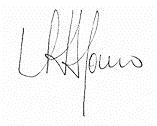
Afonso, M. A. (2016) Language and place in the life of Brazilian women in London: writing life narratives through art practice. PhD Thesis, Chelsea College of Arts, University of the Arts London.
v
Acknowledgements
I would like to thank my Director of Studies, David Cross, my former Second Supervisor, Dr Hayley Newman, and my later Second Supervisor, Dr Linda Sandino, for their invaluable contribution and academic guidance along my doctoral journey. The flourishment of my practice and thought in this research is also a result of the empathic place for critical dialogue created by this great supervisory team. I am also grateful to Professor Maria Tamboukou, James Swinson and Dr Agnès Rocamora for having accepted to be part of the viva voce examination. They offered important contributions to my work and research through attentive and critical reading, questions, comments, suggestions, and insights on this thesis.
My deepest gratitude to Alba Cabral, Allane Viana, Alessandra Leighton, Alessandra Molina, Carolina Angrisani, Cristiane Pederiva, Jamile Kollar, Joselita Padilha, Marisa Aranda, Marta Fernandes, Rosa Gonçalves and Talita Bolzan, who participated in this research and generously shared their time, creative insights, life experiences and personal stories about the English language in their daily lives in London. Muito obrigada.
This research would not have been possible without the financial support of the CAPES Foundation, Ministry of Education of Brazil, which granted me a full time scholarship between 2012 and 2016. I am thankful to Joana Ribeiro de Abreu and Fernanda Botelho de Arruda for the good online technical support regarding bureaucratic issues surrounding my scholarship along these years.
Moreover, I would like to thank the Federal University of Goiás (UFG) for supporting and allowing me to develop my doctoral research abroad. I am grateful to all my colleagues from the Visual Arts College (FAV), especially to the College Director, Dr Raimundo Martins, the Vice-Director and my CAPES tutor, Dr José César Teatini Clímaco, the Former Postgraduate Coordinator, Dr Alice Fátima Martins, and the Administration Secretary, Márcia Bretones, for
vi
their attentive institutional support. Besides, I could not forget to mention my former students, who continue to inspire me.
I thank Dr Michael Asbury for the help on my arrival at the Chelsea College of Arts, as well as friends and colleagues from here (Lara Torres, John Kannenberg, Louise Scovell, Anne Lydiat, Fagner Bibiano, Karel Doing, Gregory Williams, Vanessa Saraceno, Eva Sajovic, Hena Ali, Elisa Dassoler, Yara Evans and Rocio Diaz-Chavez, Ana Souza, Andrea Fonseca, Sofia and Pedro, Margot and family, Stephanie Thomas, Ana Cockerill, Paulo Tercio, Rosane Carneiro, Jaime and Carmen, the Brasiliance team) and from elsewhere (Tatianny Leão, Bárbara Lopes, Andreza and Manoela, Gisele Freitas, Odinaldo Costa, Glayson
Arcanjo, Noeli Batista, Lilian Ucker, Margareth Ribeiro, Rafaela Asmar, Jota Bamberg, Rosane Carvalho, Mario Cavalcante, Cristiane Alves, Coletivo Bunker, Arildo and Silvio, Polim and Ulisses, Celina Wisniewski, Alexandre Ricciardi, Monica Barbosa, Tânia Bloomfield, the Vignettes & Verses group) and so many other people who shared a smile, a hug, sent letters and positive messages by social networks and email during this period.
I am thankful to my mother, Maria Aparecida Rodrigues, my father, Armando dos Anjos Afonso, and my siblings Daniela dos Anjos Afonso and Felipe dos Anjos Afonso, for the emotional support, constant presence and good vibration even at a distance. I would like to thank my aunt Terezinha as well, and my cousins Kamila and Xarene for the letter they sent me telling a little more about my grandmother on my mother’s side. I also thank my uncle José Francisco Afonso (in memoriam) for having connected me to my Portuguese grandmother a long time ago. I could not forget to thank my beloved friend Frei Agostinho Piccolo (in memoriam) for his guidance and wise thoughts throughout life.
Finally, I want to express my profound amor and gratidão to my partner, Alexandre Betinardi Strapasson, who together with our cat, Mimo, has loved me, cared for and supported me in so many ways along this wonderful and challenging PhD journey.
vii
viii Contents Abstract iii Resumo ......................................................................................................................... iv Acknowledgements v Contents viii List of figures................................................................................................................. ix 1 – Introduction ............................................................................................................. 1 1.1 Locating research 1 1.2 Becoming decolonial 6 1.3 Points of origination .............................................................................................. 15 2 – Literature and practice review ............................................................................... 28 2.1 Place 28 2.1.1 Yi-Fu Tuan ........................................................................................................... 34 2.1.2 Doreen Massey ................................................................................................... 50 2.2 Life writing 60 2.2.1 Diary 67 2.2.2 Memoir ............................................................................................................... 80 2.2.3 Correspondence.................................................................................................. 85 2.3 Context of practice 89 3 – Art practice 112 3.1 Writing within muteness ..................................................................................... 115 3.2 Multiplicity of stories 178 4 – Mapping traces for tracing a map 216 4.1 Routes of dispersion ............................................................................................ 217 5 – Moving on ............................................................................................................ 221 References 226 Appendices 241
List of figures
*All images in this thesis are by the author unless otherwise stated. In this digital version, the images by others were reduced in size and converted into black and white due to copyright issues. Higher quality images can be viewed in the printed version available at the college library.
ix
1 Get rid of your accent, 2015 ................................................................................................... 12 2 Voltou a carta, 2003 17 3 Diário de Bordo, 2004-2011 19 4 Autorretratos de viagem, 2008 21 5 BSBCWB: PE01, the anniversary, 2009, by Manoela Afonso and Tânia Bloomfield ............... 23 6 Arqueologia de Afetos: reconhecimento de terra natal, 2010, by Daniela Afonso, Felipe Afonso and Manoela Afonso 25 7 Arqueologia de Afetos: Maria, mistura, brasileira, 2005 ....................................................... 26 8 Cafofo, Goiânia, 2006-2011 27 9 Yi-Fu Tuan, Tuan’s mother and siblings in Chongqing, before leaving for Australia, 19401941 .......................................................................................................................................... 49 10 On Kawara, the artist’s studio (detail), New York, 1966 70 11 Susan Hiller, 10 Months, 1977-1979 71 12 Sophie Calle, The Address Book, 1983 71 13 Renée Green, Secret, 1993 ................................................................................................... 72 14 Tehching Hsieh, One year performance: Time Clock, 1980-1981. 74 15 On Kawara, I got up, 1977 86 16 Susan Hiller, Dedicated to the Unknown Artists, 1972-1976 87 17 Paulo Bruscky, série Envelopes, 1977-2009 ......................................................................... 88 18 Stephen Willats, A model of contextual practice, 1970 90 19 Stephen Willats, Living with practical realities, 1978 91 20 Stephen Willats, Homeostat model, 1969 92 21 Trinh T. Minh-ha, Surname Viet Given Name Nam, 1989 .................................................... 96 22 Trinh T. Minh-ha, Surname Viet Given Name Nam, 1989 97 23 Renée Green, Endless Dreams and Water Between, 2009 99 24 Renée Green, Endless Dreams and Water Between, 2009 100 25 Luis Camnitzer, Landscape as an attitude, 1979 ................................................................ 103
x 26 Luis Camnitzer, This is a mirror (above), 1966-68; You are here (below), 1966 104 27 Anna Bella Geiger, O pão nosso de cada dia, 1978 106 28 Anna Bella Geiger, História do Brasil: Little Boys & Girls, 1975-1976 ................................ 107 29 Paulo Bruscky, the artist’s studio, 2008 108 30 Paulo Bruscky, Artistikk, Amsterdam, 1982 109 31 Paulo Bruscky, Mije, 1982 111 32 Marco Zero, 2012-2013 ...................................................................................................... 117 33 The foundational set, 2012. ............................................................................................... 118 34 Initial notes affixed on the Marco Zero’s walls, 2012-2013 120 35 Artist’s books, 2013 121 36 Artist’s book, 2013 ............................................................................................................. 121 37 Land, 2013 .......................................................................................................................... 125 38 No.Where, 2013 127 39 Now.Here, 2013 127 40 Accented poem, 2013 ......................................................................................................... 128 41 Mid, 2013-2014 .................................................................................................................. 128 42 Winter, 2013-2014 129 43 Art research notebook, 2006 – ongoing 130 44 Art research notebook, 2006 – ongoing ............................................................................. 131 45 Art research notebook, 2006 – ongoing ............................................................................. 131 46 Postcard sent from London to Curitiba, 1981 133 47 Postcard sent from Rio de Janeiro to Salisbury, 1985 134 48 Postcard sent from Peru to Somerset, unknown date 135 49 Diary, November 2012 – February 2015 ............................................................................ 139 50 diário2013, artist’s book published in 2016 140 51 diário2013, artist’s book published in 2016 142 52 diário2013, artist’s book published in 2016 143 53 diário2013, artist’s book published in 2016 ....................................................................... 144 54 diário2013, artist’s book published in 2016 144
xi 55 diário2013, artist’s book published in 2016 146 56 diário2013, artist’s book published in 2016 147 57 La diversión ha empezado, 2011 ........................................................................................ 150 58 Memoir (London, 2010-2013) 153 59 Memoir (London, 2010-2013) 154 60 Memoir (London, 2010-2013) 154 61 Memoir (London, 2010-2013) ............................................................................................ 155 62 Memoir (London, 2010-2013) ............................................................................................ 157 63 Memoir (London, 2010-2013) 157 64 Memoir (London, 2010-2013) 158 65 Memoir (London, 2010-2013) ............................................................................................ 159 66 Memoir (London, 2010-2013) ............................................................................................ 160 67 Building a vocabulary, Cambridge, 2014 162 68 Hidden stories within found words (the red book), 2014 164 69 Hidden stories within found words (the red book), 2014................................................... 164 70 Hidden stories within found words (red and black books), 2014 ....................................... 165 71 Hidden stories within found words (red and black books), 2014 166 72 Gerardi Mercatoris and Rumoldi Mercatoris, Europa ad magnae Europae map, 1630. Detail of Hy-Brazil and Ireland. Source: Bibliothèque nationale de France, Département des Manuscrits, public domain 169 73 Portulano italiano, Atlas de cartes marines de la Méditerranée et de la mer Noire, 14701482. Detail of Hy-Brazil and Ireland. Source: Bibliothèque Nationale de France, Département des Manuscrits, public domain ............................................................................................... 170 74 Dereenataggart Stone Circle, Bronze Age, Beara Bay, Ireland, 2014 ................................. 171 75 Brazilian flag 172 76 Since I Left, 2014 174 77 Since I Left, 2014 175 78 Since I Left, 2014 ................................................................................................................ 175 79 Since I Left, 2014 176 80 Hy-Brazil, 2014 177 81 Língua&Lugar: relatos, 2015-2016 183
xii 82 Língua&Lugar: relatos, 2015-2016 184 83 Língua&Lugar: um diário, 2014 186 84 Língua&Lugar: um diário, 2014 ......................................................................................... 186 85 Homeplace, South London, 2015 190 86 Homeplace, South London, 2015 191 87 Collection of words, 2015 195 88 From no.where to now.here, 2015 ..................................................................................... 196 89 No.Where, 2015 ................................................................................................................. 197 90 Now.Here, 2015 198 91 Writing-making process, 2015 199 92 Homeplace as writing and reading place, 2015 ................................................................. 201 93 Writing-making, 2015 ........................................................................................................ 202 94 Writing-making, 2015 203 95 Spatialized narrative, 2015 204 96 Sharing the spatialized narrative, 2015 ............................................................................. 205 97 Collective language memoir, 2015-2016 ........................................................................... 206 98 Collective language memoir, 2015-2016 207 99 Collective language memoir, 2015-2016 207 100 Taste of Life, 2015, by Ane Viana ..................................................................................... 209 101 Language and Place, 2015, by Ane Viana, Joselita Padilha and Manoela Afonso ........... 210 102 Bilingual sweet’s story, 2015, by Ane Viana 210 103 Alba’s sound map, 2015, by Alba Cabral 211 104 Cristiane’s sound map, 2015, by Alba Cabral 211 105 Website Língua e Lugar, 2015, by Jamile Kollar and Manoela Afonso ............................ 212 106 Homeplace diary, 2015. 213 107 Homeplace photo-diary, 2015 214 108 Measuring, drawing, inhabiting, 2015 215 109 Map of an art practice unfolded within displacement, 2016 ........................................... 219 110 Stories Road, 2016 225
This chapter is divided into three sections. Section 1.1 Locating research situates the research boundaries, methodology, context, and structure of this thesis. Section 1.2 Becoming decolonial presents key concepts surrounding the ‘decolonial option’1 and gives contour to the place from where I speak in this research. Section 1.3 Points of origination offers aspects of my personal and artistic backgrounds, which are relevant for the comprehension of theoretical, practical, and methodological choices taken in this practice-based research
1.1 Locating research
This is an interdisciplinary practice-based research in visual arts. I am an artist transiting among the fields of human geography, feminist geography, postcolonial life writing and decoloniality2 for building a conceptual and practical place within which I develop artistic methods for investigating life stories and creating narratives about experiences with English language in London. To this end, this research includes not only individual practices, but also collective activities carried out with a group of twelve Brazilian women living in London, as a research focus.
1 According to Mignolo, ‘in the disputes of the control of knowledge, of authority, of the economy, of the norms regulating gender and sexuality, and the assumptions regulating racial classification of people and of regions, there are several options [Christian option, liberal option, Marxist option, Islamic option, feminist option, and so on] and each option has several avenues’ that might overlap and be ‘diverse and polemical between themselves’ (Mignolo, 2011b, p. xv). One of the features of the decolonial option, for example, ‘is the analytic of the construction, transformation, and sustenance of racism and patriarchy that created the conditions to build and control a structure of knowledge, either grounded on the word of God or the word of Reason and Truth,’ and considering that such hierarchies ‘have been constructed in the very process of building the idea of Western civilization and of modernity’ (Mignolo, 2011b, p. xv).
2 ‘Decoloniality names attitudes, projects, goals, and efforts to delink from the promises of modernity and the un-human conditions created by coloniality’ (Mignolo, 2014, p. 27). This and other related concepts are explained in section 1.2.
Introduction | 1 1 –
Introduction
The research starts from my personal experience as a newcomer being challenged by the English language within the accelerated rhythm, competitive atmosphere, and monitored environment of London. Difficulties in communicating well in such a context caused a series of dislocations – in language and self – and brought me face to face with ambiguities surrounding my identities of Brazilian, Latin American, EU citizen, artist, university teacher, among others. Moreover, by living and studying abroad new labels were attached to me, such as international student, immigrant, and PhD candidate to mention only the most institutionalised. The experiences lived in such context made me constantly ask ‘who am I becoming here,’ influencing my artistic processes and informing the unfolding of this practice-based research.
1.1.1 Research question, aim, and objectives
The research question proposed in this thesis is: How can my art practice, which is activated by experiences of geographical displacement and dislocation in language, become a place of enunciation for decolonial selves?3
The aim is to understand how my art practice can engender individual and collective processes for exploring experiences within displacement that stimulate the production of life narratives and, in turn, open the space of practice for decolonial thinking, knowing, sensing.
The main objective is to create artistic responses to my personal experiences of geographical displacement and dislocation in language and, within this process, to develop methods to investigate stories of language and place among a group of twelve Brazilian women living in London. Moreover, I want to understand how the autobiographical dimension of my individual practice can connect to convivial places for narrating life together
In order to meet the main objective, the subsidiary objectives of this thesis are to:
3 Decolonial selves emerge from border thinking/knowing/sensing, disciplinary disobedience and delinking from the colonial matrix of power (Mignolo, 2011a). See section 1.2.
Introduction | 2
Carry out a comparative literature review of selected authors and artists, providing the fundamental epistemological concepts required to understand the subsequent discussions.
Develop individual art practices on language and place.
Conduct semi-structured interviews with participants.
Organise and develop practices with a group of twelve Brazilian women living in London, including activities in a house specifically allocated for the collective experiences.
Produce a collective language memoir using the visual and textual material generated during the collective activities developed in the house.
Propose an artistic approach to autobiographical narrative based on the concepts of place and space presented in this thesis.
My art practice is central to this research methodology and combines two elements: (1) an individual practice as response to personal experiences of displacement and dislocation in language, through which I develop artworks and unfold methods for investigating life stories told by other Brazilian women; and (2) a collective writing practice experienced in a convivial place by using the methods created in the first stage of the research.
This research is informed by Yi-Fu Tuan’s and Doreen Massey’s perspectives on space and place. I draw from Yi-Fu Tuan’s existential, phenomenological and autobiographical approach to space and place because it is located in the origins of my art practice and continues to inform some of its processes As soon as I needed a deeper approach to power relations within globalisation, women’s experience of space, and politics of location, I moved from Tuan’s to Doreen Massey’s feminist and progressive notions of space and place. I explain this transition in section 2.1.1.8.
Introduction | 3
This move from humanist geography to feminist geography reflects my engagement with ‘decoloniality’ and the ‘epistemologies of the South’ (Maldonado-Torres, 2007; Mignolo, 2007a, 2007b, 2011a, 2011b, 2013, and 2014; Quijano, 2000; Santos, 2014). These became guiding concepts in the trajectory I built during this research for unveiling aspects of ‘coloniality of power’4 and ‘coloniality of being’5 during my searches for the decolonial self
As part of my methodology, I have explored life writing genres of diary, memoir, and correspondence through photography, printmaking, drawing, postcards and artist’s books. On many occasions, photography worked as a tool for creating a personal and embodied vocabulary with words collected in the city, whereas artist’s books became platforms for combining such photographs and creating autobiographical narratives. Thus, the diary worked as a private place for writing in Portuguese and photographing daily life based on feelings and thoughts activated by displacement and dislocation in language; memoir, especially its sub-genre ‘language memoir’ (see section 2.2.2.1), is conceived as a shareable space where life narratives can be structured through assembling texts and images and playing with their meanings. Correspondence is focused on the postcard, which is a format often used to address city landmarks and travelling narratives from ‘here’ to ‘there’ and vice versa
The context of practice draws on key practitioners, such as Stephen Willats, who informs the collective element of this research and the mapping process of my practice; Trinh T. Min-ha and Renée Green, who work in-between
4 ‘Coloniality of power is the basic concept of decolonial thinking by which we unfold the analytic of coloniality and envision and imagine decolonial futures’ (Mignolo, 2014, p. 27). Coloniality of power is a term coined by Quijano (2000) for addressing systems of knowledge, hierarchies and culture that emerged in colonialism as structures of power. Coloniality is different from and survives colonialism; it ‘refers to long-standing patterns of power that emerged as a result of colonialism’ and ‘is maintained alive in books, in the criteria for academic performance, in cultural patterns, in common sense, in the self-image of peoples, in aspirations of self, and so many other aspects of our modern experience’ (Maldonado-Torres, 2007, p. 243). See section 1.2.
5 Coloniality of being expresses itself primarily through invisibility and dehumanization, and ‘indicates those aspects that produce exception from the order of Being’ (Maldonado-Torres, 2007, p. 257). The awareness of coloniality of being raises an ‘immigrant consciousness’ (Mignolo, 2011b, p. 109). See section 1.2.
Introduction | 4
geographies, images, words, and languages; and the artists Luis Camnitzer, Anna Bella Geiger, and Paulo Bruscky, who often transit between image and text and address geopolitics through their works.
1.1.2 Thesis structure
This thesis is divided into five chapters. Chapter 1 refers to this Introduction and is divided into three sections: 1.1 Locating research, which presents the research boundaries, research question, aim, objectives and the thesis structure; 1.2 Becoming decolonial, in which I articulate the notion of identity and the place from where I write this thesis; and 1.3 Points of origination, which presents briefly my personal and artistic backgrounds.
Chapter 2 focuses on the Literature and practice review and is divided into three sections. In section 2.1 Place, I present concepts of place and space by Yi-Fu Tuan and Doreen Massey, explaining the relevance of their work for this practice-based research and the reasons that made me move from humanist to feminist approaches to geography. Section 2.2 Life writing introduces the field of life writing and the genres of diary, language memoir, and correspondence. Section 2.3 Context of practice presents selected works by the artists Stephen Willats, Trinh Minh-ha, Renée Green, Luis Camnitzer, Anna Bella Geiger, and Paulo Bruscky, which inform the practice developed in this research.
Chapter 3 is dedicated to Art practice. It is divided into two sections: section 3.1 Writing within muteness focuses on my individual practice developed as a response to displacement and dislocation in language; section 3.2 Multiplicity of stories presents the interviews and creative practices carried out with a group of twelve Brazilian women who live in London.
Chapter 4 is called Mapping traces for tracing a map and consists of one section, 4.1 Routes of dispersion, in which I look at my practice in retrospect and present it through a schematic map, offering a view on the results of this research. In chapter 5, Moving on, I conclude this practice-based research.
Introduction | 5
1.2 Becoming decolonial
In this study, I articulate the notion of identity from a geopolitical location informed by decoloniality. Decoloniality is a concept ‘whose point of origination was the Third World’6 (Mignolo, 2013, p. 129). It has its historical grounding in the Bandung Conference of 1955,7 which defined itself in the terrain of decolonization as a third option to capitalism (First World) or communism (Second World) However, despite decoloniality being grounded in this historical moment, it differs from decolonization as colonization also differs from coloniality, as explained in the following paragraph
Anibal Quijano (2000) redefined the notion of decolonization when he coined the term coloniality, in the late 1980s and early 1990s, with the objective to deal with issues of contemporary imperialism, and focused on Latin America. Quijano argues that what is called ‘globalization’ today is the culmination of ‘a process that began with the constitution of America and colonial/modern Eurocentered capitalism as a new global power’ (Quijano, 2000, p. 533). This process created and promoted an unprecedented ‘classification of the world’s population around the idea of race,’ i.e. race as a ‘supposedly different biological structure that placed some in a natural situation of inferiority to the others’ (Quijano, 2000, p. 533). This idea of race has, therefore, a colonial origin ‘but it has proven to be more durable and stable than the colonialism in whose matrix it was established’ (Quijano, 2000, p. 533). Thus, this duration is conceived as an element of coloniality, which refers to both the ‘hidden
6 Third World is a term coined during the Cold War to designate the countries aligned neither to capitalist countries (First World) nor to the communist bloc (Second World) (McDowell and Sharp, 1999, p. 298). It is currently in disuse because of its negative hierarchical connotation, but as Walter Mignolo needs it to contextualise decoloniality, this term is here used whenever necessary.
7 The Bandung Conference of 1955 counted with 29 countries from Asia and Africa and aimed to ‘find a common ground and vision for the future that was neither capitalism nor communism’ (Mignolo, 2013, p. 130). It was followed by the Belgrade Conference, in 1961, when Latin American countries joined Asian and African countries and founded the NonAligned Movement (NAM).
Introduction | 6
agenda (and darker8 side) of modernity’ and to the ‘foundation and unfolding of Western civilization from the Renaissance to today of which historical colonialisms have been a constitutive, although downplayed, dimension’ (Mignolo, 2011b, p. 2).
If modernity is a complex narrative whose point of origination was Europe and celebrates Western civilization while hiding its own darker side (Mignolo, 2011b), looking at it from a non-European point of origination makes it difficult to see modernity apart from coloniality As Mignolo (2011b) explains, in the rhetoric of modernity, coloniality has at least three different stages: modernity as salvation (through conversion to Christianity); modernity as civilization (through controlling souls and bodies in the emerging nationstates); and contemporary consumerism (which is the corporate stage through which Western economic principles are spread under the idea of economic development).
Therefore, the ‘decolonial option’ proposes delinking from coloniality, i.e. a detachment from the ‘colonial matrix of power’ (Gaztambide-Fernández, 2014, p. 208). Besides, decoloniality means to delink from Western episteme and paradigms, which cannot be ignored but ‘are no longer the point of reference and of epistemic legitimacy’ for the decolonial option (Mignolo, 2013, p. 131). However, delinking is not a simple task and might incur contradictions and ambiguities because ‘Western knowledge has been spread
8 Walter Mignolo uses the word ‘dark’ in his book The Darker Side of the Renaissance in ‘contradistinction to the image of the “Dark Age” that the Renaissance projected toward the Middle Ages’ (Mignolo, 2011b, p. xix). Then, in his subsequent book, The Darker Side of Western Modernity, he continues using this word to problematize the ‘logic of coloniality’ implied by the idea of European modernity as the ‘point of arrival of human history and the model for the entire planet,’ which came to be taken for granted and is a belief that materialized ‘the darker side of modernity’ (Mignolo, 2011b, p. xiv). Even though ‘European men of letters’ recognised the ‘darkness’ of the ‘Dark Age,’ one of its ‘darker sides’ – slavery –‘was not acknowledged as such, but portrayed as bringing “light” and civilization to the colonies, as a necessary step toward progress and civilization and good business for merchants from Portugal, Spain, France, Holland, and England’ (Mignolo, 2011b, p. xix). In this way, all progress, development, and growth celebrated by the rhetoric of modernity have hidden dimensions built on ‘poverty, misery, inequities, injustices, corruption, commodification, and dispensability of human life,’ which are considered by Mignolo as components of the darker side of Renaissance, Enlightenment and Western Modernity (Mignolo, 2011b, p. xviii).
Introduction | 7
globally and, therefore, it is in all of us who went through at least secondary education’ (Mignolo, 2013, p. 201). In fact, I can see such influences in my whole education, which made me look more often at Europe and the USA than at Brazil, South America, and Latin America. Moreover, it is necessary to recognise that my own language is part of Brazil’s colonial past and figures among the six most influential Western imperial languages, namely: Portuguese-Spanish-Italian (the core of the Renaissance period) and EnglishFrench-German (the core of the Enlightenment period). These are the languages used worldwide ‘to maintain the enunciative privilege of the Renaissance and Enlightenment European institutions, men and categories of thought’ (Mignolo, 2013, p. 133).
As a woman who has received an education grounded on Western discourses, practices and knowledges, and who now continues her trajectory by doing a PhD in a higher education institution located in the political, financial, and cultural centre of Britain, I recognise that my decision of moving towards decoloniality might produce a series of paradoxes. However, this is the path for building a place for liberatory thought, practice and being, in which the initial question ‘who am I becoming here’ can be reframed as ‘who do I want to become here.’
The entanglement between Portuguese and English that I experienced on my arrival in this city created a place of muteness within which I started to confront identity and coloniality (of power, knowledge, and being) in daily life and, in retrospect, in personal history. As mentioned earlier, coloniality survives colonialism and ‘refers to long-standing patterns of power that emerged as a result of colonialism’ (Maldonado-Torres, 2007, p. 243). Additionally, it is important to acknowledge that these patterns of power are alive in:
[…] books, in the criteria for academic performance, in cultural patterns, in common sense, in the self-image of peoples, in aspirations of self, and so many other aspects of our modern experience (Maldonado-Torres, 2007, p. 243).
Introduction | 8
Coloniality of being is expressed primarily through invisibility and dehumanization, indicating aspects ‘that produce exception from the order of Being’ and, hence, shapes ‘an inhuman world’ (Maldonado-Torres, 2007, p. 257).
The immigrant consciousness arising from the awareness of coloniality is a result of border thinking/knowing/sensing and of disciplinary delinking that leads to decolonizing being and knowledge (Mignolo, 2011b). It is an expression of the decolonial self who is ‘out of place in the set of regulations of “modernity”’ (Mignolo, 2011b, p. 109).
Of course, to awake an immigrant consciousness one does not need to leave her or his geographical place of origin As Mignolo explains, the ‘immigrant consciousness’ is the assumed condition of an existence out of place, which might be configured in many ways:
For people of European descent, for being in a place whose history is not the history of their ancestors; for indigenous or “pueblos originarios” who built their history in the land they inhabited, then found themselves out of place when their form of life and their institutions, education, and economy were displaced, destroyed, and replaced with ways of life and the institutions of migrants from European countries; for Africans coming from several parts of Africa, with their own different languages and beliefs, forms of life, and institutions, who found themselves in a land whose histories did not belong to their ancestors and, in contrast to the Europeans, in a land whose social structures placed them at the very bottom of the scale (Mignolo, 2011b, p. 109).
In my experience, geographical movement generated the out-of-place feelings that stimulated my immigrant consciousness It is the transition among leaving, arriving, staying and departing that makes me think about my own ‘routes of dispersion’ and ‘points of origination.’9 It is by positioning
9 ‘Points of origination and routes of dispersion are key concepts to trace geo-politics of knowing/sensing/believing as well as body-politics of knowing/sensing/understanding. When Frantz Fanon closes his exploration in Black Skin/White Masks (1967) with a prayer: - Oh my body, make of me always a man who questions! - He expressed, in a single sentence, the basic categories of border epistemology: the biographical sensing of the Black body in the
Introduction | 9
myself in the border that I can observe more clearly the traces of coloniality in my ‘self.’ In this case, the term ‘border’ must be taken not as a fashionable object of disciplinary study, but as place of enunciation (created by the subject) rather than representation (represented by someone else) (Gaztambide-Fernández, 2014).
Therefore, in this research, epistemological contradictions, internal conflicts and oscillations in identity are consequences of this movement towards becoming decolonial As Mignolo argues,
Once you take this step, even if you have not acquired these knowledges and understandings as a member of an Indigenous or Afro-Caribbean culture, or any other non-Western culture and civilization, if you are of European descent and mixed blood, once you realize that you have also been colonized, that your mind, your body, your senses, your sight, your hearing have been modelled by the colonial matrix of power, that is, by its institutions, languages, music, art, literature, etc. – or what is the same as Western Civilization – you begin to “heal.” The process of healing is that of becoming a decolonial subject, or “learning to be” (Gaztambide-Fernández, 2014, p. 207).
Thus, the epistemological decisions taken in this research reflect my search for the decolonial self. I moved from one theoretical place to another asking initially ‘who am I here’, then ‘who am I becoming here’ and, finally, ‘who do I want to become here ’ The transformation in these questions reflects my movement from humanist geography to feminist geography, postcolonial life writing, and decoloniality. This research stresses a specific epistemological trajectory driven by a desire for liberation, and offers a specific network of concepts through which I have looked at my practice and research to not only write this thesis, but create places of enunciation for the decolonial self.
Third World, anchoring a politics of knowledge that is both ingrained in the body and in local histories’ (Mignolo, 2013, p. 132).
Introduction | 10
1.2.1 Becoming decolonial in this thesis
This thesis, as an academic written document, reflects my condition as an international student writing in a second language. Therefore, it embodies the research subject matter and has a potential as a creative space for exploring feelings and thoughts about writing in English. Each sentence written down in the space of this thesis helped me to create a place of rexistência (a play with the words ‘resistance’ and ‘existence’ in Portuguese), in which I use English for unveiling a new voice and, at the same time, raising immigrant consciousness Thus, I consider this thesis as both an academic writing piece about my practice-based PhD research and as practice itself.
Rather than deciding to get rid of my accent (Figure 1), I turned to one of Alice Kaplan’s memories about her teacher of French, who defines accent as ‘a personal song’ (Kaplan, 1993, p. 100). Besides, Kaplan tells that her teacher also treated others’ maladies du language, i.e. illness of language, and affirmed that ‘language is not a machine you can break and fix with the right technique, it is a function of the whole person, an expression of culture, desire, need’ (Kaplan, 1993, p. 98). Walter Mignolo affirms that language is ‘an ongoing process that only exits in languaging,’ which ‘locates interaction among individuals, among human beings instead of in preexisting ideas’ (Mignolo, 2000, p. 253).
Considering that the accent gives singularity to the place from where one speaks and that bilanguaging10 is a fundamental condition of border thinking (Mignolo, 2000), in the context of the politics of location here implied to get rid of my accent (written or spoken) would be seen as a paradox. By claiming the relevance of my accented and ungrammatical voice for the production of this thesis, I stress the importance of facing the new language also in this
10 According to Mignolo, ‘languaging in language allows us to describe ourselves interacting as well as to describe the descriptions of our interactions’ (Mignolo, 2000, p. 254), and bilanguaging ‘reveals the ideology of monolanguaging (and particularly the idea of national languages in the imaginary of the modern states), that is, of speaking, writing, thinking within a single language controlled by grammar, in a way similar to a constitution’s control over the state’ (Mignolo, 2000, p. 252, italics in original).
Introduction | 11
academic space, since it is one of the potential spaces that can become a place of enunciation for my decolonial self.
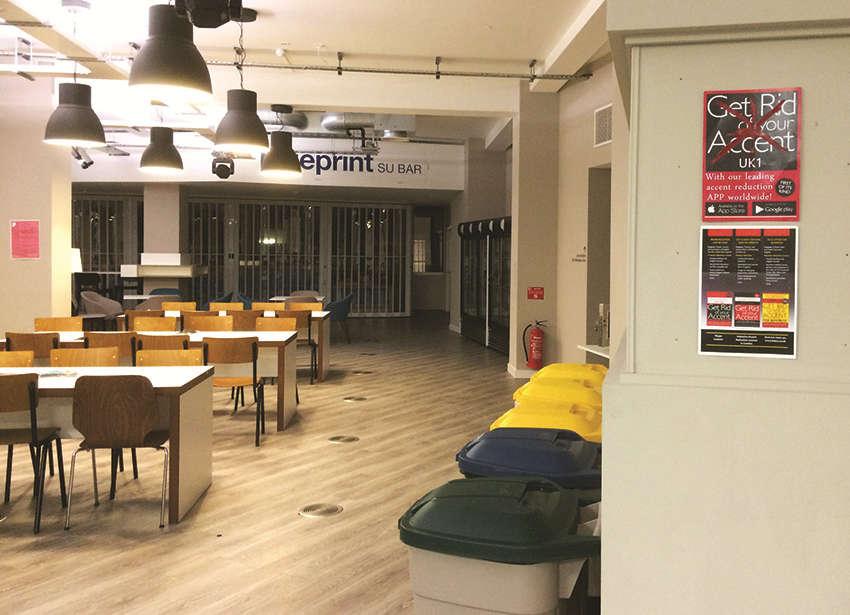
Claiming the relevance of my accented voice made me feel liberated rather than imprisoned. Instead of experiencing ‘knowledge-as-regulation,’ I came to experience ‘knowledge-as-emancipation’ (Santos et al., 2008). Knowledge-asregulation departs from ignorance, which is considered as disorder, in direction to knowledge, which is considered order; knowledge-asemancipation ‘knows through a trajectory that leads from ignorance, conceived of as colonialism, to knowledge conceived of as solidarity’ (Santos et al., 2008, p. li). This changing in perspective allowed me to re-locate myself in a positive way: from the position of an international student who was initially ashamed, feeling overwhelmed, and fearing the challenge of writing in English, I came to see myself as a becoming decolonial subject who has the right to communicate her research from the place of not-knowing the language as conventionally expected and, along this journey, raising
Introduction | 12
Figure 1 Get Rid of your Accent, 2015. Poster on the University of the Arts London (UAL) Student Union canteen wall.
immigrant consciousness, communicating better, decolonising being, learning to be.
Mignolo and Schiwy affirm that ‘we are no longer facing the question of “the West and the Rest” but “the Rest in the West” as well as “The West in the Rest”’ (Mignolo and Schiwy, 2007, p. 14). Thus, it is important to acknowledge that Western hegemonic languages might work as a common transnational language ‘in which positions of subalternity are rearticulated’ (Mignolo and Schiwy, 2007, p. 27). This recalls Paulo Freire’s thought and questions on the relationship between language and power: ‘Who says that this accent or this way of thinking is the cultivated one? If there is one which is cultivated it is because there is another which is not’ (Freire, 1996, 3:50). He argues that it is impossible to speak of language without speaking of power, and while he discusses the different ways people can speak, Freire claims that ‘they have the right to speak like this’ (i.e. outside the dominant syntax), but the more they learn the dominant syntax, ‘the more they can articulate their voices and their speech in the struggle against injustice’ (Freire, 1996, 5:17).
1.2.2 Brazilian women in London
Currently, Latin Americans are the second fastest growing non-EU migrant population in London (Mcllwaine and Bunge, 2016). According to the Office for National Statistics’ 2011 Census, there were around 83,000 Latin Americans living in London, of which 53% were women. Brazilians were the largest group (31,000), followed by Colombians (19,000) and Ecuadorians (7,000). These numbers have increased since then and there were approximately 250,000 Latin Americans in the UK in 2013, of which around 145,000 were located in London (Mcllwaine and Bunge, 2016).
In relation to language, one in five Latin Americans either cannot speak English or cannot speak it well, indicating that women are ‘more likely to have problems speaking English with 20% not speaking any or little compared with 14% of men’ (Mcllwaine and Bunge, 2016, p. 20). Additionally, English
Introduction | 13
language figures as a major challenge among onward11 Latin American migrants in London, being identified ‘as the main problem by nearly 90% of the interviewees’ (Mcllwaine and Bunge, 2016, p. 61).
The Brazilian Migration to the UK research group (GEB) developed a survey focused on gender in 2013, interviewing 435 Brazilian women living in 42 countries, of whom 119 were living in the UK. They found that the lack of good work opportunities, difficulties with language, and isolation/loneliness were the problems most cited by these women (Evans et al., 2013). Language plays a crucial role in the lives of immigrants and difficulties in communicating well can affect their self-esteem, confidence, personal and professional relationships, economic and social conditions, producing many levels of vulnerability (see Evans et al., 2007, 2011 and 2013; Mcllwaine et al., 2011; Mota, 2012; Souza, 2010).
The following section presents some aspects of my history, academic background and artworks that are relevant to understand the methodological, theoretical and artistic choices taken in this research.
11 Onward migrants are people who leave their place of origin for another place or country, settles there for a period, and then moves again. This is a migration process that does not correspond to the simple association between point of origination and final destination, since the onward migrant can keep transnational ties across many destinations (see Ahrens et al., 2016).
Introduction | 14
1.3 Points of origination12
My mother was fourteen years old when she left her rural village to live in Curitiba, the capital of Paraná state, in the south of Brazil. My father left his rural village in the north of Portugal at the same age to meet his elder brother in São Paulo, in the southeast of Brazil. Some years later, my parents met in Curitiba and our family came into existence. My siblings and I grew up hearing fragmented stories about places located elsewhere and, at a very early age, I started to write letters as an attempt to connect ‘here’ and ‘there.’ I wrote to relatives on my father’s side, and occasionally met relatives on my mother’s side, whom I asked few times about our indigenous ancestry. These letters and questions led me to two kinds of place: one geographically distant and accessible through correspondence; and another geographically nearer but hidden and inaccessible. Since then, narratives about departures, arrivals and voids have influenced the way I relate to the world.
Later on, as a teenager, I enjoyed using my father’s old cameras and discovered similarities between letters and photographs. I noticed that both can tell stories from specific points of view, one through words and another through images. Sometimes letters and photos co-inhabited the same envelope, as photos could be glued to letters or a letter be written on the back of a photograph (hence my passion for postcards). Words and images often collided and letters and photos could work as complimentary telling devices. Sometimes, they would tell different stories, other times they would tell the same story differently. Above all, correspondence and photography made me aware of time, stories and places. I waited as long for letters as I waited for photographic films to be developed, and the bliss of the first moment of revelation of a set of personal stories and places, through words and/or images, is unforgettable. However, when a letter got missed or a photograph resulted in an unclear image, I recalled the void related to those
12 I borrow this term from Mignolo’s approach to decoloniality to engender a personal reflection about my own ‘points of origination’ and ‘routes of dispersion,’ i.e. the places where I come from and the trajectories I traced from one place to another.
Introduction | 15
unattainable places located in my mother’s past. It was only more than a decade later that I came to understand that part of this void could be connected to what the Brazilian writer and anthropologist Darcy Ribeiro (2006 and 2010) called ninguendade, which could perhaps be translated into English as ‘nobodyness.’ Ribeiro uses this word to explain the lack of ethnic identification that shaped the Brazilian identity from the colonial times when European men raped Indigenous and African slave women. According to Ribeiro, some of the children who originated from this violence lost their ethnic roots and, at the same time, were not accepted as Europeans. This is the existential condition implied by ninguendade. Ribeiro affirms that these Brazilians were ‘um produto inesperado e indesejado do empreendimento colonial que só pretendia ser uma feitoria’ (Ribeiro, 2010, p. 49), i.e. an unexpected and unwanted product of the colonial enterprise that was only intended to be a trading post (my translation).
During my segundo grau (that is the equivalent to upper secondary school in Britain), I learned technical drawing skills and worked as a draftswoman for engineers and architects. I discovered that by measuring an unfamiliar space I could record its details and, at the same time, experience its spatiality. By drawing it afterwards, in the studio, I could recall the experience lived in that space. Measuring and drawing became strategies for inhabiting, re/presenting and re/creating places, even when they are no longer accessible.
At university, I took two courses: visual arts teaching and agronomy. While I focused my initial art projects on printmaking, I was being introduced to a myriad of disciplines related to natural sciences. Among the constellation of new experiences, subjects, and approaches, I started seeking points of connection among art, landscape, and my family histories. In my last year at the university I attended a one-semester course called Perception in Geography. It focused on humanist geography and there I learned that space and place could be academically studied from the point of view of personal experience. Then, I came to know the work of Yi-Fu Tuan and felt encouraged
Introduction | 16
to try some of his concepts through my art practice, which started to work out as a self-location process and offer strategies for weaving an ongoing autobiographical tale through the connection of places and life stories into artworks.

Introduction | 17
Figure 2 Voltou a carta, 2003. Linocut, 22,5 x 16,5 cm (Between 1998 and 2003, I learned a couple of printmaking techniques at university and started to produce my first prints. Some of them show women in house interiors surrounded by letters)
When I left my home town to live in another city, I could embody my first experience of geographical displacement. I continued working on my printmaking and started a diary to record my experiences and first impressions of the new life in new places. Photography quickly started to dialogue with my diaristic writing and I decided to create a weblog13 that could work as a personal travelling journal (Figure 3). It lasted for seven years, from December 2004 to December 2011, and in this diary I wrote and shared images to remember what I had left (childhood, family stories, landscapes), to record the present (impressions about new cities, people, practices, readings, landscapes, sounds, accents, tastes, and about a ‘self’ in process of change), and to imagine the future (where I could go next, and who I would become). Different to the previous private diaries that I kept as a teenager, this one was available online to old and new friends as well as to strangers. I wanted to build a passage from a private place to a shareable space, and the online diary seemed to be a good option for connecting them both. This diary generated a not-too-intimate content to be shared. Moreover, it could activate a conversation with others in the comment field of each entry. At the same time, this diary worked as a place for thinking about the contradictions between the fluidity of a ‘self’ in movement and the fixity of identities taken for granted. In my processes, moving from one place to another became a strategy for undoing the rigidity of what seemed to be fixed.
13 In 2003, I created a photoblog called Cliché on www.fotolog.net, which does not exist anymore. Thus, in 2004, I migrated it to another weblog of mine called Diário de Bordo on http://blog.uol.com.br, which was also latterly modified. Currently, part of its content is available on http://diariodebordoseteanos.blogspot.co.uk.
Introduction | 18
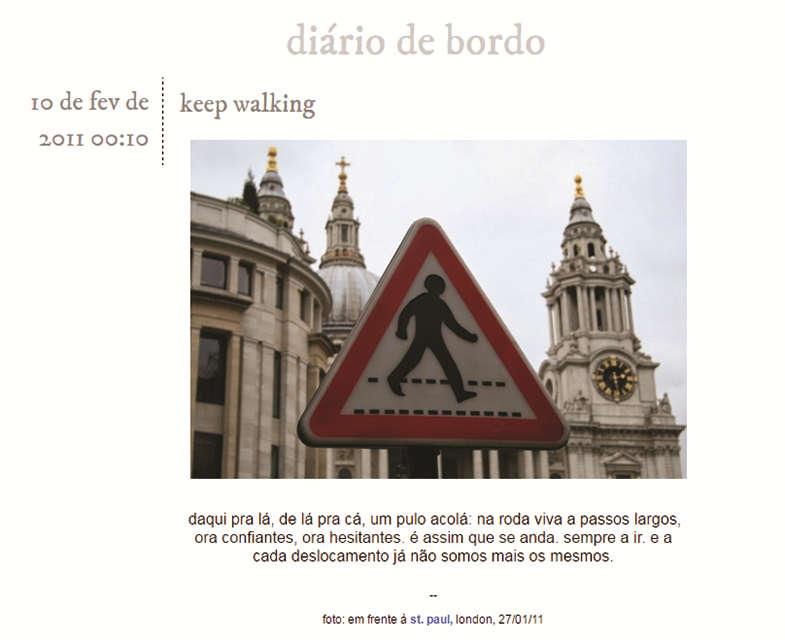
In the following sections, I briefly show selected art projects that I started before moving to London, but which are also relevant to contextualise further discussions presented in this thesis. They have influenced my recent practices which I developed for this practice-based research. These previous art projects, some of them still ongoing, are informed among others by Yi-Fu Tuan’s notions of place, space, and displacement, which are presented later in section 2.1.1.
Introduction | 19
Figure 3 Diário de Bordo, 2004-2011. Online diary. (In 2011, I visited London for the first time and was still keeping this diary This entry writes: ‘From here to there, from there to here, a jump yonder: striding the roda viva, sometimes confident, sometimes hesitant. That's how it goes. Always ahead. And from one displacement to another we are no longer the same’).
1.2.1 Autorretratos de Viagem
In 2008, I produced a series of self-portraits called Autorretratos de Viagem, (Self-portraits of Travelling), (Figure 4). I enlarged one of my ID photographs and transformed it into a stencil. Then, with rubber stamps, I printed my face with words that connect my ‘self’ to four phases of a dislocation cycle: partir (to leave), chegar (to arrive), ficar (to stay), and re-partir (to re-leave). Images and words work together for indicating changes in my subjectivity within displacement. The last phase, re-partir, has a double meaning in Portuguese: to leave again, i.e. re-leave (re-partir); and to share (repartir). Living in a new place implies building relationships with places and people. The change in subjectivity is also influenced by such relationships. While Tuan (1999) argues that a person can become someone’s place (see section 2.1.1.1), Doreen Massey adds insightful thoughts on the relational aspect of place (see section 2.1.2) and other feminist critics recognise the intrinsic relational aspect of life writing (see section 2.2).
Introduction | 20
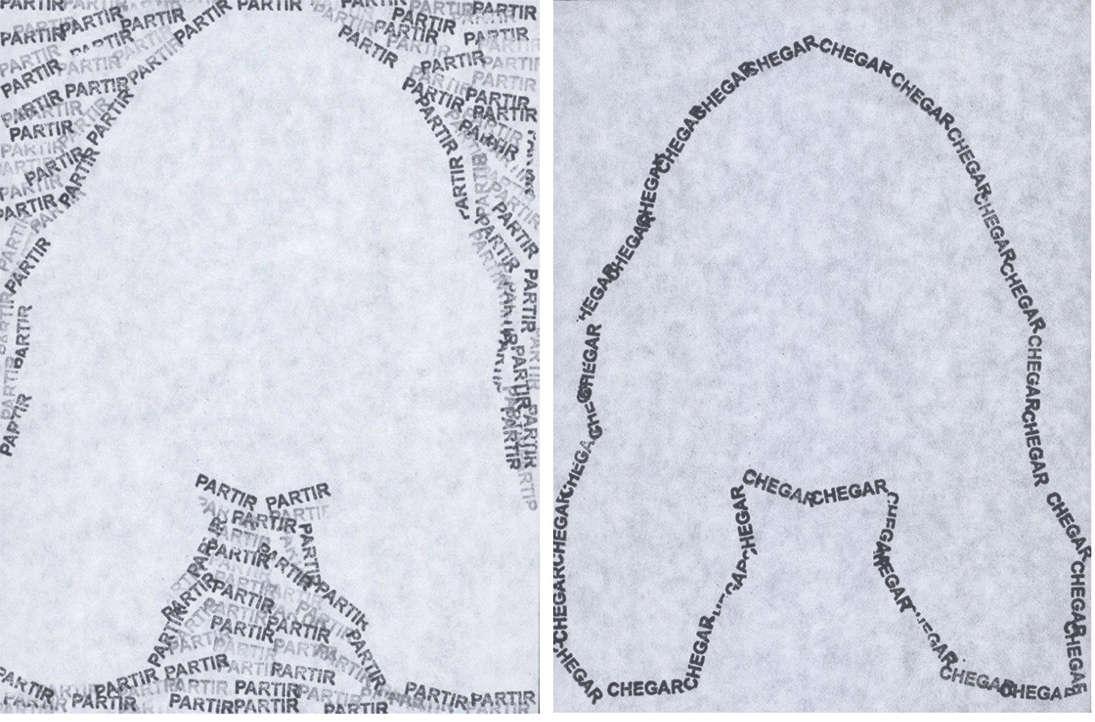

Introduction | 21
Figure 4 Autorretratos de Viagem, 2008. Stencil and rubber stamp on filter paper, approximately 21 x 15 cm each print.
1.2.2
BSBCWB
This is an art project developed since 2009 in collaboration with the artist Tânia Bloomfield (Figure 5). The title of this work refers to the three letter code used in airports to designate cities, in which BSB refers to Brasília and CWB to Curitiba. While Tânia was born in Brasília and moved to Curitiba when she was twenty-seven years old, I was born in Curitiba and moved to Brasília at the same age. This coincidence is the starting point for our collaboration, which aims for the creation of artistic strategies for telling stories to each other about unknown sites in the cities where we were born. This is a mapping process that leads to exchanges of correspondence, objects, and texts. These exchanges culminate in bodily encounters somewhere else in the middle of our geographical locations.
Introduction | 22

Introduction | 23
Figure 5 BSBCWB: PE01, the anniversary, 2009, by Manoela Afonso and Tânia Bloomfield. Meeting in bedroom 214, Hotel Brasília, in Curitiba. (Text on the wall: “memory = fiction”).
1.2.3 Arqueologia de Afetos
Arqueologia de Afetos, (Archaeology of Affections), is an ongoing art project started in 1997 and focused on my family histories. It involves carrying out research through art practice about stories, people, objects and places related to my family on both my mother’s and father’s sides. I have been producing artist’s books, videos, photographs, postcards, performing places and texts individually and together with other members of my family in order to build an archive of both people’s stories and visual narratives. This material indicates possible trails among gaps and fissures of our past. It helps to weave our family history with pieces of forgotten stories, unreachable places and broken identities (Figures 6 and 7).
Introduction | 24

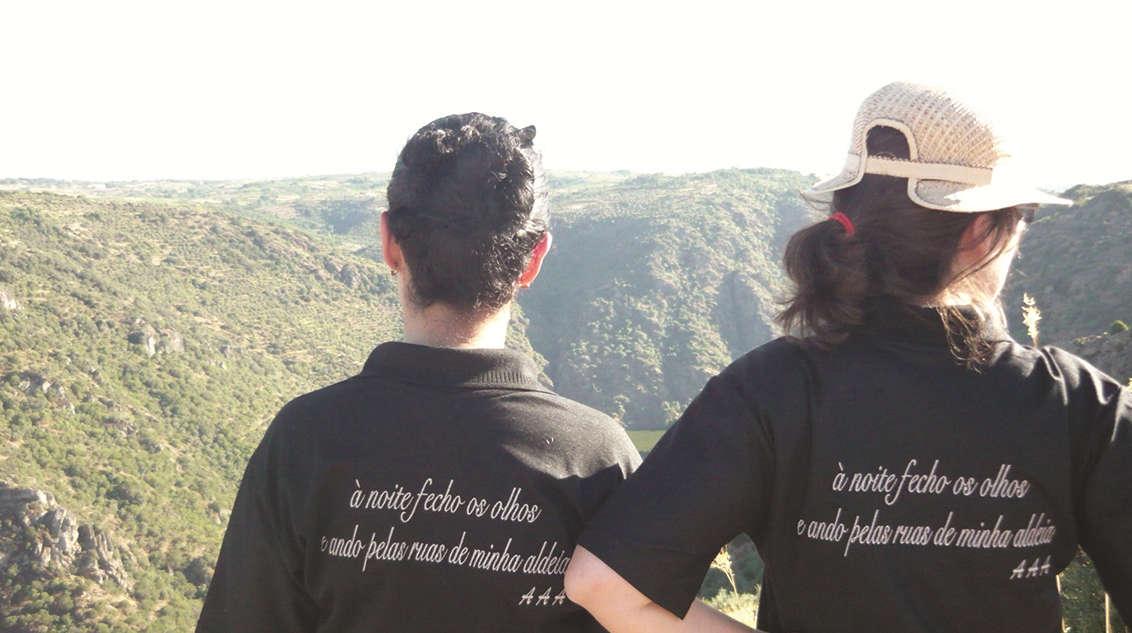
Introduction | 25
Figure 6 Arqueologia de Afetos: reconhecimento de terra natal, 2010, by Daniela Afonso, Felipe Afonso and Manoela Afonso Walking across our father’s home town, Vilarinho dos Galegos, Portugal; embroidered t-shirts (The phrase on the t-shirts is by our father and reads: at night I close my eyes and walk on the streets of my village). Photographs by Manoela Afonso (above) and Felipe Afonso (below).

Introduction | 26
Figure 7 Arqueologia de Afetos: Maria, mistura, brasileira, 2005. Postcard, my mother’s photograph digitally recovered and printed on paper, approximately 30 x 21 cm.
1.2.4 Cafofo
Moving also means to leave certain places behind and inaugurate new ones. When I left Brazil for London, I had to dismantle my home-studio, which I used to call cafofo, which means ‘shack’ (Figure 8). As it does not exist anymore, it is not a place to which I can return. In this sense, Tuan’s notion of linear and cyclical times has informed my understanding of displacement, since when I depart from one place I do not expect to return to it later (see section 2.1.1.3). When I arrived in London, the first measure I took was to redefine a place where I could work and inhabit (see section 3.1.1), and I was conscious of its transience.
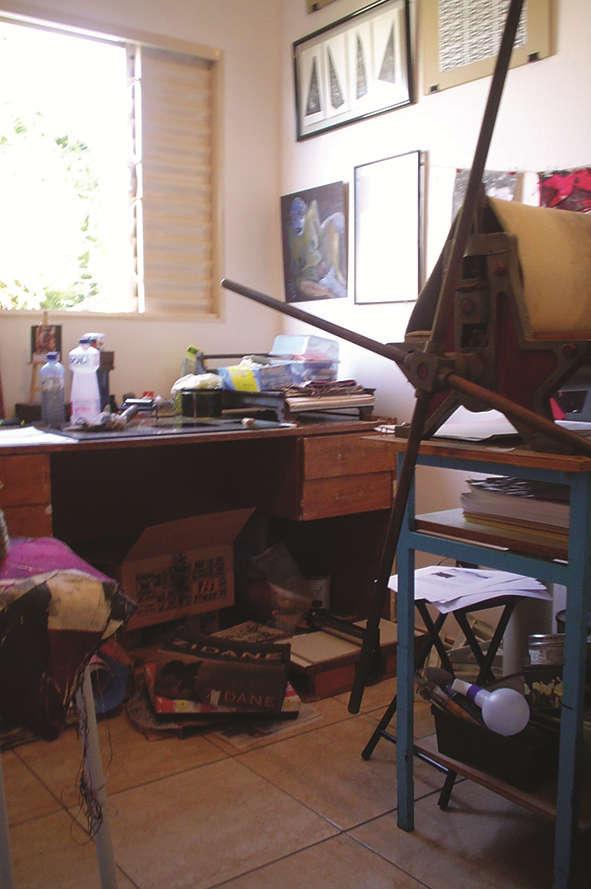
Introduction | 27
Figure 8 Cafofo, Goiânia, Goiás, Brazil, 2006-2011
2 – Literature and practice review
In this chapter, I start section 2.1 by introducing the concept of place while I transit among the fields of geography, feminism and art. In section 2.1.1, I focus on Yi-Fu Tuan’s approach to space and place, followed by a critical review of his work through the lens of feminism. Then, section 2.1.2 brings Doreen Massey’s views on space and place, power-geometry, and place as a collection of stories. In section 2.2, I give an overview on life writing, stressing the importance of place for postcolonial life writing, and conceptualizing the genres of diary, language memoir and correspondence. In section 2.3, I then summarize the context of practice by showing selected artworks and artists who influence my work in this research. This set of references form the epistemological basis for my practice. Therefore, this literature and practice review balances a comparative assessment of key references and artworks permeated by brief personal comments about art practice in order to inform subsequent discussions.
2.1 Place
Hubbard and Kitchin affirm that ‘space and place have become totemic concepts for those exploring social, cultural, economic and political relations’ (Hubbard and Kitchin, 2011, p. 2). In the arts, such concepts have informed a series of changes in the artists’ practices and its conceptual understanding. In the western art tradition, for instance, the invention of perspective conferred an optical third dimension to the two-dimensional space of painting. Then, by the late period of modern art, artists challenged the boundaries defined by frames, canvases and pedestals Not only painting would migrate to the three-dimensional space but also sculpture would leave its traditional base for inhabiting what Rosalind Krauss (1979) would later call the expanded field of sculpture. Tracing a path to contemporary art, dadaists dislocated objects from their usual functions and re-located them inside museums and galleries
Literature and practice review | 28
as artworks; conceptual artists took a move from the retinal pleasure to the intellectual aspect of art; in site-specific proposals, the environment itself would become a work of art; and from the 1970s artists started to blur the borders between art, politics and education, which would lead to socially engaged practices, collaboration and performance. Yet, a myriad of contemporary artists continue to explore ways to overlap the places of art and life (Dean and Millar, 2005; Ferreira and Cotrim, 2006; Traquino, 2010).
These continuous dis- and re- locations of practices and concepts can work as powerful strategies for keeping the space of art open to experimentation, invention, discovery, and freedom. In this way, I would say that making art involves tracing paths towards those conceptual zones that can engender works of art as potentially new places in the world.
In geography, which is the discipline that informs my art practice, the concepts of space and place can vary according to different theoretical and methodological traditions used for delimiting them. As Hubbard and Kitchin explain, there are two main continuing influences in this field: Marxist, which explores the roles of culture and power in the making of space and has informed the work of feminist geographers; and the Berkeley School through Carl Sauer’s14 approach to landscape with an emphasis on place-making, which has influenced both cultural and humanist geographers (Hubbard and Kitchin, 2011)
In the early 1970s, humanist geographers interested in the experiential properties of space started to challenge the positivist paradigm in geography by conducting work based on phenomenological and existentialist approaches informed mainly by Bachelard, Husserl, Heidegger, and Merleau-Ponty (Hubbard and Kitchin, 2011). Anne Buttimer, David Ley, David Lowenthal,
14 “Carl Sauer (1889-1975) dominated North American cultural geography throughout his lifetime and particularly during his years as head of the influential Berkeley School, a position which he assumed at the age of 33 and which he held until three years before his retirement in 1957. (…) During his time at Berkeley, Sauer supervised some 40 PhD theses, the majority on Latin American and Caribbean topics, conveying to all his students his firm belief in the need for first-hand field experience and for learning the language of the people being studied” (Jackson, 1992, p. 10).
Literature and practice review | 29
Edward Relph, and Yi-Fu Tuan, for example, became key points of reference in the field of humanist geography, and developed a body of work focused on the experiential elements of space and place, highlighting ‘that people do not live in a framework of geometric relationships but in a world of meaning’ (Hubbard and Kitchin, 2011, p. 6). Place, for humanist geographers, is understood as a locus for identity; through experiencing, feeling, knowing, and remembering place human beings can produce a sense of belonging (Hubbard and Kitchin, 2011).
Feminist geographers problematize the excessive individualization cultivated by humanist geography, since it tends to lead to depoliticized, essentialist and romantic views, failing to address power relations regarding gender and leading to reactionary understandings of place as something focused on authenticity, closeness and heritage (Women and Geography Study Group of the IBG, 1984). For instance, Linda McDowell (1998), Gillian Rose (1993, 1999 and 2001) and Doreen Massey (1994a and 2005) have provided feminist theoretical and methodological alternatives for critically thinking space and place from a gendered viewpoint. They have worked intensively to call attention to gendered power relations within the academy concerning the production of knowledge in geography. For these feminist geographers, sense of place is not built individually; it is relational, is part of the politics of identity and location, and its emotional dynamics intersect with power relations in space and, for this reason, cannot be considered neutral or isolated (Hubbard and Kitchin, 2011).
Moreover, postcolonial feminists and cultural critics have offered thoughtful contributions to geography, such as bell hooks’s politics of location (1990, 1995 and 2009) and Gloria Anzaldúa’s border thinking (Anzaldúa, 2012; Anzaldúa and Keating, 2002; Anzaldúa and Moraga, 1983; Keating, 2009). According to McKittrick (2011), hooks’s writings have offered important material to discuss and understand the impact of space and place on black people’s subjectivities as well as the complexities of their spatial production
As bell hooks addresses place from her own experience of patriarchy, sexism,
Literature and practice review | 30
and gender subordination, her work can offer a powerful contribution to ‘the geographical shift away from stable, white Euro-American, and androcentric identity formations’ (McKittrick, 2011, p. 244), showing that space is simultaneously contextual and hegemonic.
Gloria Anzaldúa’s borderlands, on the other hand, configure a marginal place of resistance for the mestiza. Mestiza is a term used by Anzaldúa (2012) to refer to her own hybrid identity of North American, Mexican, Chicana, indigenous, lesbian and woman. While her place of birth offers ‘the source of her theorizing’ (Cantú and Hurtado, 2012, p. 5), her writing becomes a place for healing the colonial wound, i.e. healing the mark caused by patriarchy and racism present in many layers of society and making people feel inferior (Gaztambide-Fernández, 2014, p. 207). Anzaldúa uses the border between the USA and Mexico as a metaphor for identifying crossings ‘between geopolitical boundaries, sexual transgressions, social dislocations, and the crossings necessary to exist in multiple linguistic and cultural contexts’ (Cantú and Hurtado, 2012, p. 6). The border, la frontera, is lugar, i.e. place, the geographical location ‘that created the aperture for theorizing about subordination from an ethnically specific Chicana/mestiza consciousness’ (Cantú and Hurtado, 2012, p. 6).
In postcolonial studies, place and space are central to the articulation of identities that rely on specific and complex geopolitical locations. Edward Said (1999, 2000 and 2001), Homi Bhabha (1994, 1999 and 2006), and Gayatri Spivak (2009 and 2012), for instance, are key thinkers in the field Said’s concept of ‘imaginative geographies’ and his critical approach to the ‘Orient’ have conferred spatial sensitivity to postcolonial and cultural studies, since he shows that memory and geography might work together to feed desires for conquest and domination (Said, 2000; Morin, 2011). Besides, Homi Bhabha has proposed a series of terms – hybridity, in-between, cultural translation, third space – to grasp the complexity of thinking spatiality within displacement (Papoulias, 2011). Along with Gayatri Spivak and Edward Said, Bhabha has ‘provided a methodological compass for geographers engaging
Literature and practice review | 31
with the spatial legacies of colonization,’ since the present ‘testifies to sedimentation of colonial histories’ (Papoulias, 2011, p. 72).
However, in order to delink from such colonial histories and resist epistemic dependency (which goes hand in hand with economic dependency), it is necessary to acknowledge that modernity is a colonial product and to contest its universality as an epistemological paradigm (Mignolo, 2011b). In this way, decolonial thinking can work as a strategy to unveil ‘the hidden geo- and biographical politics of knowledge of imperial epistemology,’ and to make a shift from the ‘enunciated’ to the ‘enunciation’ by asking ‘who and when, why and where knowledge is generated’ (Mignolo, 2011b, p. 119). These questions bring autobiographical dimensions to the generation of knowledge. Then, if knowers become aware of their geo- and biographical singularities in relation to the colonial matrix of power, they can change not only the content but also the terms of the epistemological conversation and start to reframe their place of enunciation.
To finish this section, I would like to refer to Jane Rendell’s (2010) conceptual model called ‘site-writing’ to articulate the place from where I write this thesis. She observes that in the last twenty years, ‘feminism, postcolonial studies and human geography have increasingly focused on issues of identity, difference and subjectivity’ (Rendell, 2010, p. 2). Since then, spatial terms have influenced more and more the ways of knowing and being, offering conceptual and critical tools ‘for examining the relationship between the construction of subjects and politics of location’ (Rendell, 2010, p. 2).
In this way, in order to elaborate the concept of ‘site-writing,’ Rendell (2010) establishes relationships among architecture, art criticism, and writing to create an art criticism that is also a form of situated practice. In her view, when critics establish relations among art objects, theory, architectural spaces and the site of writing, they create specific conditions for writing, and she is interested in examining ‘the kind of writing that emerges from
Literature and practice review | 32
acknowledging the specific and situated position of the critic’ (Rendell, 2010, p. 4).
Rendell’s approach stimulates me to reflect about my own situated writing position, considering not only identity, difference and subjectivity, but coloniality of being, colonial difference and decolonial self. Thus, differently from the art critic, I write from within an art practice that unfolds from the middle of an experience of displacement. My writing does not emerge from the encounter with supposedly ‘finished’ artworks, but starts when I draw the first ideas about an artwork that is yet to come as a response to experiences of displacement and dislocation My writing is located, then, before the artwork (that is a response) and within the making process (that unfolds as a search for the decolonial self), and refers more to the paths leading to the artwork than to the artwork itself. Even when I look at an artwork that is supposedly done, I am interested in understanding it more as a trace of lived experience than as a result of a making process. Thus, I write before artworks, within art practice, and from the middle of experiences of displacement and dislocation. This is the situated position of my becoming decolonial self who is in continuous process of delinking through art practice.
The previous paragraphs indicate the path traced during the movements I took along this research: from humanist geography, I moved to feminist geography, met postcolonial life writing, which encouraged me to follow towards the decolonial option. I continue to write this literature and practice review according to this itinerary, which forms the basis of the epistemological approach to my practice, which is presented later in chapter 3. In the next two sections about place, I firstly present Yi-Fu Tuan’s work (section 2.1.1), highlighting the concepts that inform the starting point of my practice. Then, I move to Doreen Massey’s work (section 2.1.2), which brings a critical, gendered, and narrative-based view on space and place. After this, I look at genres of life writing, highlighting the relevance of spatiality for postcolonial life writing (section 2.2). Lastly, I present the context of practice (section 2.3)
Literature and practice review | 33
2.1.1 Yi-Fu Tuan
Yi-Fu Tuan was born in 1930 in Tianjin, China. The first decade of his life was marked by the Second Sino-Japanese War. This conflict forced his family to move from one place to another in order to escape from the Japanese army incursions into China. As the tension rose, his parents decided to leave for Australia. Tuan was ten years old by the time. In his autobiography, he reminds, ‘we were always on the move, staying in this city for one year, that city for two years, but sooner or later the Japanese were again dogging our heels’ (Tuan, 1999, p. 40).
Around 1945, his family moved to Manila, in the Philippines, and after this they left for London. Tuan also lived alone in Paris, returning one year later to England to take his undergraduate course in geography at the University of Oxford. There, he studied in a post-World War II atmosphere. According to him, this was a dry moment for human geography in the academy and a period of religious revival in Oxford. As a result of such context, he acquired a liberal arts education through attending public lectures on Christian writers, such as G. K. Chesterton, C. S. Lewis and T. S. Eliot, as well as on existentialist philosophers like Martin Heidegger, Jean-Paul Sartre and Albert Camus (Tuan, 2012).
Such geographical and disciplinary movements formed the basis of Tuan’s scholarship, which later developed in the United States of America, where he graduated and became a university teacher. Tuan remained in the USA, although continuing to move within the country: he lived in California, New Mexico, Indiana and Minnesota, before settling in Wisconsin (Tuan, 1998 and 1999). His humanist-phenomenological-existentialist approach to geography connects to his own experiences as a rootless person who lives in-between Chinese and western cultures. His sense of detachment led him to consider geography as his home and salvation, as well as the field of personal encounter and literary reflection about human experience and the meanings
Literature and practice review | 34
of being-in-the-world (Pádua, 2013; Rodaway, 2011; Tuan, 1971, 1998, 1999 and 2012).
Tuan’s geographical concerns are focused on the uniqueness of place, the personal perspective of experience, and the response of human beings to their emotional encounters with the environment (Tuan, 1976, 1999 and 2012). Such characteristics are the pillars of his lifework in humanist geography, which is the reflective field of study focused on understanding how ordinary spaces become human places and acquire identity through experience (Tuan, 1976). Experience is a key-word in Tuan’s work, and he affirms that it must be present in the humanist geographer's lexicon, since it refers to how human beings apprehends reality through their senses and mind (Tuan, 2001).
In the sections 2.1.1.1 to 2.1.1.7, I present Tuan’s concepts that are relevant to my practice in this thesis. Then, in section 2.1.1.8, I ask what my place in Tuan’s ‘place’ is and draw on feminist geography to make a brief critique of his work. This is how I prepare myself to move to Doreen Massey’s approach, which offers the conceptual tools that allow me to continue unfolding becoming decolonial processes through art practice in this research.
2.1.1.1 Space as movement, place as pause
In 1977, more than twenty years after his arrival in the USA, Tuan published one of his best-known books, Space and Place: the perspective of experience, which has influenced my practice since my undergraduate course. In this work, he associates space to senses of freedom and movement, arguing that space ‘suggests the future and invites action’ (Tuan, 1977, p. 54), whereas place can be seen as ‘a pause in movement’ and is more related to ideas of safety and present (Tuan, 1977, p. 6) He also points out that space, as a wide openness, might imply feelings of insecurity, and place might cause a sense of limit in freedom and in movement if only considered as a static entity.
Literature and practice review | 35
More than two decades later, he wrote in his autobiography (Tuan, 1999) about the necessity to expand his previous notions of place, since they became troubled by a contemporary world changing faster and faster, due to new technologies and streams of social and geographical mobility resultant from neoliberal agendas working aggressively on the global scale. He recognised that his previous concepts of place were too attached to family, home, rootedness, and heritage as a result of the reactionary ‘fence me in’ (Tuan, 1999, p. 105) feeling that was spreading in the USA in the late 1970s. According to him, in that period, ‘these institutions and the past were finding renewed favour with the American public’ (Tuan, 1999, p. 105), and as he preferred the opposite slogan, ‘don’t fence me in’, he decided to expand the meanings of place in his work.
Tuan did this in two ways: firstly, by acknowledging that place is a centre of meaning, care and nurture that englobes more than heritage, towns and cities and can be related to things situated in smaller scales, such as a fireplace, an armchair and even another human being; secondly, by recognising that place can be uprooted from locality, which means that it can also be ‘rooted’ in movement, like a ship that is a place moving across the ocean, or a person, who can mean a place for someone and move in space (Tuan, 1999)
2.1.1.2 Place as meaningful experience in space
According to Tuan, ‘space is transformed into place as it acquires definition and meaning’ (1977, p. 136). As the body is the instrument through which human beings experience space and perceive place, building a sense of place implies different processes lived in varied scales, in which one tends to ‘move from direct and intimate experiences to those that involve more and more symbolic and conceptual apprehension’ (Tuan, 1977, p. 136). For him, what begins as an ‘undifferentiated space becomes place as we get to know it better and endow it with value’ (Tuan, 1977, p. 6). During this process, feeling and thought function together from the superficial contact to the deeper
Literature and practice review | 36
relationship with space, a process through which human beings organise meanings and make sense of their own realities:
Experience implies the ability to learn from what one has undergone. To experience is to learn; it means acting on the given and creating out of the given. The given cannot be known in itself. What can be known is a reality that is a construct of experience, a creation of feeling and thought (Tuan, 1977, p. 9).
Then, as a centre of meaning built through learning from experiences lived in space, place confers order and significance to life events. Tuan suggests that human beings find meaning when they are able to discern order from chaos, understanding phenomenon and experience as signs to something that is beyond itself (Tuan, 1971 and 1976).
2.1.1.3 Network of places
In everyday life, a person moves from one place to another: from home to the office, from the bedroom to the dining room, from school to the cinema, and so forth. These movements leave traces and form personal paths among places, which design networks that produce senses of direction in space. Hence, space becomes ‘a rough coordinate frame centred on the mobile and purposive self’ (Tuan, 1977, p. 12).
Knowing your own networks of places takes time and demands reflection upon experiences lived in space. There are at least two types of time we must acknowledge, according to Tuan (1977): one is cyclical and another is linear. In Tuan’s model, cyclical time is present in the repetitive activities of daily life, being responsible for paths built repeatedly from one place to another, intimately or not, individually or in a group, in the daily life. On the other hand, linear time refers to the time of the traveller and the immigrant, i.e. the time of one who departs from one point towards another without the intention of returning. Tuan (1977) associates linear time with an arrow that indicates a direction and a goal located in the future. ‘Goal’ is one of the three categories of place created by Tuan’s model of linear time; the other two are
Literature and practice review | 37
‘home’ and ‘camps.’ While ‘goal is the stable world to be attained’ in the future, ‘home is the stable world to be transcended’ in the present, and ‘camps are the rest stops’ created in-between the other two (Tuan, 1977, p. 180).
2.1.1.4 Language
Language is a crucial element in the making of place, since it has the general power to ‘call places into being’ (Tuan, 1991, p. 686). Tuan suggests that every time a place is told, its existence is reassured; even if it physically does not exist anymore, language can keep it alive in the imaginary through telling or writing. Art and literature are ways to call places into being for altering, challenging or maintaining realities, for example. Tuan argues that ‘the right to speak and be heard, the right to name and have that name ‘stick’ – is empowerment’ (1991, p. 685).
The linguistic net created by human beings impacts on the understanding of place because language has a metaphorical power that implies emotion and personality to objects, people and places, making them told, sung, written and spread by their names. Tuan affirms that ‘naming is power – the creative power to call something into being, to render the invisible visible, to impart a certain character to things’ (1991, p. 688). Then, by speaking, formulating, discussing and translating ideas into actions, human beings transform the world.
Tuan (1991) argues that language often acts prior to those actions that can physically alter space, such as all the talking and writing implicit in planning urban transformations, interferences on the environment, or even decisions related to war. While words have the power to elaborate actions, they also might make objects and subjects visible, invisible, or even destroy them. European colonizers, for instance, used not only physical force to subjugate native peoples; they used words to both erase and create subjects and worlds. By naming the ‘New World’ or the ‘Americas’ and calling its native
Literature and practice review | 38
peoples ‘índios’ – a term that flattens the complexity and multiplicity of their lives – the colonizers launched new categories and often used language for ignoring much of existing and already named worlds. It is through naming, renaming, mapping, telling, writing, publishing and circulating words that conquerors, explorers, anthropologists, academics, artists, critics and others have imposed worldviews, meaning, and knowledges as ‘universal’ (Mignolo, 1993, 2002 and 2013; Quijano, 2000; Santos, 2014; Santos et al , 2008).
Reflecting on the power of language, Tuan (1991) explains how the term ‘Asia’ was created by westerns as a strategy to separate Europe from what was different from themselves: ‘Asia, then, was defined negatively as all that was not Europe. Asia’s reason for existence was to serve as the backward, yet glamorous because exotic, Other’ (Tuan, 1991, p. 689). Edward Said (1978), in Orientalism, develops a deep criticism of the notion of the ‘Orient,’ and argues that it promotes a division between ‘us’ (Europe, the West) and ‘them’ (the Orient, the strange, the East). This vision ‘then served the two worlds thus conceived. Orientals lived in their world, "we" lived in ours’ (Said, 1978, p. 43).
In terms of identity, Tuan argues that one’s language is responsible for a ‘profound sense of belonging and home’ (Tuan, 2007, p. 172), and that threatening someone’s language can also destabilize their sense of identity. Anzaldúa wrote, ‘if you want to really hurt me, talk badly about my language. Ethnic identity is twin skin to linguistic identity – I am my language. Until I can take pride in my language, I cannot take pride in myself’ (Anzaldúa, 2012, p. 81). Moreover, Kaplan adds that ‘inside our language is our history, personal and political’ (Kaplan, 1993, p. 98).
When Tuan visited China for the first time since he left it as a child, he felt the ambiguities caused by his Americanised communication. While he tried to create relations between English and Chinese languages, he reflected, ‘So, who am I? I am a citizen of the United States, a native of China, and human being without firm anchorage in history, geography and language’ (Tuan,
Literature and practice review | 39
2007, p. 173). In his autobiography, he tells how learning English was a matter of surviving school when he was a boy, in Australia (Tuan, 1999). Then, as a young geographer, decades later, much of his feeling of isolation came from the specialization on language connected to his scholarship:
Somewhere along the path to intellectual maturity, I lost that warm feeling of belonging. What happened? I blame language –my expanding vocabulary, greater command over syntax, and an enhanced power of thinking – for my increased sense of isolation (Tuan, 1999, p. 100).
He notes that language can bind but can also separate. It depends on its use, in which place, with which purposes, and the necessity to communicate with others. Regarding his mother-tongue, after an entire life lived in the USA he suggests that returning to Chinese language is as unlikely as a return to China.
2.1.1.5 Place, art and literature
Tuan sought for an expansion of his geographical concepts towards the metaphysical, ethical and aesthetic (Rodaway, 2011). He wrote, ‘we continue to discover who we are as we open ourselves to new sources of nurture and experience’ (Tuan, 2004, p. 4). This search for self-expansion led him to explore fields beyond geography, including the arts and literature. Along his career as an academic based on the field of humanist geography, works of art and literature have served as platforms for his geographical thought and practice. Virginia Woolf, Raymond Williams, Frank Lloyd Wright, Oscar Wilde, Simone Weil, Leo Tolstoy, J.R.R. Tolkien and William Shakespeare are among the writers, architects and artists who are referenced in his works However, there is one that fascinates him the most: the naturalist, explorer and philosopher Alexander von Humboldt, whom he considers a ‘hero’ figure, since he not only worked to explain the physical world, but ‘was among the first to use landscape painting and poetry to extend the range of geographical experience – feeling, emotion, and concept’ (Rodaway, 2011, p. 428).
Literature and practice review | 40
Tuan (2004) is not sure if places encourage art, or if it is art that influences the way we perceive place, but in this matter his real interest is focused on understanding how the arts can become places themselves. As other cultural and humanist geographers had proven by using literature as a vast source of geographical evidence (see Jackson, 1992), Tuan also believes that literature and visual art can help to give visual prominence to places. More than that, Tuan argues that visual artworks and writing pieces can become places themselves, since they might address people’s experiences through forms that can be accessible to contemplation and further thought (Tuan, 1976; 1977 and 2004). In this way, if visual artworks and writing pieces can become places, we can see them also as centres of meaning and sources of identity created through learning processes from meaningful experiences lived in space.
2.1.1.6 Place and autobiography
Geographic discovery, for Tuan, is a path for self-discovery (Rodaway, 2011)
Tuan sees geography as a mirror of individuals and groups that reflects the intimate bonds between people and place (Tuan, 2007). As he explains, human beings attach their perceptions, attitudes, and values to the environment, forming world views that are conceptualized experiences organised into belief systems. These systems are a result from both, the responses of the senses to external stimuli and the cultural stance formed by succession of perceptions. Together, perception, attitudes, and beliefs prepare human beings to understand themselves. Then, by understanding themselves, they are able to understand their environment (Tuan, 1990).
Tuan’s rootlessness, his interest in art and literature, and his phenomenological and existentialist perspective of space and place led him to develop an autobiographical approach to humanist geography. Writing about geography became Tuan’s strategy for creating an autobiographical place. He recognizes, ‘my own type of work, ostensibly about “people and environment”, draws so much on the sort of person I am that I have
Literature and practice review | 41
wondered whether I have not written an unconscionably long autobiography’ (Tuan, 1998, p. 16). Writing became the tool for producing the work through which he finds it possible to know the self, and argues that, ‘the self is only knowable through a sustained and cumulative mental effort, the most efficient form of which is writing. Writing produces a work. I now know myself through a work’ (Tuan, 1999, p. 3).
Tuan wrote his autobiography based on a selection of photographs from his own family album. He writes that he sees himself not as a ‘traditional autobiographer’, but more as an ‘autobiographer with a poor memory and not sufficiently equipped to be a historian of material life’ (Tuan, 1999, p. 9). Such a statement might suggest that Tuan seeks to avoid humanist notions of a unified self. Andrews et al. (2013) explain that the humanist conception of a singular and unified subject often contradicts the poststructuralist idea of multiple and socially constructed subjects. By refusing to be considered a ‘traditional autobiographer’ who produces concise and history-based autobiographies, Tuan appears to be trying to free himself in order to embrace his autobiographical files more as ‘a thin spread of oddments, piled high here and there’ (Tuan, 1999, p. 9).
2.1.1.7 Dear Colleague Letters
In addition to his autobiography, between 1985 and 2000 Tuan produced the letter series called Dear Colleague, 15 which addressed his colleagues and students from the universities where he taught. In some of his letters (Tuan, 1986a, 1986b and 1989), he reminds his readers that this is a kind of informal, dialogical, eclectic, and personal communication, and confesses that through this kind of writing he is ‘able to establish better contact with other people,’ since the university became a ‘large intellectual house in which I have become more or less imprisoned’ (Tuan, 1986b, para. 4).
15 Part of the letter archive is available on http://www.yifutuan.org/
Literature and practice review | 42
Tuan demonstrates through his work that he has lived a lonely life. His letters became a way to establish an intimate contact with others: ‘most people don't need words for purposes of intimate contact because they can do that far more effectively (i.e., without ambiguity) with a hug or a touch’ (Tuan, 1986a, para. 3). Looking back at his lifework, it is possible to affirm that writing plays diverse roles in Tuan’s life: it is a tool for building the home of his geographical thought, it is an ‘autobiogeographical’ practice for selfdiscovery (see Regard, 2002; Wolf-Meyer and Heckman, 2002), and it is a bridge for connecting his lonely self to other people and places.
2.1.1.8 Where is my place in Tuan’s place?
As I mentioned before (sections 1.1 and 1.2), Tuan’s work has inspired my practice and understanding of place for a long time. I feel mostly comfortable with his approach and enjoy thinking about place and space from the individual’s viewpoint. However, when I ask myself about the specificities of my location as an individual, I cannot ignore that I am a woman experiencing becoming decolonial processes in a cosmopolitan western European city and dealing with a hegemonic language. From the place where I find myself, I feel even more unease with Tuan’s frame on western canonical art and literature and with the lack of engagement with women’s experience in his work. In this way, in the present section I build a path for leaving Tuan for a while and move to Doreen Massey’s work, which brings a more relational, critical and inclusive view to the notions of space and place, which will be especially relevant for developing the collective stage of my practice (section 3.2)
Humanist and feminist geography have many points in common. Both emphasize the importance of peoples’ lives, the relevance in caring and nurturing, the crucial role of day-to-day feelings and experiences, the value of literature and art as vehicles for exposing and developing new ideas and concepts (Women and Geography Study Group of the IBG, 1984). However, some feminist geographers claim that, although phenomenologist and humanist concerns are focused on ‘caring, humanity and gentleness in
Literature and practice review | 43
person-to-person and people-environment relationships, they nearly always talk of “men” and pay virtually no attention to the role of women, let alone the women’s movement’ (Women and Geography Study Group of the IBG, 1984, p. 36). Regarding the terms ‘mankind’ and ‘men,’ Doreen Massey explains that the language of geography can be often archaic and with a narrow concern of ‘man’ and the environment (Women and Geography Study Group of the IBG, 1984). McDowell and Sharp (1999) stress that ‘early second wave feminists attacked both academic and dominant common sense knowledge for ignoring the experience of women,’ and as this knowledge is fundamentally male-defined a ‘feminist knowledge should be constructed on the basis of women’s own experience’ (McDowell and Sharp, 1999, p. 81).
Feminist geography dates from the 1970s and aims to know to what extent ‘women and men experience spaces and places differently and to show how these differences themselves are part of the social constitution of gender as well as that of place’ (McDowell and Sharp, 1999, p.91). The meaning of place depends, then, on spatial location, social practices, and representation of the built environment, and such categories are defined by the roles and the place occupied by women in society, in public and private spheres (McDowell and Sharp, 1999) This influences the social organization of a range of institutions such as family, workplace and political institutions, for example (McDowell and Sharp, 1999). In this way, feminist geography plays an important role as a challenger of structures of power and inequality related to gender and, hence, questioning pre-determined notions of place.
In feminist geography, ‘location’ is a prominent term and means ‘a place to speak from, a place to claim in a world in which mobility and displacement are increasingly common experiences’ (McDowell and Sharp, 1999, p. 113). This place is not only related to geographical location. In her deep critique of racism and patriarchy, bell hooks shares that she struggles with the politics of location ‘pondering what it means for individuals from underclass and poor backgrounds to enter social terrains dominated by the ethos and values of privileged class experience’ (hooks, 1990, p. 89). In this way, the politics of
Literature and practice review | 44
location might also refer to the attachment of ‘social identity to a distinct spatial location’ (McKittrick, 2011, p. 244). The politics of location implies, then, counter-hegemonic cultural practices through which it is possible ‘to identify the spaces where we begin the process of re-vision’ (hooks, 1990, p. 145). Then, this re-vision might indicate paths for activating processes of delinking from the colonial matrix of power, which is intrinsically racist (see Mignolo, 2007a; Quijano, 2000).
Geography is a concept, a sign system and an order of knowledge that establishes centres of power, and the politics of location offer strategies for shifting the interrogation from the centre to the margins (Rogoff, 2006). Then, the margins can become places where ‘new and multi-dimensional knowledge and identities are constantly in the process of being formed’ (Rogoff, 2006, p. 20). In feminist geography, while the term ‘space’ is associated with flows of relations, the term ‘place’ is linked to the idea of location. Location is, then, crucial in the constitution of subjectivity and identity, and strengths the claims one needs to make. Moreover, as place is connected to identity, it should be understood as a fluid entity comprising relational networks rather than a fixed and bounded portion of space (McDowell and Sharp, 1999)
The development of new technologies and dominance of capitalist social relations have changed the understanding of place. Under the feminist perspective, it is crucial to navigate across scales, from the body to home, community, nation and world, because:
[ ] millions of women are wrenched out of place, driven away from their homelands by wars or by famine, by economic hardship or household changes, by global capital flows, economic restructuring and structural adjustment programmes, and are forced to re-create their place in the borderlands of other nations, a range of social processes and events at different spatial scales combine to reshape the links between their identity and their location. The results often challenge conventional geographic divisions (McDowell and Sharp, 1999, p. 113).
Literature and practice review | 45
Rodaway (2011) recognises that despite the proximity between humanist and feminist geographies, feminists do not refer much to Tuan’s work, even considering that ‘feminist geographers have asserted the value of personal experience, subjectivity, and self-discovery, as the personal became political’ (Rodaway, 2011, p. 430). Despite the fact that in some of Tuan’s books from the last two decades it is possible to acknowledge a timid ‘she’ coming into scene, it appears that there is no intimacy with or even interest in addressing gender issues on his part, at least not in his autobiographical and academic work analysed in this research When women are portrayed in his work they appear to be treated as ‘other’, which whether intentionally or not may open space for enhancing stereotypes. As Doreen Massey critically observed, it seems that in general ‘woman stands as choices for men; as their Other. Their function is to help some man find his identity’ (Massey, 1994a, p. 227).
In Topophilia, first published in 1974, Tuan makes a brief commentary on ‘sex roles and perception’ of space (Tuan, 1990, pp. 61-63). Then, in Dominance and Affection, a book published ten years later, he observes critically how the combination of affection and power with the intention to dominate natural resources produces the ‘pet’, i.e. a domesticated entity under the control of men for their pleasure, use and benefit (Tuan, 1984) He dedicated an entire chapter to discuss the ‘pet’ condition of women and children in different cultures. However, although Tuan recognises the ‘nature of a male-dominated society’ (1984, p. 121) and that ‘the general tendency has been far more to exploit women economically, to use them as labourers at uncongenial tasks’ (1984, p. 122), he focused his analysis on the power relations surrounding mother and child. After this, he focused on the role of women as playthings in four distinct situations: harem, garden, castle, and doll’s house. He calls attention to the terrible condition of these women but treats them as distant – sometimes fictional – objects of his analysis rather than real subjects.
Additionally, in one of his Dear Colleague letters, Tuan recognizes the academic contribution that women's studies would bring to geography as well as to other fields, and writes, ‘Women's Studies is here to stay, and academia
Literature and practice review | 46
is richer for it’ (Tuan, 2005, para. 3). However, he makes a problematic distinction between women’s studies and feminist theory, doubting whether feminism can be really considered a theory since a theoretician is someone who should see clearly and ‘stand above the fray’ (Tuan, 2005, para. 3). He argues, ‘feminist theory is something else. It is not a theory – not in any sense that a scientist understands – and it is not a theory in the original Greek sense "spectator" – someone who can see clearly because he stands above the fray’ (Tuan, 2005, para. 3). As he relates feminist scholars to activism, he doubts if they can be ‘spectators (theorists) that present an overarching view, or multiple points of view that can blight the rosy hue of action’ (Tuan, 2005, para. 3).
Griselda Pollock affirms that ‘feminism’s own history and internal complexity as theory and practice demanded its own conceptual and academic space’ (1996, p. 3). The emergence of the term ‘feminist theory’ happened in the 1980s, when feminism became housed more in journals and academic courses. Pollock explains that feminism:
[…] brings down the dividing and loadbearing walls which compartmentalize academic knowledge to reveal the structure of sexual difference by which society and culture is riven, showing that all disciplines are impregnated with the ideological premises of a sex/gender system (Pollock, 1996, p. 4).
Additionally, according to bell hooks (1994), such divisions are part of the operations of white supremacy in the legitimation of knowledge, in which white academics (men and women) seem to have worked ‘to formulate and impose standards of critical evaluation that would be used to define what is theoretical and what is not’ (hooks, 1994, p. 63). This procedure follows institutionalized rules, formats, norms and languages that define what should fit as theory and what is not theoretical enough to be seriously considered as knowledge (hooks, 1994). In this sense, hooks argues that the division between theory and activism is a way to keep privileges preserved because one of the uses of theory in the academy is the production and maintenance
Literature and practice review | 47
of ‘an intellectual class hierarchy where the only work deemed truly theoretical is work that is highly abstract, jargonistic, difficult to read, and containing obscure references’ (hooks, 1994, p. 64).
Adding to hooks’s statement, McDowell and Sharp (1999) affirm that the academy should address political questions about who is represented within its walls, both as scholars and as subjects of scholarship, even knowing that this ‘commitment to change has often been used by critics to accuse feminist geographers of politically motivated work rather than “unbiased” scholarship’ (McDowell and Sharp, 1999, p. 92).
Before leaving for Doreen Massey, the last thought on Tuan’s work that I would like to address in this section refers to his background as a Chinese man. He is the second child of a family of three boys and one girl, who is the youngest. Tuan acknowledges that Chinese society of his time ‘was rife with class distinction and class consciousness. Female children could still be bought, though illegally, and used as servants – in effect, slaves’ (Tuan, 1999, p. 64). He also recognizes the discrimination suffered by his sister, revealing that she was treated ‘dutifully, with at times barely suppressed irritation’ at home (Tuan, 1999, p. 38). However, he appears to be quite conformed to this situation and argues that, in China,
Everyone knows that they favour the male over the female child. This particular bias, unjust as it is, doesn’t distress me unduly, for I see it as resting on a social convention that can be righted over time, as society becomes less dependent on mere masculine strength for security and success (Tuan, 1999, p. 66).
Perhaps these attitudes, positions, and his personal history can explain why women’s experiences are downplayed in his work. I end this section by introducing one of the Tuan family photographs presented in his autobiography (Figure 9). In this picture, Yi-Fu Tuan is next to his mother, leaning against her. According to him, his younger brother (who stands on the right side of the picture) should be in this place. Tuan confesses that he loved his mother, but demandingly:
Literature and practice review | 48
As a child I demanded love from Mother all the more because I knew, quite early, that I couldn’t expect it from Father. Father was open about his favorites: they were his first born and his third born. Favoritism towards number one son is traditional in China. As for favoritism towards the third son, well, Father himself was third in birth order, and that, apparently, was reason enough. Number two – me! – was just out of luck. Even worse was to be born a girl (Tuan, 1999, p. 38).
Their mother divides the photographic image into two regions: the brighter right side, where the boys are, and the darker area on the left where the girl is, and who seems to almost fall from the photographic space. Yet, it is important to observe that the background is brighter behind the eldest son.

In Maxine Hong Kingston’s memoir The Woman Warrior (1981), she tells many stories based on the gendered condition of girls and women in China. The word in Chinese for the female ‘I,’ she says, is ‘slave,’ and this is what ‘break[s] the women with their own tongues!’ (Kingston, 1981, p. 49). Then, by recalling one of the tales told by her mother, Kingston remembers how, as a child, she used to hear Fa Mu Lan’s chant about ‘the girl who took her father’s place in battle’ (1981, p. 25). Her mother always said that Kingston would grow up as a wife or as a slave, but when her mother taught her this song, Kingston could dare to dream: ‘I would have to grow up a warrior woman’ (1981, p. 26).
Literature and practice review | 49
Figure 9 Yi-Fu Tuan [centre], Tuan’s mother and siblings in Chongqing, before leaving for Australia, 1940-1941. (Source: Tuan, 1999, p. 40).
2.1.2 Doreen Massey
Doreen Massey was born in Manchester, in Britain, studied geography in Oxford and lived for two years in Philadelphia, in the USA, where she took her masters. After this, she worked in South Africa, Venezuela, and spent one year doing research in Nicaragua. When she went to Brazil, in 2006, she said in an interview that through those experiences in Nicaragua she could observe better the impacts of USA power over Latin America, as well as to learn about inequality from a southern position (Massey, 2006). Her interest in Latin America is one of the reasons that made me take a step towards her work. Other motives are her feminist approach to geography, her inclusive views on space and place and critical position in relation to power relations within globalization, which led her to create the notion of ‘power-geometry’, which is presented in the subsequent section 2.1.2.1.
Unlike Tuan, after her studies Massey returned to her country of origin and continued to problematize regional inequalities, national identity, the notion of rootedness, and to consider the interactions between ‘local’ and ‘global ’ While Tuan (2012) frames on the human scale to conceptualize space and place, Massey (2005) often uses geological references to re-contextualize reactionary ideas of pause and rootedness that are commonly attributed to place. While Tuan (2012) traces a path towards the individual’s searching for meaning, the wide space of the desert, the infinite cosmos and spirituality as processes leading to openness (but that risks detaching from social and political commitment), Massey (2005 and 2012) looks deeply into the rocks for finding ways to reframe the notion of place as multiplicity and movement despite its apparent stillness For instance, she refers to the Earth’s scale to retrace mobile geographies and emphasize that every landscape contains interconnected histories that are encoded in the rocks, in its geological force and movement. She analyses the geological formation of the Skiddaw mountain located in the Lake District (see Massey, 2005, pp. 130-137), in north west England, to explain that it is formed by ‘immigrant rocks, just
Literature and practice review | 50
passing through here, like my sister and me only rather more slowly, and changing all the while’ (Massey, 2005, p. 137). For her, this is an indication that there is no ‘settledness, no final still point, and that nature itself is no secure foundation,’ and to refer to the soil cannot guarantee any fixity or supposedly comfortable position that might be associated with rootedness (Massey, 2005, p. 94)
Massey’s trajectory demonstrates a permanent commitment to equality and freedom, and through her progressive approach to place she indicates routes for cultivating a sense of place against nostalgic views that can give ‘rise to defensive and reactionary responses certain forms of nationalism, sentimentalized recovering of sanitized “heritages”, and outright antagonism to newcomers and “outsiders”’ (Massey, 1994a, p. 147). These issues are still relevant today since we can observe their presence in many of the narratives that supported the exit of Britain from the European Union in 2016 or in the political campaigns of far-right wing candidates in the USA and west European countries in the last five years, for example.
According to Callard (2011), one of Massey’s main concerns is how one formulates the concept of space and place, since this formulation can radically shape one’s understanding of the social world. For Massey, it is necessary to imagine a space that is in agreement with the politics of our time,16 and this requires ‘a radical commitment to the openness of the future,
16 The ‘politics of our time’ after Massey’s reasoning came into many transformations. After 11 September attacks, in 2001, and the subsequent Iraq War, which alone produced a total of 1.8 million refugees between 2003 and the end of 2006 (Moore-Gilbert, 2009), the ‘politics of our time’ continued to change. Massey’s warnings about the dangers of essentialist views and reactionary notions of place are very pertinent to our current times. The conflicts in the Middle East, North Africa, and Eastern Europe have intensified. Political and economic instability in Latin America has risen in the last five years (regarding Brazil, I would like to stress the persistent hate campaign fed by conservative sectors of society and far-right wing parties against social movements, which culminated in the parliamentary coup against the president Dilma Rousseff in 2016, followed by a series of harmful measures taken by the new government in the fields of health, culture, education, social security and demarcation of indigenous lands). All these events have contributed to the increase of mass migration to Europe and the USA, aggravating xenophobia, islamophobia and racism. Moore-Gilbert suggests that this scenario ‘reflects the continuing structural inequality of social and economic provision between “the West and the Rest” within the neo-colonial system of globalisation’ (2009, p. 53). In contrast, Mignolo and Schiwy argue that ‘we are no longer
Literature and practice review | 51
a recognition of multiplicities and difference, and a general alertness to the dangers of essentialist modes of conceptualization’ (Massey, 1999, p. 279).
According to Massey (1999), there are three elements that must be considered if we want to imagine space in relation to the politics of our time. First, it is necessary to imagine ‘space as a product of interrelations’, i.e. as a result of processes of interaction. Second, we must consider space as the sphere where ‘distinct and multiple voices and narratives co-exist.’ Third, we must recognise that ‘space is a source of disruption’ (Massey, 1999, p. 279).
Following the ‘decolonial option’ propositions, I would add that in order to imagine space in relation to the politics of our time, it is first necessary to acknowledge space as a product of interrelations designed according to the colonial matrix of power, i.e. these interrelations are a result of processes of interaction between selves, collectives, knowledges and structures situated in different positions within this matrix. Second, we must consider space as the sphere where distinct and multiple narratives of ‘modernity’ co-exist. Third, we must recognise that space is a source of disruption and to acknowledge that ‘disruption’ might have many points of origination that are related to specific responses to coloniality of power, being, and knowledge. In this way, disruption might shed light on those decolonial processes that are already in action and must be perceived and acknowledged
2.1.2.1 Power-geometry
Massey’s (2009) concern with the relationship between ‘local’ and ‘global’ as well as ‘space’ and ‘power’ led her to the formulation of the concept ‘powergeometry.’ This concept suggests that power itself is relational and such relations open possibilities for politics. Considering that different people experience globalisation differently in different places worldwide, powerfacing the question of “the West and the Rest” but “the Rest in the West” as well as “the West in the Rest”’ (2007, p. 18). Yet, Mignolo stresses that the global crisis we are witnessing is part of a dispute for the control of coloniality created by ‘Western Atlantic imperial states’ that currently can no longer control it (Gaztambide-Fernández, 2014, p. 197).
Literature and practice review | 52
geometry becomes an important tool in the context of the politics of location because it permits the creation of situated articulations of narratives as well as enunciation of counter-narratives. According to Squire et al., ‘the potential for counter-narratives to open up new space is powerful’ (2014, p. 34).
Counter-narrative is not only ‘a different kind of story’ but also ‘a different way of telling a story,’ considering that stories ‘are never only personal stories, but rather they are situated in relation to the stories of others’ (Squire et al., 2014, p. 34).
Space and place must be analysed in the context of globalization and, then, in the context of a multiplicity of stories that are not only different in content, but also in the terms of conversation (Mignolo, 2011b). The imagination of the world based only on temporal recognition of difference tends to create ‘otherness,’ i.e. put the ‘different’ in a backward position rather than as an autonomous producer of a multiplicity of narratives from their own positions (Massey, 1999; Mignolo, 2002, 2007a, 2011a, 2011b and 2013; Santos, 2014; Santos et al., 2008). In the imaginations of progress, which is one of the elements present in the rhetoric of modernity (together with salvation, development, modernization, and democracy – see Mignolo 2011b), there is an idea of the South not as simply different, but as a backward version of the developed countries of the North. This is a result of a temporal rather than spatial perspective. According to Massey, through the spatial perspective it is possible to reframe the understanding of space and ‘acknowledge that “the South” might not just be following us but might have its own story to tell’ (Massey, 1999, p. 281). From the decolonial perspective, it has, and such stories might be told from different positions in terms of language, episteme, and cosmologies (see Mignolo, 2011b).
2.1.2.2 Space as movement, place too
Space is the complexity and openness within which the social is constructed; it is a result of interrelations between identities and entities and becomes the sphere of a positive heterogeneity and plurality of coexistent trajectories
Literature and practice review | 53
(Massey, 2005). In the context of such space, place is not associated with nostalgia, inertia or regressive politics; it becomes a dynamic event with certain duration that will be dispersed one day. Thus, place results from specific interconnectedness in and with space (Callard, 2011; Massey, 2005).
Difference and identity are in consonance with the openness of space and the internal multiplicity of place. Identity of both subjects and places that are ‘constructed through interrelations not only challenge notions of past authenticities but also hold open the possibility of change in the future’ (Massey, 1999, p. 288). Therefore, in order to become open to the future, space must allow the co-existence of difference and movement
However, I would like to highlight the specificity of such conditions by stressing the relevance of considering aspects of the ‘colonial difference ’ Bhabha (2006) suggests that cultural diversity is an epistemological object while cultural difference is a process of enunciation. However, Walter Mignolo distinguishes cultural difference from colonial difference by arguing that the latter ‘generates a place of enunciation where the “coloniality of being” produces a relocation of thinking, through border thinking, and a critical awareness of the geopolitics of knowledge’ by considering its points of origination and routes of dispersion (Mignolo, 2002, p. 66). Therefore, according to Mignolo, while decoloniality is taken as a project of delinking, ‘post-colonial criticism and theory is a project of scholarly transformation within the academy’ (Mignolo, 2007a, p. 452).
In order to avoid closing and depoliticising place, it is necessary to learn how to negotiate its multiplicity, since the politics of place lies on being-in-theworld together (Massey, 2005). In this way, static representations of place (as well as of identity) as a coherent settled and bounded entity must be substituted by the idea of place as meeting-places, i.e. ‘intersections of particular bundles of activity spaces, of connections and interrelations, of influences and movements set within a wider space’ (Massey and Jess, 1995, p. 218).
Literature and practice review | 54
If understood as a temporary arrangement within space, it is possible to note that place has porous boundaries that are social constructs underscoring its inevitable hybridity and showing how it is ‘always influenced by relations and contacts with other places’ (Massey and Jess, 1995, p. 218). According to Massey (1994b), by opening the understanding of place as an unfixed multiplicity of stories and positions it is possible to move towards a global sense of place. However, a global sense of place would be only possible when a place ‘here’ is linked to ‘places beyond’ without threatening feelings and actions (Massey, 1994b, p. 156). Only by considering place as meeting-places, i.e. not as areas with boundaries around, but as ‘articulated moments in networks of social relations and understandings’ (Massey, 1994b, 154), is it possible to engage in a project of becoming rather than of closeness towards an apparent more comfortable being. Therefore, space and place are both dynamic because they are interrelated.
Doreen Massey asks, ‘if everything is moving where is here?’ (2005, p. 138). Here, she argues, ‘is where spatial narratives meet up or form configurations’ (Massey, 2005, p. 139). These configurations form places, and one can move from one place to another, between collections of trajectories and stories, and seek to ‘reinsert yourself in the ones to which you relate’ (Massey, 2005, p. 130).
2.1.2.3 The gendered place
Massey’s personal memories call attention to specificities of women’s experience in space. First, as a girl going from the outskirts to the centre of Manchester, she remembers the muddy fields full of boys ‘running around after balls, as far as the eye could see’ (Massey, 1994a, p. 185). She thought, ‘all this huge stretch of the Mersey flood plain had been entirely given over to boys’ (Massey, 1994a, p. 185).
Then, by recalling a memory from her late teens when she went to an art gallery with two male friends, Massey reminds how she felt objectified and
Literature and practice review | 55
uncomfortable while she walked with them among paintings of naked women all painted by men, ‘I looked at them, my two young friends, looking at pictures of naked women as seen through the eyes of men’ (Massey, 1994a, p. 186).
Thus, Massey acknowledged culture as a tool that imposes a place for women in society. She realised how different her experiences were in space in comparison to boys and men, and perceived that space and place are gendered in multiple ways, according to cultures and over time. This gendering of space and place, she argues, ‘reflects and has effects back on the ways in which gender is constructed and understood in the societies in which we live’ (Massey, 1994a, p. 186). Capitalist and patriarchal relations existing between men and women constitute spatiality and work to preserve male dominance in every sector and scale of life as well (Massey, 1994a).
Massey recognizes that there is a lack of attention to feminism in geography. However, as demonstrated through Tuan’s approach to women’s experience in section 2.1.1.8, she stresses that ‘mere recognition of the existence of something does not empower it’ (Massey, 1994a, p. 214). As an academic and intellectual, she argues that it is necessary to cultivate a democratic writing, to build solidarity among peers, men and women, in which there is the recognition of difference and a consciousness about the necessity for an inclusive and reparatory position. Writing, in this context, becomes a place of resistance and transformation not only of the self, but of dominant views assumedly ‘universal’ and often ‘white, male, heterosexual, western’ (Massey, 1994a, p. 225).
In this context, theory can be understood as an intervention and a way to challenge the status quo. Yet, according to hooks (1994), personal experience usually forms the base of feminists’ theory making. It can be said that feminist approaches to the making of theory stimulate the creation of places more as dynamic multiplicities of interrelated stories than pauses in already established spaces.
Literature and practice review | 56
2.1.2.4 Place as collection of stories
For Massey, the production of place is bound up with the production of meaning and, hence, with the construction of geographical imaginations (Massey and Jess, 1995, p. 237). However, this production and construction depend on arrangements of power operating across and within spatial scales, from the body to the global, individually, collectively, and institutionally.
Massey ponders that if space is ‘a simultaneity of stories-so-far, then places are collections of those stories, articulations within the wider powergeometries of space’ (Massey, 2005, p. 130).
While space is a product of social interrelations and a sphere where distinct narratives co-exist (Massey, 1999), place is a project of becoming constituted by temporary arrangements of stories that can tell about connections and disconnections with/in space (Massey, 2005). Moreover, it is important to stress again that stories ‘are never only personal stories, but rather they are situated in relation to the stories of others’ (Squire et al., 2014, p. 34). Place becomes, then, constituted ‘of multiple, intersecting social, political, and economic relations, giving rise to a myriad of spatialities’ according to the arrangement of such stories-so-far into specific collections (Hubbard and Kitchin, 2011, p. 7). These arrangements of stories confer singularity to place, however ‘not as points or areas on maps, but as integrations of space and time; as spatio-temporal events’ (Massey, 2005, p. 130).
Doreen Massey takes story not as something told or an interpreted history, but as a change in phenomenon, the ‘movement of things themselves’ (2005, p. 12). Therefore, story is an arrangement in space that is associated with time and helps configure space, which is where the ‘positioning in relation to other trajectories or stories’ is articulated (Massey, 2005, p. 12).
The distinction between narrative and story might be used to contrast content (story) with structure or context (narrative) in distinguishable ‘levels of interaction, within different social contexts and within different time frames’ (Squire et al., 2014, p. 26). For Andrews et al., narrative is ‘the
Literature and practice review | 57
ordering of particularities’ i.e. it is defined by ‘sequences with a specific order, temporal or otherwise, which takes it beyond description’ (Andrews et al., 2013, p. 13). These authors also explain that the term ‘narrative’ has a Latin root that means ‘knowing’ rather than ‘telling’, which points to the fact that ‘research on narratives as ordered representations can indeed claim to be mapping forms of local knowledge’ (Andrews et al., 2013, p. 13).
Adding to these perspectives on the concept of narrative, Maria Tamboukou (2013a) focuses her questions on what narrative can do rather than on what it is. She is interested in knowing how narrative emerges and what possibilities it offers of becoming other. Tamboukou, who is a feminist narrative researcher interested in ‘excavating other possible ways of being or rather of becoming a woman’ (2011b, para. 4), explores the constitution of the female self in the arts by looking at the interface between art and life in autobiographical narratives of women artists who lived in the period from the late nineteenth to early twentieth centuries (2011b, para. 1). Informed by Michel Foucault’s genealogy and Deleuze and Guattari’s theory of nomadology, Tamboukou looks at her archives of autobiographies, memoirs, diaries, letters, and visual narratives to identify the ‘nomadic routes’ traced by these women while they engaged in a series of becoming processes through their art practices. By taking genealogy as ‘the art of archival work’ and an ‘archaeological journey’ (2011b, para. 4), Tamboukou not only explores archives but builds her own wherein she maps genealogical inquiries and works to uncover distortions ‘in historical, social, cultural, political and economic configurations’, opening spaces ‘to imagine other ways of being’ (2011b, para. 4). In archival research, according to her, ‘the researcher's questions, interpretations and themes are closely interrelated to both material and symbolic forces at work’ in ‘different spaces’ and ‘multiple temporalities’ (Tamboukou, 2011b, para. 47).
Tamboukou affirms that narratives are not sequences, but ‘events that express moments of being crystallized into narrative forms’ (2013a, p. 2). In this sense, narratives are not taken as organized sequences of events that
Literature and practice review | 58
lead to a unified whole following the conceptual triangle sequence/meaning/representation, but they should be viewed as ‘entities open to constant becomings, stories in becoming,’ i.e. as processes (Tamboukou, 2013a, p. 2). Thus, when taken as process rather than structure, ‘narrativity brings in heterogeneous space/time configurations and invites the virtual to fill in the gaps and ruptures that appear in the narration of the actual, of what has happened’ (Tamboukou, 2015, p. 94). Narrative as process allows diversion from initial aims or meanings and creates bifurcations, discontinuities and ruptures (Tamboukou, 2015). Then, I would say that narrative as process keeps the space opened to a multiplicity of stories and, in this way, the space opened to the future.
Following Tamboukou’s views, I propose an idea of narrative that connects to Massey’s notion of place as singular collection of stories. Then, in this research, I take narrative as place. While place is not considered a point in a map, but an integration of space and time, identities become temporary and hybrid constellations with ‘viably different stories to tell’ (Massey, 1999, p. 291). In order to think towards Massey’s ‘global sense of place’, i.e. a global sense of the local, it is necessary to acknowledge the multiplicity of stories that are being woven together out of and in to ongoing master narratives available in space. Such space is ‘the realm of the configuration of potentially dissonant (or concordant) narratives’ (Massey, 2005, p. 71), i.e. places Then, it is possible to consider that such narratives are not about the unfolding of internalised stories, ‘but about interaction and the process of constitution of identities’ (Massey, 2005, p. 71).
Yet, taking into account the power relations implicit in the interrelations between place and space, I would also like to stress Tamboukou’s notion of narrative as forces of discourse that ‘always emerge in contexts, saturated by power/knowledge relations that keep destabilizing their meanings and characters’ (Tamboukou, 2013c, p. 92) Thus, narratives can ‘constitute a discursive regime creating the conditions of possibility of counter-discourses to arise and unruly subjects to emerge’ (Tamboukou, 2013c, p. 92).
Literature and practice review | 59
2.2 Life writing
Life writing is the umbrella term used to address the interdisciplinary field of autobiographical practices, texts, and acts (Smith and Watson, 2010). It covers a wide range of contemporary non-fictional re/presentations and productions of identity – such as diary, memoir, letters, testimony, confession, autobiography, autoethnography, autofiction, autohistoria-teoría, and others – that are studied worldwide by people who engage in narrative research, literary criticism, practice-based research, and creative experiments across media, disciplines, fields of study, theories, institutions, languages, and geographies (Andrews et al., 2013; Anzaldúa, 2012; Couser, 2012; Jolly, 2001 and 2011; Moore-Gilbert, 2009; Pitts, 2016; Squire et al., 2014; Smith and Watson, 2010; Stanley, 1992; Winslow, 1995).
The relational aspect of life writing was quickly recognized by feminist critics in early feminist scholarship, so that gender studies and cultural studies came to play an important role in the growth of life writing into academy as practice, research method, object of study, and locus of enunciation (Anzaldúa, 1983 and 2012; Couser, 2012; Jolly, 2001 and 2005; Smith and Watson, 2010; Stanley, 1992). According to Smith and Watson, ‘relational life writing’ is a term coined by Susan Stanford Friedman in 1985 to refer to the interdependent and relational selfhood in women’s autobiographical writing (Smith and Watson, 2010, p. 278). Nevertheless, in the mid-1990s, Nancy K. Miller and Paul John Elkins reviewed the concept of relationality arguing that ‘much autobiographical narrative is relational’, independently of gender (Smith and Watson, 2010, p. 216). Currently, these authors consider that ‘relationality characterizes all autobiographical writing’ (Smith and Watson, 2010, p. 279) and it ‘indicates how the subject is always in process and thus involved with others, not autonomous’ (Smith and Watson, 2010, p. 217).
Life writing has been increasingly open to experimentalisms with audio, film, and image, in which documentary films, theatre, installation, performance, self/portraits in painting, sculpture and photography, other mixed media and
Literature and practice review | 60
contemporary art practices have offered new approaches and material conditions for the production of autobiographies as stories of becoming, nomadic paths, traces of the self, places of re/presentation, production and enunciation of identities (Adams, 2000; Andrews et al., 2013; Couser, 2012; Everett, 2001; Karpinski, 2001; Meskimmon, 2001; Smith and Watson, 2010; Squire et al , 2014; Tamboukou, 2010a, 2013b and 2014; Wolf-Meyer and Heckman, 2002).
Meskimmon (2001), for example, observes that the suffix ‘graph’ in the word ‘autobiography’ means ‘writing’ but it can also mean ‘drawing ’ Adams (2000) notes that ‘graphy,’ which compounds the word ‘photography’, might also be understood as ‘marking ’ Additionally, he calls the intersection between life writing and photography as ‘light writing’, dislocating autobiography from its traditional writing form and opening space to images as potential ‘tellers’ of autobiographical stories (Adams, 2000). Gillian Whitlock coined the term ‘autographics’ to address the relationship between visual and verbal text in graphic memoirs (Smith and Watson, 2010, p. 260). For Maria Tamboukou, who deals with the intersections between autobiography, art, and the women artists’ lives, ‘it is not the “bio” but rather women’s art as an autographic practice that I have focused on, the multiplicity of ways they constitute and indeed make sense of themselves as artists through their art’ (Tamboukou, 2010a, p. 9).
Life writing may also be related to other forms of visual production. Everett (2001), for instance, explains that ‘eye’ and ‘I’ become interconnected in filmic autobiography. She states that, in film, visual images work together with music, sound, and objects for articulating and representing selves and worlds as well as shape one’s perception and understanding of transitory realities and subjectivities. Considering a transnational perspective, Everett affirms that autobiographical film can ‘cross both national and linguistic barriers and the traditional art/mainstream divide, making it of central importance to contemporary culture and society’ (Everett, 2001, para. 7)
Literature and practice review | 61
These characteristics can be observed in the work of Trinh T. Minh-ha and Renée Green, as further described in subchapters 2.3.2 and 2.3.3 respectively.
Artefacts might also enact life stories. According to Karpinski (2001), artefacts in life writing can physically encode autobiographical information or be vehicles of autobiographical associations. González (1995) coined the term ‘autotopography’ to refer to intimate objects that offer spatial representations of identity and work as prosthetic devices that might add, trace, and replace aspects of one’s identity and social relations. As WolfMeyer and Heckman (2002) suggest, objects can form a material memory landscape, a museum of the ‘self’ comprised of collections of domestic and intimate objects embodying life stories. One’s home and its contents might become, for instance, the physical manifestation of one’s inner being and a psychic projection (Wolf-Meyer and Heckman, 2002). When one leaves home, then one needs to leave much of these material memory landscapes behind.
Thus, displacement might change the stories one tells since it dislocates subjectivities, challenges identities, and dismantles material memory landscapes. Moore-Gilbert (2009) affirms that the politics of places of enunciation are relevant to all forms of cultural production, including that of autobiography. He acknowledges the relevance of connecting body, place, and displacement for the study of postcolonial life writing, referring to feminist geographers earlier mentioned in this thesis, such as Linda McDowell, Doreen Massey, and Gillian Rose as key thinkers for understanding the importance of place and space for the production of postcolonial life narratives (see sections 2.1.1.8 and 2.1.2). However, the author suggests that feminist geography could have more impact on feminist approaches to autobiography, and more work on ‘place’ as ‘a thematic of subjectivity in feminist analysis of the canon’ should be developed (Moore-Gilbert, 2009, p. 51). He argues yet that a frame on place can offer ‘another potential avenue to decentre the canon’s putatively “universal” Subject [sic], which by implication transcends the particularities of socio-geographical location as well as time’ (Moore-Gilbert, 2009, p. 51). The problematic of a canonical self
Literature and practice review | 62
is that it has no need to be linked to a specific space or place (such as global capitalism).
According to Moore-Gilbert (2009), Smith and Watson’s Reading Autobiography (2010) is one of the references in the field that successfully emphasizes socio-spatial location as a key element for postcolonial women’s life writing, since physical displacement and cultural dislocation can offer context for negotiating postcolonial (and decolonial) identities. Referring to the work by Edward Said, Linda Warley, and Frantz Fanon, Moore-Gilbert (2009) calls attention to problems caused by ignoring place, space, and location in life writing, since it might reinforce the imperialist notion of the ‘centre’ as the ‘universal’ place of enunciation. Fanon, who is one of the key thinkers on postcolonial and decolonial thought, repeatedly insisted that ‘the geo-cultural particularities of the non-western world undermine the false universality of western psychoanalysis and Marxism alike’ (Moore-Gilbert, 2009, p. 53). This aspect of Fanon’s critique to the western paradigm informs Mignolo’s approach to decoloniality (see Mignolo, 2007a, 2011 and 2013).
As Smith and Watson argue, the location and discursive position of the subject ‘contests the notion that there is a universal and transcendent autobiographical subject, autonomous and free of history’ (Smith and Watson, 2010, p. 218) A critical self-positioning – in the margins, homeplace, borderlands, ‘Third World,’ or with/in the South, for example – is one of the strategies that can be used by postcolonial and decolonial subjects for dismantling identities taken for granted, confronting coloniality of power, and healing the colonial wound (Anzaldúa, 2012; hooks, 1990 and 1994; Mignolo, 2007a; Quijano, 2000; Santos, 2014).
Dean and Millar argue that ‘if place is viewed simply as site, its ‘secondary qualities’ denied, then it becomes easier to destroy it because one cannot mourn what one denied ever being in existence’ (Dean and Millar, 2005, p. 20). Enunciating a place is making identities come into existence. Gloria Anzaldúa, for instance, created a process of enunciation called autohistoria-
Literature and practice review | 63
teoría, through which she theorizes the self and/in/as the borderlands and produces ‘theoretical resources of understanding self-knowledge, selfignorance, and practices of knowing others’ (Pitt, 2016, p. 353). According to Anzaldúa, autohistoria is a term used ‘to describe the genre of writing about one’s personal and collective history using fictive elements, a sort of fictionalized autobiography or memoir, while autohistoria-teoría is a personal essay that theorizes’ (Anzaldúa and Keating, 2002, p. 578). As Smith and Watson (2010) observe, positionality can raise complex autobiographical issues in narratives of decolonization, immigration, displacement, and exile. Colonialism led to exploitation of land and resources, creation of administrative units and nation states, and ‘imposition of alien languages and value-systems’ in many regions of the world (Moore-Gilbert, 2009, p. 53). Then, postcolonial and decolonial subjects might be referred to as hybrid, border-subject, diasporic, mestiza, nomadic, migratory, and so on, and these terms reveal ‘the dynamic oscillations of subjects in motion and often uprooted’ (Smith and Watson, 2010, p. 215).
In this context, dislocation might be an ambivalent predicament in postcolonial life writing because it can be seen as liberating (anticipating nomadism, deterritorialisation, or diasporic experiences) and as traumatic (involuntary dislocation and deportation) (Moore-Gilbert, 2009). Due to these characteristics, Moore-Gilbert argues that the sub-genre ‘postcolonial life writing’ can provide ‘important inflections of the thematics defined by feminist critics as distinctive of western women’s life writing’ (2009, p. 68).
Maria Tamboukou has investigated ‘women artists’ nomadic paths as they make their life a work of art, in the process of resisting what they are, becoming other’ (2010b, p. 681). Tamboukou’s project focuses on intersections between women’s life writing and spatiality for investigating ‘nomadic paths of becoming’ (Tamboukou, 2010b and 2011a). In analysing the memoir of the Greek artist Sofia Laskaridou, for instance, Tamboukou (2011a) observes that spatiality is marked by the artist’s experiences of displacement, which becomes a stimulus for creation. Tamboukou also
Literature and practice review | 64
observes that Laskaridou’s dislocations are somehow associated with the act of ‘leaving the self behind’, which becomes a ‘technology of autobiography’ revealed by the way she structures narrative in her memoir through referring to travelling routes from one city to another (Tamboukou, 2011a, p. 7).
Tamboukou’s study of women’s autobiographies and spatiality are relevant to this practice-based research since it draws attention to processes of becoming an artist informed by experiences of space, place, and displacement, which are the activators of my art practice Tamboukou observes that as Laskaridou moves on, ‘she leaves herself behind, continuously becoming other as she creates real-and-imaginary connections with the spaces she temporarily inhabits’ (Tamboukou, 2011a, p. 2). I am interested in displacement as an activator of a network of places that informs becoming (decolonial) processes. ‘Leaving the self,’ in the context of my practice and research, means leaving the colonial matrix of power behind and engaging in border thinking through practice for creating delinking exercises. While Tamboukou looks at the Deleuzo-Guattarian concept of nomadism to observe ‘the nomadic trails of losing the self’ in Laskaridou’s memoir (2011a, p. 2), I want to recognize routes of dispersion and points of origination through border epistemologies grounded on the decolonial option. Therefore, rather than ‘lines of flight’ I trace ‘escaping routes’ and, in this process, I slowly undo the colonial self. Rather than ‘travelling to’, I prefer to use ‘move to’ because travelling implies returning home after seeing ‘other’ places out there, while moving is more connected to leaving home behind in order to make a better place to live somewhere else. Additionally, the term ‘travelling’ is reminiscent of some dated white European male-driven upper-class practices, such as the Grand Tour17 or the explorations of ‘other’ places and
17 “The eighteenth century witnessed a substantial increase in the number of British men and women travelling abroad for pleasure. Although it is difficult to ascertain exact figures, it is clear that the number was a major increase on that of the previous century” (Black, 2003, p. 1). “The Grand Tour involved essentially a trip to Paris and a tour of the principal Italian cities: Rome, Venice, Florence and Naples, in order of importance. Around this basis a variety of possible itineraries could be devised. Personal preference, fashion, convenience and the impact of external factors – war, political disorder and disease – were all of importance (Black, 2003, p. 4).
Literature and practice review | 65
cultures by anthropologists who travelled ‘far’ to conduct fieldwork on ‘exotic’ lands and peoples. Immigrants are not normally considered travellers, but displaced people who moved elsewhere to build a better life, usually leaving ‘home’ behind. Moreover, when we compare the power of the passports of the world it is possible to understand that ‘travelling’ is not the same experience for everyone. For example, in 2016, a German passport is ranked as one of the most powerful in the world, granting German individuals with visa-free travel to 116 countries 18 The Brazilian passport is in position 17 and we have visa-free travel to 99 countries. Afghans, who are in the last position, can travel freely only to St. Vincent and the Grenadines, Micronesia and Haiti. In this sense, it seems that global mobility must be decolonised too. ‘Travelling’ still reverberates with traces of the colonialism/modernity relationship from which I seek to delink.
After the end of colonialism and until the advent of the internet, life writing continued to have an impact on the history of im/migrations. For instance, from 1820 to 1920 nearly 35 million people immigrated to the USA and many immigrants wrote about their lives in ‘letters, diaries, memoirs, autobiographies, testimonies, and oral histories’, having letters and diaries dominated as autobiographical genres used by immigrants throughout the nineteenth century in this country (Bergland, 2001, para. 1) Diary, language memoir, and correspondence have also informed my practice since I left my home town, and the following sections present these life writing genres.
Literature and practice review | 66
18 See http://www.passportindex.org/
2.2.1 Diary
Diary is a form of life writing that consists of a set of dated vestiges recorded chronologically through daily writing activity (Lejeune, 2009). Each recording in a diary is called ‘entry’ or ‘register’ and might be imprecise and interspaced.
Usually, diaries offer a fragmented kind of writing that starts and finishes on the same day, and despite the repetition and regularity of diaristic writing, it might become irregular and stimulated by temporary life experiences of passion, crisis, death, exile or trauma, for example (Lejeune, 2008 and 2009; Smith and Watson, 2010).
A diary can function as a space for analysis, enquiry, exploration and imagination. It offers not only a text, but also a way of life and a terrain for practice in which texts become traces of lived experiences (Lejeune, 2009). Therefore, the diary is not a form of passivity, but a tool for action that might be used for conserving memory, surviving, unburdening, knowing yourself, deliberating, resisting, and thinking (Lejeune, 2009). As a repository for unheard and unspoken stories, the diary can work as a space for remembering the past, registering the present, and addressing the future, opening places for self-discovery and the production of a multiplicity of stories that indicate not only trajectories in space, but also temporary anchorages of the self (Bayley, 2016; Lejeune, 2008 and 2009; Lejeune and Bogaert, 2003; Progoff, 1987).
Diarists often address themselves in their diaries. Its text might become a blend of private, public, and professional selves in the format of ‘narrative incidents, vignettes of personal relationships, character sketches, accounts of travels, essays on various topics, dialogues, copies of letters sent or received’ (Bloom and Holder, 1980, p. 207). The diarist is expected to write with the immediacy of everyday language to communicate in privacy what cannot be shared in public. However, while it becomes part of the ‘secret familiarity of the self’, as a text the diary embodies a changing self that is located inbetween public and private spheres (Cottam, 2001, para. 7).
Literature and practice review | 67
Diaries have been used with different purposes throughout history. In the ancient past, daily written recordings began to appear as collective and public practice connected to the needs of agricultural businesses, commerce and administration. Then, it took the format of ship’s logbooks or financial journals and was kept on fragile media such as wax tablets and papyrus (Lejeune and Bogaert, 2003). In Europe, the practice of keeping personal diaries emerged between the late Middle Ages and the eighteenth century, together with the creation of mechanical clocks, techniques for measuring time, and the discovery of longitude. According to Lejeune (2009), keeping a diary is related to this revolution which became deeply connected to the practices of counting and registering time. This period of intense investigation also marks the beginning of the modern/colonial world (Mignolo 2007a and 2011b; Quijano, 2000). This was when linear time acquired a sense of longdistance travels, and colonizers and explorers met new regions of the globe and events ‘which they had from time to time recorded in letters, diaries, reports, and books’ (Tuan, 1990, p. 66). Then, this is also the time when the representation of colonial subjects intensified in these written accounts.
When the diary entered the private sphere, it became more individual and intimate, reaching its pinnacle as individual practice in the nineteenth century (Winslow, 1995). Women have been considered prolific practitioners of diary writing, and according to Edwards (2011) the private autobiographical nature of diary facilitated its use by women because it could be easily ‘absorbed into a domestic routine’ and required ‘only moderate literacy’ (2011, para. 1). The intense use of diary by women might also be explained by the fact that they had restricted access to the public sphere and had been ‘discouraged from writing for publication’ (Edwards, 2001, para. 1) in a time when autobiography meant the ‘highest achievement of individuality in western civilization’ (Smith and Watson, 2010, p. 3), i.e. a white western European patriarchal civilization. In such context, diary is seen as one of the manifestation of this western European literary culture ‘that testifies to the
Literature and practice review | 68
supreme importance of the individual, and in terms of literary production, the individual author, in Western culture’ (Edwards, 2001, para. 2).
Despite this connection with Enlightenment tradition, I would like to decolonize the diary and consider it as a continuous practice carried with the lived life within displacement and approached through art practice. Thus, it may acquire unfinished art forms or even engender works of art. Artists have been using the diary as a method, art practice, or transforming it into art pieces. On Kawara, for example, in the series Date Paintings, produced a painting of the date on which it was made, i.e. an entry in a diary comprised of canvases rather than paper sheets, and written through painting, or painted as writing act (Figure 10).
Literature and practice review | 69

Another example is Susan Hiller, who took photographs of her belly during her pregnancy for developing the artwork called 10 Months (Figure 11). The photographs are arranged in ten months of 28 days each together with entries of her journal written in the same period.
Literature and practice review | 70
Figure 10 On Kawara, the artist’s studio (detail), New York, 1966. On the wall: Date Paintings series. (Source: Kawara, 2002, p. 69).

From 2nd August to 4th September, in 1983, Sophie Calle published a series of entries in the daily newspaper Libération, in Paris, telling about her search for the owner of an address book that she had found on the street. The texts were gathered later in a limited edition artist book comprising digital and screen printed pages inspired by the original collection of texts, interviews and stories. The reproduction in Figure 12 refers to a posterior edition published widely.
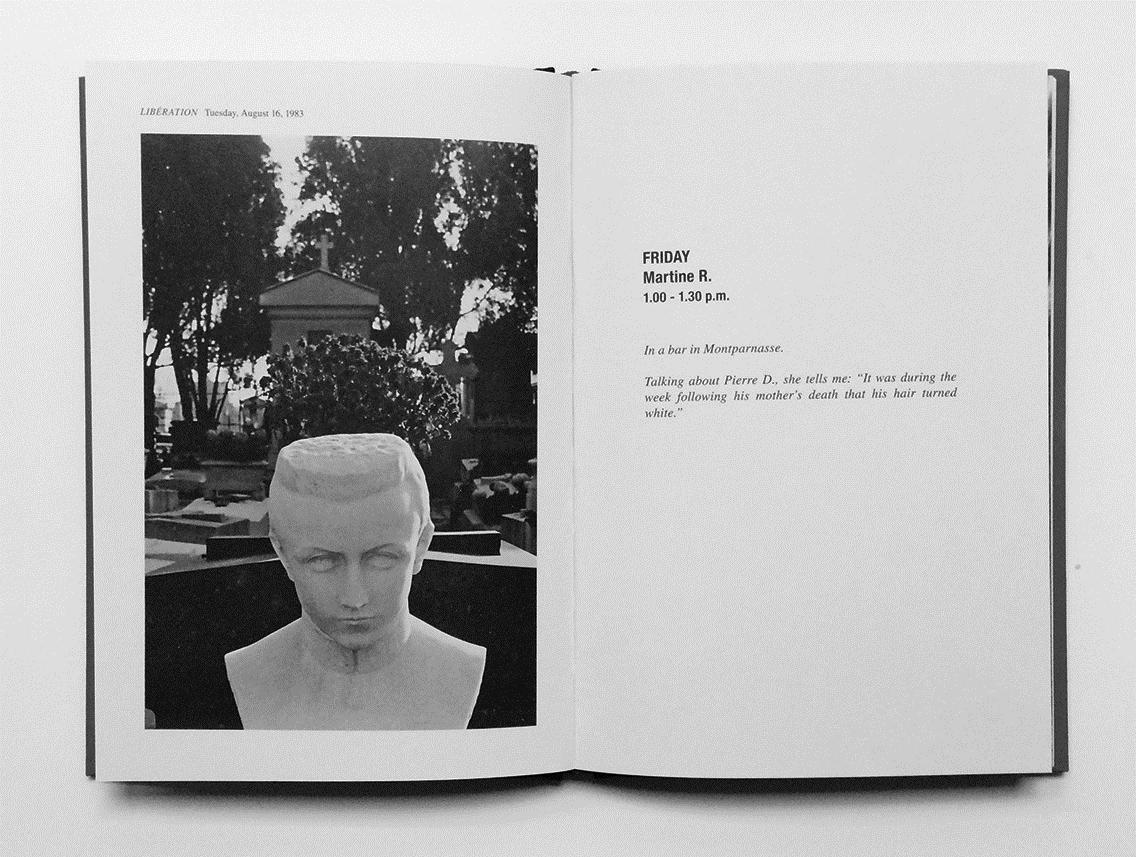
Literature and practice review | 71
Figure 11 Susan Hiller, 10 Months, 1977-1979, 10 black and white composite photographs and 10 captions (Source: Hiller, 2011, p. 61).
Figure 12 Sophie Calle, The Address Book, 1983 (Source: Calle, 2012)
Renée Green inhabited an apartment at Le Corbusier’s Unité d’habitation in Firminy, France, and documented the daily rituals she developed in this space through video, sound, writing, and still photographs (Figure 13). As Gangitano (2010) explains, the artist produced this work by constructing a traveller’s diary and adapting methods relevant to the issues of travel, displacement, and nomadism that became recurrent in her work.

Literature and practice review | 72
Figure 13 Renée Green, Secret, 1993. Black and white photographs. (Source: Green, 2000, pp. 122 and 124)
The last artist I would like to highlight here in the context of diaristic practice is Tehching Hsieh. His One Year Performances (Figure 14) are an example of daily processes of registering time, such as entries in a diary. According to Heathfield, Hsieh ‘commits his will and his body to serial durational aesthetic experiments’ and is interested in creating durational art processes as spaces for ‘thinking about art’ as an artwork itself (Hsieh and Heathfield, 2009, p. 16)
In this work, Hsieh punched a time clock in his studio every hour for one year from 11 April 1980 at 7 p.m. to 11 April 1981 at 6 p.m. The performance was documented with a 16mm movie camera, which shot a frame each time the artist punched the clock. Hsieh affirmed, ‘at the completion of the performance, the witness will confirm that the film is unedited’ (Hsieh and Heathfield, 2009, p. 104). The artist also shaved his head at the beginning of the performance to stress the passage of time.
Literature and practice review | 73
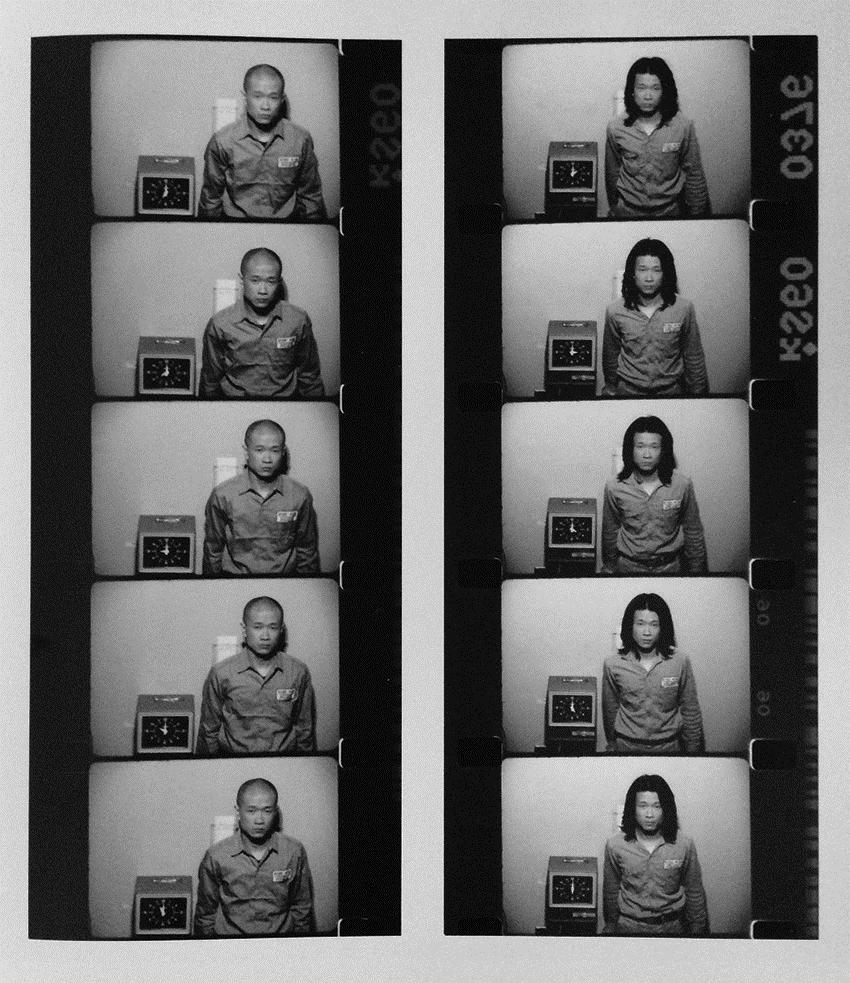
Diary is a place where people can think about who they are in relation to others, which is an important exercise for understanding one’s own position in the world (Bayley, 2016; Cottam, 2001; Progoff, 1987). As a genre that stimulates an ‘open and improvised self, the diary has, over many centuries, been readily pulled into a variety of shapes to embrace new forms and widely various experiences of subjectivity’ (Cottam, 2001, para. 11). The following sections present three diarists that have influenced my understanding and practice of diary.
Literature and practice review | 74
Figure 14 Tehching Hsieh, One year performance: Time Clock, 1980-1981. 16mm movie camera frames. (Source: Hsieh and Heathfield, 2009, p. 127)
2.2.1.1 Anaïs Nin
In her diary, Anaïs Nin defines her personal life as ‘the laboratory in which poetry is produced’ and her diary as an adventurer’s log, a notebook, a sketchbook, and a source for her other creative practices (Nin, 1976, p. 299). She started her diary when she was eleven, on her way to the USA. Its initial objective was to address her father, who abandoned the family. Her diaristic practice continued throughout her lifetime and her diaries became a place for intimacy created through writing and ‘places-beyond’, both built through publishing (Bloom and Holder, 1980, p. 215). For Nin, ‘one writes because one has to create a world in which one can live’ (1974, p. 149). She confesses that she could not live in any other worlds offered to her and explains, ‘I had to create a world of my own, like a climate, a country, an atmosphere in which I could breathe, reign, and re-create myself when destroyed by living’ (Nin, 1974, p. 149). For her, this is the reason of every work of art, and the artist needs to choose the ways and select the elements to build this place.
2.2.1.2 Virginia Woolf
In 1923, Virginia Woolf wrote in her diary that the diary did not count as writing: for her, it seemed too rough, random and ungrammatical. Her diary served ‘to explore and solve problems with her writing’ (Bloom and Holder, 1980, p. 211). By asking herself about how her diary should be, Woolf answers, ‘something loose knit and yet not slovenly, so elastic that it will embrace any thing, solemn, slight or beautiful that comes into my mind’ (Woolf, 2012, p. 13). Moreover, she tells how keeping a diary might be eventually connected to loneliness: ‘the diary shall batter on the leanness of my social life. Never have I spent so quiet a London summer’ (Woolf, 2012, p. 109). ‘Elastic’ and ‘expanding’ are characteristics she attributes to her diary writing. According to Cottam, the diarist often casts life's materials and loose ends without arrangement and then ‘the diary is written in a compulsive attempt to “hold” and store literally all of the diarist's experience’ (Cotam, 2011, para. 1).
Literature and practice review | 75
2.2.1.3 Carolina Maria de Jesus
Carolina Maria de Jesus is a Brazilian writer who lived in a favela in the borough of Canindé, in São Paulo city. She was born in Sacramento, in the state of Minas Gerais, where she attended school only up to the second grade because she had to leave to follow her mother who had found a job on a farm. After a while, they left again for the state of São Paulo (Jesus, 2013).
Carolina wrote poems, novels and plays, and became known worldwide by her diaries. Her first book, Quarto de Despejo (2005), was a huge success. It was translated into fourteen languages and enabled her to leave the favela for a brick house in the suburbs of São Paulo city. In English, this book was given the title Child of the Dark (2003), which does not reflect the meaning of ‘quarto de despejo,’ which would be translated literally into English as ‘lumber room’ or ‘garbage room.’ Carolina eventually used this expression in her diaries to compare poor people who live in the slums to others from the rest of the city. She writes, for instance, that favelas are lumber rooms of the city, and favelados, i.e. people who live in favelas, are the worthless things stored there (Jesus, 2003 and 2005). Additionally, she directly relates her ‘self’ to something stored in the quarto de despejo, ‘quando estou na favela tenho a impressão que sou um objeto fora de uso, digno de estar num quarto de despejo’ (Jesus, 2005, p. 33), i.e. ‘when I’m in the favela I have the impression that I’m a useless object, destined to be forever in a garbage dump’ (Jesus, 2003, p. 29). Therefore, ‘child of the dark’ is an expression that erases from the title one of the locations to which Carolina not only refers, but where she sometimes positions herself and wants to leave. Moreover, ‘dark’ connects to the hidden aspects of coloniality mentioned earlier by Walter Mignolo (see section 1.2).
This book presents powerful accounts on Carolina’s daily routine as a black woman living in poverty. She often demonstrates her passion for writing and mentions the conditions of her writing practice, for instance, ‘cheguei em casa, fiz o almoço. Enquanto as panelas fervia eu escrevi um pouco’ (Jesus,
Literature and practice review | 76
2005, p. 16), translated as ‘Returned home. I made lunch. While the pots boiled, I wrote a little’ (Jesus, 2003, p. 11). Or, ‘Depois fui lavar roupas. Enquanto as roupas corava eu sentei na calçada para escrever’ (Jesus, 2005, p. 20), i.e. ‘Then I went to wash the clothes. While the clothes were bleaching I sat on the sidewalk and wrote’ (Jesus, 2003, p. 16).
In the English edition, the text loses the grammatical errors or idiosyncrasies present in the original, which transforms Carolina’s voice. Yet the translator of the English edition, David St. Clair, states in the book’s preface that ‘none of this has been altered in the translation, for to do it would be to alter the woman herself,’ as a native Portuguese speaker I can affirm that the content is there, but I cannot feel Carolina in the text. Of course, it is practically impossible to translate some kinds of specificities that are deeply tied to cultural and contextual appropriations of a specific language. As Trinh T. Minh-ha affirms, ‘to strive for likeness to the original – which is ultimately an impossible task – is to forget that for something to live on, it has to be transformed’ (Minh-ha, 1994, p. 18). However, if translation is also a matter of ‘relationship between languages’ (Minh-ha, 1994, p. 18) and it involves intimacy – to the text and the subject (Spivak, 2009 and 2012), it is worth asking where Carolina was and which role she played in the whole publishing and translating processes of her books
It was the journalist Audálio Dantas who decided that her diary was worthier of publishing in relation to her other writing pieces Even though Carolina argued, ‘I didn’t write it for anyone to see. It is filled with ugly things and ugly people. Maybe after I die it will be published, but not now’ (Jesus, 2003, p. xii). However, the journalist convinced her to let him take one of the manuscripts and published excerpts in a local newspaper to ‘test’ its reception among readers. Dantas worked on Carolina’s diary for one year, ‘ignoring the childlike [sic] novels, and concentrating on her diary, extracting the best of each part’ (Jesus, 2003, p. xii, my italics). Moreover, Dantas had to convince Carolina ‘to agree to publish excerpts from her account of her daily
Literature and practice review | 77
life. She wanted her short stories and poems published first’ (Jesus, 2003, p. xii).
Elzira Divina Perpétua (2002, 2003 and 2014) explains that in the year following the publication of the diary Carolina said to journalists that this achievement was a sad glory, since it did not represent her free will and she did not have much say in the decision on the final book. Carolina also affirms that she was persuaded to divert from what she wanted initially and asks, ‘What am I now? An exploited doll and I refuse it’ (Loyola, 1961 quoted in Perpetua, 2002, p. 39, my translation). Later, the journalist who organised, edited and published Carolina’s diary argued that he did not rewrite her diary; the words and ideas are Carolina’s own The only thing he did was to edit them (Jesus, 2003, p. xiii). However, according to Perpétua, who compared Carolina’s manuscripts to the published diary in Portuguese, the suppressions made by the editor left important information out, such as reflections on life and on politics, and affected the image Carolina constructed about her ‘self’ (Perpétua, 2003, p. 64). In this way, the published diary results in a character that aims to represent a collective – people living in the favelas – rather than the singularity of a woman, who keeps losing her particularities through processes of translation controlled by others It seems that Carolina’s self was pulverised throughout the whole publishing process As Perétua (2003) affirms, it positions Carolina as a product and not as a producer of her own destiny.
Carolina’s work constantly reminds me of the relational aspect of life writing, the differences between representation and enunciation, the power relations and negotiations surrounding editing and publishing, and the function of writing, which in Carolina’s case works ‘less as an act of catharsis than a way to resist poverty’ (Perpétua, 2014, p. 264, my translation). Moreover, Carolina herself, as a Brazilian woman creating conditions to express and enunciate her world, reminds me about the relevance of the politics of location, decolonial option, and epistemologies of the South against epistemicide, i.e. against the destruction and/or diminishing of local ways of knowing by a
Literature and practice review | 78
monoculture form of knowledge production (Santos, 2014). An epistemology of the South involves learning that the South exists, learning to go to the South, and learning from the South and with the South (Santos, 2014).
Carolina’s diary can teach us about these three steps. When asked why she began to write, she answered: ‘Quando eu não tinha nada o que comer, em vez de xingar eu escrevia. Tem pessoas que, quando estão nervosas, xingam ou pensam na morte como solução. Eu escrevia o meu diário’ (Jesus, 2005, p. 170), i.e. ‘When I had nothing to eat, rather than calling names I wrote. Some people, when they are nervous, call names or think on death as a solution. I write in my diary’ (my translation).
Carolina also evokes Freire’s understanding of the culture of silence, since she makes us think on Freire’s question about who has the right to write and who has not. Paulo Freire (1996), while reflecting upon education as cultural action for freedom, explains how a culture of silence has historically taken place in the Third World [sic] due to alienation and control of the thought-language of popular masses by the elites. He suggests that people from diverse strata of society are still unable ‘to assume the posture of one who “has a voice,” of one who is the subject of his [and her] choices, of one who freely projects his [and her] own identity’ (Freire, 2000, p. 11). Freire adds that one of the more important tasks within such context is ‘the conquest of its right to a voice, of the right to pronounce its word’ (Freire, 2000, p. 11). In the culture of silence, which implies a ‘natural’ inferiority to the ones who are located in it, people are mute, they do not believe in the transforming, creative and re-creative power of their own actions, ‘they are prohibited from creatively taking part in the transformations of their society and therefore prohibited from being’ (Freire, 2000, p. 21). Thus, it is possible to affirm that the culture of silence is closely related to the colonial wound.
Literature and practice review | 79
2.2.2 Memoir
The word ‘memoir’ derives from mémoire, which is the French word for ‘memory’ and defines the life writing genre that records autobiographical events of one’s life. However, it differs from the traditional autobiography, since it does not intend to cover extensive and chronological records. A memoir aims to be more selective and focused on specific social and historical backgrounds, sources, themes, and periods that can personalize history and, at the same time, historicize the personal (Buss, 2001). Unlike the diary, which comprises serial, fragmented, and intimate first-person entries, the memoir is usually produced to be published and shared with wider audiences. Moreover, it melds public and private histories where the writer’s self cannot be viewed separately from others’ lives (Couser, 2012; Smith and Watson, 2010; Stanley, 1992; Winslow, 1995).
Couser (2012) explains that by calling memoir a life writing ‘genre,’ he does not mean that it is a mere literary form. On the contrary, the word ‘genre’ refers more to the impact that one’s narrative seeks to have in the world (Couser, 2012, p. 9). Buss argues that in order to understand memoirs, the term ‘genre’ must be considered not as a traditional set of writing practices, but as a ‘particular ideologically shaped discourse’ that ‘arises from particular social needs, empowers a particular class of people, and becomes a cultural practice’ (Buss, 2001, para. 3). In this way, instead of asking why the life of a memoirist is important or distinguished enough to be written and published, it is necessary to pay attention to the politics of location and ask ‘what is the place of this writer in the culture represented’ (Buss, 2001, para. 3).
Memoir is considered an inclusive and democratic life writing genre because it is widely used outside the literary establishment. Anonymous individuals who want to understand, reflect upon, and disclose their personal stories about family, immigration, exile, illness, body disability, ageing, or death, for example, have been using memoir as platform for articulating, telling and sharing narratives on such experiences with others. These are called ‘nobody
Literature and practice review | 80
memoirs’, a term first coined by Lorraine Adams and spread in life writing circles by Couser (Adams, 2002; Couser, 2012; Smith and Watson, 2010).
Couser (2012) reminds us that the memoir is rooted in the ways people represent their lives, make identity claims, and locate themselves through spontaneous narratives and personal stories connected to everyday life.
Rather than registering pre-existing selfhood, memoir nurtures processes that bring new selves into being and ‘has been a threshold genre in which some previously silent populations have been given voice for the first time’ (Couser, 2012, p. 12).
It is this accessibility that allowed memoir to endure over centuries. In the past, memoir used to be practiced by everyone, from religious zealots to courtesans, from travel writers to pioneers, from business men to retired generals, from presidents to prostitutes, from former slaves to transgendered individuals (Buss, 2001, para. 2).
Memoirists wish to become part of the public history and be counted in public records for telling their stories that are also stories about people with whom they are interrelated. Thus, memoir is relational and together with diary it constitutes the earliest example of feminism in life writing (Buss, 2001).
2.2.2.1 Language Memoir
A memoir can be written about any life circumstance, such as ‘picking apples, keeping a kosher kitchen, being a lesbian, or being a mother’ (Buss, 2001, para. 7). Alice Kaplan (1994) wrote a memoir about learning a new language.
When Kaplan (1994) perceived that there is an entire genre of autobiographical writing in this field, she coined the term ‘language memoir.’ Through investigating a set of scholarly disquisitions on second language acquisition in linguistics, sociology, and education fields, she found methods and statistics rather than people’s voices about learning a new language
Literature and practice review | 81
(Kaplan, 1994). Then, she realised that her writing could be something more alive and denser than the academic style she was developing, and decided to go through literature rather than theory to address her experiences with a second language. Memoir seemed to be a perfect autobiographical form with which she could approach her own language-learning experience, as well as generating and communicating knowledge within this process (Kaplan, 1994).
Language memoir is, therefore, a cross-cultural narrative focused on personal experiences with a new language. Writing about crossings from one language to another and, thus, from one culture to another, highlights the problem pointed by Mignolo (2000) about the complicities between language and the notion of empire and nation. He argues that,
While the imaginary of the modern world system focused on frontiers, structures, and the nation-state as a space within frontiers with a national language, languaging and bilanguaging, as a condition of border thinking from the decolonial difference, open up to a postnational imaginary (Mignolo, 2000, p. 253).
However, Kaplan’s language memoir, French Lessons, does not focus on such decolonial aspects. Kaplan is a Jewish descendent North American born middle class white woman who had the privilege to travel and study French in Switzerland and France. In her book, she tells how her family made a quick transition from diaspora Yiddish to American English, and how her parents were the ‘first ones in their family to be born into English’, which made the Jewish accent disappear within only one generation (Kaplan, 1993, p. 7).
Kaplan’s language memoir is a non-fictional piece motivated by her curiosity in knowing ‘what is going on inside the head of the person who suddenly finds herself passionately engaged in new sounds and a new voice’ (Kaplan, 1994, p. 59). Her narrative on becoming an adult woman and teacher is deeply anchored in her relationships with French language, and the reasons that led her to learn French were connected to her father, ‘because French made me absent the way he was absent, and it made me an expert the way he was an expert’ (Kaplan, 1993, p. 204).
Literature and practice review | 82
Moreover, daily events of her life became linked to the pleasures and challenges of becoming (another person) in another language. She tells, for example, how she loved hearing her French teacher getting upset in French, or that her own ears were ‘getting stronger and stronger’ despite the failure of her mouth to get the right ‘r’ sound, which is the real passport to ‘being
French’ (Kaplan, 1993, p. 48). For her, trying too hard to speak the language meant not-belonging; for becoming a French woman, language should go smoothly.
As I observed through the interviews I carried out with the participants of this research (see section 3.2), food and intimate relationships are often the background for learning a new language. In Kaplan’s memoir, she tells how food and language were constantly related to each other in her daily learning experience, and that by eating one can get new words (Kaplan, 1993, p. 53). On the other hand, in her intimate relationship with a French boyfriend, she was told by him that she was able to understand only his words, not his language. These differences between words and worlds made her often ask why the French word she says is not the same as the one her boyfriend says, and what she should do to make it be the same (Kaplan, 1993, p. 89).
Personally, Kaplan refers to her second language as a place to hide, ‘I know now that my passion for French helped me to put off what I needed to say, in English, to the people around me’ (Kaplan, 1993, p. 214). Additionally, as a French teacher, she sees the second language as an opportunity to rebuild the self, ‘speaking a foreign language is, for me and my students, a chance for growth, for freedom, a liberation from the ugliness of our received ideas and mentalities’ (Kaplan, 1993, p. 211). Then, she acknowledges that for immigrants learning a new language might become a traumatic experience, different from what happens to her students, for example, who can practice since no one is unemployed or hungry, ‘no one will flunk a citizenship test or be sent back to Ellis Island’ (Kaplan, 1993, p. 134)
Literature and practice review | 83
Through her investigations on the specificity of autobiographical narratives constructed around language-learning experiences, Kaplan realises that there is much to research in this field. Her memoir was not only about learning French, but ‘to think about language and identity; to say what happened to my identity when my language changed from English to French; to say what it has meant to me to take on the attributes of French culture’ (Kaplan, 1994, p. 59).
Aneta Pavlenko suggests that language memoirs are a ‘unique source of information about learners’ motivations, experiences, struggles, losses, and gains’ in relation to their new cross-cultural experiences (Pavlenko, 2001, p. 213). She argues that social, cultural, and historic conventions shape language learning autobiographies, and ‘researchers should approach language learning memoirs as a genre and not simply as ethnographic data, subject to content analysis’ (Pavlenko, 2001, p. 213). This means that language memoirs can make a valuable contribution as artistic and literary products, working as tools for the assessment of learning a language, but also as pieces of art and/or literature. Language memoir can inform the individual learners’ trajectories and offer insight into which learners’ stories on language are as yet untold (Pavlenko 1998, 2001, 2006 and 2007; Pavlenko and Norton, 2007; Pavlenko and Piller, 2004 and 2007)
Although her study concentrates on memoirs and essays written in English by writers who ‘acquired English successfully, or by Americans who had attempted to learn another language’ (Pavlenko, 2001, p. 235), the author recognizes the necessity to investigate narratives of different groups in different socioeconomic positions. Additionally, it is crucial to gather learning language experiences from unpublished voices. She asks about the stories of unknown language learners and what their stories could tell us about the links between ‘language learning and race, class, gender, and sexuality’ (Pavlenko, 2001, p. 237). I would add: between language learning and place.
Literature and practice review | 84
2.2.3 Correspondence
According to Lejeune (2008), a letter is shareable by definition. It is an object of exchange that starts belonging to the addresser and is transferred to the addressee by the act of posting. A letter has basic elements such as date, signature, and an address. The date, also reinforced by the postmark, might specify the day when it was written and sometimes certify that it was written on that day. According to Lejeune, ‘it is a pact of truth: backdating a letter or a contract is cheating’ (Lejeune, 2009, p. 79). Yet, an archive of received letters forms a dialogue of dates, which involves ‘waiting, forgetting, laziness, silence, and crossed communications’ (Lejeune, 2009, p. 84).
Lejeune sees connections between diary and letter: while diary might be considered as a result of the letter that became private, ‘the letter itself becomes a diary from the moment a single letter distinguishes several times of enunciation by dating them’ (Lejeune, 2009, p. 86) In the late eighteenth century in western Europe, letters were considered as both private writings and ‘public documents to be shared within a literary circle’ (Smith and Watson, 2010, p. 273). They became vehicles to circulate information, enact social roles, strengthen relationships, and address the self, ‘often in a paradoxical mix of intimacy and formality’ and following strict conventions that are ‘implicated in ideologies of gender, ethnicity, class, and nationality’ (Smith and Watson, 2010, p. 273).
In this research, I am interested in correspondence as a piece of writing that associates ‘self’ to specific dates, times, places, and narratives about being somewhere else. In this context, the postcard became the central piece of the correspondence I developed through my practice, which is grounded on selflocation exercises within geographical displacement and towards the decolonial self. Therefore, in this thesis I focus on postcards as bound portions of space represented by images and narratives about location that, together, certify a passage. This kind of correspondence is often used to address ‘here’ to ‘there’ and has the power to inscribe places in people’s
Literature and practice review | 85
imaginary and to influence the construction of mind maps and colonial discourses (see section 3.1.4).
Many artists have used correspondence as medium of their work. On Kawara, for example, created a postcard series called I Got Up in which he informed his addressees about the date and time when he arose from bed (Figure 15). Rather than handwriting, he rubber-stamped the message, what Watkins sees as ‘his personal impression, albeit with an impersonal appearance’ about a ‘mass-produced touristic image’ (Kawara, 2002, p. 92). Through sending postcards, Kawara documented his trajectories from one city to another.
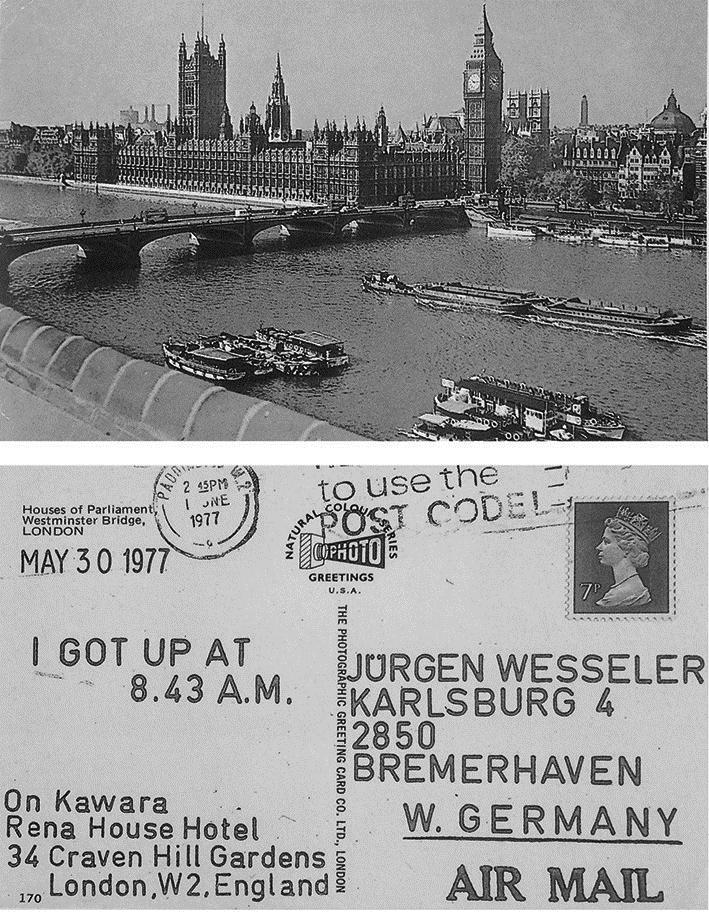
Literature and practice review | 86
Figure 15 On Kawara, I got up, 1977. Postcards, 8.3 x 14.0 cm. (Source: Kawara, 2002, p. 97)
Susan Hiller collected over 300 postcards of the series Rough Seas to make a series called Dedicated to the Unknown Artist (Figure 16), in which she created a methodology to approach postcards details, such as ‘location, caption, legend, and vertical or horizontal format’ (Hiller, 2011, p. 52). The artist also explores relationships between painting and photography, and refers to the work of unknown artists who produced such images and cultivated a public imaginary about these seascapes.
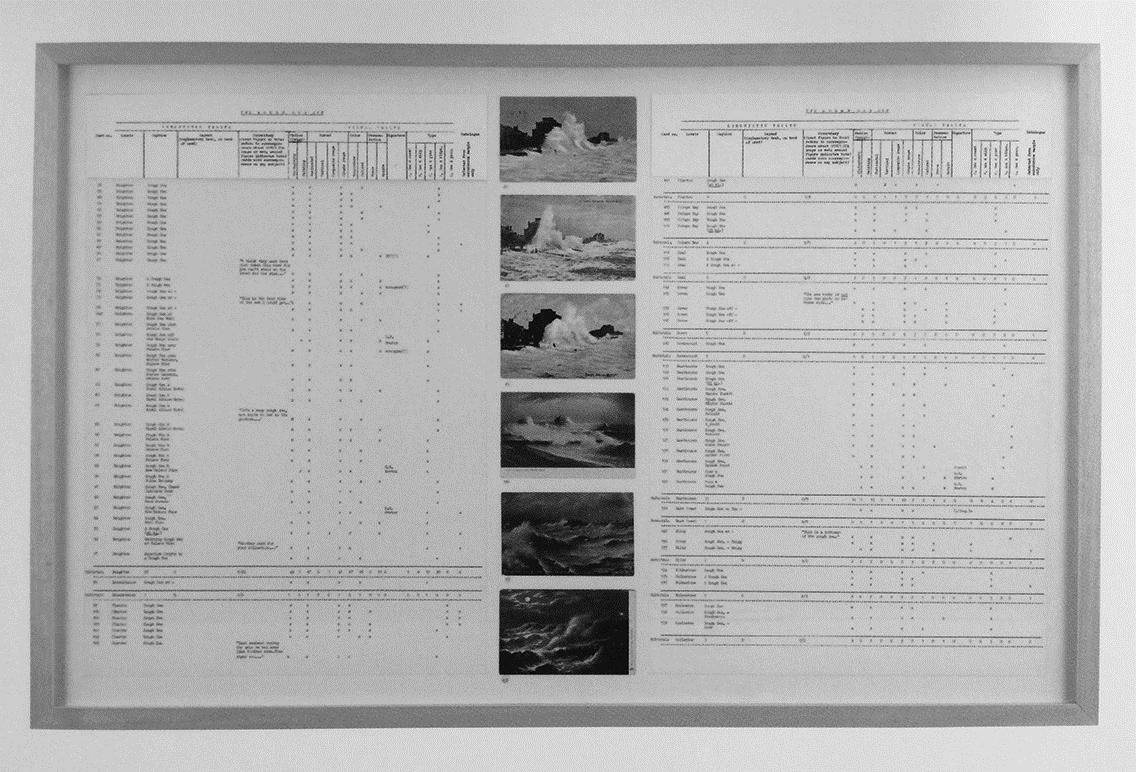
Lastly, I highlight the work of Paulo Bruscky (see section 2.3.6), who is one of the precursors of mail art in Brazil (Amaral, 2006a). He used correspondence to strengthen an international network of artists in a period when dictatorial regimes were spreading out in Latin America (Figure 17). For this artist, there is an ethics grounded on the exchange process implied by mail art, through which collaboration builds a counter-hegemonic art movement. Bruscky used postcards, envelopes, letters and other means as platforms for building his extensive correspondence work as well as international exchange network (Freire, 2006).
Literature and practice review | 87
Figure 16 Susan Hiller, Dedicated to the Unknown Artists, 1972-1976. Postcards, sea charts and map mounted on panels, books, dossiers and exhibition catalogues. Support, each: 660 x 1048 mm. Tate collection. (Source: Hiller, 2011, p. 53)

Literature and practice review | 88
Figure 17 Paulo Bruscky, série Envelopes, 1977-2009, mail art. (Source: Bruscky and Navas, 2012, p. 74).
2.3 Context of practice
Like the theorists who have influenced my work, there are particular artists whose works constitute a constellation of references that, in one way or another, touch the fields and concepts presented in this research. These artists are connected to conceptual art, visual poetry, socially engaged art, transnational contemporary art, and accented cinema. My understanding of art within society and the roles of the artist also as researcher and teacher has been influenced by such constellation. Together, they indicate the porous contours of my current practice.
2.3.1 Stephen Willats
Stephen Willats is part of a group of artists who ‘used the movement away from the object initiated by conceptualism to develop a collaborative, dialogical art practice in the 1960s and 1970s’ (Kester, 2004, p 91). He has developed an interdisciplinary art practice focused on community-based participatory art projects carried out through conceptual model-based activities. Moreover, he proposes a social model of art practice and claims that the audience is as important as the artist in the creation and reception of works of art, which can intermediate exchanges between the two rather than being transformed into an object of fetish (Willats, 1986, 2000, 2012a and 2012b).
By arguing that it ‘is the artist who will have to articulate a coherent social model of his own art practice’ (Willats, 2012a, p. 13A), Willats suggests a shift in the artwork place from the object to the audience (Figure 18). To achieve this shift, he argues that the artist ‘must seek to find personal reinforcement from other cultural activities associated with expressing a counter consciousness’ (2012a, p. 13B).
Literature and practice review | 89

Willats has developed a practice focused on ‘the possibility that art might not only help us to recalibrate the way we understand the world, but also bring us together to give it a new shape’ (Willats, 2012b, p. 39). Therefore, more than producing art objects, he is interested in creating model-based strategies for unveiling social relations. For him, art as a social process is ‘a model of a counter consciousness for social relationships based on self-organisation and mutualism’ (Willats, 2012a, p. 13B), in which art practice as a social practice might work as a method that ‘implies intersubjectivity not merely in its theoretical stages but also in its practical realisation’ (Willats, 1986, p. 29).
In the 1960s and 1970s, Willats engaged with communities from suburban housing estates of London, Edinburgh and Berlin in order to create spaces to stimulate dialogue, self-reflection and critical thinking on people’s experiences related to gentrification and its consequences, such as loneliness, routine changes, impacts on senses of self and community, problems with urban mobility, working conditions, and psychological pressures. He mediated
Literature and practice review | 90
Figure 18 Stephen Willats, A model of contextual practice, 1970. Drawing. (Source: Willats, 2012b, p. 6).
group activities by using audio recording, questionnaires, interviews, and practices like photography and collage, which usually resulted in diagrammatic panels as a means to presenting data gathered among participants (Figure 19).
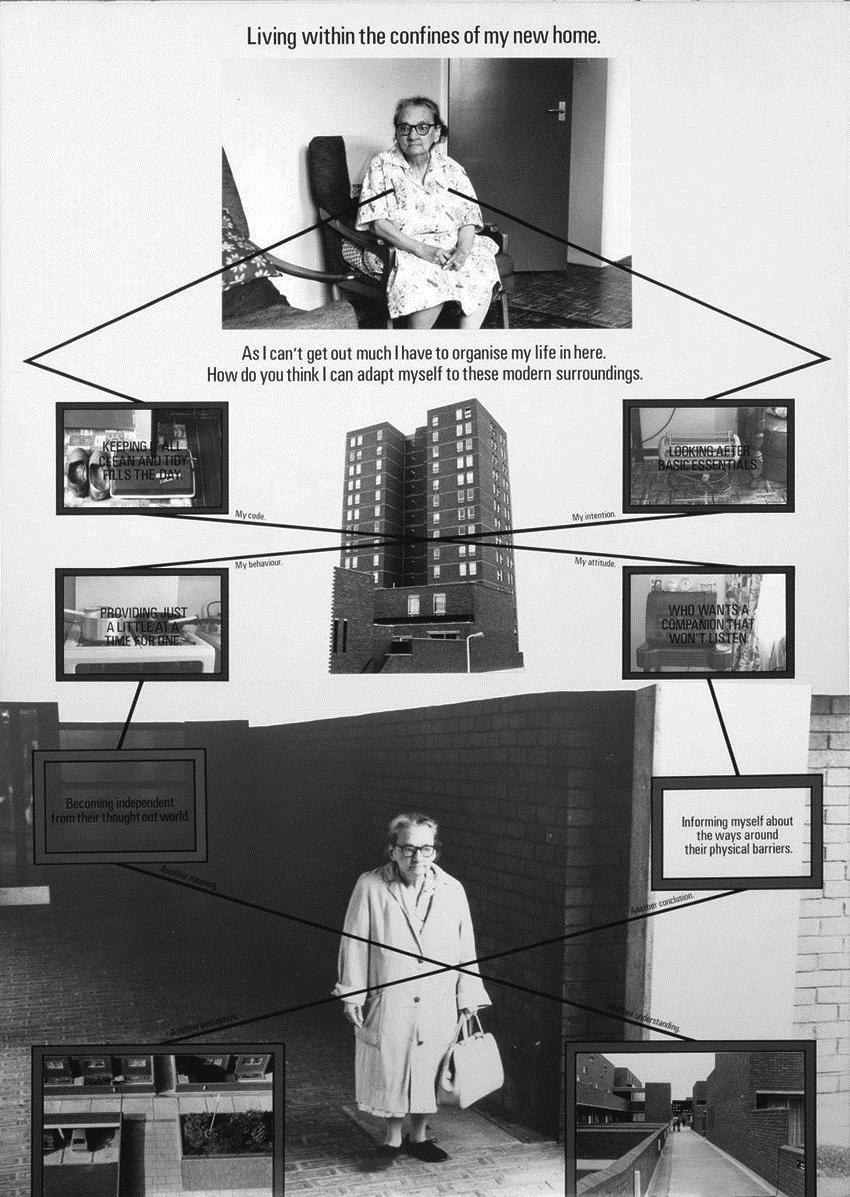
Literature and practice review | 91
Figure 19 Stephen Willats, Living with practical realities, 1978. Triptych left. Mounted black and white photographs and transfer lettering on card, framed, 3 frames each 43 1/4×30 1/4 (110×77). Tate Collection, London. (Source: http://www.tate.org.uk).
Willats’s (1986) methodology has been influenced by experimentation in behaviourism, systems theory, social sciences, advertising, and cybernetics. Moreover, the homeostatic system (an auto-regulatory system in which there is a balance within its internal environment in relation to external conditions) has served as a metaphor for defining the general model he has used for framing his art projects. In Figure 20, there is a basic model of a homeostat showing total coupling between A, B, C, D, ‘thus enabling a free flow of information between any points in the structure’ (Willats, 2000, p. 172). The artist argues that at this position, all elements in the system have the same value, although in an unequal social relation of power this assertion might be questioned.
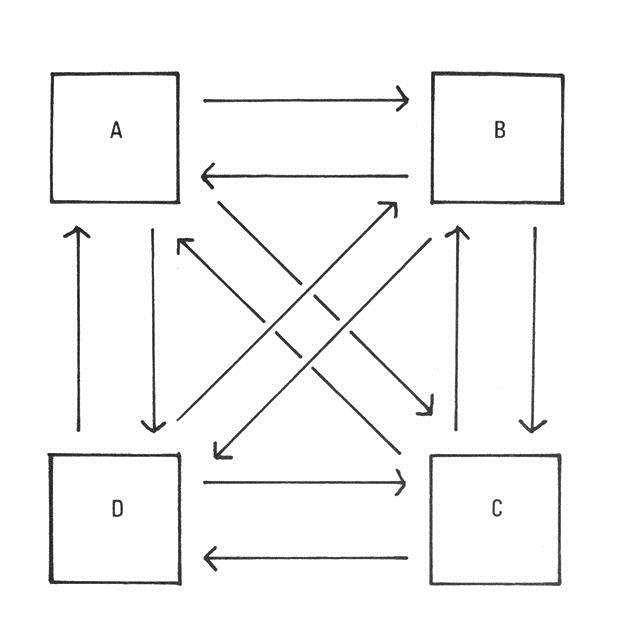
In 1976, Willats wrote a book called Art and Social Function (2000), in which he addresses issues on the future of art and explains how the homeostatic system became relevant as a general model for thinking his social and artistic practice. He defines ‘model’ as ‘a set of interconnected representations that
Literature and practice review | 92
Figure 20 Stephen Willats, Homeostat model, 1969. Drawing. (Source: Willats, 2000, p. 172)
are used to illustrate the state of a more complex structure’ (Willats, 2000, p. 16). Through building symbolic structures to express essential ideas he organises resources and outcomes from activities developed with a group of people. The artwork, for him,
is a dynamic structure of events in time, dependent on exchanges between people, reflecting their inherent relativity in perception, being tied to a context that was already meaningful to those people (Willats, 2000, p. 8).
In this way, the domains of art can be extended beyond ‘the given territory legitimised by the institutions of art for operation, and could find meaningful ways of functioning within the daily fabric of people’s lives’ (Willats, 2000, p. 9).
Literature and practice review | 93
2.3.2 Trinh T. Minh-ha
Trinh T. Minh-ha is a postcolonial feminist theorist, artist and film-maker who was born in North Vietnam, grew up in South Vietnam, and immigrated to the United States. Through her works, she challenges essentialist and binary views on identity, gender, and scholarship, offering ambivalent, hybrid and transient approaches to the displaced, postcolonial and gendered self (Minhha, 1994 and 2011). For her, every voyage involves a repositioning of boundaries; the travelling self – which is formed by both a self that moves physically and a self that ‘embarks on an undetermined journeying practice’ (Minh-ha, 1994, p. 9) – needs to be constantly negotiating her or his position between ‘home and abroad, native culture and adopted culture, or more creatively speaking, between a here, a there, and a elsewhere’ (Minh-ha, 1994, p. 9, italics in original). In such movements, language plays ambivalent roles because it becomes both a calling back to home and ‘a site of change, an evershifting ground’ (Minh-ha, 1994, p. 10). Thus, interaction and translation become results of the experience of displacement, and keep challenging the traveller’s perception of reality, offering her or him ‘the possibility of an elsewhere-within-here, or -there’ (Minh-ha, 1994, p. 11).
Hamid Naficy (2001) locates Trinh T. Minh-ha in the group of filmmakers who come from the global South, experience relocation to northern cosmopolitan centres, and live the tensions in relation to both their original and current home. He has coined the term ‘accented cinema’ to analyse the work of displaced filmmakers who have an interstitial location and use their practice to create autobiographical places within displacement. Accented films involve collective modes of production of ‘fragmented, multilingual, epistolary, selfreflexive’ filmic narratives on themes involving ‘journeying, historicity, identity, and displacement’ (Naficy, 2001, p. 4). The term ‘accent’ can refer to features of pronunciation that indicates where a person is from or an emphasis in speech regarding a particular syllable of a word. Nonetheless, ‘accent is one of the most intimate and powerful markers of group identity
Literature and practice review | 94
and solidarity, as well as of individual difference and personality’ (Naficy, 2001, p. 23).
Accented films’ strategies are more related to translation than representation and the films’ frames might become a space for experimenting with multiple languages, voices, and accents. Spivak (2009), for example, argues that language is one of the elements that help us make sense of things and ourselves, and by making sense of ourselves we produce our identities. In this process, it is important to consider that translation from one language into another implies a deep approximation because translating is ‘the most intimate act of reading’ (Spivak, 2012, p. 257).
From the decolonial point of view, the Zapatista19 movement has taught, among other things, about ‘double translation’ theory (Mignolo and Schiwy, 2007). This differs from the one-way direction translation process implied by the modern/colonial world system based on the metropolitan interests. Under the colonial perspective, translation is in the principles of epistemic colonial power and might work as a tool for stressing colonial difference, which tends to racialize people and make them ‘seen as inferior by the dominant discourse’ (Mignolo, 2011a, p. 214). This is a kind of translation that leads to conversion instead of conversation, reinforcing ‘the colonial difference between Western European languages (languages of the sciences, knowledge and the locus of enunciation) and the rest of the languages on the planet (languages of culture and religion and the locus of the enunciated)’ (Mignolo and Schiwy, 2007, p. 14). Thus, the Zapatistas’ theory on translation is conceived as a re-educational process called ‘translanguaging,’ which is ‘a way of speaking, talking, and thinking in between languages’ (Mignolo and Schiwy, 2007, p. 31). Translanguaging offers, therefore, alternative places for border thinking where new perspectives to think translation/transculturation can be built through ‘double consciousness of subalterns in confrontation
19 The Ejército Zapatista de Liberación Nacional (EZLN), i.e. Zapatista Army of National Liberation, is a revolutionary movement of civil resistance formed by autonomous indigenous communities based in Chiapas, Mexico. See http://zeztainternazional.ezln.org.mx/ and http://enlacezapatista.ezln.org.mx/
Literature and practice review | 95
with hegemony’ (Mignolo and Schiwy, 2007, p. 26). In this way, translation as translanguaging turns hegemonic languages into tools for connection, struggle, justice and transformation.
Trinh T. Minh-ha uses a myriad of languages and accents in her films. For instance, in Surname Viet Given Name Nam (1989) she mixes English and Vietnamese languages across texts, speech, and folk chanting; there are Vietnamese women speaking in accented English while subtitles are ‘out of sync, lagging behind or running ahead of the subjects’ utterance. In addition, the subtitles do not exactly match what the women are saying’ (Naficy, 2001, p. 122). Titles and subtitles are superimposed on images in order to function as graphic, critical and deconstructive elements (Figures 21 and 22), and while Naficy calls these texts ‘calligraphic accent’, Minh-ha considers them ‘visualised speech’ (Naficy, 2001, p. 123).
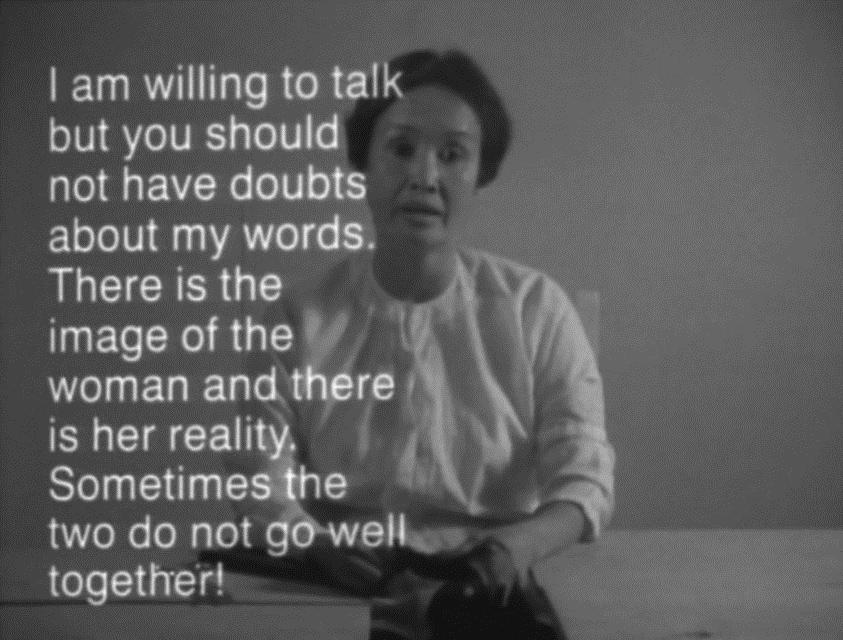
Literature and practice review | 96
Figure 21 Trinh T. Minh-ha, Surname Viet Given Name Nam, 1989, Film frame, 32:20
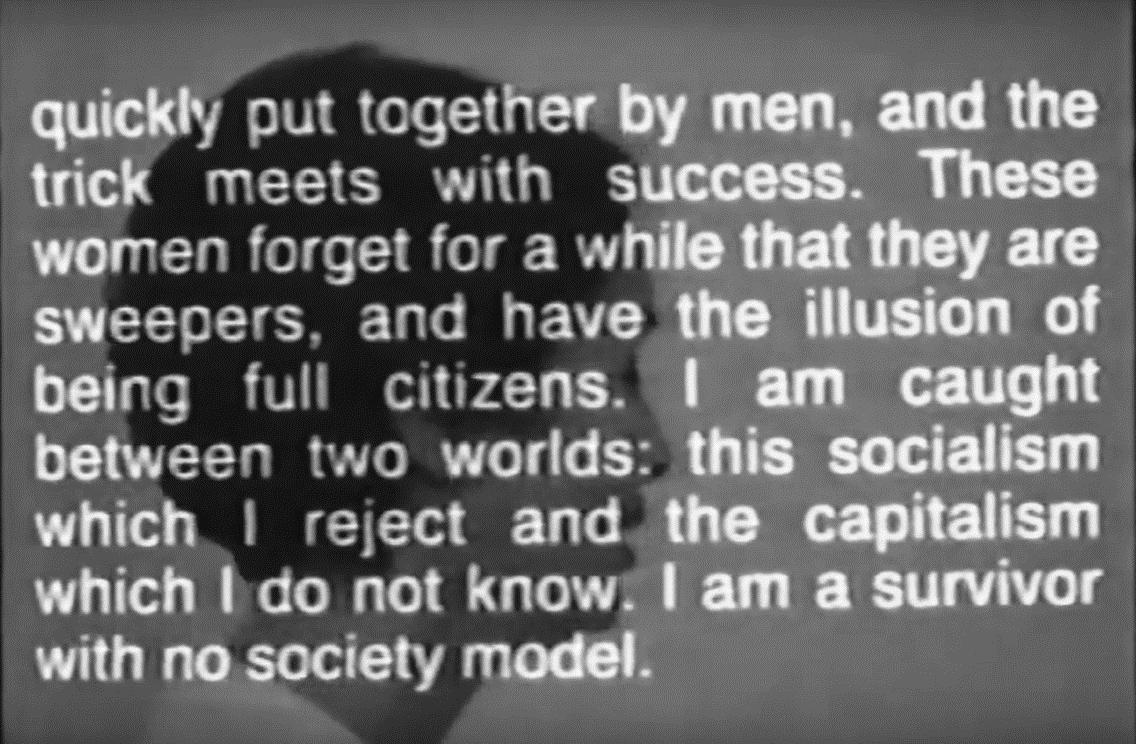
Trinh T. Minh-ha is considered an accented exilic filmmaker by Naficy (2001), i.e. someone who has left her country and maintains an ambivalent relationship with previous and current places and cultures. She interweaves theory, poetry, sound, text, image, music, dancing, calligraphy, different languages and accents, interviews, performance, and archive footage for building non-linear, self-reflexive, and essayistic narrative structures that make explicit her in-betweenness as an insider and outsider researcher, artist, filmmaker, theorist, woman, and immigrant (Minh-ha, 1982, 1989 and 1991; Naficy, 2001). As an insider, she ‘acts like an outsider and also is an outsider who investigates the inside’ (Naficy, 2001, p. 72). As a writer, she recognizes that many writers who live in exile find their sense of ‘home’ in writing rather than in physical places like houses, for example. Despite its difficulties, she admits that exile ‘can be worked through as an experience of crossing boundaries and charting new ground in defiance of newly authorized or old canonical enclosures’, while writing as a home can be both ‘a place of confinement and an inexhaustible reservoir from which one can expand’ (Minh-ha, 1994, p. 16).
Literature and practice review | 97
Figure 22 Trinh T. Minh-ha, Surname Viet Given Name Nam, 1989, Film frame, 59:45.
2.3.3 Renée Green
Renée Green is a visual artist, filmmaker, educator and researcher working across a variety of materials and data. Her work is informed by postcolonial criticism, minimalism and conceptual art, and her practice is based on her relationship with history, travelling, language, social experiences and places. By connecting individual stories to collective memory, her work develops as an autobiographical research method through which she collects documents and builds archives. Together, these materials offer the elements of her multimedia installations, which become open-ended narratives with multiple entering and reading paths (Green, 2000 and 2010; Meyer, 2000).
Text plays a crucial role in her work and might appear as historical documents, literary and theoretical references, quotes, notebooks and diaries in multimedia installations, banners, paintings, photographs, sound pieces, and film. As Hertz observes, Green’s work (Figures 23 and 24) can be seen as a hypertext essay marked by her fascination with the written word, which tends to appear within physical supports, or ‘excerpted and reframed within the conventions of film as titles, headings, intertitles, and written quotes’ (Hertz, 2010, p. 85).
Literature and practice review | 98

Literature and practice review | 99
Figure 23 Renée Green, Endless Dreams and Water Between, 2009. Installation. Yerba Buena Center for the Arts. (Source: Green, 2010, p. 33)
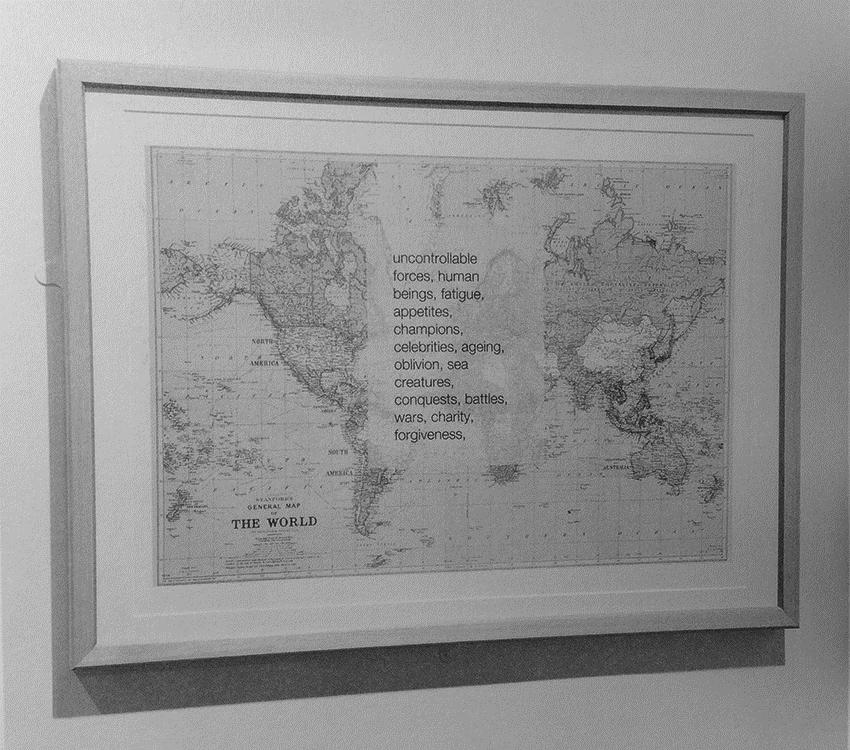
Green (2009) recognises that her method is a process of collecting and amassing data that produces liminal spaces between document and archive. The artist affirms that among having an interest and then browsing, researching, and editing, she wants ‘to relate instances that are waystations along the journey to creating something else, which is what both documents and archives can allow to those who are astute in extracting information and transmuting it into various forms of knowledge’ (Green, 2009, p. 1). This is an attempt to move away from the idea of archive as documents or fetish, and approximate to notions of archive as a place to be ‘deeply and repeatedly examined’ (Green, 2009, p. 1). While revisiting her collected materials, she notes how the words, places and names might ‘stimulate further digging and exploration’ and become ‘material for creation’ (Green, 2009, p. 2). Thus she is interested in building archives as ‘historical repositories, as well as tools for active engagement’ (Green, 2009, p. 2).
Literature and practice review | 100
Figure 24 Renée Green, Endless Dreams and Water Between, 2009. Drawing. (Source: Green, 2010, p. 38)
2.3.4 Luis Camnitzer
Luis Camnitzer left Germany with his family for Uruguay when he was one year old, and affirms, ‘I started to grow up as an exile’ (Camnitzer, 2009, p. 22). He was raised in a bilingual environment, speaking German at home and Spanish on the street and at school. His bilingualism became a cultural and generational process through which he and his other exile friends were stimulated to keep investigating German culture. Then, at the age of eighteen, he travelled to Germany but had a frustrating experience in not recognising himself in what he experienced there. He returned then to Uruguay with a certainty of his Uruguayan identity.
Becoming an artist in a country where few artists were able to live off their own work was, according to him, just another form of exile (Camnitzer, 2009) He would never become a doctor or a lawyer as his parents were hoping; instead he decided to take an art course at high school and afterwards to study architecture. When he became an architect, he felt like he was once more inhabited an in-between place, now professionally, since he was following two different careers. Later, he became a recognized artist and teacher, but with political tensions growing in Montevideo, he decided to leave for New York, a place that he was curious about. Taking distance from Uruguay made him put his country into perspective as he tried to identify colonial relations:
It seemed a clear place, easy to handle, confused only because of the inability to see itself from the outside. Especially the situation of art seemed very clear. Uruguayan art was structured according to international guidelines. International meant imperial (Camnitzer, 2009, p. 26).
He criticizes the fact that the majority of art production in Uruguay (as in Latin America in general) was focused on the international (western) market, and in his view many artists committed to the art establishment were not working hard enough to create a local lively culture. He exemplifies this problem by quoting Paulo Freire’s Pedagogy of the Oppressed, ‘the reading of the world
Literature and practice review | 101
precedes the reading of the word’ (Camnitzer, 2009, p. 80), and stresses the relevance of situated perspectives of the art production. For instance, he points out the Tupamaro guerrilla movement as ‘the only valid authentic artistic strategy for a cultural change’ which is fighting the ‘contemporary colonial art’ (Camnitzer, 2009, p. 27).
As an artist, Camnitzer believes in art as a tool for social change, ‘I wanted the artist to disappear, to have all the people make their own art, and to depose those who held the monopoly on art production’ (Camnitzer, 2009, p. 24). As a teacher, he affirms that his art had changed in a radical way because his work ‘had arrived at a pedagogical expression’ (Camnitzer, 2009, p. 28). His views on art and pedagogy connect to the work of Paulo Freire, Ivan Illich and Pablo Helguera, who also inform my practice and are latterly presented in section 3.2.
By living in the USA, he keeps asking himself about his own identity: ‘What is happening with my language?’ (Camnitzer, 2009, p. 28). He floats between cultures and displacements, ‘my country doesn’t exist anymore anywhere, except in my memory. I am a citizen of my memory, which doesn’t have laws, passports, or inhabitants. It only has distortions’ (Camnitzer, 2009, p. 28).
In his work Landscape as an Attitude (Figure 25), Camnitzer enacts a bucolic landscape as a self-portrait, a fragment of his lost country. Therefore, his work offers ways for enunciating places where he can inhabit He argues that leaving the place of origin is ‘abandoning a factory of memories and having to be content with only a few of its products’ (Camnitzer, 2009, p. 117). Then, through his work he can re-create a personal geography which does not refer to physical destinations because it is a ‘geography of exile, the one rendered by memory, is intimate’ (Camnitzer, 2009, p. 117).
Literature and practice review | 102

As a German-born Uruguayan intellectual, artist and teacher who left for the USA and incorporated the experience of exile in his work, Camnitzer lived in a permanent condition of translation, from English into Spanish and vice versa, from the New Yorker into the Uruguayan culture, from systems and power structures related to the arts into the political struggles against imperialism in Latin America, from canonical art history into resistance (Camnitzer, 2007) Therefore, it seems that he has embraced decolonial processes, working to identify points of origination, routes of dispersion, and raising his immigrant consciousness. In this process, writing became a tool for building new realities and his work was transformed into a place for exploring such translations.
Three elements are interconnected in Camintizer’s work: the pedagogical, the conceptual, and ‘art as a way of moving society forward in a process towards independence and justice’ (Camnitzer, 2009, p. xiv). Translation, in his life, refers not only to the experience of exile, but also to processes by which art and culture are created and validated worldwide. On the other hand, writing becomes a way for the artist to deal with his own sense of foreignness and the production of texts happens in both his theoretical and practical works (Figure 26), which simultaneously has often ‘resorted to the use of words’ (Camnitzer, 2009, p. xi).
Literature and practice review | 103
Figure 25 Luis Camnitzer, Landscape as an attitude, 1979 Photograph Collection of the artist (Source: http://theartstack.com).
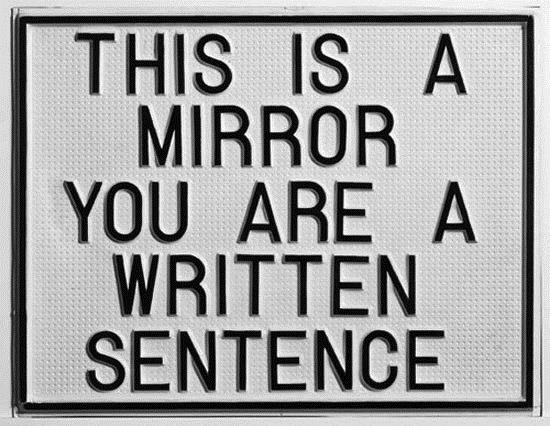
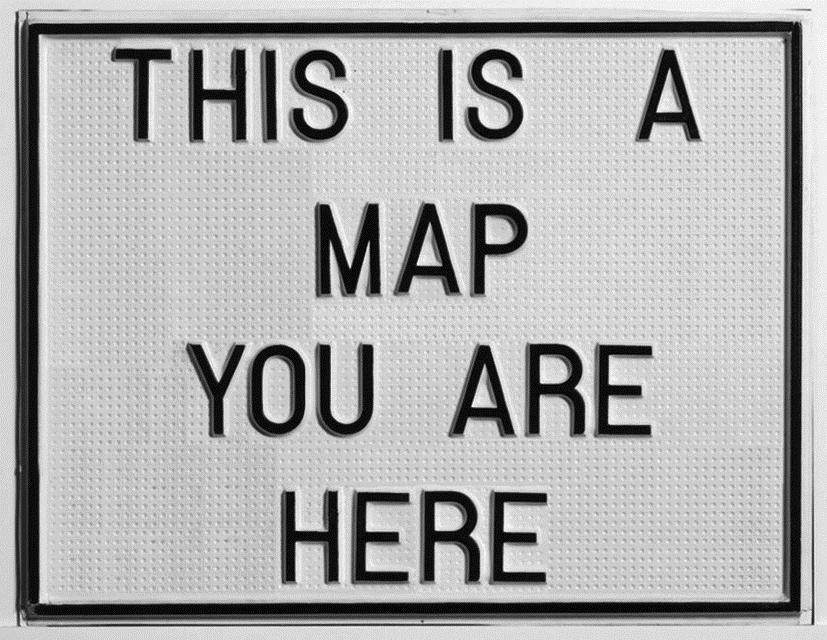
Literature and practice review | 104
Figure 26 Luis Camnitzer, This is a mirror (above), 1966-68; You are here (below), 1966. Vacuum-formed polystyrene mounted on synthetic board, 18 4/5 x 24 3/5 x ½ ". (Source: http://theartstack.com).
2.3.5 Anna Bella Geiger
Anna Bella Geiger is a Brazilian artist, the daughter of Polish parents who immigrated to Brazil during the Second World War. Geiger is influenced by conceptual art from the 1970s and by Fayga Ostrower’s20 thought, pedagogy, and politics. Geiger’s work departs from printmaking and goes to objectsculptures, drawing-paintings, performance, and photo/video installations. Informed by a politics of location grounded on Latin America issues, in the 1970s Geiger looked at the dematerialization of the artwork as resistance against its commoditization.
‘Passage’ is a condition for her entire work and ‘territory’ works as her core concept. She is interested in what it means to be a being that passes, who is in exile, a nomad who returns, a ‘self’ in continuous movement. Territory, on the other hand, is about challenging notions of identity as territory, and in her work it also means to consider the territory of identity (Geiger and Navas, 2007).
During the 1980s and 1990s, Anna Bella Geiger became influenced by decolonization and postcolonial discourses. The notion of place in her work goes from the functional to the in/formation space and to the space for exchange, in which ‘local’ and ‘global’ are in constant debate (Geiger and Navas, 2007, p. 19). Elements from linguistics and human geography influence her work and are a reflection of her thought about the necessity to embrace unknown notions from outside the art field in order to deal with the reality of the dictatorial regime in Brazil (Geiger and Naves, 2007).
In her maps, the artist problematizes the relationship between place and identity. The structures and identities of the places she creates are experiences of deterritorialisation through which she critically refers to the geopolitical issues involving Latin America in general, and Brazil (Amaral, 2006b). For Geiger, the map is a place for action, and this action often defines
20 Artist and educator born in Poland and immigrated to Brazil.
Literature and practice review | 105
a map itself (Figure 27). Through this critical field of artistic and geopolitical operations, Geiger builds cartographies to dismantle worlds and, at the same time, to enunciate new ones (Geiger and Navas, 2007).
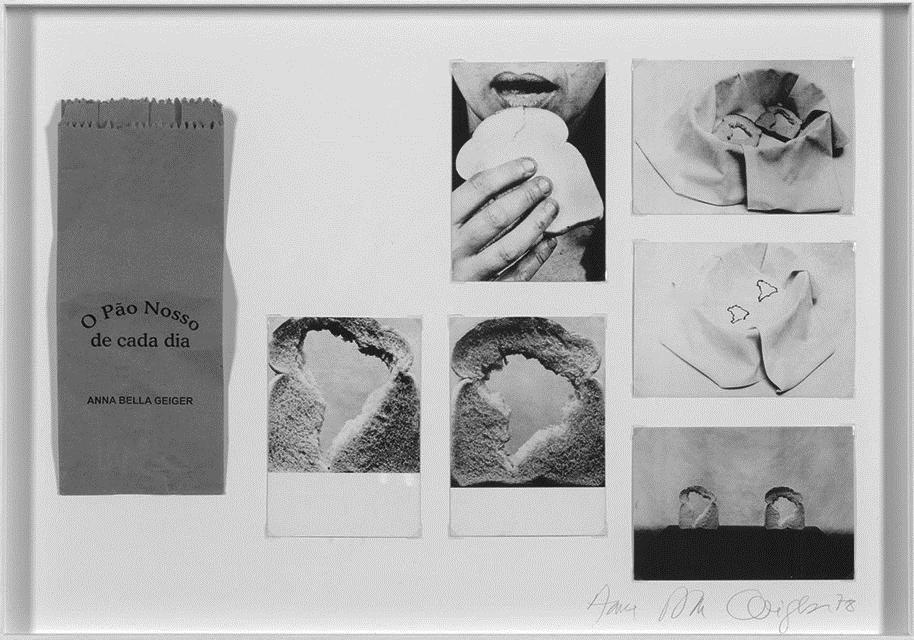
Geography is an artistic metaphor for making the work that leads to a metalinguistic approach to the place of art. While Geiger reflects on the places she can invent for her art to come into existence, and how such places are informed by her own culture and senses of direction and time in space, she investigates how people exist in space and interiorise the exterior for organising space as an allegory of memory (Geiger and Navas, 2007).
Geiger’s maps express the artist’s concern with location of both herself and the place of the art in the world. Informed by the relationship between centre and periphery, Geiger uses her practice to think about the place of the artist in a capitalist society, within and in tension with the circuit of art, and reflecting on power relations impacting cultural, artistic, political, economic networks that connect Brazil, Latin America, global South, and western countries (Figure 28) (Cocchiaralle, 1980; Geiger and Cocchiaralle, 1978).
Literature and practice review | 106
Figure 27 Anna Bella Geiger, O Pão Nosso de cada dia (Our Daily Bread), 1978. Six postcards and screenprint on paper bag mounted on card, 50 x 70,9 cm, Tate Collection, London. (Source: http://www.tate.org.uk).

Literature and practice review | 107
Figure 28 Anna Bella Geiger, História do Brasil: Little Boys & Girls (Brazil History: Little Boys & Girls), 1975-1976. Photography and collage, 30,5 x 24 cm, Collection of the Artist. (Source: http://www.artsy.net).
2.3.6 Paulo Bruscky
Paulo Bruscky was born of a Belarusian photographer father and a Brazilian politician mother in the northeast of Brazil. He initiated his artistic career during the critical period of dictatorial regime in Brazil, and since the late 1960s has developed a variety of art projects by means of performance, artist’s books, rubber stamp, visual poetry, mail art, photography, film, video, and xerox-art, among others (Freire, 2006).
Bruscky is also known as an artist-archivist, since his studio is considered an ‘apartment-archive’ (Figure 29), comprising artworks, documents, letters, books, photographs and publications. However, Freire (2006) explains that sometimes Bruscky’s notion of archive merges with the idea of artwork into a series of overlaps between art, practice and archive. Bruscky’s archive is something alive that rebuilds itself every day; it is always in flux, mixing history, communication and memory (Freire, 2006).
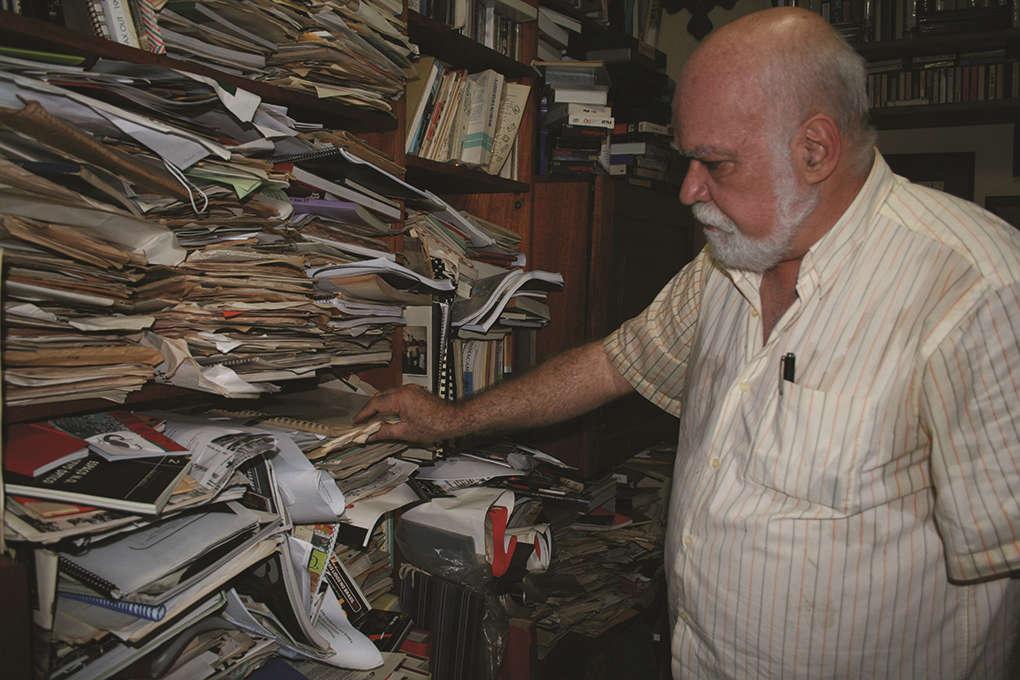
During the military regime, he started to build an international communication network through mail art, including with members of the
Literature and practice review | 108
Figure 29 Paulo Bruscky’s studio, 2008. Photograph by Manoela Afonso.
group Fluxus. Many of his projects developed as actions, temporary installations, and performances, so that ‘loss’ became a latent element of his work that functions against the commoditization of his art (Freire, 2006, p. 23). According to Freire (2006), Bruscky has denied attributing monetary exchange value to his work and seeks to detour from hegemonic economic value by using humour and irreverence as guides for his politics, poetics and imagination
Words appear in his experimental work in many forms: letters, postcards, books, objects, actions, or the urban space itself (Figure 30) can work as platform for his visual writings and textual interventions (Amaral, 2006b) Bruscky’s plural and multiform work,
[..] represents one of the biggest expansions of extended writing in contemporary Brazilian art, partly due to the artist’s condition of poietes – as original creator of images – in part by the continued co-existence with textual elements (Bruscky and Navas, 2012, p. 17).
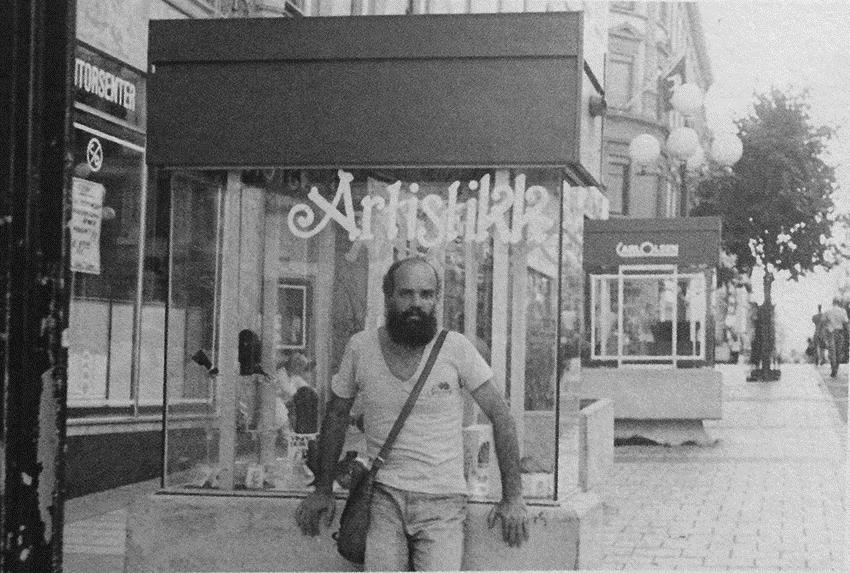
Literature and practice review | 109
Figure 30 Paulo Bruscky, Artistikk, Amsterdam, 1982. Urban intervention. (Source: Bruscky and Navas, 2012, p. 149).
As a visual poet, Bruscky’s practices are mostly based on playing with writing and signs. His practice was greatly influenced by Vicente do Rego Monteiro, a Brazilian artist who created postcards when he lived in Paris in 1952 and called them postal-poems (Freire, 2006). Since the 1960s, Bruscky has developed visual poetry, poem/process and postal-poems by using a set of procedures involving rubber stamps, photography, collage, assemblage, and platforms such as correspondence, mail art, and artist’s books. Writing is spread throughout Bruscky’s practice and it inhabits not only final artworks but also engenders art processes. By dislocating and subverting meanings, the artist opens alternative routes up to make meaning and to circulate his work. For instance, the picture shown in Figure 31 was taken in France, while ‘mije’ in Portuguese means ‘to pee’ in its imperative form. According to Freire (2006), some of Bruscky’s actions are action-games, in which he dis/articulates meanings through gestures. Freire suggests that these are ‘verbal site-specific’ artworks, in which a gesture can suspend the semantic meaning and extend its reading possibilities (Freire, 2006, p. 66).
Literature and practice review | 110

Literature and practice review | 111
Figure 31 Paulo Bruscky, Mije, 1982 (Source: Bruscky and Navas, 2012, p. 54).
3 – Art practice
This chapter presents the set of artworks created individually (section 3.1) and collectively (section 3.2) as part of this interdisciplinary practice-based PhD research in visual arts21. Before doing so, I would like to highlight some important aspects below:
This research is grounded in art practice and benefits from interdisciplinary crossings between humanist geography, feminist geography, life writing, and decoloniality, through which I designed the network of concepts that form the epistemological approach to practice and research.
The first stage of practice (section 3.1) works as a self-reflective response to life experiences lived within both geographical displacement and dislocation in language; The second stage of practice (section 3.2) works as a collective writing practice conducted with twelve Brazilian women who live in London and activated by semi-structured interviews, diary, and creative methods originated from the first stage of this research.
The place where I position myself to write this thesis is located before the artworks, within art practice, in-between languages, and towards the decolonial self.
I agree with Dillemuth when he argues that ‘the methods to be employed should originate from the researcher’s field of expertise’ and, following this thought, ‘an artist would use artistic methods before any other’ (Dillemuth, 2011, p. 237). In consonance with this idea and regarding practice-based research in visual arts, Sullivan adds that ‘if an aesthetically grounded and theoretically robust approach is to emerge, then the methods of inquiry
21 As mentioned earlier in the list of figures, all images presented in this thesis are by the author unless otherwise stated.
Art practice | 112
should be located within the domain of visual arts practice’ (Sullivan, 2010, p. 95).
Artists as researchers tend to work across several domains of the arts and beyond, combining fields and making the inquiry process inventive, disciplinary boundaries uncertain, and informing open-ended parameters (Sullivan, 2010). Sullivan (2010) also suggests that a visual arts research might share commonalities with research carried out in the humanities, social sciences and physical sciences. Hence, art making might become surrounded by a series of disciplinary perspectives that reflect ways of engaging with theoretical bodies and of appropriating methods to meet research interests and needs (Sullivan, 2010). In Sullivan’s model, visual arts research is considered as a transformative research practice through which knowledge is created and ‘constantly undergoes change as new experiences “talk back” through the process and progress of making art in research settings’ (Sullivan, 2010, p. 110). Self-reflective practice is one of the compounds of art research used by the artist to employ an inquiry process ‘that is directed by personal interest and creative insight’ (Sullivan, 2010, p. 110). Moreover, it is informed by discipline knowledge, research expertise, existing data, texts, and contexts (Sullivan, 2010).
Currently, many artists are not restricted to their own practices as spaces for producing singular objects and signature styles (Sullivan, 2010). Instead, they have been using their skills in ‘methods and media to address broader questions of human and cultural concern’ (Sullivan, 2010, p. 97). My art practice has changed considerably since I started the academic journey as a master’s student. Developing an art project in the context of research (Afonso, 2009) made me find new ways of understanding art as a wider practice. My cafofo (Figure 8) became a place for exploring dialogues between practice and theory, in which artworks could be influenced by concepts and concepts could be reconfigured by a system of thought built through practice. This experience changed my position as an artist and made
Art practice | 113
me realize that my art practice could become a place for exploring ways of knowing the self, the world, the self in the world, and the world in the self.
In the video of her lecture at the Museum of Modern Art in Warsaw, Irit Rogoff affirms that she is interested in ‘remapping the art world’ and in seeing its ‘potential as a site of knowledge production, a place from which to enter the public debate, a space of transformation, of gathering, of conversation, of mutuality’ (Rogoff, 2012a, 2:22). Rogoff affirms that she is not interested in looking at the art world ‘as a conglomeration of objects and spaces of display, of collections’, but as ‘a point of departure for entering things in a different way’ (Rogoff, 2012a, 2:45).
My understanding of art practice is in consonance with her views, and I see practice as an open space for exploring displacement and responding to experiences of dislocation. As Rogoff suggests, the concept of research can be empowering and work as strategy to divert from established notions of art. Thus, if seen as something open, critical and liberating, research can become a way to creating worlds, i.e. ‘start an art world from research rather than from making objects and having spaces to display them’ (Rogoff, 2012b, 21:14). My practice and understanding of the visual arts unfold in this direction.
Art practice | 114
3.1 Writing within muteness
Writing became a cross-element in this practice-based research, so that my art practice started to work as space for exploring writing processes for escaping the place of muteness in which I found myself on arrival in London.
To this end, I looked at three life writing genres as conceptual and practical guides for structuring this practice, namely: diary, language memoir, and correspondence. By using photography, rubber-stamping, artist’s books, and postcards, I created strategies for combining texts and images and bringing life narratives into consciousness and visibility. While Anna Bella Geiger, Paulo Bruscky and Luis Camnitzer inform the geopolitics and conceptual aspects of my work, Renée Green influences my ‘collecting’ and ‘annotating’ practices, and Trinh T. Minh-ha’s concerns around language and displacement are a reference to the bilingual explorations I employed in my work (section 2.3).
The autobiographical aspect of this whole process is informed by a politics of location grounded in feminist geography and decoloniality, which serves as a basis to articulate life stories into/as artworks within the space of my practice. Considering that the ‘narrative’s Latin etymology lies in knowing, not telling’ (Andrews et al., 2013, p. 13), I am interested in writing life narratives through art practice as a way of raising an immigrant consciousness and identifying autobiographical ‘points of origination’ and ‘routes of dispersion’ (Mignolo, 2013) that can indicate paths for delinking from the colonial matrix of power. I follow Doreen Massey’s notion of place as a singular collection of stories that results from specific interrelations built with/in space. I also follow Tamboukou’s (2011a) views on writing as a way to trace ‘lines of flight’ and, thus, embrace processes of becoming through leaving the self behind. However, I propose to think in terms of ‘routes of dispersion’ in order to embrace processes of becoming decolonial through leaving the colonial self behind, i.e. delinking (Mignolo, 2007a, 2011b, 2013 and 2014) Besides, I agree with Tamboukou’s notion of narrative as process and moments/events leading to understandings of actions ‘wherein new beginnings erupt, new
Art practice | 115
subjectivities emerge albeit as narrative personae and freedom can once more be remembered and re-imagined’ (Tamboukou, 2013a, p. 5).
The practices that follow in this section result from personal movements taken in a new space as response to a dislocation in language that generated a place of muteness. Such movements originated collections of stories that were embedded into art forms. Together, these artworks comprise a wider, unfinished, fragmentary and dynamic narrative that points out traces of the movements taken towards the decolonial self
3.1.1 Workplace
Virginia Woolf wrote in her diary, ‘a change of house makes me oscillate for days’ (Woolf, 2012, p. 64). The context of this entry is a change from London, and her oscillation refers to a feeling of depression. Woolf’s sensibility is viewed by Tuan as ‘a tremulous world that is about to dissolve with every shift of light’ (Tuan, 1990, p. 50). Woolf’s oscillations make me think about how destabilizing a change of country can also be. I arrived in London on 20 May 2012 and from this point onwards I kept fluctuating – in language, confidence, location, and identity. The first measure I took in order to hold myself somewhere, even temporarily, was to define a physical space where I could work. The second measure was to start a diary (see section 3.1.5), which would also become a place to work.
Between June 2012 and October 2013, I occupied the shed (Figure 32) in the backyard of the house where I came to live with my partner. The shed became not only a research studio but also a symbolic starting point for a new phase of my work. I called it Marco Zero and, based on Yi-Fu Tuan’s notion of network of places (section 2.1.1.3), I started to observe which places I would create within my new ‘cyclical time’ (Tuan, 1977).
Art practice | 116
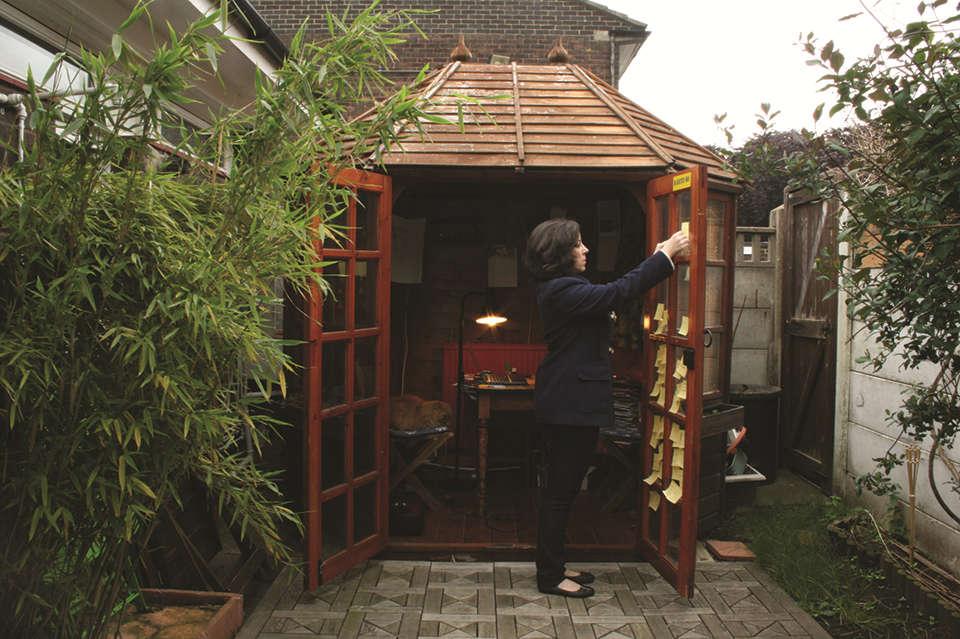
Having decided that the shed should become a research studio, I prepared its inauguration. I carved its image on a little linoleum plate, printed it on the first page of a notebook (which would become a diary afterwards), annotated my new geographic coordinates beneath this image, and wrote in Portuguese, ‘This is a reference for building my trajectory in this city. Every home is a milestone.’ As part of this inaugural set, I added a foundation stone which I picked up at Chelsea College of Arts on the day of my admittance as a PhD candidate (Figure 33). This set of decisions, practices, and objects marks a point of departure positioned in the middle of a new life in a new place and new language.
Art practice | 117
Figure 32 Marco Zero: a starting point located in the middle of experience, self-portrait, 2012-2013.
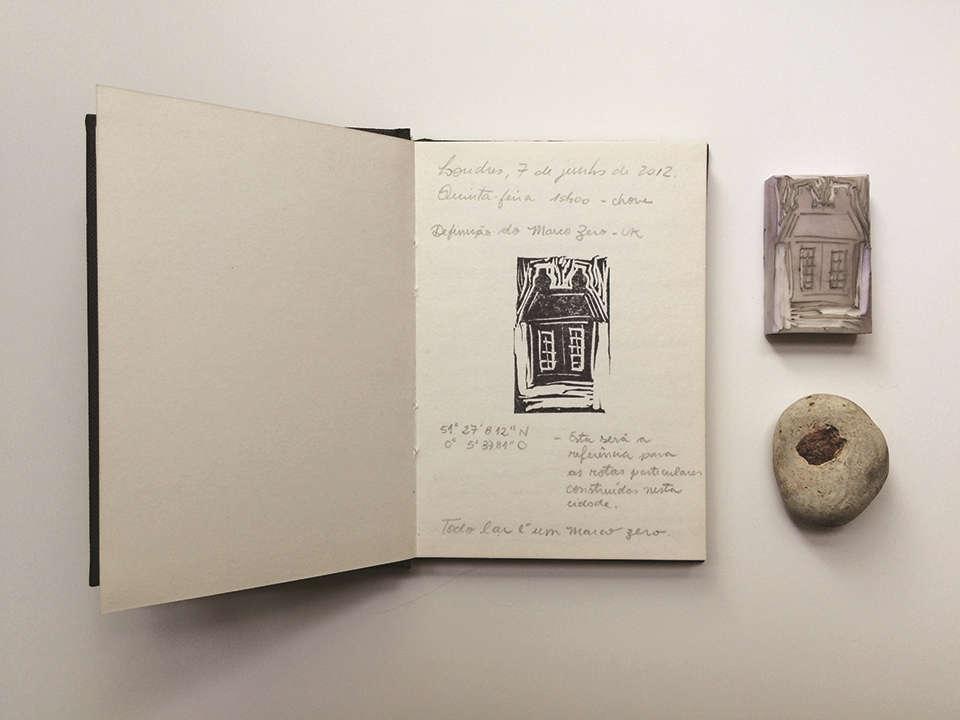
Art practice | 118
Figure 33 The foundational set, 2012. Diary, linoleum plate, and foundation stone.
3.1.2 Writing-making
My practice converged into writing and the shed functioned as an ambiguous space, sometimes as a workplace, sometimes as an ongoing artwork. This inbetween condition resonated in my work and the first artist’s books I created in London resulted from the inhabiting processes I cultivated in this shed (Figures 34, 35 and 36).
Art practice | 119
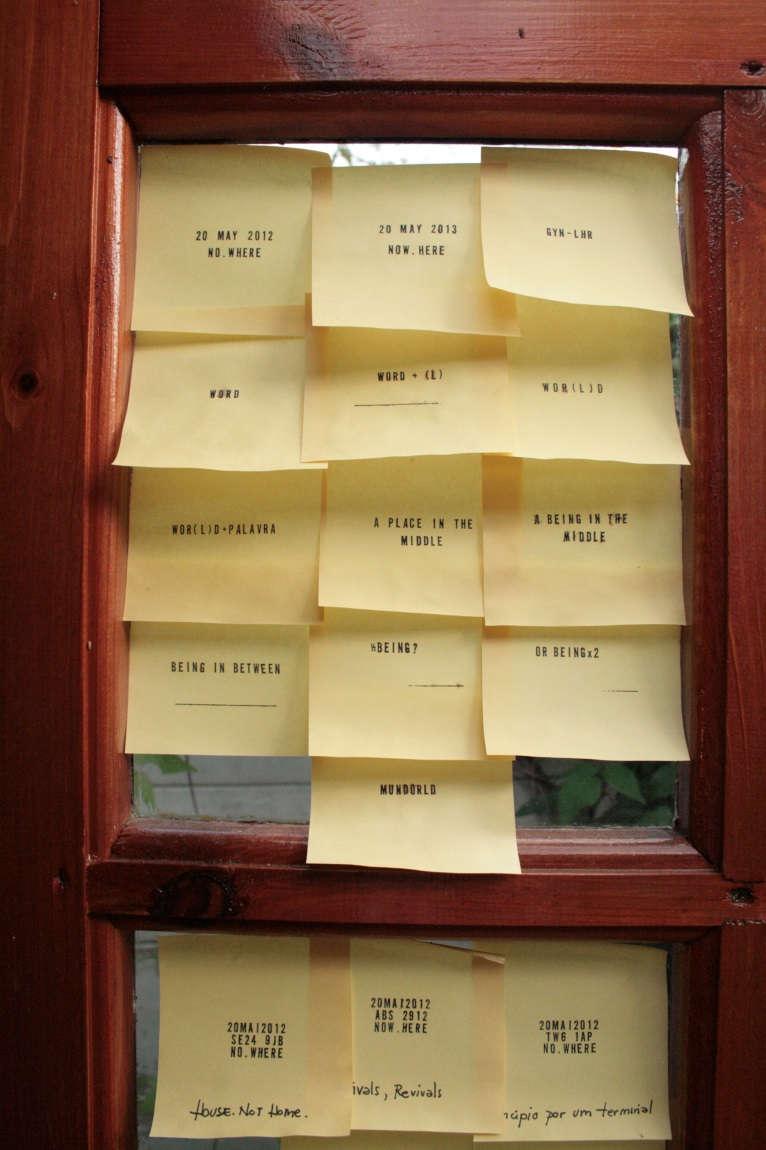
Art practice | 120
Figure 34 Initial notes affixed on the Marco Zero walls, 2012-2013
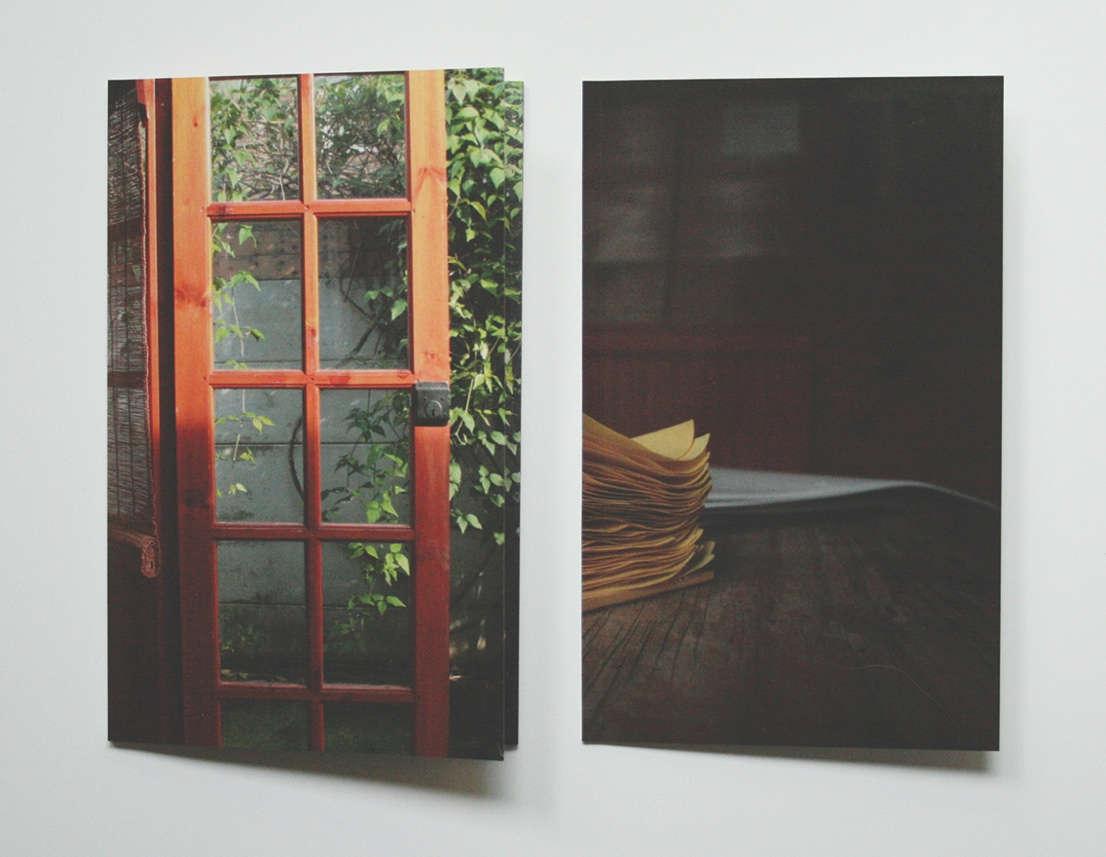
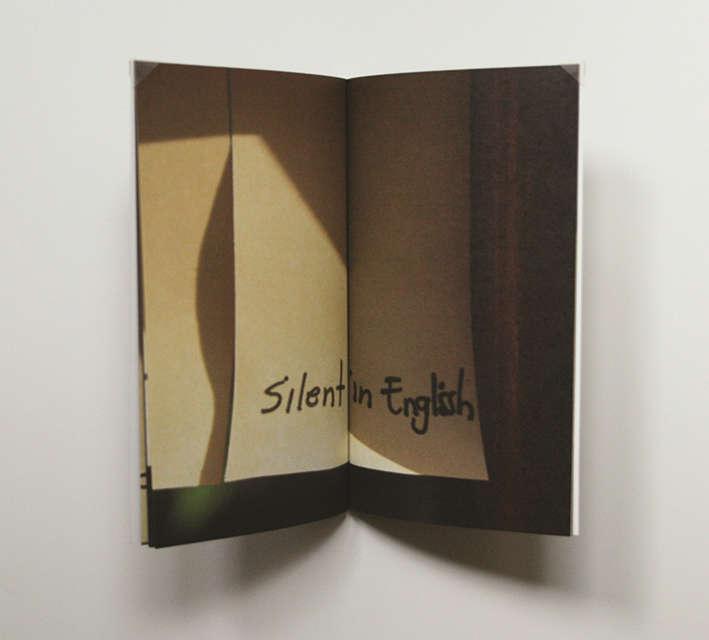
Art practice | 121
Figure 35 Artist’s books, 2013, 20,3 x 12,6 cm each, single edition
Figure 36 Artist’s book, 2013, 20,3 x 12,6 cm, single edition
I moved from my previous space of work, cafofo (section 1.2.4), to the new one, shed. I continued to refer to this space as shed because I am not comfortable with some traditional, canonical, and fetishized connotations attached to the term ‘art studio’, i.e. the place where (often) male ‘genius’ artists lock themselves to create works of art. As latterly explained in section 3.2.2, I prefer to associate my workplace with bell hooks’s (1990) notion of homeplace, which refers to a domestic place that is also a place for resisting, educating, transforming and healing the colonial wound.
My artist’s books were produced using ‘printing on demand’ services available online. It was the easiest way I found to work with a certain autonomy and freedom without depending on institutional spaces, which impose a set of bureaucracies, fees, permissions, schedules, and negotiating processes in English. In my work, self-publishing became a strategy for working independently, articulating new voices and creating forms to speak out within my place of muteness.
Ceschel affirms that ‘grassroots collectives and individual enterprises have been powered by technological possibilities that offer cheap and approachable means of making art and books’ (Ceschel, 2015, p. 5). Using digital printing means that the book can be in flux, since digital printing allows us to print small quantities or even only one book at a time. Additionally, throughout the designing and printing processes, the publication can keep changing (by adding or excluding photos, texts, pages, for instance), and it might be said that such a publication can become ‘a malleable object’ (Ceshel, 2015, p. 486), i.e. always in process as a piece within an open narrative.
Do it yourself (DIY) culture cultivates an ‘ethic in opposition to society’s rules at large’ and ‘is rooted in self-affirmation against a conformist and normative system’ (Ceshel, 2015, p. 5). Cheaper and more accessible forms of printing led artists to develop strategies ‘to produce and distribute print media and publishing outside the settings of larger publishing houses’ (Ceschel, 2015, p. 8). Through self-publishing I unveiled the main themes surrounding my
Art practice | 122
muteness, such as surveillance, language, otherness, life purposes, immigration, gender, coloniality of power. Besides, the close relation between the book and the world of narratives made me want to continue exploring books as platforms for making my writing. Photobooks, for example, can work as a specific event ‘in which a group of photographs is brought together between covers’ making images resonate among them as the pages are turned (Parr and Badger, 2004, p. 7). In this way, a meaning associated to a set of images might become more powerful than the individual meaning of each image. This is what happened to my photographs when I assembled them in artist’s books: the meaning of the whole set of images available in each book extrapolated the meaning of individual photographs. In fact, to put photos together worked as the core strategy with which I broke my muteness and wrote life narratives about displacement and dislocation in language in this research.
There is also a political aspect in self-publishing, since it offers an alternative way for artists to have a public practice while ‘navigating around a reliance on the gallery and museum system through innovative use of materials and alternative networks of distribution’ (Ceshel, 2015, p. 9). This aspect still connects to Lippard’s (1976) claim on the value of artists’ books as alternative spaces to show artworks. As Allen explains, Lippard was ‘optimistic about the potential of artists’ books to fulfil the unrealized goals of art of the late 1960s’, and argued that one of the most important aspects of this medium is to be able to ‘reach a broader audience than that focused on contemporary art’ (Allen, 2011, p. 135). Self-publishing continues to offer ways to resist passivity, weave trajectories, build alternative and wider audiences, and escape subservience imposed by the art establishment (Ceshel, 2015). Since the 1970s, when Lucy Lippard was a member of New York’s Printed Matter group, self-publishing started to be viewed by artists as an alternative space for showing works and circulating ideas. Currently, it might be said that selfpublishing projects from that time continue to influence these movements today, representing ‘innumerable little alternative spaces for the dispersal of
Art practice | 123
art, ideas, and images’ (Ceshel, 2015, p. 9). Thus, contemporary selfpublishing can be seen as ‘a self-run artist’s space’ itself (Ceschel, 2015, p. 10).
In this research, I have created autobiographical writing processes through a series of operations involving photography, rubber-stamping and drawing. As in a puzzle game, by assembling images into books I started to uncover aspects not only of my experience as a newcomer to London, but also the traces of coloniality on my ‘self’ (see Mignolo, 2007a and 2011b; Quijano, 2000) The set of artworks I created during my first year in this city worked as an antenna for the tacit knowledge I acquired during the period. Moreover, some of the narratives I wrote indicate my feelings in relation to a geopolitical space closure. Unfortunately, three years later from the moment I created the work pictured in Figure 37, the UK chose to leave the European Union22 under the huge influence of the ‘border control’ rhetoric.
22 On 23 June 2016 a referendum on the UK’s membership of the EU took place and the UK voted to leave the EU (https://www.eureferendum.gov.uk)
Art practice | 124
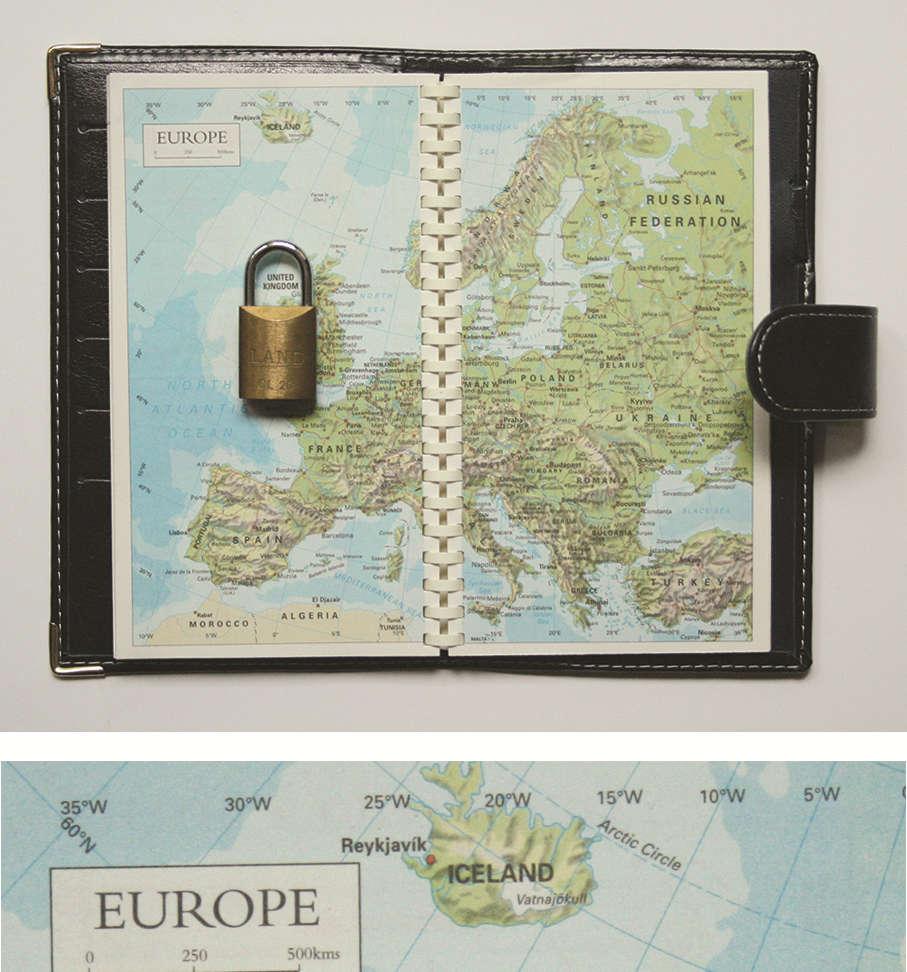
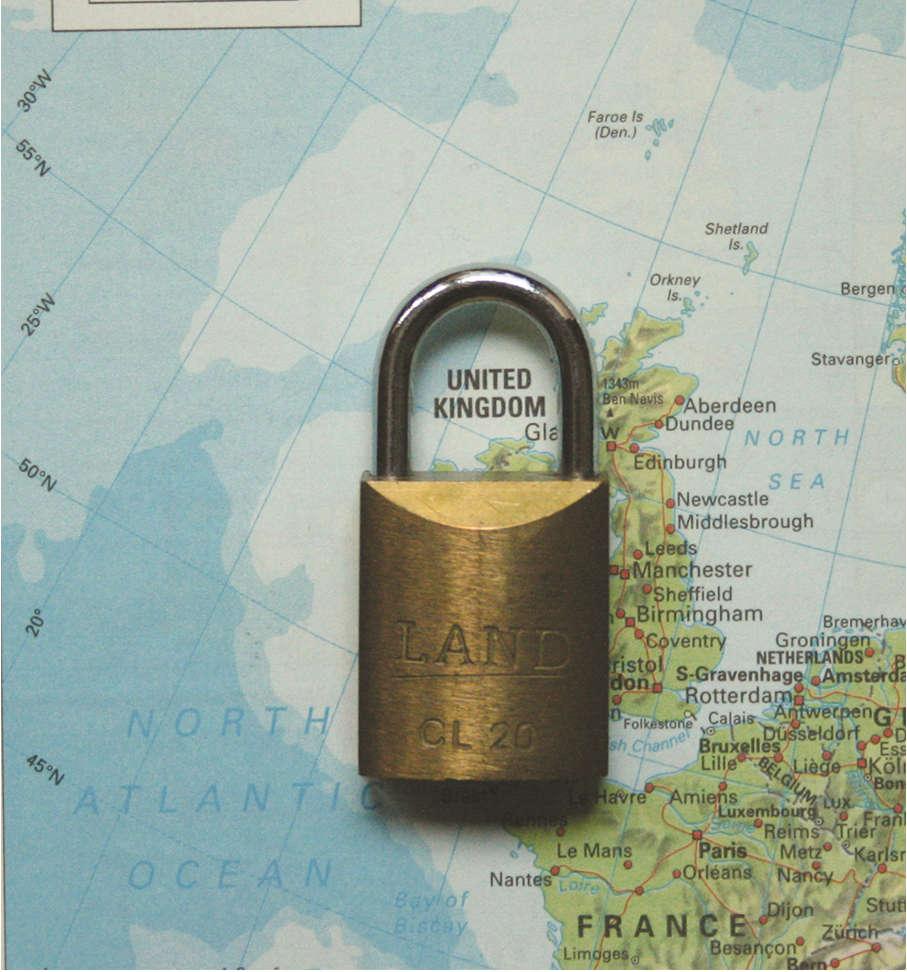
Art practice | 125
Figure 37 Land, 2013. Padlock on map, 17,5 x 21 cm
Reflecting upon what made me feel ‘out of place’ during my first months in London helped me to identify traces of coloniality on my ‘self’ and led me to think about what makes me feel no.where (Figure 38). During this period, I explored words in Portuguese and English in order to make sense of my new reality. For instance, figure 40 presents a play with the words ‘mundo’ and its translation into English, i.e. ‘world ’ I suspended the letters ‘n’ and ‘l’ by using parentheses in order to stress the presence of two other words within the already cited: ‘mudo’ (mute) and ‘word ’ The idea is that my mundo became mudo, and then I decided to find ways to say my word in the new world where I found myself. The word mudo has a double meaning in Portuguese; it can refer to the condition of muteness or to the verb ‘to change’ conjugated in the first person of singular of the present tense (I change), i.e. eu mudo. As time passed by, I started to connect to people, language and local dynamics, which sometimes changed my feeling of ‘no.where’ to ‘now.here’ (Figure 39).
From the start, I tried to reflect on the meanings of being ‘here.’ To this end, I often positioned myself in the middle of experiences of displacement and dislocation (Figure 41). Then, from the middle, I could start writing autobiographical artist’s books (Figure 42).
As mentioned earlier (section 2.1.2.2), Massey suggests that here ‘is where spatial narratives meet up or form configurations’ (Massey, 2005, p. 139). These configurations form places, and ‘to travel between places is to move between collections of trajectories and to reinsert yourself in the ones to which you relate’ (Massey, 2005, p. 130). In this way, I consider each artwork developed in this research as a place resulting from the meeting ups of spatial narratives that I catalysed not only in London, but in other parts of the UK and in other countries to which I eventually travelled.
Art practice | 126
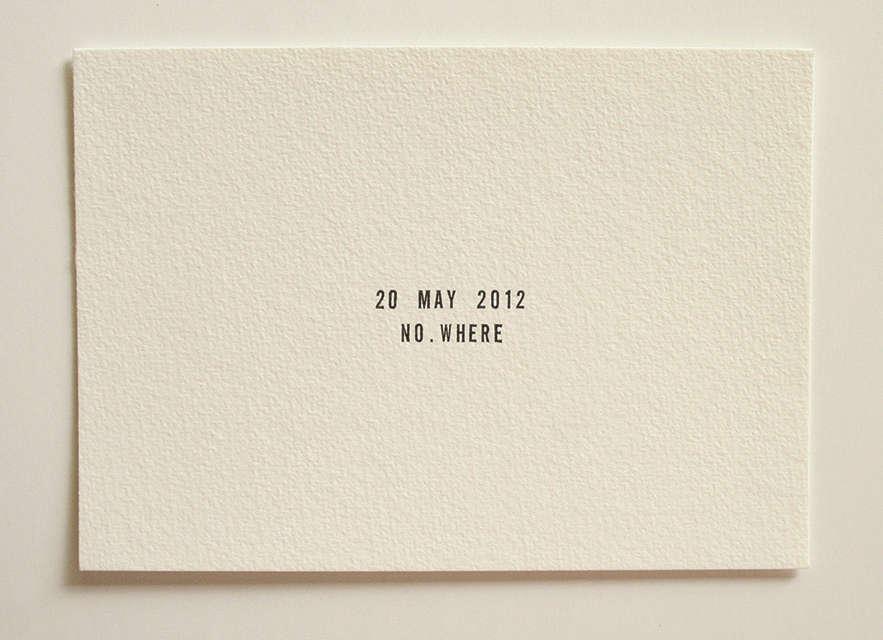

23 This piece is not related to the London artist-run organization No.w.here founded in 2004 by Karen Mirza and Brad Butler (http://www.no-w-here.org.uk). Long before I heard of this organization, I created these postcards by exploring meanings for the word ‘nowhere’ and this process was based exclusively on my learning language experiences and personal feelings and thoughts about displacement and coloniality. Even though I believe that it is evident that both works are completely different and disconnected from each other, I mention their work here only to avoid any misunderstanding.
Art practice | 127
Figure 38 No.Where,23 2013. Postcard, rubber stamp, 10,5 x 14,7 cm
Figure 39 Now.Here, 2013. Postcard, rubber-stamp, 10,5 x 14,7 cm
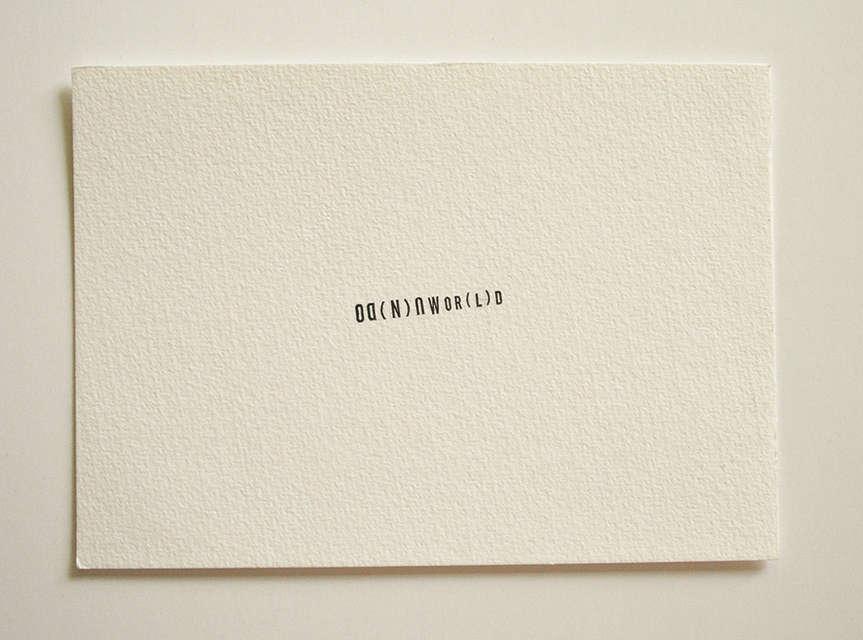
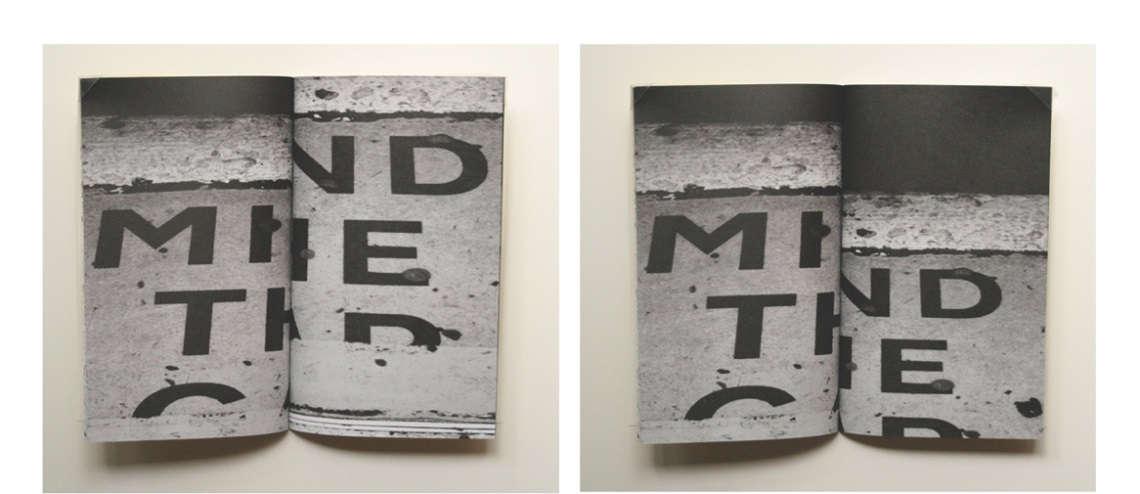
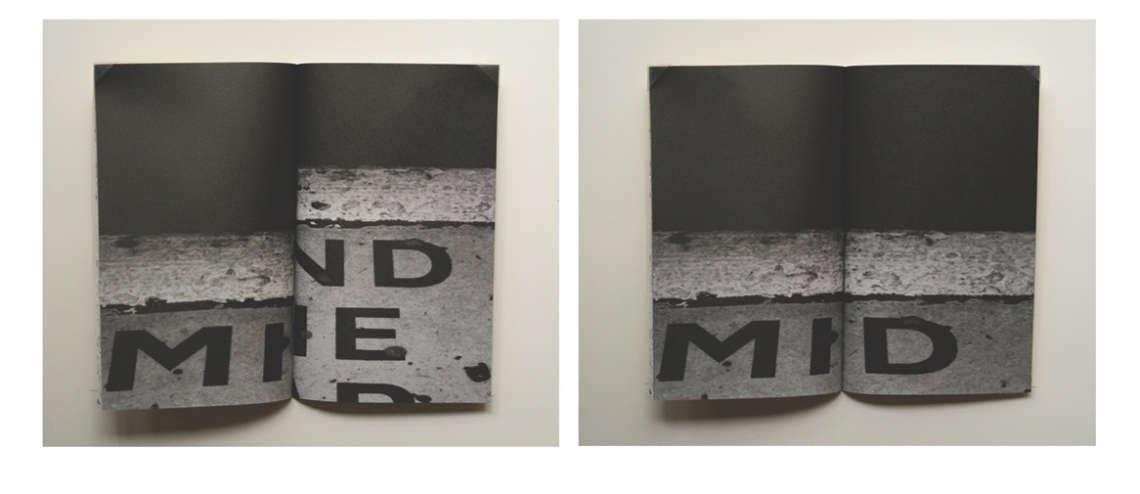
Art practice | 128
Figure 40 Accented poem, 2013. Postcard, rubber stamp, 10,5 x 14,7 cm
Figure 41 Mid, artist’s book, 2013-2014, 20,3 x 12,6 cm, single edition
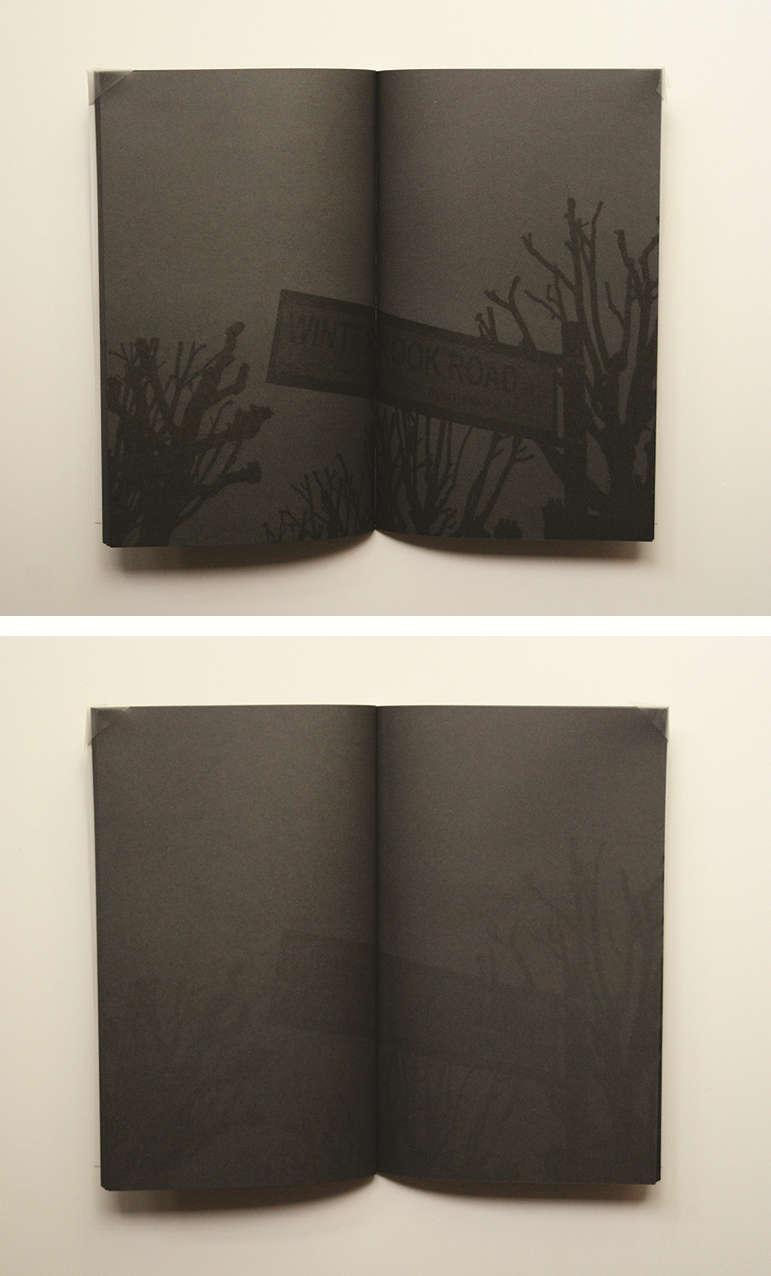
Art practice | 129
Figure 42 Winter, artist’s book, 2013-2014, 20,3 x 12,6 cm, single edition
3.1.3 DisPlacing notes
During my masters, in 2006, I started to take notes about the processes engendered by my art practice developed as research. Since then, I have used the same notebook to write down ideas about practice-based research, focusing on observing what an art practice as research does. I brought this notebook to London, and as I experienced a change in language I started to use masking tape to cover notes written previously in Portuguese and rephrase some of them in English (Figure 43) Later, I started to write down new ideas directly in English (Figures 44 and 45) Then, through writing, I created a disciplinary vocabulary connected to the interdisciplinary network of concepts woven during this practice-based research, and this notebook became one of the places where I often felt in-between Sometimes, when I tried to explain my work in Portuguese, I did not find the right words because I had already started to think directly in English and, suddenly, words in English automatically started to come up. It seems that as soon as I acquired more of the host language, I felt more and more ‘out of place’ in my own language. I noticed, then, that translation started to fail and leave many gaps. On the other hand, translanguaging (see Mignolo and Schiwy, 2007) became a more meaningful strategy in my new life as a bilingual subject
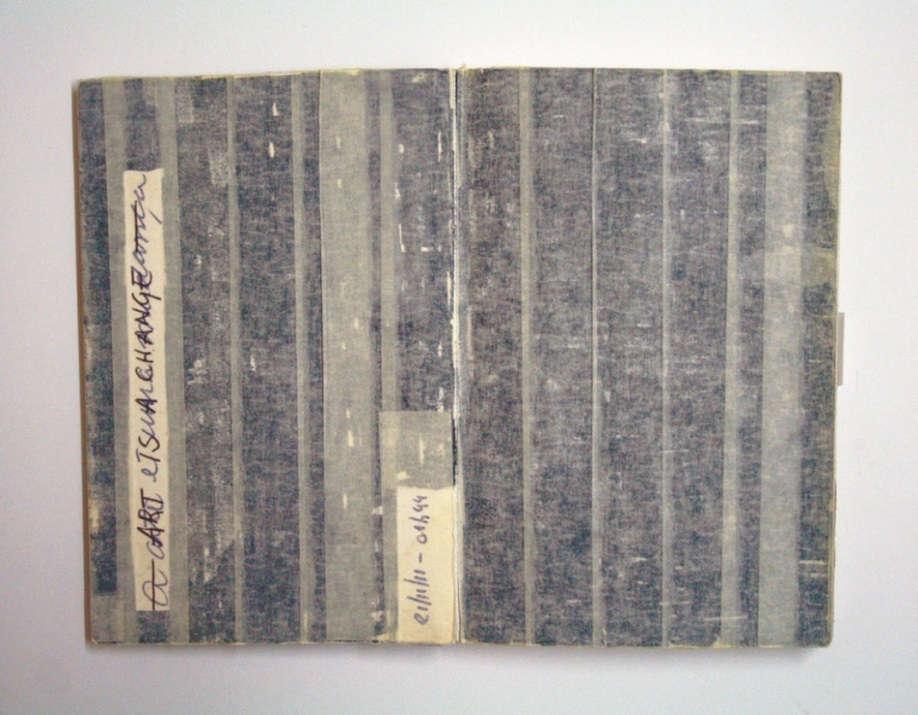
Art practice | 130
Figure 43 Art research notebook, 2006 – ongoing, 14,8 x 10,2 cm.
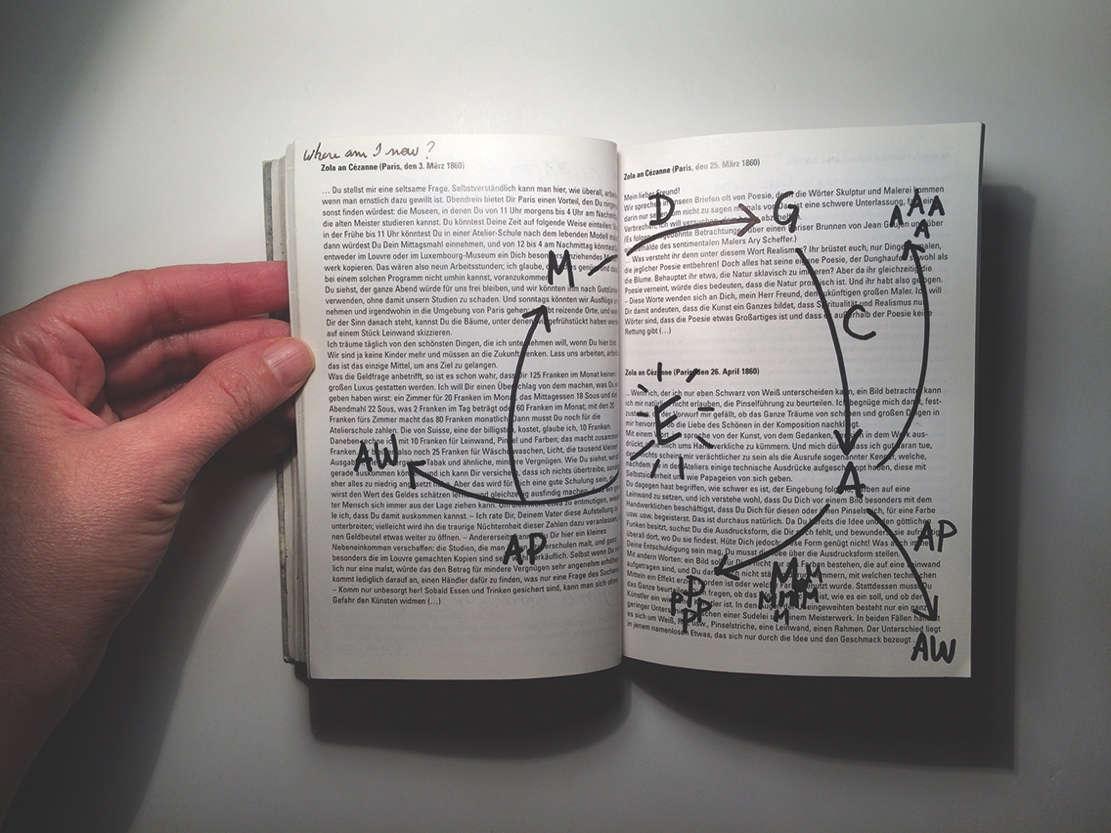
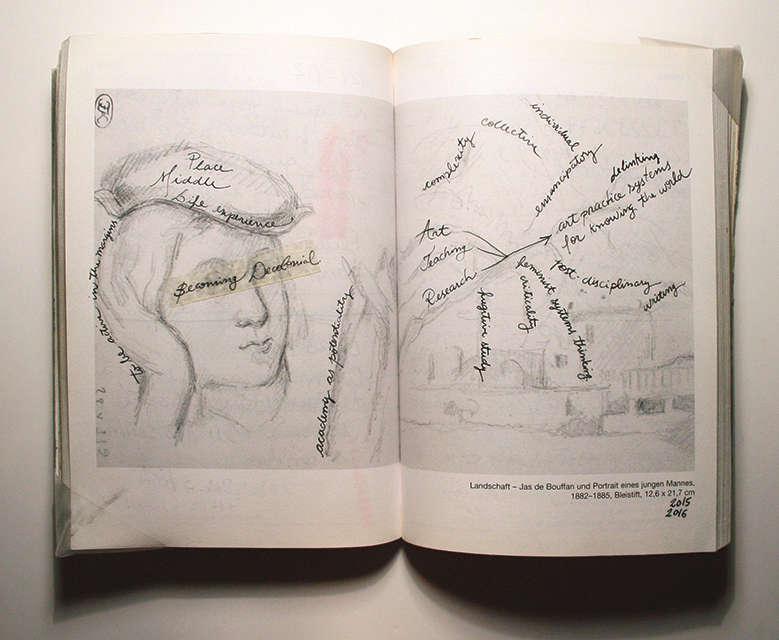
Art practice | 131
Figure 44 Art research notebook, 2006 – ongoing, 14,8 x 10,2 cm.
Figure 45 Art research notebook, 2006 – ongoing, 14,8 x 10,2 cm.
3.1.4 Postcard collection
In parallel to my writing processes, I started to collect postcards. As demonstrated in section 1.3, I have been interested in postcards for a long time. However, the reason that led me to gather postcards in street markets and stamp fairs in London became different: I started to seek narratives built in the North-South axis, i.e. postcards sent from Latin America to the UK and vice versa. This became an interesting way to confront coloniality. Images and texts in postcards can easily demonstrate how coloniality of power and coloniality of being can subtly emerge from a casual traveller’s foreign gaze For instance, a Brazilian woman who came to London from Curitiba (my home town) wrote back to her city to share that ‘finally’ she was in ‘the centre of the world’, enjoying ‘the vision of paradise!’ and the school she came to see ‘is humiliating’ (Figure 46). Another person wrote from Rio de Janeiro to Salisbury affirming that people in Rio ‘must be the friendliest I’ve ever met’ (Figure 47), and a third one who went to Peru sent a postcard picturing an Andean woman, ‘I have seen many Indian women like this’ (Figure 48).
As Tuan (1990) argues, many European cities have visual emblems of power. London, for example, ‘is easily recognised from a scene of Piccadilly Circus or a view of the Houses of Parliament by the Thames River’ (Tuan, 1990, p. 204). On the other hand, non-western places are commonly represented as exotic. Since ‘postcards tell us something about imageability’ (Tuan, 1990, p. 205) and might reflect the values of those in power, I started a postcard collection in 2013 and shall continue to build it as an archive that I can re/visit for mapping texts and images linked to coloniality. This exercise leads to consciousness and an understanding about the power relations surrounding the experience related to travelling.
Art practice | 132

Art practice | 133
Figure 46 Postcard sent from London to Curitiba, 1981, 10,5 x 15 cm
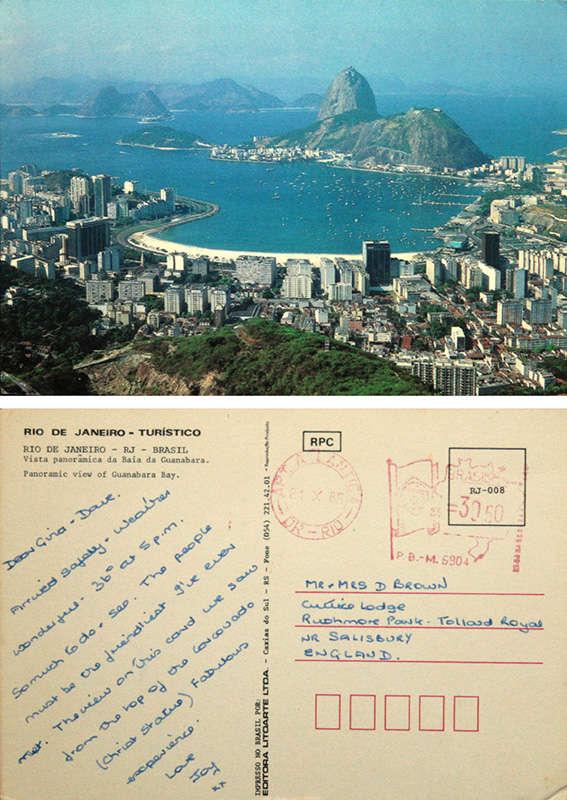
Art practice | 134
Figure 47 Postcard sent from Rio de Janeiro to Salisbury, 1985, 10,5 x 15 cm
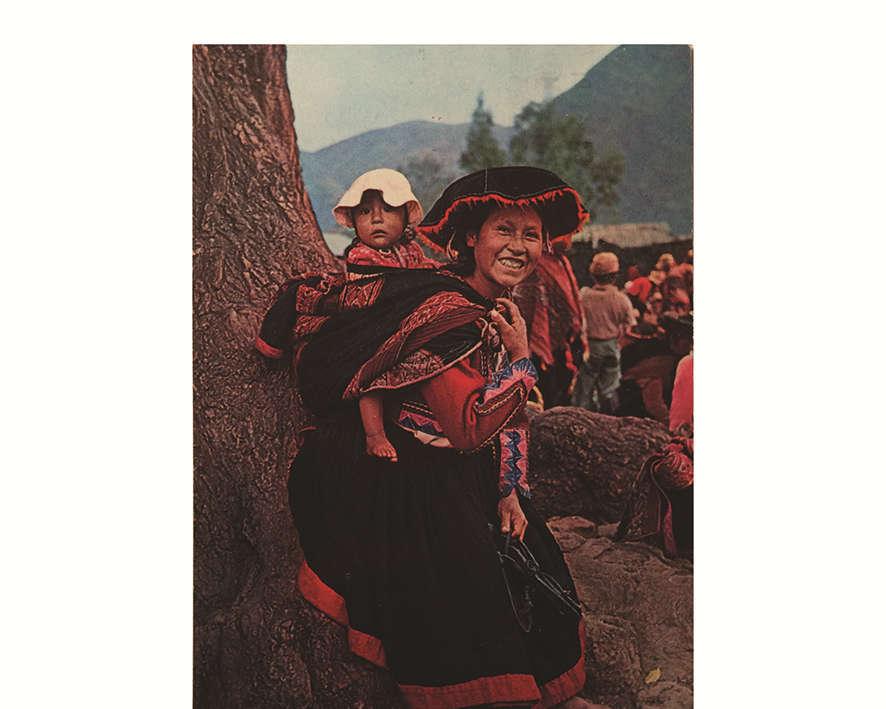
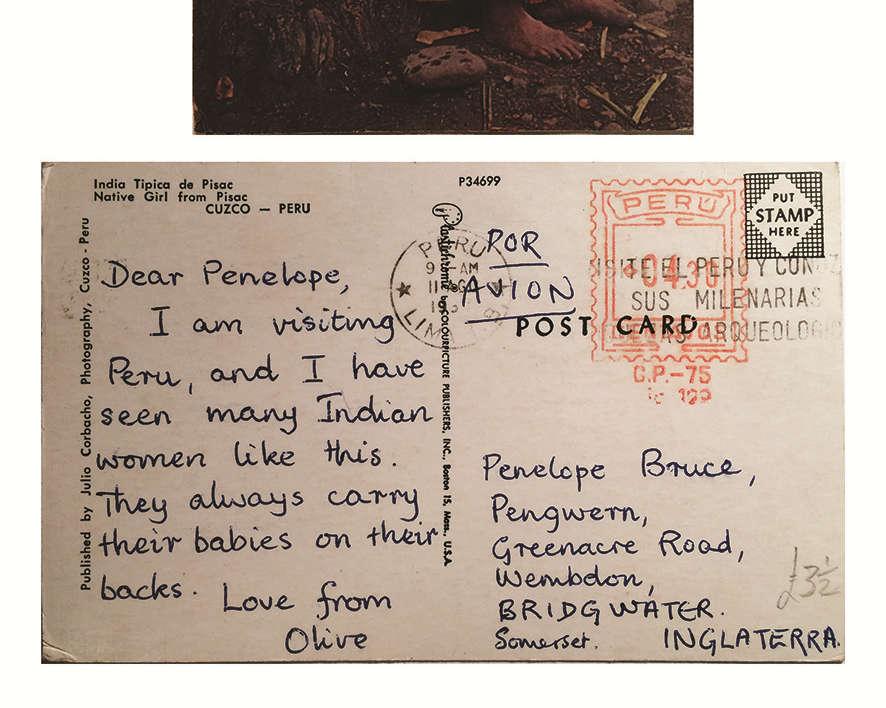
Art practice | 135
Figure 48 Postcard sent from Peru to Somerset, unknown date, 14 x 8,8 cm
3.1.5 Diary
I kept a handwritten diary from 7th June to 15th November 2012 (Figure 33)
As soon as I started to engage in academic activities, attend events, and meet new people in London, I had to adjust my rhythm to the speed imposed by this cosmopolitan city. I had to learn how to move faster, be more objective, respect others’ personal space (meaning avoiding body contact), and go straightforward to things in a ‘polite’ manner. This changed the way I wrote in my diary. In fact, I abandoned my handwriting because it was too slow, physical and contemplative. As it was conflicting with my new life, I continued to write my daily accounts in a word processor on my personal computer, not exactly happier than before
First, I thought that this decision would make me lose important aspects of my perception and, hence, of my way of observing and recording. Dealing with pencils, pens, and paper involves being in contact with the materiality of writing. It is of course a different experience to write using a keyboard, seeing the text appearing on the computer screen, and having internet available for any additional research. It is worth noting that as I lose the spontaneity of body contact – usually no hugs and kisses on people’s cheeks – I also gave up the materiality of diary. Losing body contact with people and the things of the world was one of the initial characteristics of the place of muteness in which I inhabited initially.
My first impression of life in London, in many sectors (including the university) is marked by stories and experiences about people who are always busy, rushing, lonely, having a fifteen-minute lunch, dealing with financial debt, living in crowded houses, competing against each other, trying to learn English, exhausted. I am not saying that life in the places where I have been before was tranquil. However, in London, it seems that these characteristics take on an exponential dimension.
Additionally, in tourist areas I observed crowds of people enjoying themselves, taking pictures of monuments, speaking in diverse languages,
Art practice | 136
walking and eating slowly, celebrating the symbols of the city (red buses, telephone boxes, London Eye, and so on), consuming branded food and culture. Even though neoliberalism seems to be present in these cases that I just mentioned, it was the City of London and Canary Wharf that brought me face to face with it as never before: neoliberalism is in the glassy buildings, clothing codes, sanitised and monitored streets, and cityscape with skyscrapers. When I met other immigrants who used to work as cleaners, chambermaids, or waitresses, I figured out that I should look at the city and ask what I was not seeing, since there are many other cities within the invisible layers of London, beyond its monuments, historical buildings, painting collections, ranked universities. My diary became a place for tracing such invisibilities, and some of them were related to my own identities and subjectivities being challenged by the experience of displacement and the dislocation in language in this city.
From November 2012 to February 2015 I then wrote in my digital diary in Portuguese. It comprises 108,126 words and was printed and bounded only for personal use (Figure 49). My initial objective was to use the diary as a safe and intimate place for writing in my language about the challenges faced in the host language. For instance, on 29th April 2014, I explained why I was writing in Portuguese: writing in my own language allowed me to create a place where I could follow the flux of my thought, since in English my thought was quite broken and laconic. I wanted to have a well-defined place for following the flows of my feelings and thoughts. As Tuan explains, what begins as an ‘undifferentiated space becomes place as we get to know it better and endow it with value’ (Tuan, 1977, p. 6). Thus, the diary initially worked as a place for understanding where I was, in which feeling and thought worked together from the superficial contact to the deeper relationship with space, organising meanings and making sense of realities. However, as I refined my relationship with the city and acquired elements to trace deeper critical views on my own experience, I saw the diary gradually become an intimate territory to explore border thinking and raise an
Art practice | 137
immigrant consciousness . On 1st January 2015, I wrote about a note I took in 2014 and asked, ‘Como politizar a esfera da intimidade?’, i.e. how to politicize the sphere of intimacy? And I answered, ‘escrever contra o esquecimento, esta é a política da escrita de si,’ i.e. writing against forgetfulness, this is the politics of self writing. I cannot say precisely what I was thinking at that moment, but I would connect this thought to the invisibility issue I mentioned earlier in this text. I believe that by asking what I am not seeing here leads to confront forgetfulness. Moreover, this can be connected to my efforts in reaching the untold stories on my mother’s side, as mentioned earlier in section 1.3.
In 2013, one year after the beginning of this diary, it seems that language became a more indirect issue in my entries, acting underneath. I wrote about London, national and regional identities, my place as a woman, artist, teacher, and researcher, and my impressions of the higher education system in the UK and the PhD doctoral experience. Life was carrying on and gradually language passed to inhabit a hidden level in my entries, working as an invisible thread with which ongoing stories about feeling ‘no.where’ or ‘now.here’ stitched together. I noted that it is easy to forget the impacts of language on one’s daily life and simply accept silence (a consequence of being in the place of muteness for so long), loneliness, and hesitation as natural attributes of one’s personality. However, it must be considered that sometimes some people might not be shy or antisocial; they might be experiencing the place of muteness created by the encounter of two languages.
Art practice | 138

On 12th May 2014 I wrote, ‘I will never be alone if I keep writing.’ Earlier, on 9th January 2014, I wrote that writing became an act of rexistência. This is a word play combining the words ‘existence’ and ‘resistance’ in Portuguese. In English, it would mean ‘rexistence.’ The diary offered a provisional anchorage within displacement where I could pause to reflect on movement and the power relations surrounding it Besides, on 19th January 2014 I registered that the diary was helping me to assemble fragments of a dismantled ‘self’ and shaping a new picture formed by a set of entries, like a mosaic. However,
Art practice | 139
Figure 49 Diary, November 2012 – February 2015, 29,5 x 21 cm.
what helped me to really understand what kind of picture this mosaic was trying to show me was the photo-diary I was building in parallel to my written accounts. When I put images and words together, I understood that the major issue behind everything I was registering was coloniality (Figure 50).

3.1.5.1 Photo-diary
I took daily photographs from 2013 to 2015 with the objective of framing a pause in space, which would work as a coordinate of a portion of the present to be analysed in the future. If ‘to collect photographs is to collect the world’ (Sontag, 1979, p. 3), I took photographs in order to form worlds through an archive of instants. However, when I started to take one photo a day, I did not know exactly what kind of world the set of images would create. I simply took photographs like someone who collects fragments in space stimulated by the desire to keep a moment to be revisited later. Susan Sontag affirms that photographs ‘help people to take possession of space in which they are insecure’ and this is the way photographers create image-worlds (Sontag, 1979, p. 9). According to her, photographs are a slice of space and time, not a
Art practice | 140
Figure 50 Diário2013, artist’s book published in 2016, 18 x 18 cm, single edition. Entries: 13th (left) and 14th (right) July 2013, Portugal.
flow. They are a trace and ‘each still photograph is a privileged moment, turned into a slim object that one can keep and look at again’ (Sontag, 1979, p. 18).
However, Doreen Massey (2005) argues that there is movement in apparent stillness (see section 2.1.2). If, over time, photographs might change their physical characteristics as well as meanings, they cannot be considered pure stillness. Framing a fragment of space through the camera is to produce a temporary and bound pause. However, when two photos are viewed together, this bond loosens. The frame of a photograph makes me think about the borders of a country: it seems so defined, fixed, immutable. But when two photographs are put together, they start to refer to externalities, i.e. they are seen ‘in relation’ to each other and to what exists beyond its own borders as a set of images. When two countries are viewed together it is similar, they are viewed in relation to each other, which makes the stories multiply. Then, to catch broader narratives, it is necessary to see the part in relation to the whole, and vice versa.
Sontag affirms that ‘travel becomes a strategy for accumulating photographs’ (1979, p. 9). However, I did the opposite movement. Rather than travelling to take pictures, I took pictures to create paths through which I could transit, move my ‘self’, becoming decolonial. My collection of photographs inaugurated an intimate topography formed by bound portions of experiences lived in space, which became unbound through assemblage These photographs, when put together, reveal places that are located beyond their own frames, and indicate an ‘elsewhere’ that is difficult to attain only through the written diary. ‘Between photographer and subject, there has to be distance,’ affirms Sontag (1979, p. 13). Perhaps it is in the distance that forms the in-between field that the place of enunciation can emerge. In the case of my photo-diary, the place of enunciation is located neither in the photograph nor in the photographed element. It emerges in-between, ‘in relation to’, i.e. when one photograph is seen in relation to another and, through this process, unveils elements that were until then hidden.
Art practice | 141
Between 2013 and 2015, I built a collection of more than one thousand images. This archive became a labyrinth for disclosing a myriad of personal stories. Initially, I collected and stored these photographs on my computer, but as the connections among images increased, I decided to publish them as photo-diaries separated by year, hoping to get a better sense about the stories pulsing underneath. Lejeune, while reflecting about the pleasures and difficulties in rereading one’s own diary, affirms that ‘the diary is an art of the fragment. It is made for editing’ (Lejeune, 2009, p. 325). He adds that ‘this explains the idea of writing an autobiography by putting pieces of one’s diaries together with no chronological order’ (Lejeune, 2009, p. 325) This process forms a mosaic. When I published my first photo-diary comprising the photographs and extracts from the written diary, I started to navigate the fragments of this personal mosaic. Through this process, I noticed that it could work as a map for moving towards the decolonial self (Figures 50 to 53).
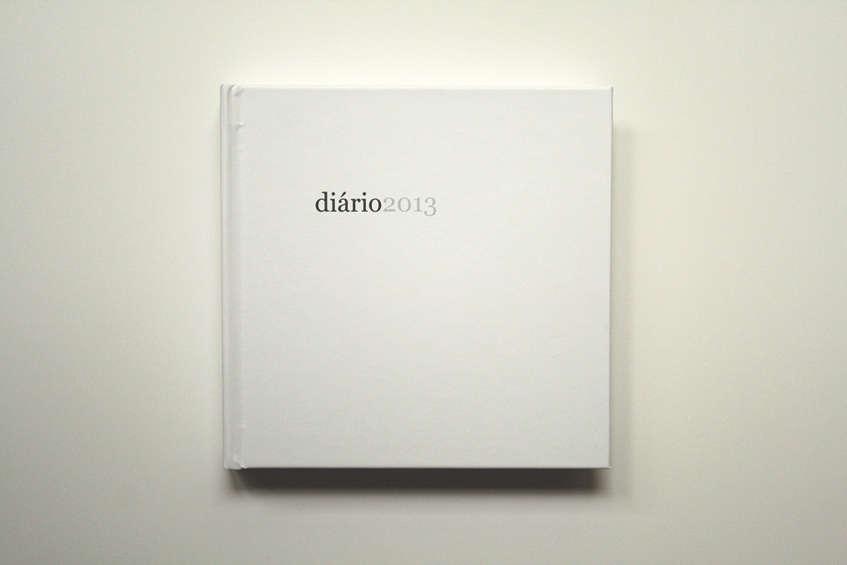
Art practice | 142
Figure 51 Diário2013, artist’s book published in 2016, 18 x 18 cm, single edition.
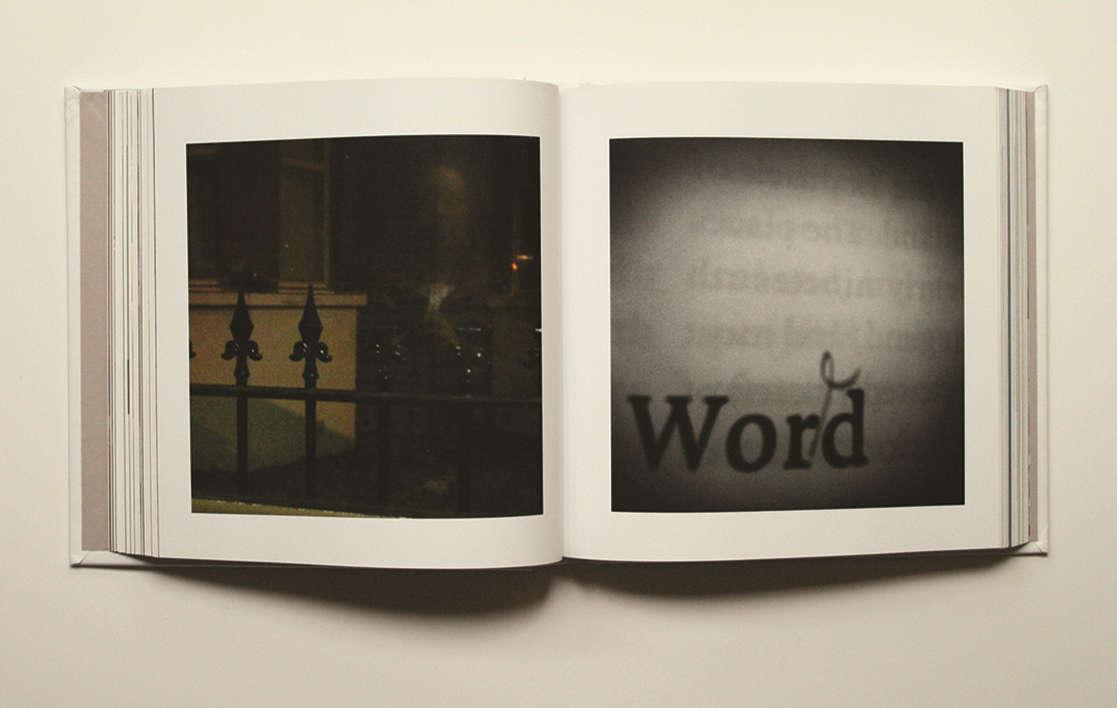

Art practice | 143
Figure 52 Diário2013, artist’s book published in 2016, 18 x 18 cm, single edition. Entries: 5th (left) and 6th (right) May 2013 (above), 12th (left) and 13th (right) May 2013 (below), London.

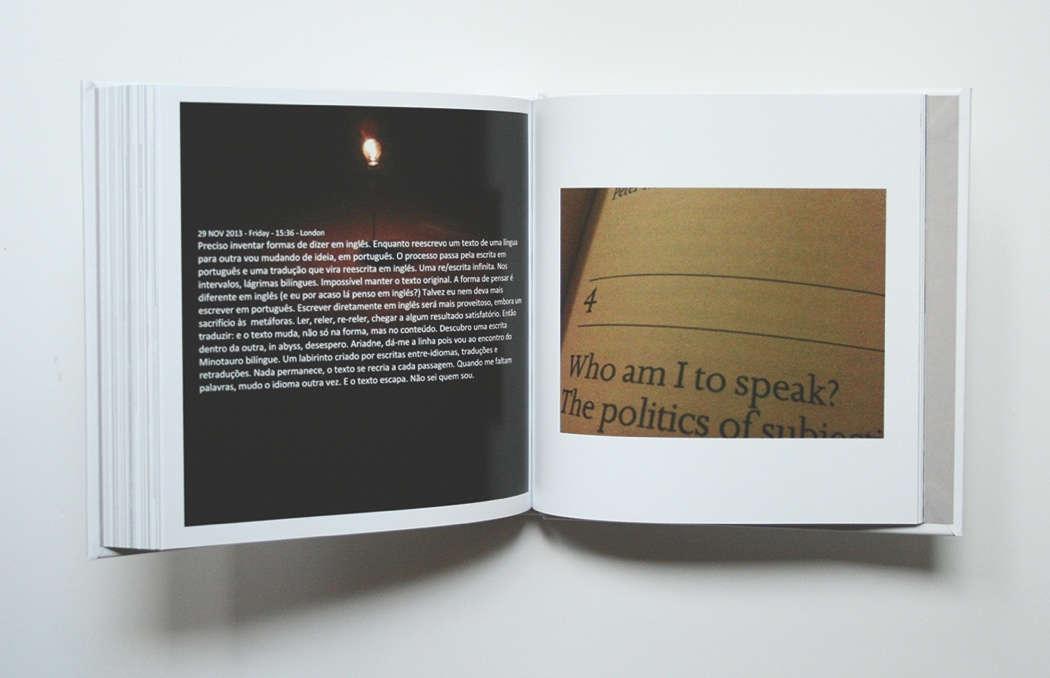
Art practice | 144
Figure 53 Diário2013, artist’s book published in 2016, 18 x 18 cm, single edition. Entries: 12th (left) and 13th (right) August 2013, London.
Figure 54 Diário2013, artist’s book published in 2016, 18 x 18 cm, single edition. Entries: 29th (left) and 30th (right) November 2013, London.
While I edited this photo-diary, I kept reading my written diary. It was a surprise, although quite obvious, to see images so in line with my written entries. There was a dialogue happening between the acts of writing and photographing, between images and texts: both were highlighting points of origination and routes of dispersion, but I was not conscious of them until the moment I put images and texts together.
Anaïs Nin mentions her pleasure and creative moment in copying her diaries for publishing: ‘while copying the diaries, I am filled with thoughts, excitements, memories, a rich world in my head’ (Nin, 1976, p. 149). In my case, editing the photo-diary was a moment of openness to new perceptions of past experiences, new connections among events, and it brought lucidity about self-location. Editing and publishing a diary is a laborious process of recreation. I understood that diaristic practice has more to do with leaving the colonial self than confession, despite confession of the colonial self might be important to build a path towards becoming decolonial. By gathering images and putting them together through editing and publishing, I understood better some of the origins of my sense of ‘out of place.’ Thus, through mapping feelings of shame, apathy, frustration, as well as of confidence, fulfilment, and motivation, I gradually unveiled interrelations between life events and coloniality of power, being, and knowledge Only then did I feel more prepared to take action and confront them. Otherwise, how could I free myself if I had no clarity about the sources of my own oppression? As Paulo Freire affirms,
Only beings who can reflect upon the fact that they are determined are capable of freeing themselves. Their reflectiveness results not just in a vague and uncommitted awareness, but in the exercise of a profoundly transforming action upon determining reality. Consciousness of and action upon reality are, therefore, inseparable constituents of the transforming act by which men [and women] become beings of relation (Freire, 2000, p. 40, italics in the original).
Art practice | 145
In my published photo-diary, there are a couple of entries that might demonstrate traces of the emergence of this consciousness. Figure 55, for instance, refers to the entries of 7th and 8th February 2013, in which I have at least three elements: a picture of an annotation I kept elsewhere about a film on literacy; an extract from my written diary from the same date of this picture; and a photograph picturing a ventilation space among London bricks The photograph of the annotation reads, ‘…eu tinha problema de falta de letra pra mim escrevê…,’ i.e. I had a problem of lack of words for writing I transcribed this sentence from an emotional oral account delivered by a woman, in Brazil, who participated in Paulo Freire’s literacy groups and told how her life changed from the moment she learned how to read. Below this photograph, I extracted a quote from my diary, where Paulo Freire affirms that we must learn to write our lives as authors and witnesses of our history, biography, and existence. In relation to the photograph of the wall, my thought was focused on how to become a passage of air among bricks on the wall.
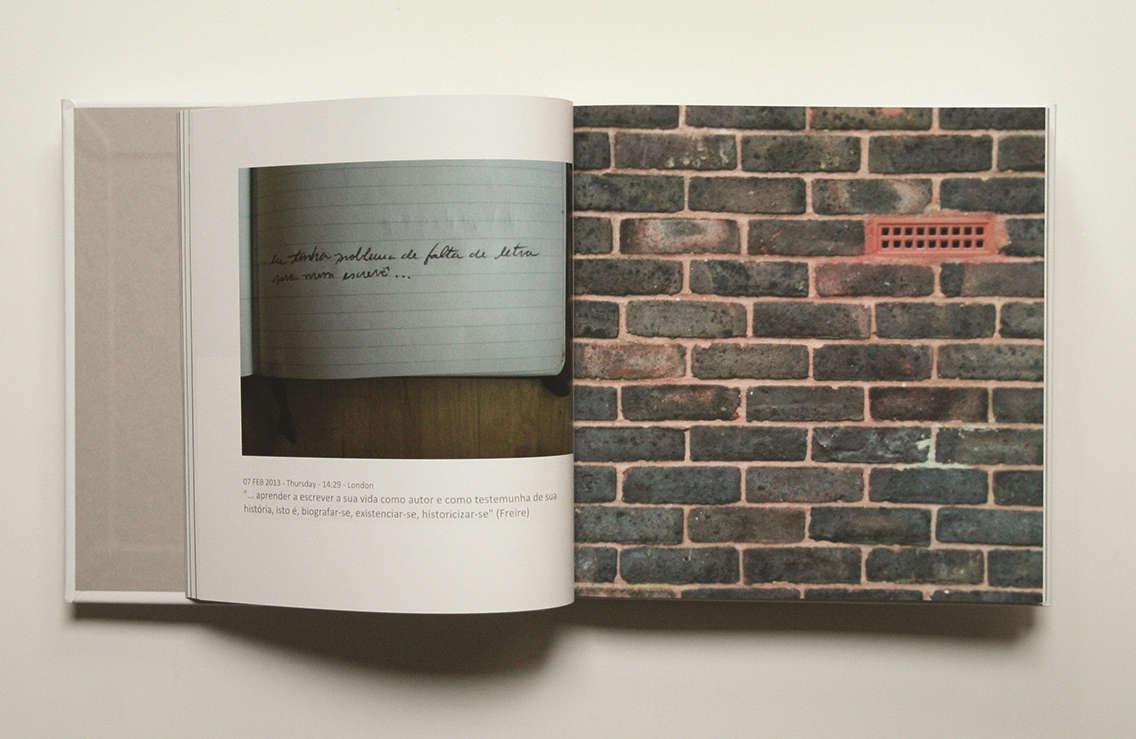
Art practice | 146
Figure 55 Diário2013, artist’s book published in 2016, 18 x 18 cm, single edition. Entries: 7th (left) and 8th (right) February 2013, London.
Editing and publishing my diaries strengthened my sense of personal history. Tuan affirms that ‘history is not only the passage of events but their conscious reconstruction in group memory for current purposes,’ so that it ‘plays an essential role in the human sense of territoriality and place’ (Tuan, 1976, p. 272). He also argues that ‘to strengthen our sense of self the past needs to be rescued and made accessible,’ and there are many devices ‘to shore up the crumbling landscapes of the past’ (Tuan, 2001, p. 187). However, it is important to acknowledge that this history is not fixed and is in a constant process of actualization by the present, in the present, and within the social By connecting personal histories meaningfully I can perceive temporary arrangements of a dismantled (colonial) self in a wider context. I feel partially accomplished, since there will always be those unreachable places of identity to which I referred in section 1.3, and that sometimes emerge in my daily life (Figure 56).
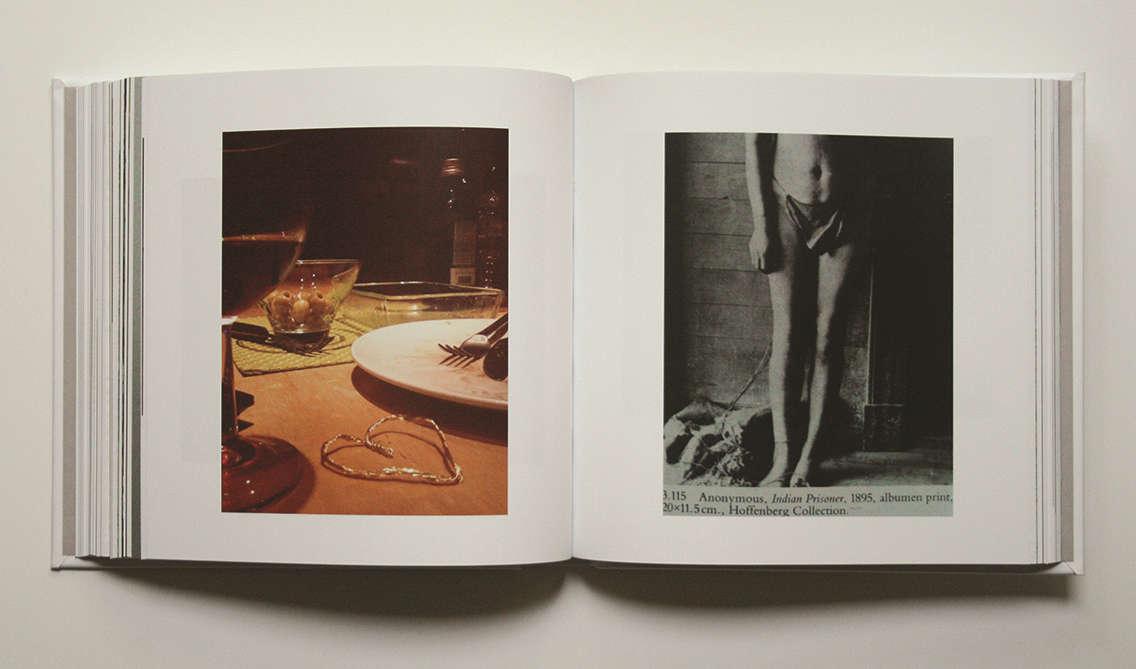
If a photograph can be seen as part of a subject, as one’s extension as Sontag (1979) suggests, then this photo-diary is a vibrant and unfinished self-portrait pointing out stories located in the past, present, future, and in the social.
Art practice | 147
Figure 56 Diário2013, artist’s book published in 2016, 18 x 18 cm, single edition. Entries: 28th (left) and 29th (right) August 2013, London.
Lejeune says, ‘let it vibrate, in its difference, in its strangeness, with its possible todays unfulfilled. Time is mobile. Life is loss. The editing is not meant to fuse the parts together and caulk the seals, but to open the floodgates a little’ (Lejeune, 2009, p. 325). In fact, publishing my diary as an artist’s book that combines visual and written accounts opened a space for raising an immigrant consciousness that keeps pushing my ‘self’ towards decolonization
When I included some passages of my written diary in the photo-diary, I created one more level of reading. As images and texts matched sometimes, I added small sentences and paragraphs from the written diary in order to amplify meanings and open new paths for reading. I tried to create places for cyclical movements in some of the pages, by overlapping images with different kinds of text (typed and photographed). Susan Sontag affirms that ‘for many decades the book has been the most influential way of arranging (and usually miniaturizing) photographs’ (1979, p. 4). She suggests that the book might not be the best scheme for putting groups of photographs into circulation because ‘the sequence in which the photographs are to be looked at is proposed by the order of pages’ (Sontag, 1977, p. 5). However, by assemblage, it is possible to disturb such linearity and offer a different kind of time – such as Tuan’s cyclical time through which it is possible to build a network of places – and offer alternative trails to readers
In my photo-diary, as photographs offer many levels of reading, each reader might catch a different story. Additionally, as it is an accented place, the reading experience will depend on the languages and geographical positions of each reader. Rather than accommodating life stories, this diary opens spaces for reading through combinations, ‘turnings’ and dislocation of meanings. Such as in Trinh T. Min-ha’s films (section 2.3.2), the more transcultural the audience is more stories they will get.
Art practice | 148
3.1.6 Language memoir
Wolf-Meyer and Heckman state that ‘many things present themselves to our consciousness in the course of a day, but only those landmark events that chart the development of our story find themselves written into our cartography’ (2002, para. 8). In July 2011, I accidentally met a special traffic sign at the crossroad between Oxford Street and Tottenham Court Road (Figure 57). Its text warned ‘Diversion ends’, but someone accented the word ‘diversion’, scratched out the word ‘ends’, and answered in Spanish: La diversión ha empezado!!!, which means ‘The fun has begun!!!’ The acute accent converted English into Spanish, opened the public space for a fun dialogue and gave place to other language, tone, meaning, author, and readers. The accent turned a space for warning into a place for diversión, diversidad, diversidade, diversity. All these words are somehow related to the Latin verb vertere, which means ‘to turn.’ This is a verb that translates from English into Portuguese in many ways. However, for the purposes of my practice and research, I focused on two of them: desviar, to divert, and mudar de posição, to change position.
When I met this traffic sign, I kept my perception ‘turning’ with the objective of increasing the possibilities of reading. I imagined its text as a message left by a Latin American passer-by, a piece of urban poetry, a bottom-up transnational manifesto, a dispute between languages, a transcultural writing practice, an accented voice showing itself publicly, a counter-narrative, a chapter of a wider story written by an immigrant on the surfaces of a western cosmopolitan city.
I noticed that ‘turning’ could become a powerful act for opening pre-given spaces and creating inclusive places where multiple presences and stories could co-exist. Spaces can be real and imagined, can tell and unfold stories, be appropriated and transformed through artistic and literary practices (hooks, 1990). The deviant aspect of such processes is crucial and, in the context of decoloniality, this deviance might be related to the (epistemological)
Art practice | 149
disobedience that creates ‘positions’ of enunciation as critical responses to colonial difference.
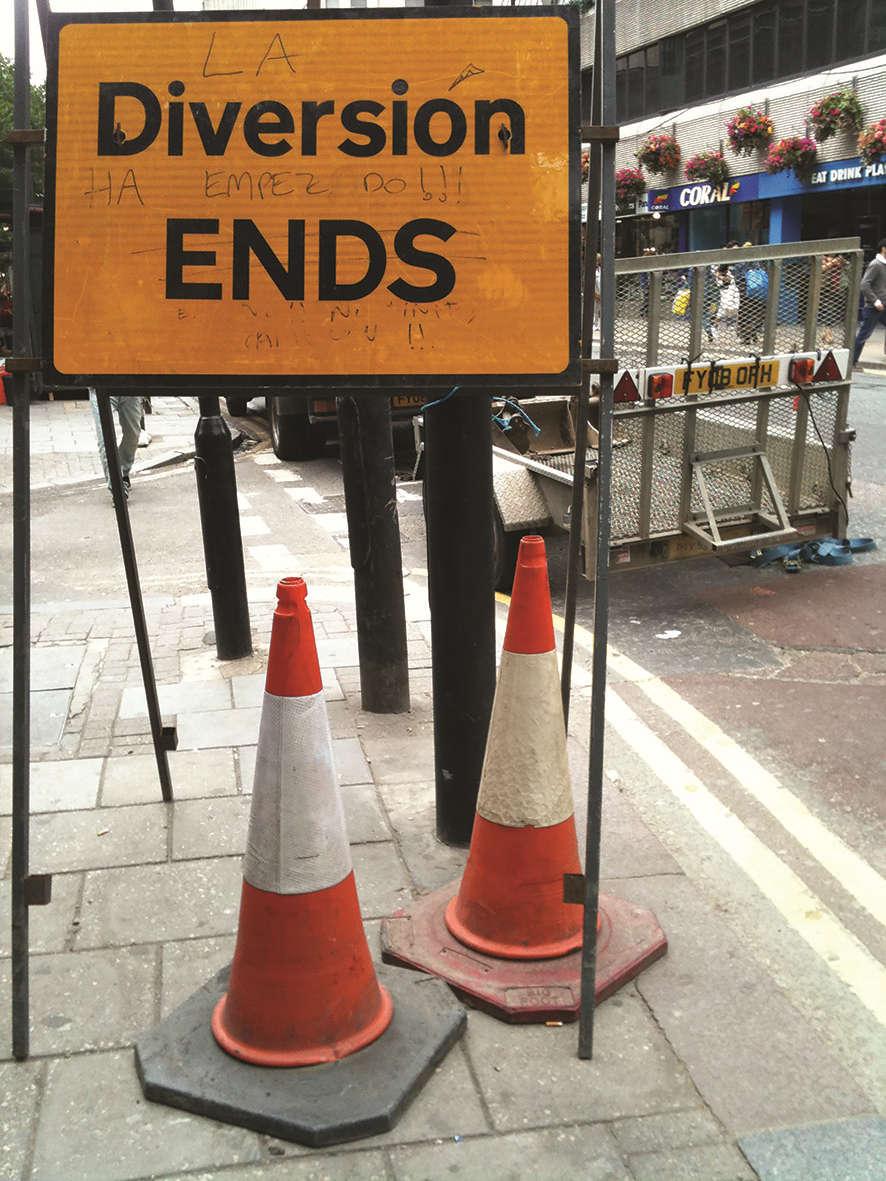
The first time I read this modified traffic sign I immediately felt addressed. For a brief moment it seemed that I had crossed the borders of ‘nowhere’ in direction to a momentary ‘here-and-now’ (Massey, 2005). Encountering this
Art practice | 150
Figure 57 La diversión ha empezado, 2011. Photograph
traffic sign caused a temporary feeling of belonging, and from this moment onwards I started to observe what kind of things were moving me from ‘no.where’ to ‘now.here’ (section 3.1.1).
Later, this meaningful experience lived in space would inspire my work and indicate how I could tell my story using the limited vocabulary I had collected through photography. The beginning of this story is located in the middle of change – in geography, in language, in identity – and branches itself in a myriad of fragmented stories built through art practice and that are in a continuous process of opening and, thus, of becoming (decolonial)
In 2012, right after moving from Brazil to Britain, I revisited the photographic archive I had produced when I was only visiting London, in 2011. There were many words in these photographs and I wondered whether it could be a result of my unpleasant relationship with English language, not only since I had arrived in the UK but since I was a child. During my school days, I did not like English classes because they were so far removed from any aspect of my daily life as well as from any perspective of the future. English was a subject that clearly divided children between those who could take additional classes in private language schools, often also travelling abroad, and those children who would never be able to even dream of it. At that time, I knew that I was not part of the privileged group of international travellers. Before entering the art school, I consumed international cultural products translated into Portuguese without a proper critical view Perhaps this explains why I used to resist learning the English language and make a deeper contact with its world when I was a child and teenager. As bell hooks (1990 and 1994) shares, some of her life events made her aware of institutional racism as well as of her own class background. When I was a child, despite I was a white girl, the English classes made me feel – but not understand – class distinction. In the interviews I carried out with the participants of this research (section 3.2.1), I identified similar issues: some of them referred to their problems with the English classes in school and mentioned it also as a socioeconomic status issue.
Art practice | 151
As a series of circumstances and choices brought me to London, I had no other option but to face the English language and overcome my past resistance to it. However, I had decided that this language should enter my life in an emancipatory manner. In his last public interview recorded in video, Paulo Freire (1996) says, in English, that it is impossible to think about language without thinking about ideology and power. He recognizes the duty of teachers in teaching as well as the right of students in learning the dominant pattern and syntax Only by democratizing language can everyone articulate their voices and their speech to overcome silence and in favour of their struggles, as a bottom-up movement
By looking at my photographs, I wondered if I had been collecting words like someone trying to articulate a message, a story yet to tell. If ‘to photograph is to appropriate the thing photographed’ and if ‘it means putting oneself into a certain relation to the world that feels like knowledge – and, therefore, like power’ (Sontag, 1979, p. 4), perhaps this was the way I found to regain the power I had lost as a newcomer facing difficulties to express myself in English. Thus, my photographed words seemed to be a cry within the place of muteness, and my task should be to disclose the stories hidden underneath them. If ‘the camera’s rendering of reality must always hide more that it discloses’ (Sontag, 1979, p. 23), I should call my art practice up and investigate what my archive of photographs was trying to enunciate
Inspired by the act of ‘turning’ meanings through the use of an ‘accent’ (Figure 57), I assembled photographs, changed their positions, groped for meanings through writing accented and fragmentary narratives. Every time I disclosed a story, I revived that bliss of receiving a new letter or looking at freshly developed photographs (as told in section 1.3). Besides, Ceschel suggests that to group and regroup photos can help us make sense of the work, given that it helps to ‘see patterns emerge within and between’ photographs, and ‘sometimes a good photograph will simply not fit the message or concept you are trying to portray’ (Ceschel, 2015, p. 489).
Art practice | 152
The first book I created by using these photographs is called Memoir (London, 2010-2013) (Figures 58 to 61), and was produced using the same print on demand services I used to shape my photo-diary and the previous artist’s books presented in section 3.1.1.

Art practice | 153
Figure 58 Memoir (London, 2010-2013) The red book. Artist’s book, 18 x 18 cm, single edition
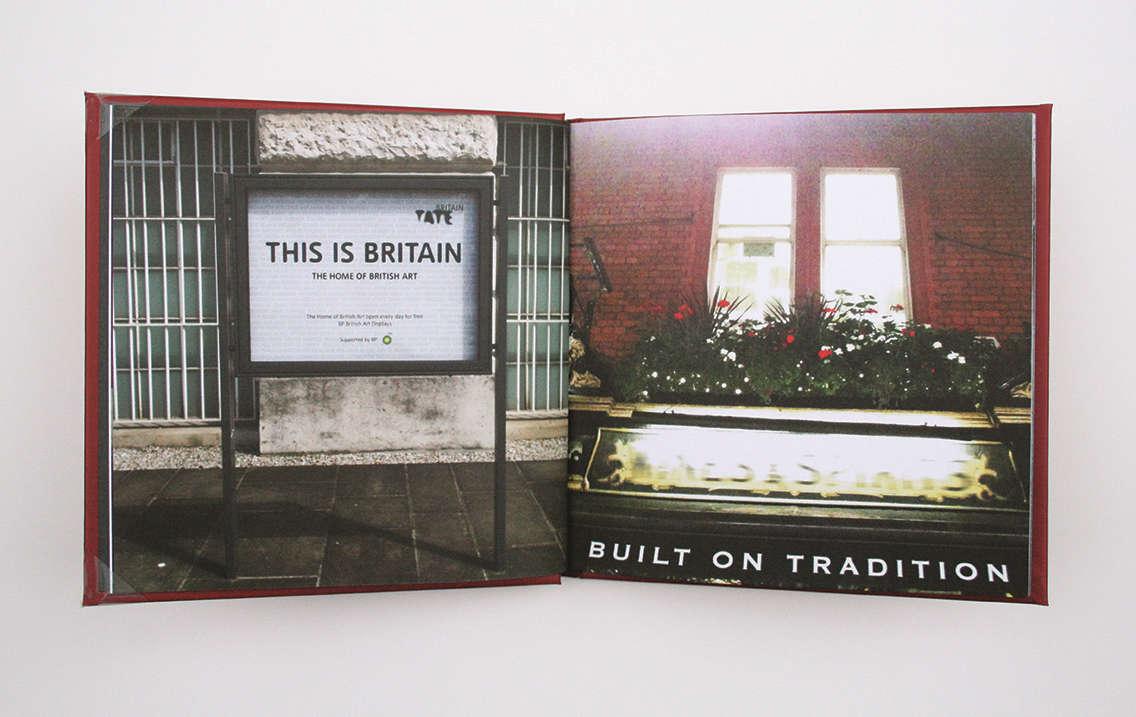
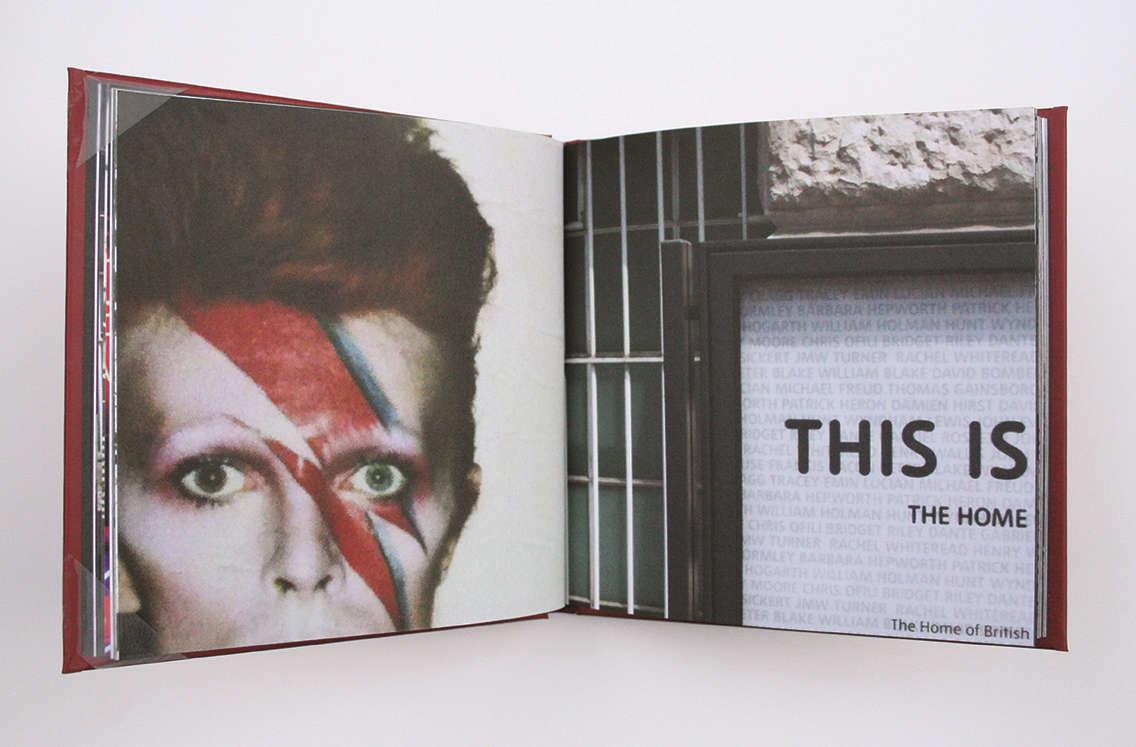
Art practice | 154
Figure 59 Memoir (London, 2010-2013). The red book. Artist’s book, 18 x 18 cm, single edition.
Figure 60 Memoir (London, 2010-2013). The red book. Artist’s book, 18 x 18 cm, single edition.

On 18th August 2013 I wrote in my diary, ‘I think that it would be a book, an artist’s publication comprising texts about the arrival in another country, the English language, the necessity to talk to someone… and the attempt to communicate by using what was available.’
This memoir is divided into six chapters: the arrival, surveillance, taking action, university, life goals, and meeting loved ones. By reading through the printed version, I realised that the selecting process on the streets was indicating the qualities of the experiences I was embodying even before moving to London. I wrote in my diary once, ‘I have decided to speak to the city, in silence.’ Photographing words activated latent narratives that were already pointing to unconscious emotions that would make life stories emerge afterwards.
As writing became a key element for my practice, photography came to work as a kind of ‘type machine’ through which I wrote words by clicking instead of typing. Language memoir seemed to be the perfect genre to guide conceptually this writing-making process, since it not only focuses on experiences about learning a language, but is a relational and democratic life
Art practice | 155
Figure 61 Memoir (London, 2010-2013) The red book. Artist’s book, 18 x 18 cm, single edition.
writing genre that might involve the act of writing in a new language itself (section 2.2.2.1). Alice Kaplan highlights that not having many words forces us to say more with less; ‘the simplicity of our communication moves us, we’re outside of cliché, free of easy eloquence, some deeper ideas and feelings make it through the mistakes and shine all the more through them’ (Kaplan, 1993, p. 210). In order to build these books, I held myself on not-knowing the language and on the few words I had In this way, I opened space to arrange a multiplicity of stories and, thus, unfolded writing processes through an art practice that started to work as a place of enunciation as response to a place of muteness
Assembling images of words into books is the strategy I used for crafting an accented, visual and textual voice. Through this process, I mapped my dynamic subject positions within displacement. If the notions of image and reality are complimentary and the camera is an ideal arm of consciousness, as Sontag (1979) suggests, then photography can work not only to capture images or mirror realities, but to build and disclose meanings as pointed out by Victor Burgin (1982) in section 3.1.6.1.
However, once I had the printed book in my hands and kept reading it, I felt dissatisfied after a while. My written voice was not visible enough because it was immersed in all the imagery of those pictures Then, I decided to erase the images and produce a new book only with words (Figures 62 to 64). The new book impacted me profoundly because I ‘saw my voice’ clearer.
Art practice | 156
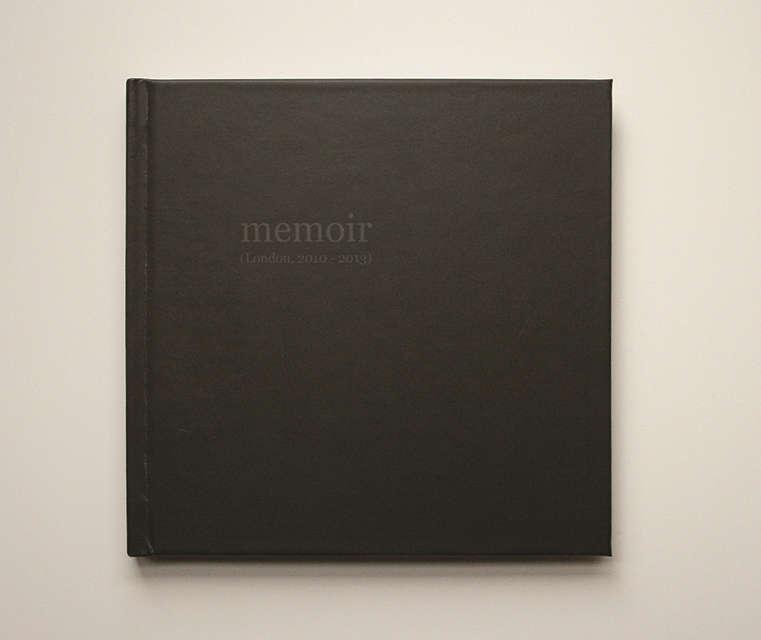
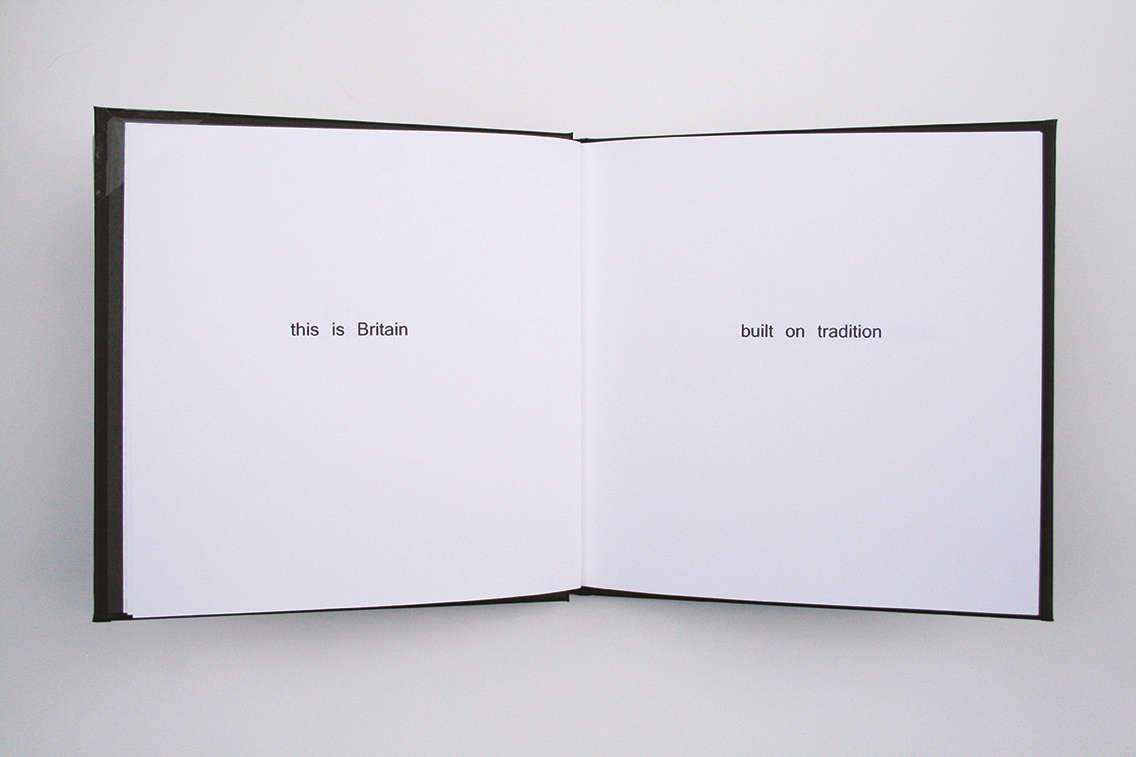
Art practice | 157
Figure 62 Memoir (London, 2010-2013) The black book. Artist’s book, 18 x 18 cm, single edition.
Figure 63 Memoir (London, 2010-2013) The black book. Artist’s book, 18 x 18 cm, single edition.

By subtracting its visual surroundings, this accented voice built through diversion got ‘louder.’ This process became an unprecedented writing-making process that involves three phases: 1) selecting words through photography; 2) composing narratives through assemblage; and 3) subtracting image to make the textual voice appear (Figures 65 and 66).
In this writing-making process, when the image is gone, ‘voice’ appears. It seems that images were distracting me while I sought for understanding about ‘why did I photograph those words and not others?’ The narratives in this book are born from strategies of appearance and disappearance, location and dislocation. The appearance process is related to the formation of a personal, experiential and embodied vocabulary. The disappearance process involves getting rid of the visual in favour of the textual. In this work, the photo/graphic act is part of a learning process as well as of the effort in articulating and making sense of an accented voice by selecting words in the city and assembling them, as specific arrangements, in books. This autobiographical practice is a source of ambiguous narratives about detours, turnings and diversions. It favours the movement towards the decolonial self
Art practice | 158
Figure 64 Memoir (London, 2010-2013) The black book. Artist’s book, 18 x 18 cm, single edition.
because it unveils coloniality of being, i.e. those daily elements that make one feel inferior, fragile, disempowered.
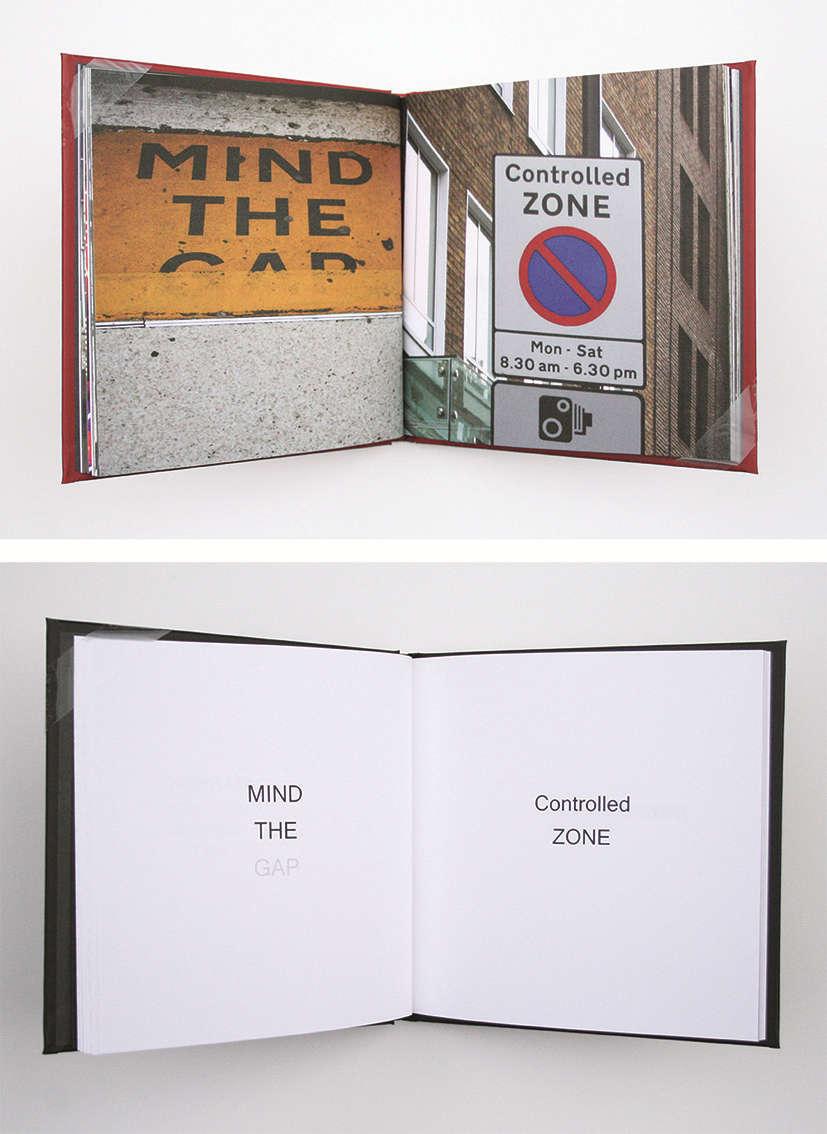
Art practice | 159
Figure 65 Memoir (London, 2010-2013) Red and black books together. Artist’s books, 18 x 18 cm each, single edition.

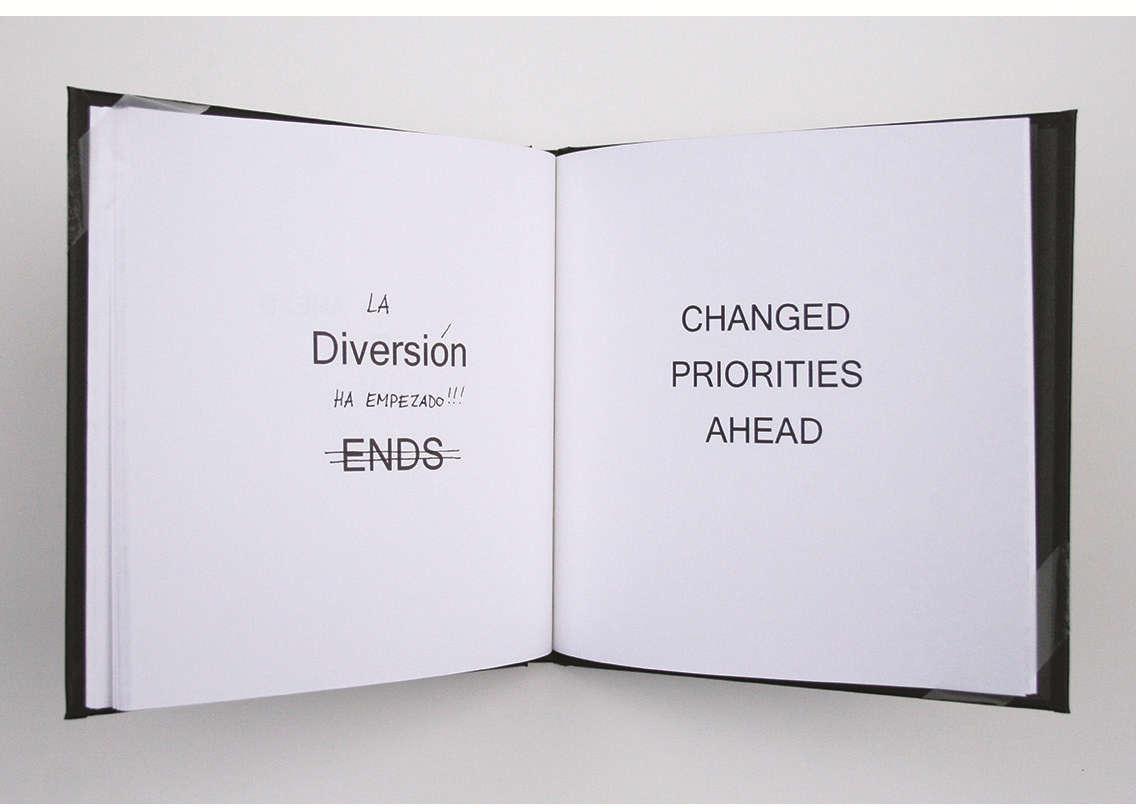
Art practice | 160
Figure 66 Memoir (London, 2010-2013) Red and black books together. Artist’s books, 18 x 18 cm each, single edition.
Paulo Freire (2011a and 2011b) argues that one needs to learn to say her or his own word in order to know and transform the world. I can see a relationship between my writing-making processes and some of the aspects of his alphabetization method, which is divided into five parts, three of them being more relevant here: first, it is necessary to understand one’s vocabulary universe; then, to build a selection of meaningful words from such universe; and finally to create situation-problems that can link local contexts to the words selected previously. The problem-solving step is focused on critical thinking and each selected word is not only approached through grammar, but also works as an opening for discussions about power relations that might be surrounding it. Moreover, if this is a truly dialogical process, one can learn how to use such vocabulary to pronounce the world and transform it. This is a process of enunciation in Freirean terms.
After observing and experiencing many of the socio-political events that have unfolded in Britain since 2012, mainly those related to immigration and the referendum decision of Britain to leave the European Union, I can see that the words I collected in 2011, as well as some of my other artworks, were a kind of omen. Currently, when I read my books again and look at the whole body of artworks created during these four years I lived in London, I wonder if I was already feeling the reactionary movement preparing for the closing of a space. Reading is a dynamic process and the messages were already there, hidden in daily life. One needed only to clean the distractions surrounding the words and look through decolonial lens to understand the gravity of such messages.
Art practice | 161
3.1.6.1 Hidden stories within found words
From 15th October to 2nd November 2014, I participated in an art event called Art:Language:Location,24 in Cambridge. As I was already confident regarding my writing-making process, I proposed the creation of two new books based on words collected on the streets of Cambridge. I spent a few days walking around (Figure 67) in order to build a new vocabulary with which I would write a new language memoir.
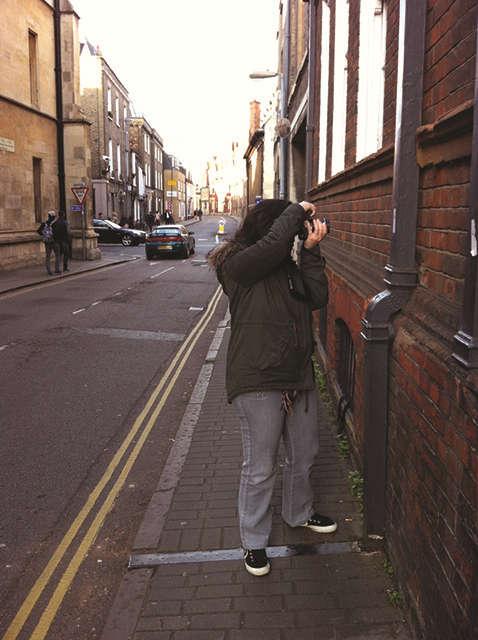
Art practice | 162
24 https://artlanguagelocation.org/
Figure 67 Building a vocabulary, Cambridge, 2014. Photograph by Alexandre Strapasson
Making these books became a completely different experience. My writing process started before the assemblage phase. As I was more conscious of the method, I started to write the books on the streets. I looked at the words available in the environment like someone who builds paragraphs. My camera functioned as a collector of words through light exposure. By walking while writing, writing while walking or walking-writing, I became excited about turning the next corner to see the narrative develop In this sense, I agree with Burgin’s (1982) thought on photography as a practice of signification that is related to society as a whole. In his interdisciplinary proposal of a photography theory, ‘practice’ means to ‘work on specific materials, within a specific social and historical context, and for specific purposes,’ and ‘signification’ is related to ‘the fact that the primary feature of photography, considered as an omnipresence in everyday social life, is its contribution to the production and dissemination of meaning’ (Burgin, 1982, p. 2, italics in the original). However, in my work, I am not interested in discussing photography as ‘representation’ but as a medium for ‘enunciation.’ In my writing-making processes, photography became a powerful tool that intermediates the processes of confrontation of coloniality. In this sense, photography does not show, but discloses meanings that are being represented and perpetuated somewhere else, not only in photographs My concern is focused on what I can do through photography to confront coloniality of power, being and knowledge, raise immigrant consciousness, and approach the decolonial self.
The books created in Cambridge, called Hidden stories within found words, comprise two chapters: the first is one about a ghost identity and the second one is about the woman-in-transit self. They are on permanent display at the Casimir Lewy Library, University of Cambridge (Figures 68 to 71).
Art practice | 163


Art practice | 164
Figure 68 Hidden stories within found words (the red book), 2014. Artist’s book, 21 x 25 cm, single edition
Figure 69 Hidden stories within found words (the red book), 2014. Artist’s book, 21 x 25 cm, single edition.


Art practice | 165
Figure 70 Hidden stories within found words (red and black books), 2014. Artist’s books, 21 x 25 cm each, single edition
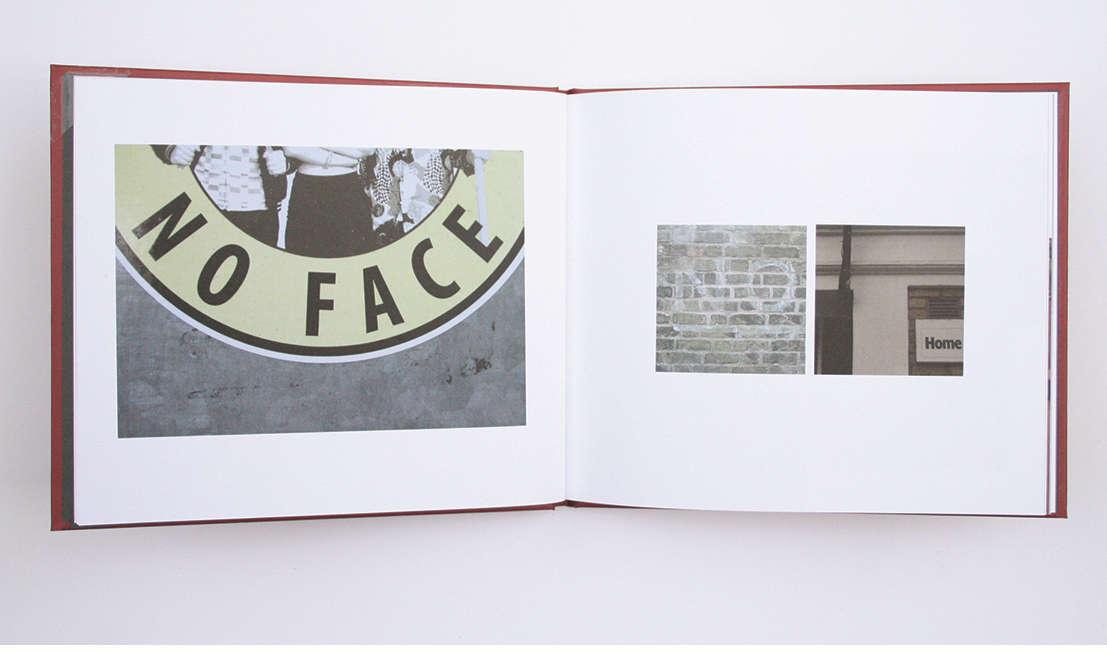
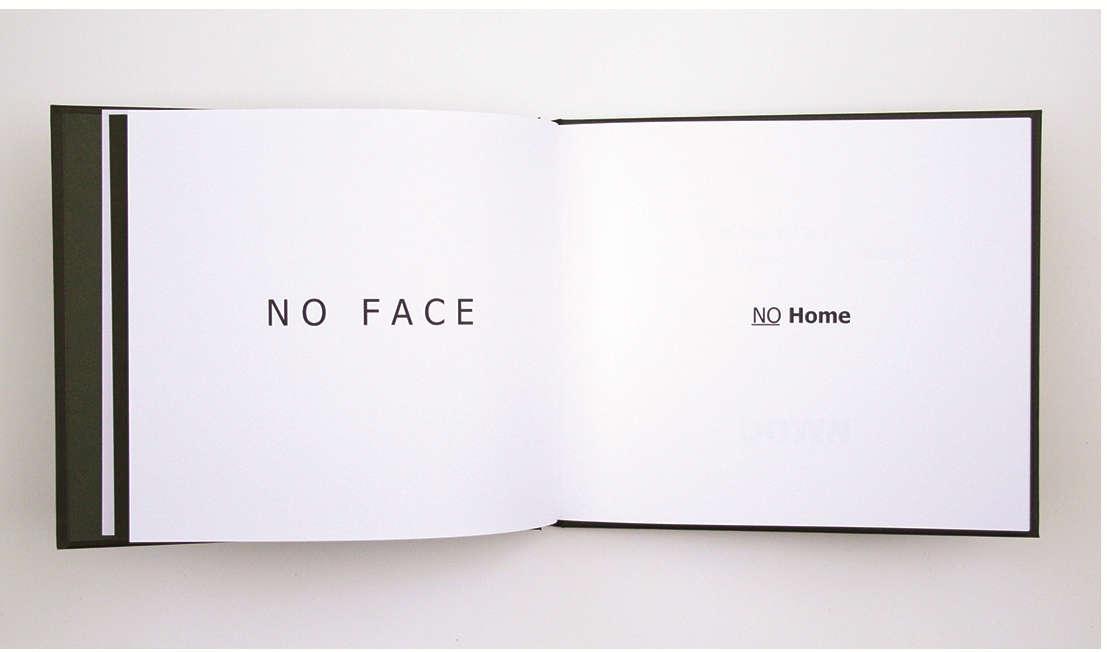
Art practice | 166
Figure 71 Hidden stories within found words (red and black books), 2014. Artist’s books, 21 x 25 cm each, single edition
3.1.6.2 Since I left
From 14th to 22nd June 2014, I attended a writing workshop on vignettes and verses in Ireland. I engaged in writing and reading activities with a group of North American women who came to Ireland to write about, among other themes, their Irish ancestry. As the only South American woman in the group, it was difficult not to think about our differences and commonalities in relation to a wider American identity. Thus, I looked for a thread that could lead me to the creation of an autobiographical narrative through art practice, while considering these thoughts as well as any ancestral connection with the place where we were, in Cork. Through this exercise, I recalled a story I heard years before about a phantom island called Hy-Brazil Then, I went to the library of University College Cork and discovered that I was in the precise region where this myth had supposedly originated.
Hy-Brazil is a Celtic myth about a phantom island that is often associated with Tír na nÓg, the ‘Land of Youth.’ This is an island immersed in fog that appears for only one day every seven years as an ‘enchanted sunken island with mountains, verdant pastures filled with sheep, and gleaming cities’ (Johnson, 1996, p. 113). According to Johnson (1996), Hy-Brazil firstly appeared on maps around 1325 and disappeared from cartographic records in approximately 1865, a period that coincides with the history of colonialism and the establishment of Portuguese, Spanish, British, French and Dutch overseas territories.
The name ‘Hy-Brazil’ comes from an ancient Gaelic word, breas, which means noble, prince, or fortunate, but it might also be associated with one of the early Christian missionaries of Ireland, Saint Bresal, as well as with a mythical woman called Gaillimh inion Breasail, who was drowned in the river of Galway (Cantarino, 2004; Frentag, 2013; Johnson, 1996; Mitchell, 2006). In contrast, the word ‘brasil’ was used by the Portuguese to refer to trees and other plants that produce red dye and supposedly applied to my country’s name, Brasil, due to its abundance of pau-brasil tree at the time of the
Art practice | 167
Portuguese and Spanish invasions, from the late fifteenth century onwards. However, the diplomat, activist, Irish nationalist, and poet Roger Casement25 – who lived in Brazil between 1906 and 1911 – argues that this story is not enough to explain the name of the country, since ‘the Irish origins of Brazil had been written out of the history books’ and the ‘Anglo-Saxon interpretation of history had obscured and corrupted the history rooted in a more ancient Irish origin’ (Mitchell, 2006, p. 158) While Casement lived in Belém do Pará, North of Brasil, he analysed how historians’ orthodox views on the histories of ‘discovery’ had neglected the ‘Irish influence in Atlantic culture through their ignorance of the Irish language and their denial of a more ancient and mystical source of knowledge’ (Mitchell, 2006, p. 158).
Johnson observes that ‘no other phantom island in the Atlantic is cloaked in so many identities as Hy-Brazil’ (1996, p. 113). According to him, there is a multiplicity of Irish names connected to this legend: Land under the Wave (Tír fo-Thuin), Land of Truth (Magh Mell), Isle of Life (Hy na-Beatha), Land of Virtue (Tír na-m-Buadha), among others (Johnson, 1996, p. 114). He also notes that some variants such as Ysole Brazir, Bracir, and Hy Breasail, are the most common names appearing in maps of the fourteenth and fifteenth centuries. Johnson suggests that it is possible to get a better sense of the multiple identities of this island more through the combination and approximation of narratives than through historical and geographical certainties, since it is an island with multiple names located off the west coast of Ireland but that might appear in other locations, ‘sometimes on the very same chart’ (Johnson, 1996, p. 114). Some of these maps show Hy-Brazil as
25 ‘The Irish patriot Roger Casement (1864-1916) was a British consular official in Brazil in 1906-1911. In 1906 Casement was appointed consul in Santos and in 1908 he became the consul in Pará (Belém). He was promoted to consul-general in Rio de Janeiro in 1909, a position he retained until 1913. In 1910 Casement was directed by the Foreign Office to occupy a commission of enquiry sent to the rubber-producing Putumayo region of the western Amazon, an area straddling the Peruvian-Colombian frontier, to investigate treatment of the local Indian population by the Peruvian Amazon Company. He was knighted in 1911 for this and for similar work in Africa. During the First World War Casement sided with Germany as a tactic to promote Irish independence, and in 1916 he was hanged by the British for treason. To damage his reputation, the British publicised the existence of Casement's diaries, which included numerous graphic and coded accounts of his homosexual activities in Brazil and elsewhere’ (Murray, 2006, p. 100).
Art practice | 168
two portions of land with a space in-between (Figure 72) or as a more defined circular form with a channel crossing through the middle, which in some stories mean a river flowing from east to west (Figure 73).

Art practice | 169
Figure 72 Gerardi Mercatoris and Rumoldi Mercatoris, Europa ad magnae Europae map, 1630. Detail of Hy-Brazil and Ireland. Source: Bibliothèque nationale de France, Département des manuscrits, public domain.
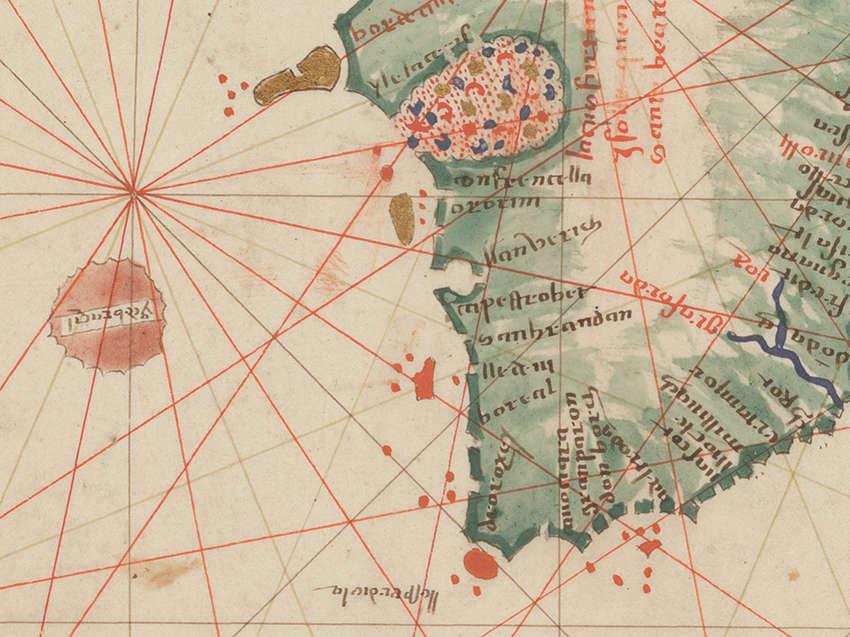
During my walks in Glengarriff, I found a similar form at the centre of a stone circle dated from the Bronze Age and called ‘Dereenataggart,’ located in Beara Bay (Figure 74). People from the village as well as visitors make wishes and leave small objects inside the slit of this stone. My connection to these facts, places, and stories became stronger when I noticed that this form is also present in the centre of the Brazilian flag (Figure 75). I had some conversations with local guides and people in order to identify if they knew any additional information about these similarities, but they only appeared to be as surprised as myself.
Art practice | 170
Figure 73 Portulano italiano, Atlas de cartes marines de la Méditerranée et de la mer Noire, 1470-1482. Detail of Hy-Brazil and Ireland. Source: Bibliothèque Nationale de France, Département des Manuscrits, public domain.

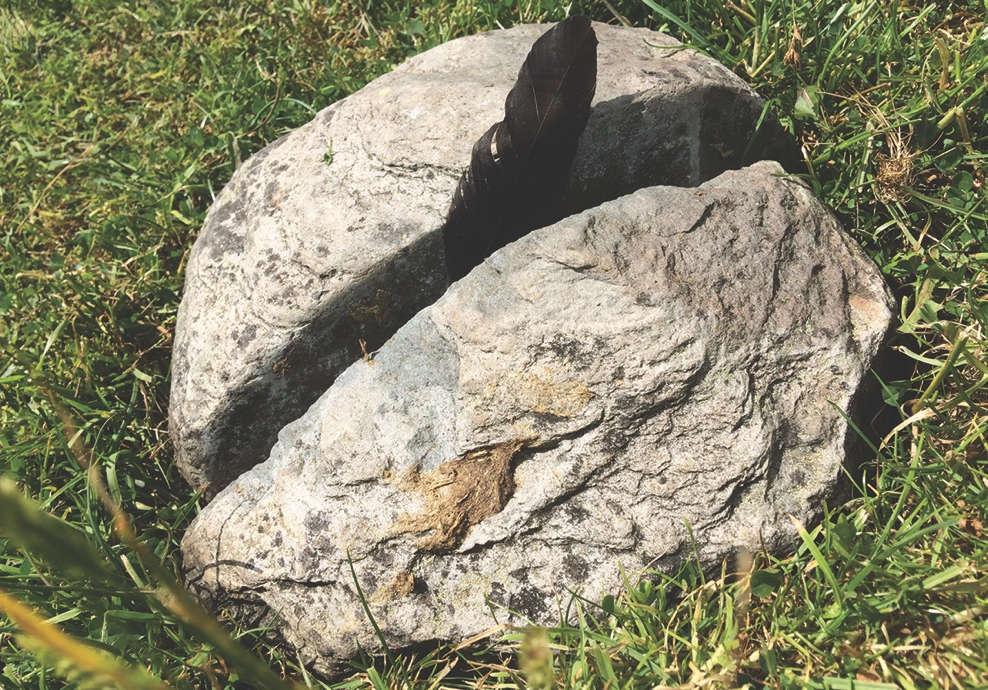
Art practice | 171
Figure 74 Dereenataggart Stone Circle, Bronze Age, Beara Bay, Ireland, 2014.
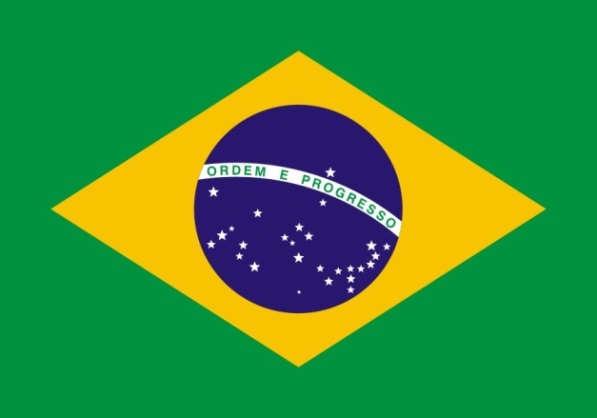
As I had gathered enough material to write a new book, I positioned myself as an expatriate who voluntarily left Hy-Brazil a long time ago and can no longer return home because, once left, home became a hidden and oscillating place. Unlike the stories I had previously read about adventurers trying to reach this island, I was not looking for Hy-Brazil as a sailor, merchant, fisherman, or conqueror who wanted to find it with the purpose of extracting its gold or making it a ‘convenient base of operations’ for the expeditions departing from Bristol in the direction of the ‘far East’ (Johnson, 1996, p. 115). I positioned myself as a woman who was born in this island, who went out to see the world and cannot return. Since I change, my views also shifts, and when I look back to the place left behind I see another place.
Exile, according to Said, is a discontinuous state of being, a solitude experienced by those who leave the apparently bounded – but not comfortable – place of national identity (Said, 2000, p. 140). In my perception, and emphasizing the obvious, a Brazilian identity built on elements such as happiness, samba, carnival, football, and sunny beaches does not correspond to my experience and probably does not correspond to the experiences of
Art practice | 172
Figure 75 Brazilian flag. Source: Brazilian Government
many other Brazilians. On the contrary, these associations make me feel uneasy and out of place. In the artist’s book Since I Left, I position myself as a Hy-Brazilian woman who leaves her phantom island and keeps wandering like a ghost, failing to reach a lost place that was, in part, a result of the combination of misleading notions and images. I write at the end of this book, ‘since I left paradise, colors and lights are shining inside.’ Leaving became an act of liberation from oppressive stereotypes and identities taken for granted.
As all these terms, Hy-Brazil, Brazil with ‘z’ (Brasil viewed from outside) and Brasil with ‘s’ (Brasil viewed from inside), refer to constructed places that can become often inaccessible. If I keep looking for ‘home’ it is because the search itself – through art practice – became the best way to be close to it.
Thus, for this book, I wrote differently this time. Rather than collecting words across the city, I used a label machine to add texts to the environment and photography to register each intervention. Each photograph meant one page of the book. Rather than assembling images into books, I combined texts with the environment in order to shape my narrative, directly on the landscape. Photography, this time, worked more as a documenting process. It registered the pages of an unbound book that was written on specific public spots. These photographs became the material with which I wrote a book about the book I left on the landscapes of Cork and Beara Bay (Figures 76 and 79).
Art practice | 173

Art practice | 174
Figure 76 Since I Left, 2014. Artist’s book, 28 x 21,5, single edition
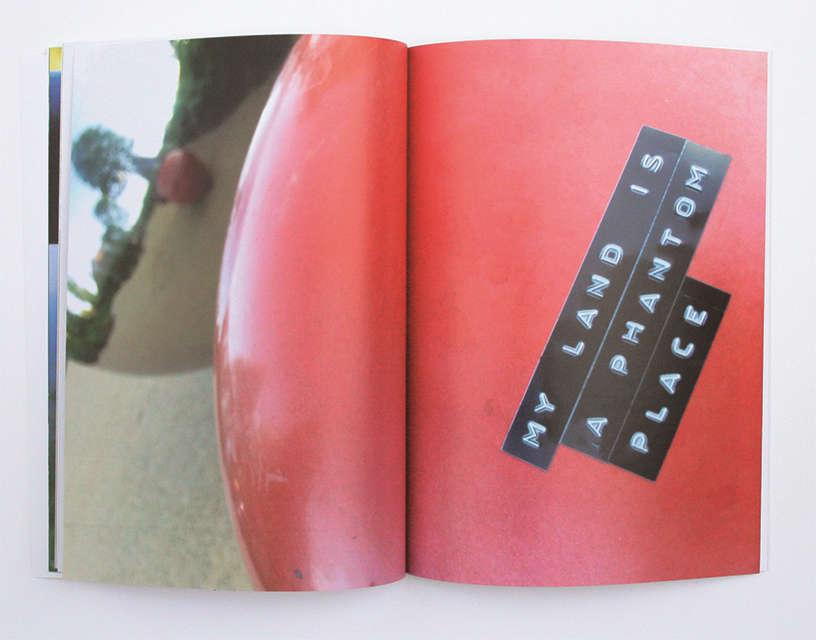
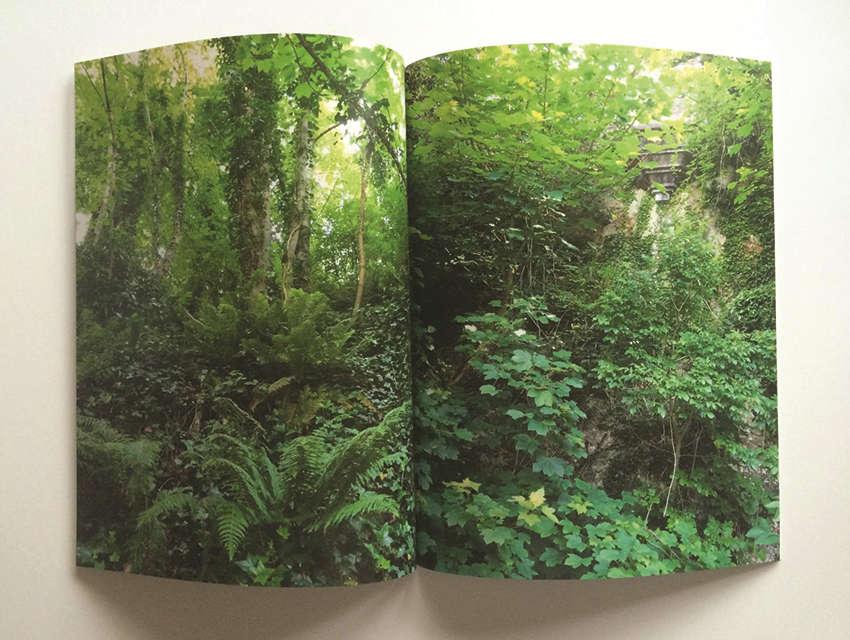
Art practice | 175
Figure 77 Since I Left, 2014. Artist’s book, 28 x 21,5, single edition.
Figure 78 Since I Left, 2014. Artist’s book, 28 x 21,5, single edition.

Art practice | 176
Figure 79 Since I Left, 2014. Artist’s book, 28 x 21,5, single edition.
On the last day spent in Cork, I found Hy-Brazil in a moon stone (Figure 80). According to an old lady who is a storyteller from Glengarriff village, this is the stone related to my date of birth. At the end of my trip, I went home for a moment.

Art practice | 177
Figure 80 Hy-Brazil, 2014. Photograph, moon stone.
3.2 Multiplicity of stories
When I started to teach at the Federal University of Goiás (UFG), I came to experience interrelations among my teaching, researching, and art practices. As they started to influence each other, I explored places in-between that could work as temporary meeting points for involving people in creative, investigatory and learning processes. Such meeting points would form temporary places for conviviality in which people could compound transitory collectives as well as create individually within a collectivity (Afonso, 2011).
Doreen Massey (2005) highlights the importance of negotiating the multiplicity of place in order to keep space open to a progressive future. Moreover, she argues that the politics of place lies on being-in-the-world together. Creating places to-be-together, to-be-more (Freire, 2011b), and then to-become-decolonial-together are my concerns as an artist, teacher, and researcher.
The interest in developing collective practices in this research comes from earlier convivial experiments I developed in Brazil. Currently, the work developed with twelve Brazilian women living in London is informed by the context of practice presented in section 2.3, especially by the artists Stephen Willats (section 2.3.1) and Luis Camnitzer (section 2.3.4), who are interested in the interrelation between art and social change While Willats’s modelling strategies for developing dialogical art practices have informed the activities conducted with participants, Camnitzer’s geopolitical, professional and pedagogical positioning have influenced my own exercises of self-location as an artist, teacher, and researcher who is also using writing as a crossing element among practices. Additionally, later on in this research I met the work of Cigdem Esin and Corinne Squire (Squire et al., 2013; Esin and Squire, 2013) on visual autobiographies, which made me aware of narrative research approaches to visual arts and supports my searches for the inverse path, i.e. what would be my contribution as an artist to the field of narrative research if I create visual arts approaches to life writing
Art practice | 178
The collective practice of this research is also informed by critical pedagogy, especially Ivan Illich’s notion of conviviality, Paulo Freire’s approach to dialogue, and Pablo Helguera’s transpedagogy.
Helguera stresses that artists and collectives might ‘blend educational processes and art-making in works that offer an experience that is clearly different from conventional art academies of formal art education’ (Helguera, 2011, p. 77). In transpedagogical projects, independent environments might be created through connecting aspects from art, education and/or research while blurring disciplinary boundaries. This indicates ‘an emerging form of artmaking in which art does not point at itself but instead focuses on the social process of exchange’ (Helguera, 2011, p. 81).
Exchange depends on dialogue, and dialogue is a form of exchange. Dialogue, for Freire (2011b), is an encounter among human beings for thinking and acting critically in and with the world. Through dialogue, people can create places ‘to be more,’ seeking to transform social relations and raise awareness about power relations in society at large (Freire, 2011b, p. 114). It does not mean that dialogue promotes a totally free space with no programme and content. In the Freirean approach, dialogue cannot exist in a political vacuum (Bishop, 2012), since it is part of historical processes in becoming human beings, i.e. it has a geopolitical location and constantly points the tensions between authority and liberty out (Freire and Shor, 1987). Dialogue is not only about talking; it is mostly about listening. It can provide convivial moments ‘where humans meet to reflect on their reality as they make and remake it’ (Freire and Shor, 1987, p. 13). Therefore, exchange and dialogue might lead to convivial experiences.
According to Ivan Illich (1973), conviviality is an individual freedom perceived as creative intercourse among persons and between persons and their environment. In Illich’s criticism on the mass industrial production, he differentiates ‘convivial’ from ‘manipulative’ tools, where ‘tool’ might be an artefact, rules, institutions, and systems such as education, health, and
Art practice | 179
science, and I would add art as one of these systems. Such institutions and systems function as convivial when they offer to each person ‘the greatest opportunity to enrich the environment with the fruits of his or her vision’; or they can work as manipulative tools and deny the freedom for creation, becoming a ‘power tool’ for control, centralization, and passivity (Illich, 1973, p. 34).
Transpedagogy, dialogue and conviviality are the pillars of my collective projects. These three concepts inform the way I work to build bridges between the individual sphere of my practice and the temporary places activated through collective practices. I refer to individual and collective spheres not to make an opposition between private and public, personal and in group, ‘I’ and ‘they’ or ‘us.’ The distinction between individual and collective refers more to the different moments of a practice that keeps moving and occupies different geographical and theoretical spaces. ‘Individual’ and ‘collective’ are terms used not to separate, but to indicate the singularity of each sphere of my practice, in which one focuses on my individual responses to experience lived within displacement, and the other directly involves people. Each sphere depends on the other and often intersects
The following sections describe the collective processes developed together with twelve Brazilian women living in London Such processes are based on the procedures that originated from my individual practice (section 3.1) This section 3.2 is divided into four parts: 3.2.1 is focused on the semi-structured interviews carried out with each participant and on the diaristic practice proposed as a continuation of our conversation; 3.2.2 presents the domestic space used as a convivial place for developing writing processes through art practice, which are presented in the subsequent sections from 3.2.2.1 to 3.2.2.4; after this, 3.2.3 shows the collective language memoir that resulted from those writing processes; finally, in 3.2.4 I present the secondary findings of this collective moment
Art practice | 180
3.2.1 Starting a conversation about language
Andrews et al (2013) divide narrative research into two theoretical – and sometimes overlapping – approaches: event-centred work and experiencecentred work. The experience-centred perspective is more related to the artistic approach I created to investigate life stories on language and place among the participants, since it refers to personal narratives that might be defined by a specific theme and taken as meaningful stories. In this case, personal narrative can involve ‘interviewing several people about the same phenomena’ and address written, visual, and artistic materials, such as diaries, letters, autobiographies, and artworks, for example (Squire, 2013, p. 49)
I therefore used three strategies to investigate life stories on language and place among a group of twelve Brazilian women living in London: semistructured interviews, diary, and art practice in a convivial place. This section presents the processes involved in the interview and the diary. From section 3.2.2, I present our collective writing-making practices.
Between September 2014 and March 2015, I carried out individual audio recorded semi-structured interviews with twelve Brazilian women who live in London. Supported by a questionnaire comprised of fifteen questions (see Appendices V and VI), the interviews offered an initial overview on language and place departing from the interviewees’ arrival in London, going through their perception on language in the current moment of their lives, and ending by looking at future perspectives in relation to a (im)possible return to Brazil. In order to diversify the group and build a horizontal environment from the first contact with each participant, I employed a decentralizing strategy to form the group of interviewees. First, I invited four Brazilian women whom I had met on different occasions in London to take part in this research. Then, I asked them if they would like to invite another two women each to participate and work together with them in the future steps of the research. All of them answered positively to this idea and as soon as they indicated
Art practice | 181
other women I contacted them and scheduled the other eight interviews. This strategy helped build trust among us and diversify the group in terms of time of residence in London, class, ethnicity, and professional backgrounds. These aspects added relevant intersections to the whole collection of stories on language and place gathered at this stage of the research.
The interviews led us to interesting moments of conversation in which I was not just asking questions unilaterally. As they reflected on their own experiences with language, some of them asked me how I was dealing with the new language not only in the city, but also at the university, since I was doing a PhD. I shared some of my experiences and thoughts with them and we started to build a dialogical environment within the interview process. Four of the meetings happened in public areas of London, and the other eight interviews happened in the interviewees’ homes, depending on where they felt more comfortable sharing their feelings. Each interview lasted about an hour and a half, resulting in approximately fifteen hours of audio recordings in total, which I started to transcribe after I conducted the last interview, in March 2015. Even before fully transcribing them, I kept re/visiting the audio material in order to identify the most recurrent themes emerging from their oral histories and to adjust the methods to be used in our convivial place later, as further described in section 3.2.2
I published selected parts of each interview in an artist’s book called Língua&Lugar: relatos, i.e Language&Place: stories (Figures 81 and 82). The book focuses on the participants’ experiences with English and Portuguese languages within displacement It comprises twelve chapters, i.e. one per person, and the text is in Portuguese to keep the original women’s voices, always respecting the interviewees’ personal information according to the consent form signed by them in advance (see Appendices III and IV).
Art practice | 182
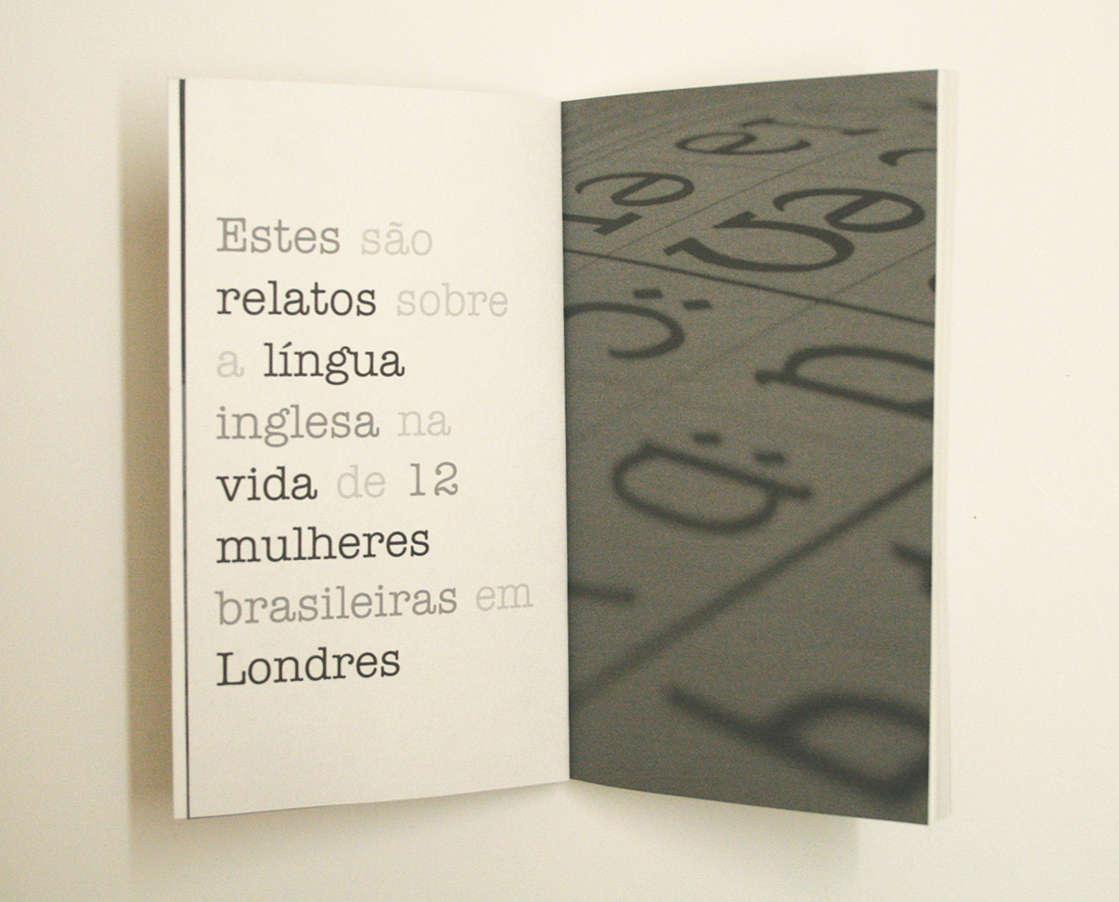
I employed the same print on demand services previously used for my own artists’ books. By making this new book, I traced the main stories about language as told in each interview. Each chapter offers a different collection of stories about English language in relation to distinct ages, class backgrounds, ethnicity, levels of proficiency in English, region of origin in Brazil, and period of permanence in London. The book, as a collection of stories, became a place where other people can access, know, and relate themselves with particular stories in specific ways. I noticed that making these stories accessible through the artist’s book format (rather than an academic article or report) aroused the interest of many people from different spheres, from university researchers to other Brazilian women living abroad who have no relation to the arts or the academy. I welcomed this positive response because one of my concerns as an artist, teacher and researcher is to circulate research results broadly and beyond academia.
Art practice | 183
Figure 81 Língua&Lugar: relatos, 2015-2016. Artist’s book, transcription of interviews, 20,3 x 12,6 cm, single edition.
As in any mapping process, I had to decide which stories should be framed and, consequently, which stories should be kept out of the book. Therefore, this publication is, of course, a result of my power of decision. However, I tried to keep myself in a more neutral position by taking a series of measures:
1) the interviewees were distributed in the book in the same order as the interviews; 2) I transcribed all the stories related to their experiences with language and, after this, I left out only those ones that were repeating. The criterion for deciding which I should keep was based on the clarity of their oral account in relation to the same topic; 3) I distributed the stories in the book with specific target audiences in mind: the participants themselves, other Brazilian women whom I met in London and were struggling to learn English, other researchers investigating the Brazilian community in the UK, and those community centres that give support to members of this community.

Art practice | 184
Figure 82 Língua&Lugar: relatos, 2015-2016. Artist’s book, transcription of interviews, 20,3 x 12,6 cm, single edition.
Considering Sandino’s notion of oral history in the arts as a source of elements and operations that might create collaborative engagements within social and relational practices (Sandino and Partington, 2013), in this practicebased research I see the interviews not only as a qualitative method for collecting data, but also as a dialogical practice that builds a bridge between the individual and the collective dimensions of my work
3.2.2 Diary as continuation of a conversation
At the end of each interview, I offered each participant a diary that I had previously prepared and printed out. This diary worked as a strategy to keep the interviewees thinking about ‘language and place’ until our next meeting in the convivial place, a few months later. It contains pages to be filled out and is divided into two parts. The first part is activated by a sentence that gives direction to the writing process: ‘These are stories about English language in my life in London’ (Figure 83). Then, in the final part, there is a question: ‘Which stories do I keep in the words I collect?’ (Figure 84). This question is followed by seven pages containing columns to be filled out with words, in English and in Portuguese, according to specific feelings and uses: words in English that I love, that oppress me, that I use the most, words of my life story, and words I need the most. In Portuguese, there is space for writing ‘words I miss the most’ and ‘words I keep using daily.’
Art practice | 185
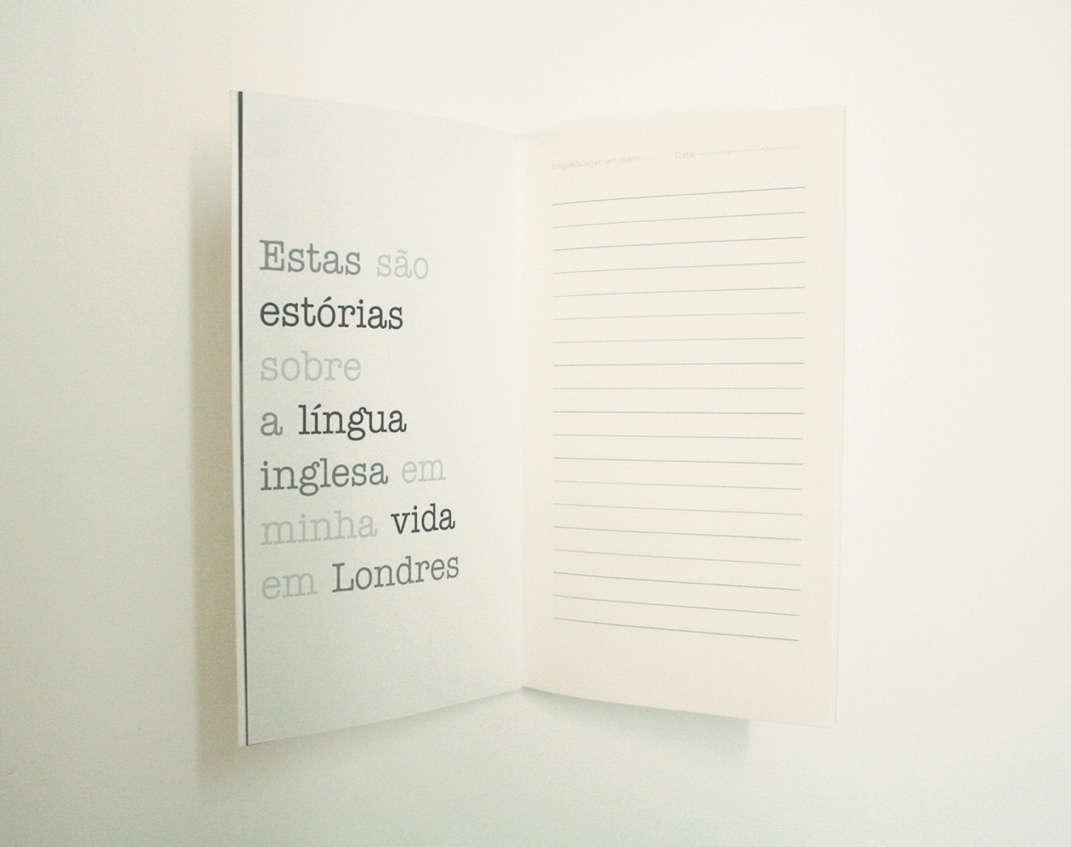

26 In Portuguese, it is not common to make a distinction between the words ‘history’ and ‘story’ We use preferably ‘história’ for both meanings. However, as I grounded this research in Doreen Massey’s approach to place and she defines place also as a ‘multiplicity of stories’ I decided to keep the literal translation from ‘story’ into ‘estória’ instead of using ‘história’ in the diary.
Art practice | 186
Figure 83 Língua&Lugar: um diário, 2014, 20,3 x 12,6 cm, single edition.26
Figure 84 Língua&Lugar: um diário, 2014, 20,3 x 12,6 cm, single edition.
I assured participants that the contents of the diary would be private, and all of them were relieved to hear this. I told them that they were free to decide what information and stories they should disclose during our future encounters. This strategy worked well and during the transition from the interview to the convivial place some of the participants kept sending messages by email and social networks in order to share the pleasure of filling out the diary.
Two of the participants mentioned that they thought they had nothing to tell about language, but when they started to write, many stories came up. Two other participants showed an interest in continuing to write about their life experiences independently of the purposes of the research, since they found their own stories really interesting. They demonstrate that the diary helped them to dig out forgotten stories and made their feelings related to learning a new language clearer. Moreover, only two participants were involved with writing practice: one of them keeps a diary about her past experience with cancer, and another one writes poems. Two other participants who did not practice writing even bought notebooks to continue their writing.
Diaries are commonly used as an assessment method in education as well as in health research. In this practice-based research, the diary kept working as an intimate place for disclosing experiences with English language and, at the same time, worked as a connection between the participants and me. Ira Progoff (1987) affirms that an oriented and habitual writing practice can become an instrument and method to nurture individual growth, establishing and strengthening the integrity of the individual. The diary can offer possibilities to develop an extending life experience method because its content can reflect important aspects of a life in motion connected to the present, past and future. He also affirms that when the emphasis of writing is not in the life event per se, but in the relationship between the person and the life event, it becomes a tool for self-development and awareness, furthering feelings of self-integrity. I would say more: if this relationship between the person and the life event is registered critically, the diary can
Art practice | 187
become a valuable tool for decolonization of the self. Progoff argues that the midpoint between past and future ‘is an open moment of possibility’ (1987, p. 14), and the diary can work as a self-location exercise, i.e. offering a territory for a practice that seeks to identify locations (points of origination), planning directions (routes of dispersion) and taking action (delinking).
In this stage of this research, the diary worked as a presence kept at a distance, which respected the intimacy of each participant, built trust and strengthened their critical reflection about not only the theme but also about themselves The positive response to this proposal produced a durational aspect connecting researcher and participants. In this way, in the context of the art practice research model that I present in this thesis, I may say that while the interviews stablished a starting point for a conversation and worked as a bridge between individual and collective spheres of the art practice, the diary (which I also filled out) strengthened relationships, built trust among researcher and participants, and culminated in the convivial place where we met later to continue this conversation in person and write life narratives through art practice.
Art practice | 188
3.2.2 Homeplace
Once I finished conducting all twelve interviews, I started to seek a physical space where we could practice writing-making processes in group. After checking with the participants in which part of the city it would be better to have our meetings in, and considering my budget, I rented a residential flat in Tulse Hill, South London, from 8th April to 8th May 2015. This would become our temporary convivial place (Figure 85).
Working in a residential place rather than in an institutional space was a conscious decision. I wanted to provide a safe space where we, as a group of immigrant women with diverse backgrounds and trajectories, could come and stay without having to ask for any kind of permission. Additionally, I wanted to offer an unmonitored place where we could speak in our own language without any further concern, where they could bring children and pets if necessary, spend the night and feel free to occupy all the spaces as they wanted. Above all, I wanted to offer a space where we could hopefully feel at home at the end of the process and even miss it in the future (Figure 86).
While I designed this part of the research, Virginia Woolf kept reverberating in my mind: ‘A woman must have money and a room of her own if she is to write fiction’ (Woolf, 2004, p. 4). I also remembered the beautiful passages in Marguerite Duras’s book about the relationship between her writing and the house she bought: ‘This house became the house of writing,’ she tells, ‘my books come from this house’ (Duras, 2011, p. 5). She writes, ‘I finally had a house in which I could hide in order to write books’ (Duras, 2011, p. 7). Then, I revisited Carolina Maria de Jesus’s diary and focused specifically on the passages where she mentions her housing conditions, ‘Se eu pudesse mudar desta favela! Tenho a impressão que estou no inferno’ (Jesus, 2005, p. 24), i.e. ‘Oh, if I could move out of this favela! I feel like I’m in hell!’ (Jesus, 2003, p. 19); and ‘Cheguei na favela: eu não acho geito de dizer cheguei em casa. Casa é casa. Barracão é barracão’ (Jesus, 2005, p. 42), which translates as, ‘I
Art practice | 189
arrived in the favela: I don’t think I can say I arrived in my house. A house is a house. A shack is a shack’ (Jesus, 2003, p. 40).
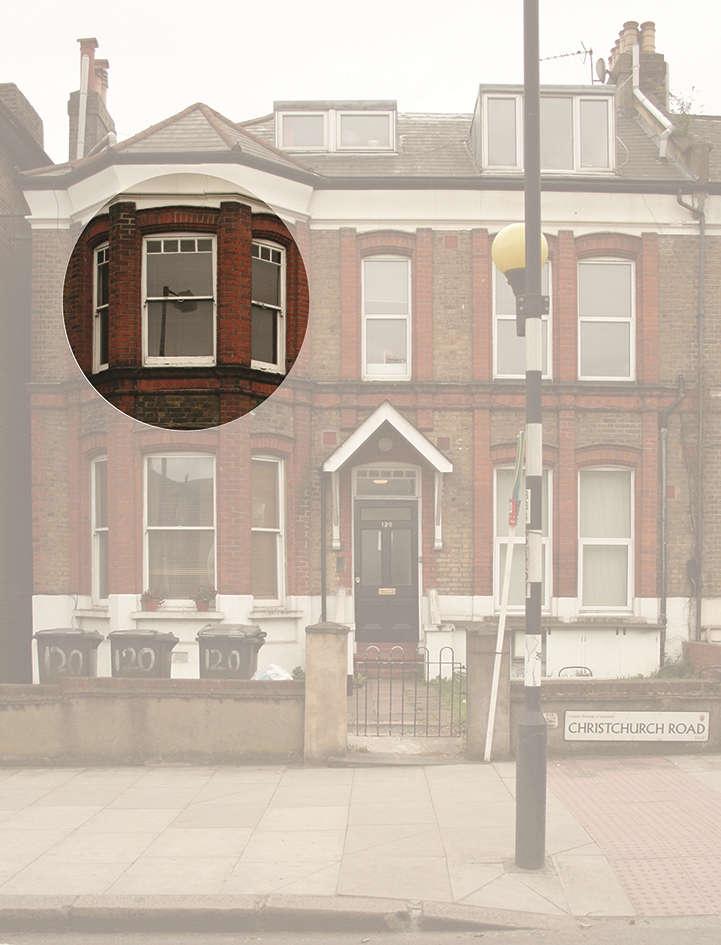
Art practice | 190
Figure 85 Homeplace, South London, 2015. Convivial place where collective activities and writingmaking processes were developed together with twelve Brazilian women who live in London.
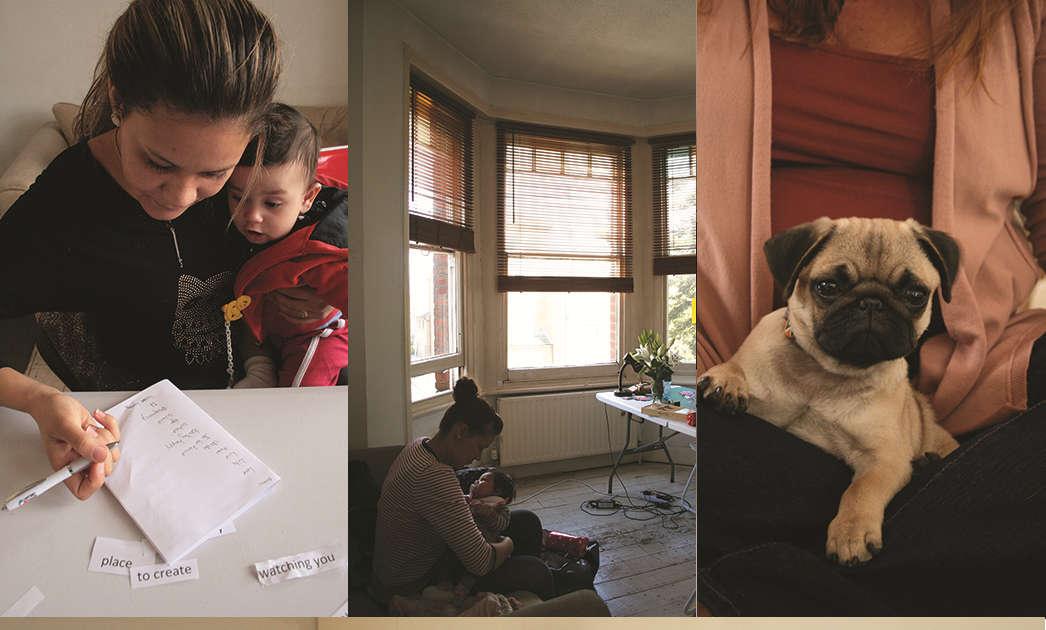

The disparity of class, ethnicity, geopolitical and cultural backgrounds among Woolf, Duras, and Carolina kept resonating loudly while I thought about the importance of the place where one comes to live as well as the challenges faced by many immigrant women in relation to housing in the host country.
During the interviews, for instance, one of the women mentioned that she did not feel comfortable in her own home because it was shared with many men:
Em casa eu sentia muita pressão. Os homens, eles viviam no mundo deles, e os sotaques deles, eu não conseguia acessar
Art practice | 191
Figure 86 Homeplace, South London, 2015. Participants inhabiting the convivial place
aquilo, não só pela língua, mas culturalmente. (…) Eu ficava me cobrando daquilo, ‘mas eu não me sinto à vontade na minha casa, um bando de gente, eu vou pra cozinha, não vou pra cozinha, vou ficar aqui em cima, não vou cozinhar porque tem gente na cozinha’, sabe? (GU, seis anos em Londres)
I felt too pressured at home. The men, they lived in their own world, and their accents, I did not have access to that, not only because of the language, but culturally. (…) I blamed myself, ‘I don’t feel comfortable at my own house, a lot of people, I go to the kitchen or don’t go to the kitchen, I will stay here, I will not cook because there are people in the kitchen’, you know? (GU, six years in London, my translation).
This woman tells how she always had to think twice before going out of her room in a house with six bedrooms. She confesses that when she went to the streets she would become more calm, ‘Quando eu ia para a rua eu ficava mais tranquila’ . If there was someone in the communal spaces of her house she would choose not to go outside her room.
Therefore, my intention when I proposed to work in a domestic space was to provide a place that could offer respite from oppressive environments and relationships mediated by competition, productivity, speed, spectacle, and so on. I wanted this convivial place to be, even temporarily, a place of rexistência (see sections 1.2 and 3.1.5) Making a homeplace, as bell hooks argues in the context of the histories of black women, has a radical political dimension because it becomes the place where ‘one could freely confront the issue of humanization, where one could resist’ (hooks, 1990, p. 42). In this way, hooks reconsiders the previous negative connotation given to ‘home’ or ‘house’ by second-wave feminists, and acknowledge that ‘domestic space has been a crucial site for organising, for forming political solidarity’ for black women (hooks, 1990, p. 47).
In the context of immigration, homeplace plays an important role in people’s lives and offer a place where women can share hooks’s feelings: ‘Oh! That feeling of safety, of arrival, of homecoming’ (hooks, 1990, p. 41). When I arrived in London, I inaugurated the shed in the garden as a workplace hoping
Art practice | 192
to convert it into a homeplace (section 3.1.1). However, it is my practice that became my homeplace, since I continue to move from one place into another. The practice is what I bring with me every time I arrive somewhere. In the collective dimension of my work, I hope it can become a place ‘where we return for renewal and self-discovery, where we can heal our wounds and become whole’ (hooks, 1990, p. 49), even if only for a moment. As a convivial tool (Illich, 1973), art can stimulate the creation of convivial places where people can build relationships, explore liberatory practices, enunciate counter-narratives, and create modes of freedom.
The following sections describe the activities developed together with the participants. The flat was rented for one month, but the group did not spend the whole month together, since they had their own routines and could not stay much longer than the pre-planned meetings, even though I stayed there full time for the entire period. I met each one of the four groups of three people once, when we stayed together for long periods lasting around six to nine hours per meeting. During this time, we exchanged knowledge, personal stories, and songs; we cooked and ate (in French, convives are people who eat together), laughed and wrote together. Some of them returned individually a few days later. For a few moments the flat became a homeplace
3.2.2.1 Collection of words
The words previously annotated in the respective diary of each participant (Figure 84) were shared in the groups. I had also filled out a diary and shared my collection of words too. Some of the participants brought their diaries but did not show them, while others decided to bring the words annotated on pieces of paper. During the meetings, we used post-it notes for hanging our words on the walls and on the mirror located in the living room (Figure 87). In this way, we could see the words together and start conversations about the reasons that led us to choose those words and not others, which meanings were implicit in them and which stories were possibly underneath.
Art practice | 193
As this first specific activity finished, I kept working on their preliminary results while inhabiting our homeplace. I wrote down the words we shared and produced a ‘word cloud’ for each collection of words we wrote in our diaries. Then, I shared the ‘word clouds’ with the participants by email and we kept exchanging impressions about the collective stories engendered by these sets of words. Later, as we noticed that there were stories implicit in these set of words, we decided to share them in our collective memoir (section 3.2.3)
The idea of stimulating the participants to build and reflect on specific sets of words departed from my experience of collecting words in the city (section 3.1.6). As I observed the potential of singular words to disclose feelings, thoughts, and stories about life experiences within displacement, I believed that this could be an indirect way to stimulate other women to access levels of consciousness about their own experience of displacement and dislocation in language. The relevant presence of words related to motherhood stresses one of the distinct characteristics of experiences of displacement lived by women: stories about language are surrounded by relationships and marriages, pregnancy, baby born, women’s health, school, and divorce. Only three of the twelve were not mothers at the time I conducted this research, and one of these three women was trying to have a baby (she is now a mother of twins). Apart from two participants who are not mothers yet, all the women constantly refer to their experiences of displacement in relation to their experiences as mothers.
Art practice | 194
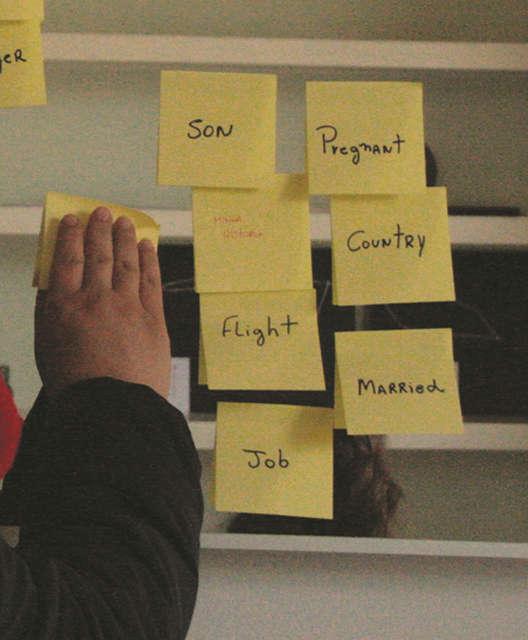
3.2.2.2 From no.where to now.here
This writing process departs from the postcards I previously developed (Figures 38 and 39). After offering two pieces of paper with the word ‘nowhere’ over a blank rectangle, we started a conversation about the experiences within displacement that might make one feel ‘no.where’ and ‘now.here ’ I asked them to write down what has the power capable of moving the blue dot forward or backward (Figure 88).
Art practice | 195
Figure 87 Collection of words, 2015. One of the participants displaying her words on the mirror of the living room of our homeplace.
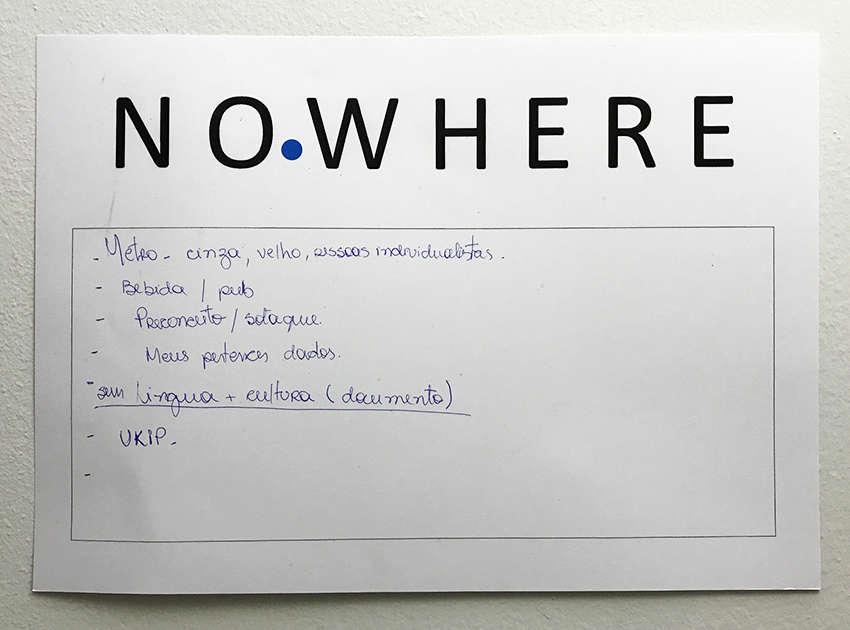
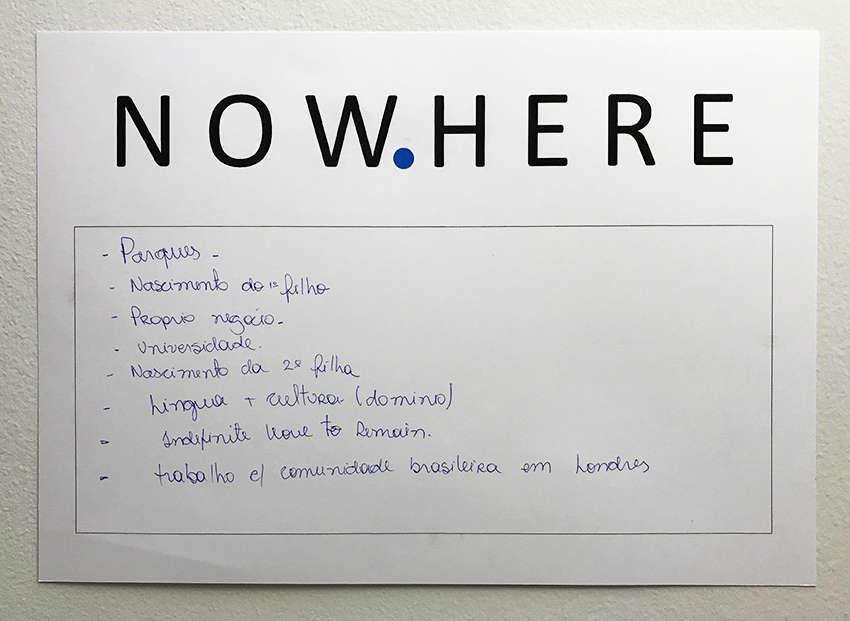
The participants kept speaking to each other, sharing stories about moving this dot while they wrote them on these pieces of paper. After this, the bits of writing were put together and resulted in two original pieces of writing about senses of place and feelings of ‘out-of-place’ (Figures 89 and 90). These images are part of the collective language memoir described in section 3.2.3.
Art practice | 196
Figure 88 From no.where to now.here, 2015, 21 x 29,7 cm.
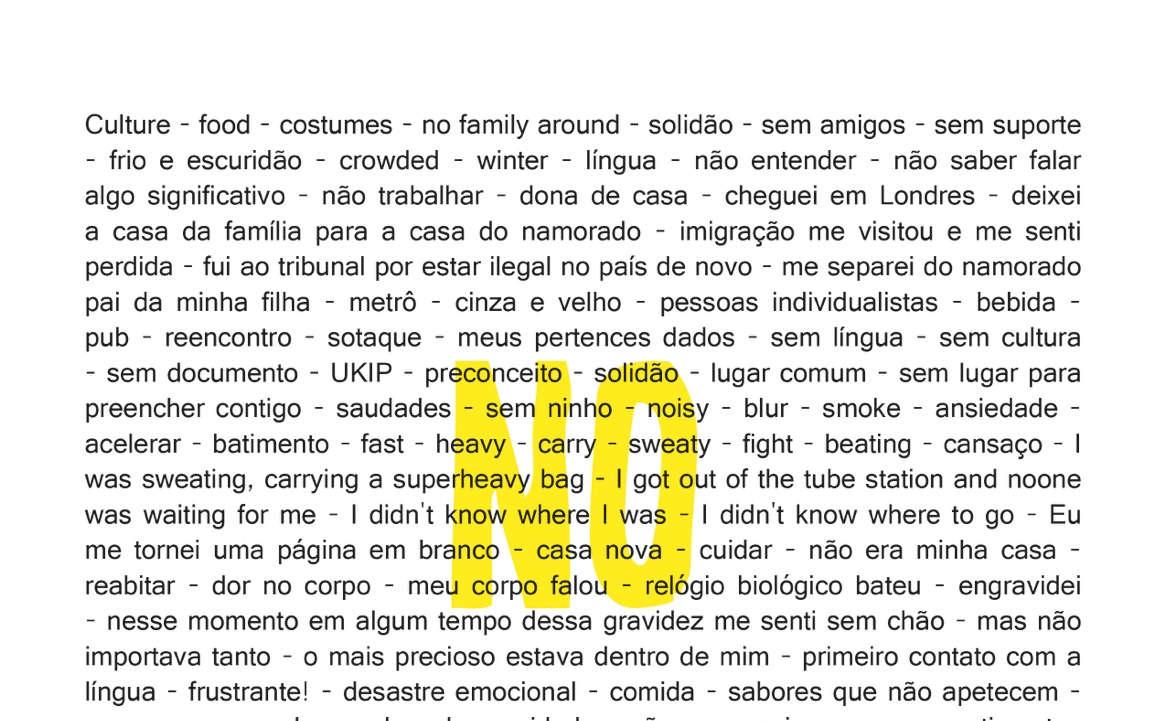
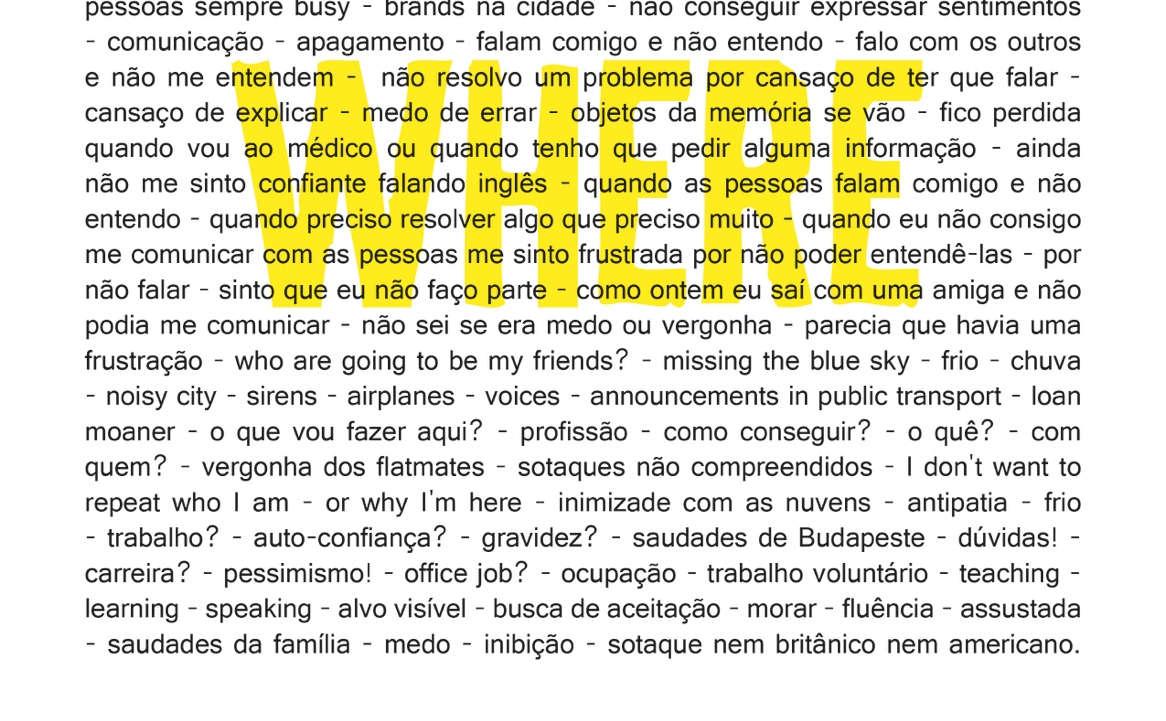
Art practice | 197
Figure 89 No.Where, 2015

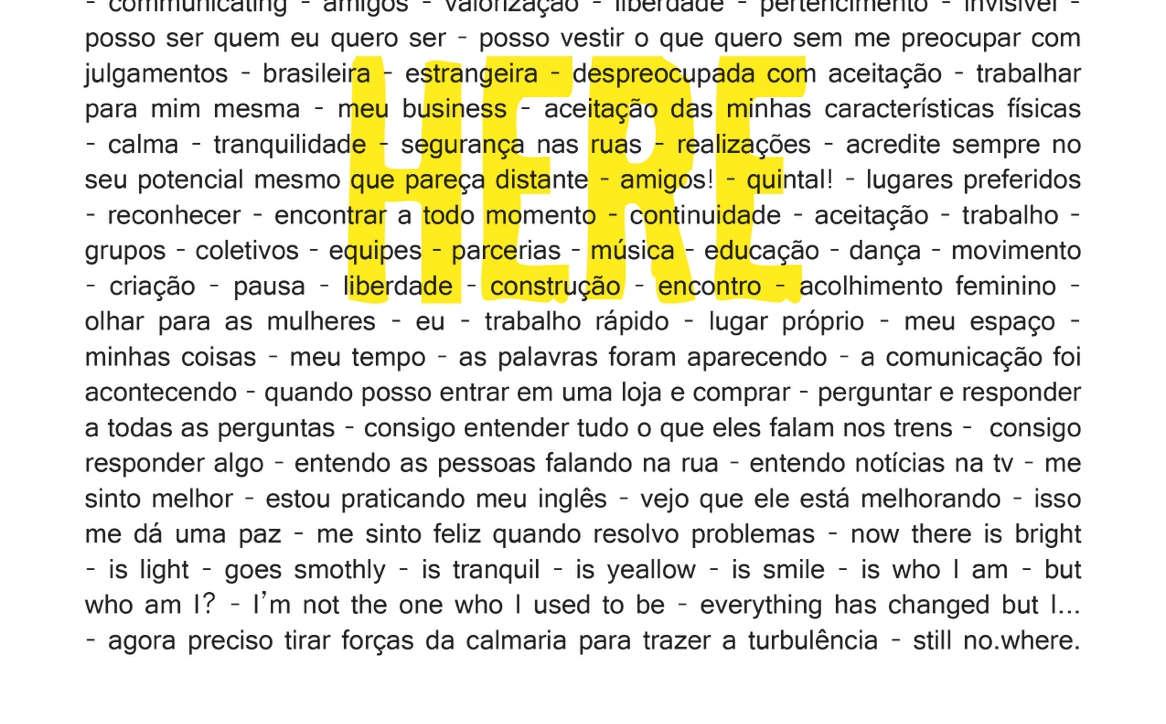
Art practice | 198
Figure 90 Now.Here, 2015
3.2.2.3
Writing life with words that aren’t mine
In this practice, I offered participants the exact same words I used to write my first memoir (section 3.1.6). I printed the words out, put them inside envelopes, and addressed them to each participant. Obviously, my intention was not to fill the participants’ minds with pre-conceived words (Freire, 2000). Rather, I wanted to propose a challenge about overcoming the place of muteness created by the encounter between languages and unknown words. I was curious to know what kind of strategies each participant would use to own those words in order to enunciate their narratives.
While they took the words out of the envelopes and tried to figure out where I had extracted them from (I did not give any clue), we had a conversation about the strategies one needs to create in order to express oneself using a limited vocabulary. Many other stories came up from the groups at this point, since they looked at some words and remembered places and specific episodes. After this initial conversation, they started to really concentrate on this activity, exploring, combining and cutting words in order to rebuild them to create narratives that could express their life stories (Figures 91 and 92).

Art practice | 199
Figure 91 Writing-making process, 2015
Those who were more familiar with English language transformed the words immediately by cutting and composing other words with pieces of syllables (Figure 93). On the other hand, those who knew the language less tried to write their stories without changing any word (Figure 94). Those who knew the language well started to adapt the words according to what they needed to express the stories they already had in mind, whereas others tended to adapt themselves to that limited vocabulary, communicating their thoughts in a more fragmented and hesitant way. I provided a dictionary to the groups, just in case some participants might feel more comfortable with that, but practically no one wanted to look at it.
As soon as each group produced their texts, we displayed them on the living room/kitchen’s cabinets, thereby making our homeplace a reading place, and gradually the house came to embody our narratives of language and place (Figure 92). Those who knew the language demonstrated a pro-active attitude in relation to promoting change in the words and making them more meaningful. It was possible to observe how powerful the act of transforming words is in order to enunciate one’s own world (Freire, 2011b). Knowing the language made them able to take decisions according to specific purposes. Paulo Freire argues that while animals adapt to the world, human beings want to humanize the world by transforming it, since ‘the human word is more than mere vocabulary – it is word-and-action’ (Freire, 2000, p. 20)
Art practice | 200
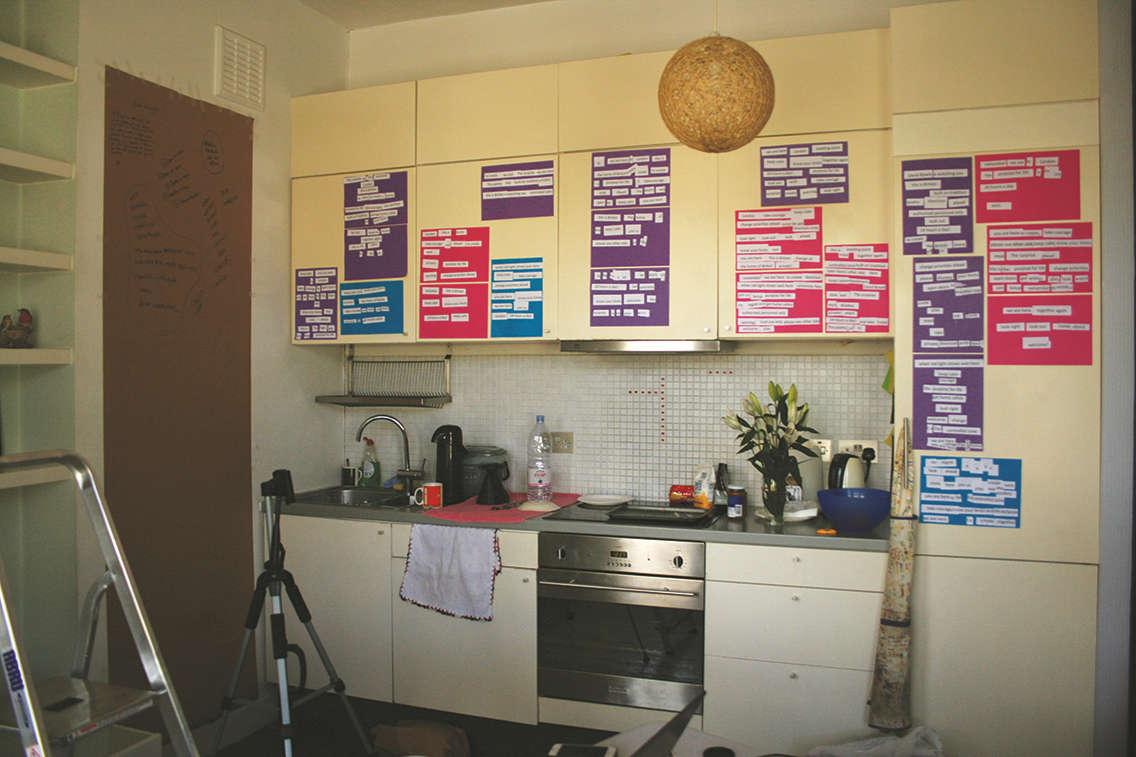
Art practice | 201
Figure 92 Homeplace as writing and reading place, 2015.
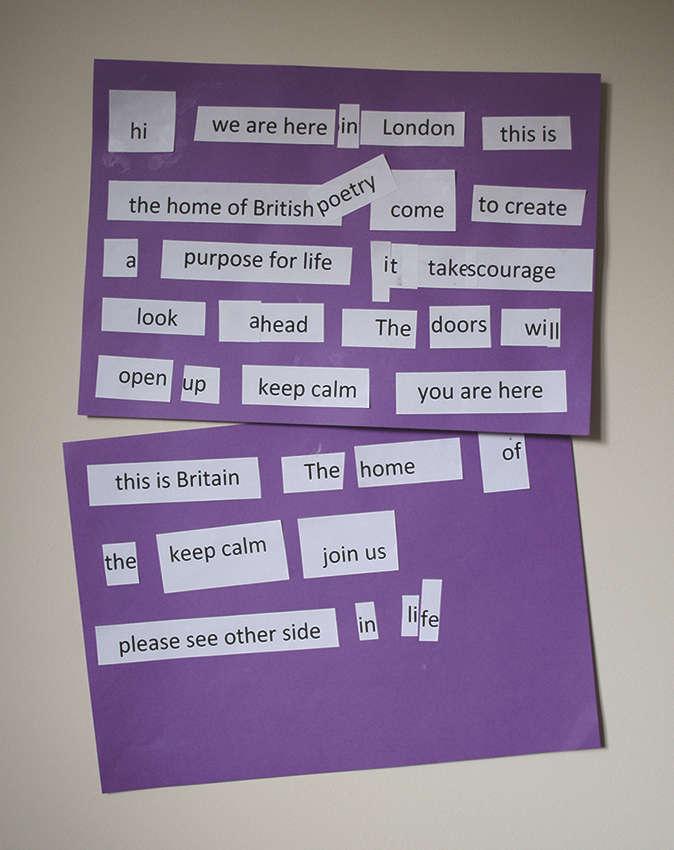
Art practice | 202
Figure 93 Writing-making, 2015
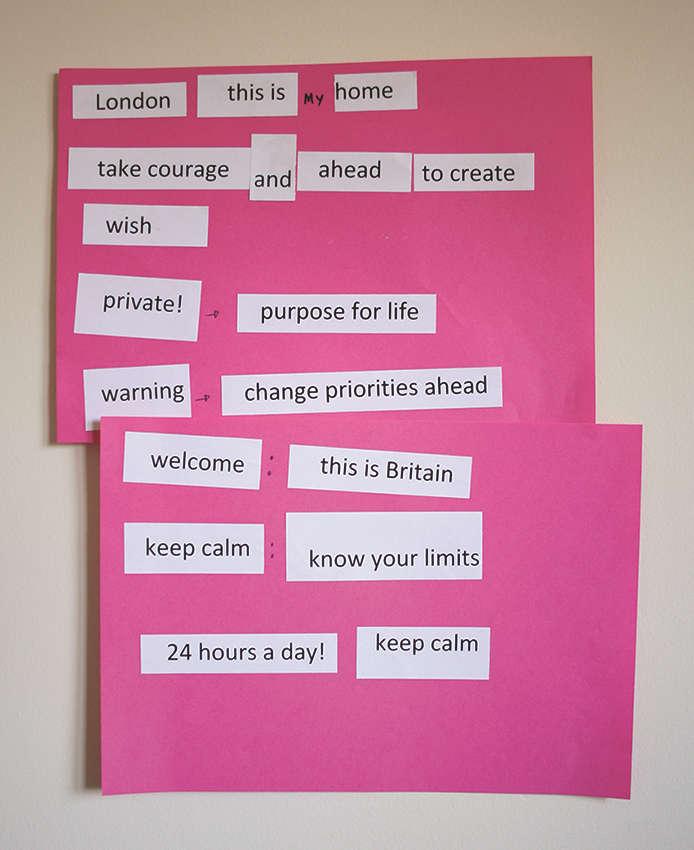
Art practice | 203
Figure 94 Writing-making, 2015
3.2.2.4 Network of places, collection of stories
Based on Yi-Fu Tuan’s notion of network of places (section 2.1.1.3) and Doreen Massey’s approach to place as a collection of stories (section 2.1.2.4), this time I proposed to the participants an exploration of their trajectories based on their relationship with English language. The white pin represents the starting point of their journey, while the red ones symbolise meaningful experiences lived in space. The thread represents the movement in space over time, i.e. between the pins there is a temporal estimate (Figure 95). Each pin marks a story and, hence, the final drawing represents the space of their experience with English language and offers a map of the multiplicity of stories on language that delineate their life trajectories until now, or based on Doreen Massey’s (2005) expression, ‘stories-so-far.’ Each map offers the narrative of a specific journey, containing pauses, loops, high and low points, double lines, curves, angles. The final drawing indicates a spatialized narrative that each participant presented to the others (Figure 96).
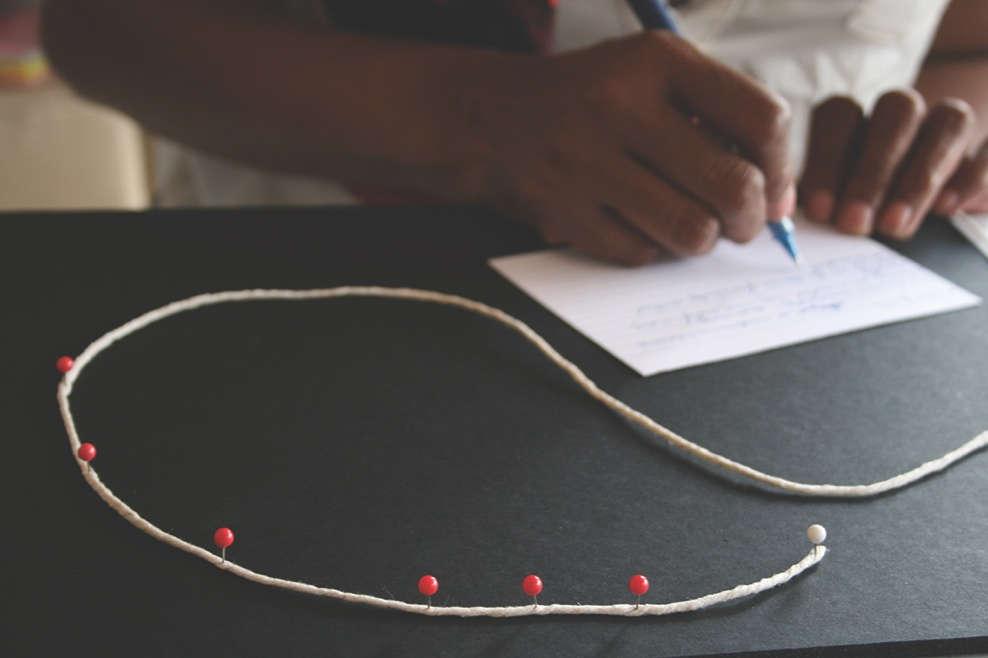
Art practice | 204
Figure 95 Spatialized narrative, 2015
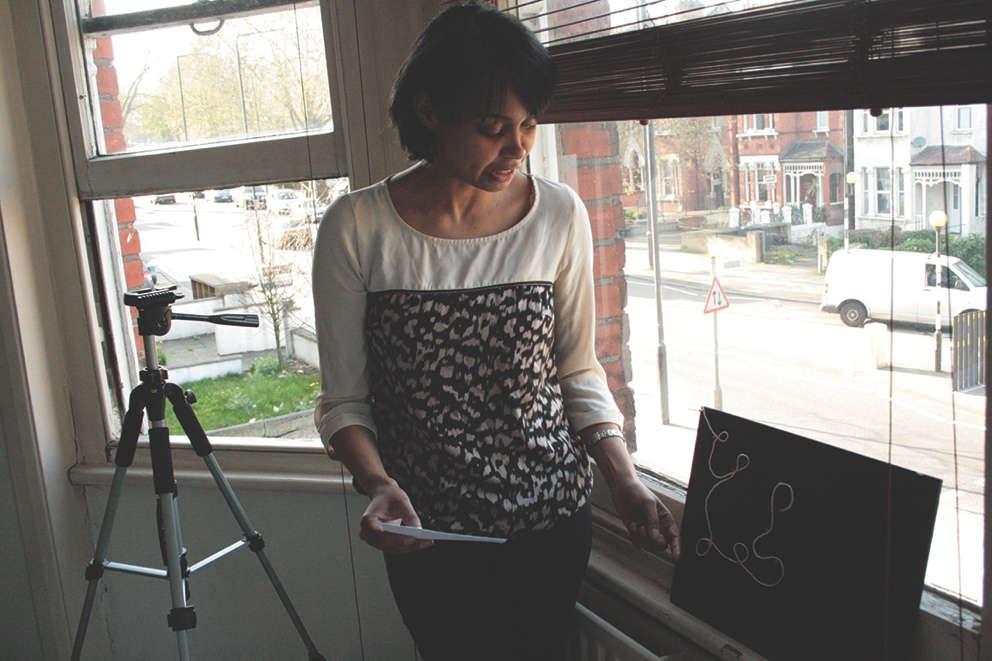
3.2.3 Collective Language Memoir
The collective language memoir (Figures 97, 98 and 99) is a publication resulting from the texts and images produced during the encounters with the participants in the homeplace I designed this book using InDesign, while always staying in contact with the participants by email or in person After the end of the collective project, we stayed in contact in order to exchange further ideas, drafts and suggestions about this publication Some of the participants mentioned that spending those moments together inside the flat for sharing experiences, eating and laughing together, reflecting and making things, became pleasurable and comforting experiences and they wished that other people could experience these kinds of activities. Writing collaboratively about sensitive topics opened a space for dialogue and helped the groups to build solidarity, overcome shame of not-knowing, regain confidence through the discovery of self and others. As Chang et al. (2013) argue, collaborative writing processes can empower collective voices and build community and, at the same time, become a journey in personal empowerment.
Art practice | 205
Figure 96 Sharing the spatialized narrative, 2015

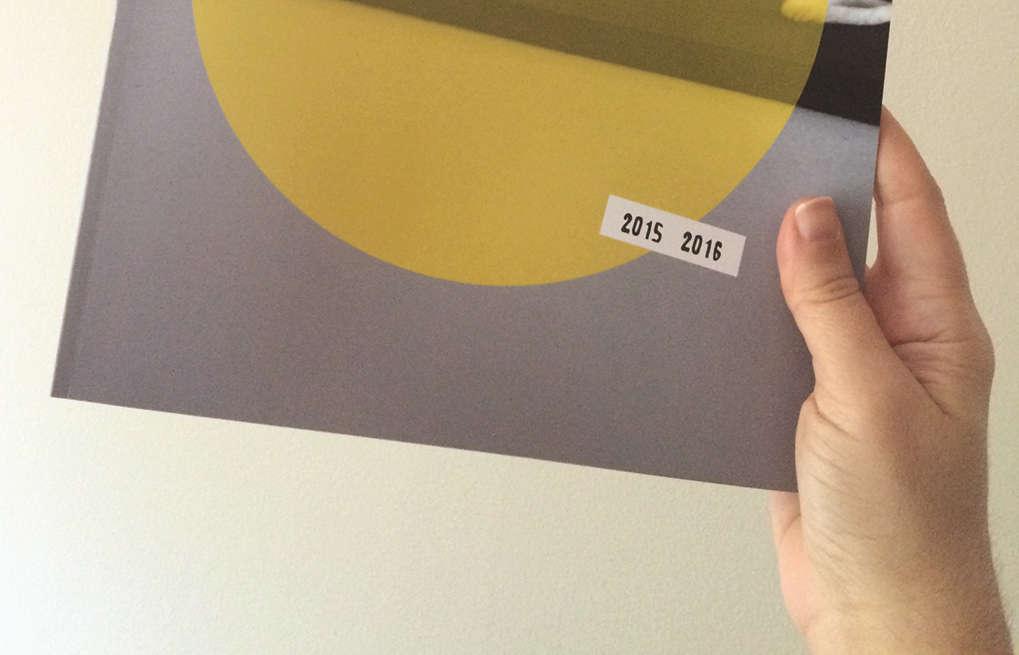
Art practice | 206
Figure 97 Collective language memoir, 2015-2016, 28 x 21,5, single edition.
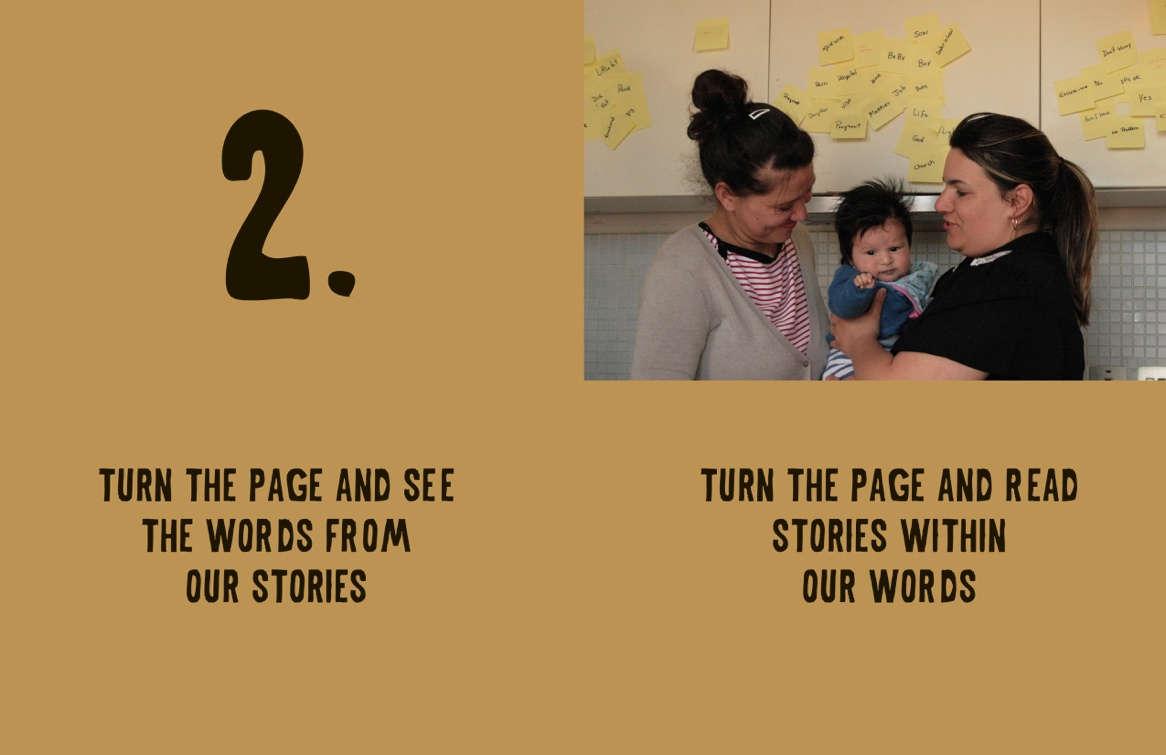

Art practice | 207
Figure 98 Collective language memoir, 2015-2016, 28 x 21,5, single edition.
Figure 99 Collective language memoir, 2015-2016, 28 x 21,5, single edition.
The following section is dedicated to showing the secondary findings of this research.
3.2.4 Unfolded stories
In this section, I present the works created individually and/or in new group arrangements by me and by some of the participants as ways to narrate stories differently, as complementary practice. These are therefore spontaneous creative responses to the processes experienced at the beginning of our convivial experience in the homeplace.
3.2.4.1 The bilingual sweet
One of the participants, Ane Viana, created a sweet based on her own experiences of displacement (Figure 100). She was born in Bahia, Brazil, moved first to Portugal, where she lived for many years, and then to the UK. In London, she discovered she had cancer and struggled for her life. She was cured, and English language was an enormous challenge while she faced her illness. This sweet embodies all these stories through the ingredients used in its recipe. The name of the sweet is ‘taste of life.’ It represents both languages, Portuguese and English. The side of Portuguese language is represented by elements, one from Brazil, coconut, and another from Portugal, egg candies. In this sweet, the coconut embraces the egg candy, symbolizing the warm Brazilian hug. On the top, as a coronation, she finishes it off with a walnut painted with gold, which refers to the glamour of London, but also to her cure.
Ane went twice to the homeplace first to participate in the group activities, and then to make the sweet. On this day, we had the help of another participant, Joselita Padilha. Joselita and I assisted Ane in her creation, and the sweet became an important outcome in the whole context. When we opened the flat for external visitors for only two days, we offered these sweets inside handmade boxes as a welcome gift (Figures 101 and 102).
Art practice | 208
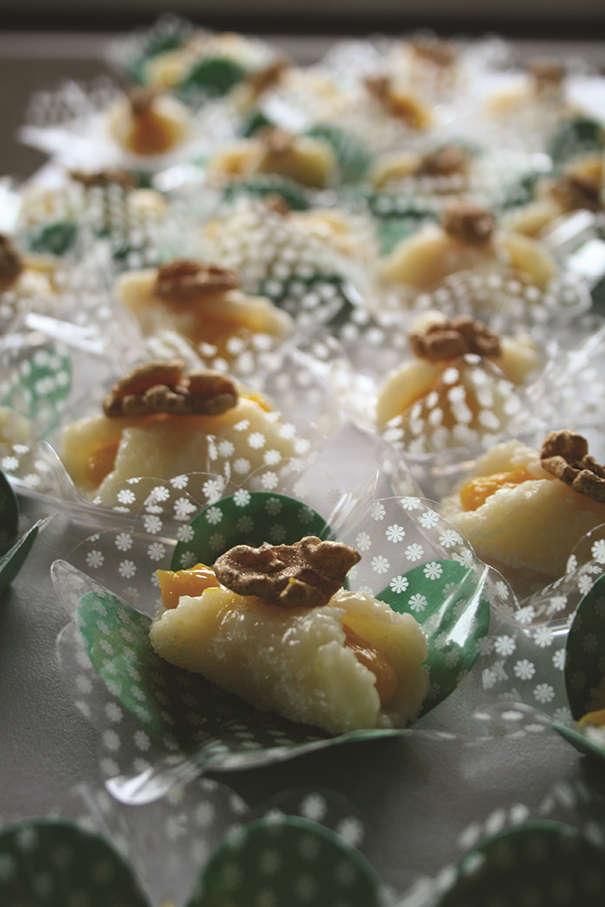
Art practice | 209
Figure 100 Taste of Life, 2015. Bilingual sweet by Ane Viana. Photograph by Manoela Afonso.

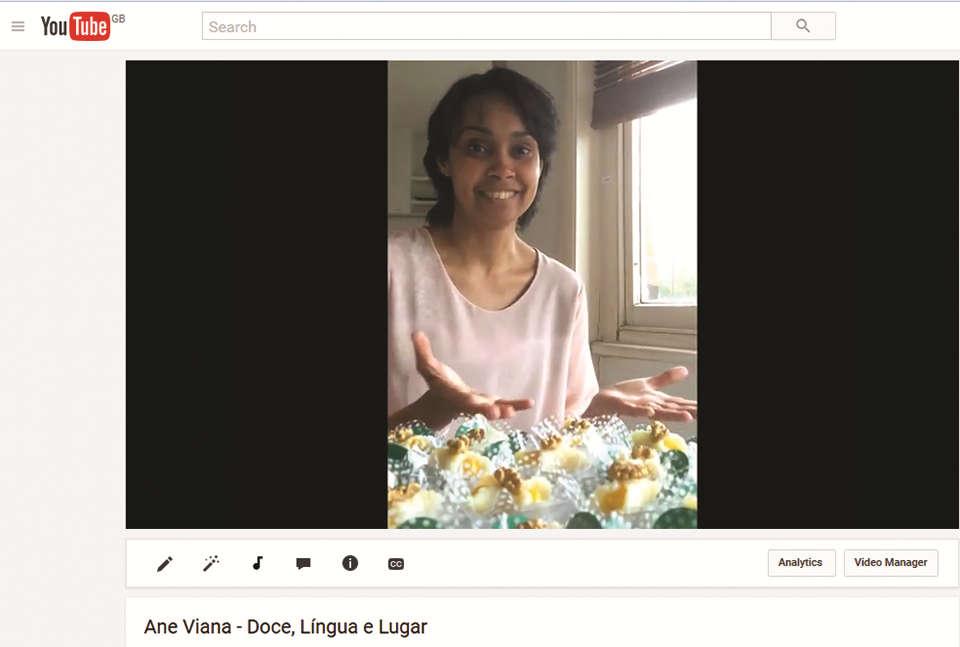
Art practice | 210
Figure 101 Language and Place, 2015, by Ane Viana, Joselita Padilha and Manoela Afonso. Boxes for the bilingual sweet. Photograph by Manoela Afonso.
Figure 102 Bilingual sweet’s story, 2015, by Ane Viana Video available at https://www.youtube.com/watch?v=Jqg4R9yY7Tk
3.2.4.2 Music in the trajectories
Alba Cabral studies music. She proposed and created instrumental music based on the trajectories of the women of her group. This became a project that has been further developed, independently of the research project, and we intend to produce songs for all the trajectories created during the meetings.
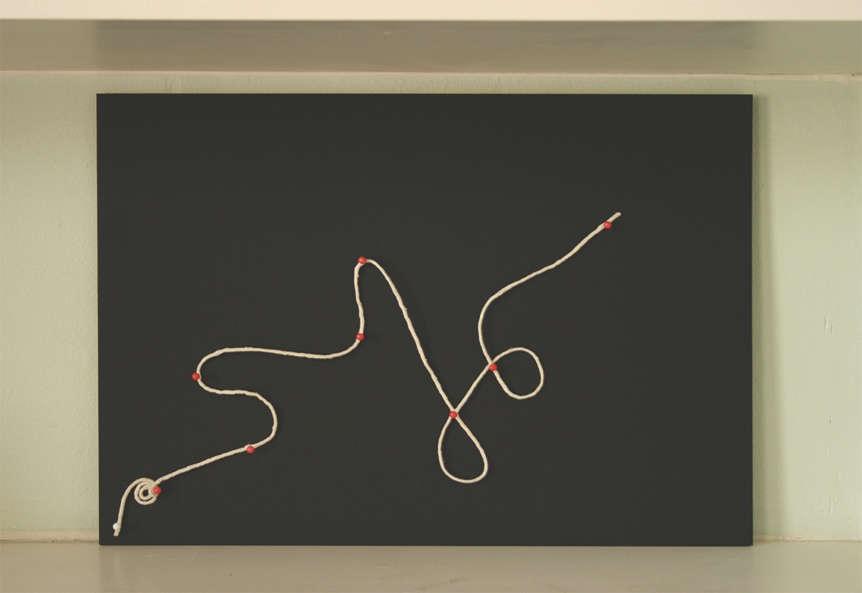

Art practice | 211
Figure 103 Alba’s sound map, 2015 by Alba Cabral. Photograph by Manoela Afonso. Available at https://soundcloud.com/manoanjosafonso/sets/sound-maps
Figure 104 Cristiane’s sound map, 2015, by Alba Cabral. Photograph by Manoela Afonso. Available at https://soundcloud.com/manoanjosafonso/sets/sound-maps
3.2.4.3 Website
www.linguaelugar.com
Jamile Kollar, one of the participants of this research, and I developed a website called Língua e Lugar after a series of conversations we started even before our engagement inside the homeplace. The objective of the website is to be a repository of stories about language and place in the lives of Brazilian women who live worldwide. Currently, the website has already received stories from Canada, the USA, Portugal, the United Kingdom and Germany (Figure 105)
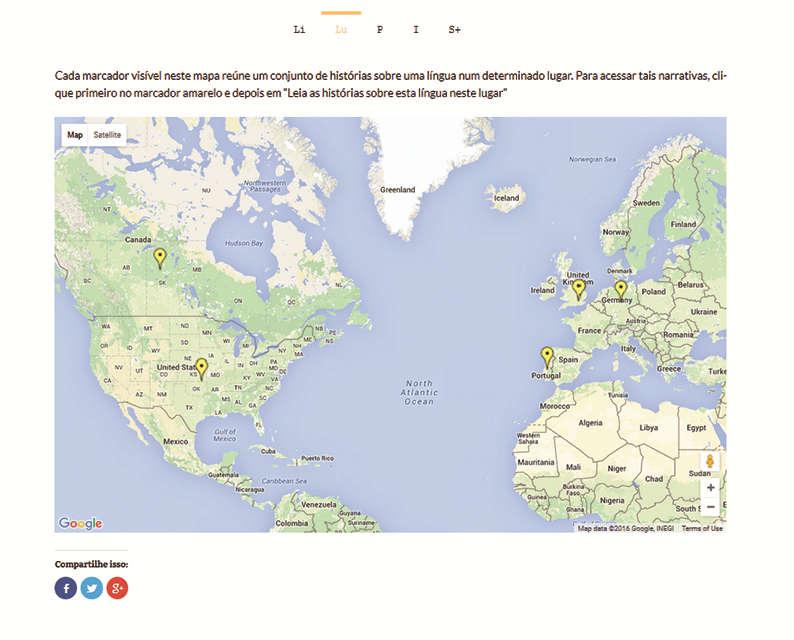
Art practice | 212
Figure 105 Website Língua e Lugar, 2015, by Jamile Kollar and Manoela Afonso Available at www.linguaelugar.com
3.2.4.4 Crossing the bridge again
The moments I spent alone in our convivial place led me to another set of individual practices involving photography, drawing, writing and diary. I took daily notes during one month about perceptions on the experiences lived inside that place (Figure 106).

Art practice | 213
Figure 106 Homeplace diary, 2015.
In parallel, I used one of the analogue cameras that belonged to my father to register one photo a day from the same point of view, except for the last day when I was leaving and registered my image in the mirror of the living room (Figure 107).
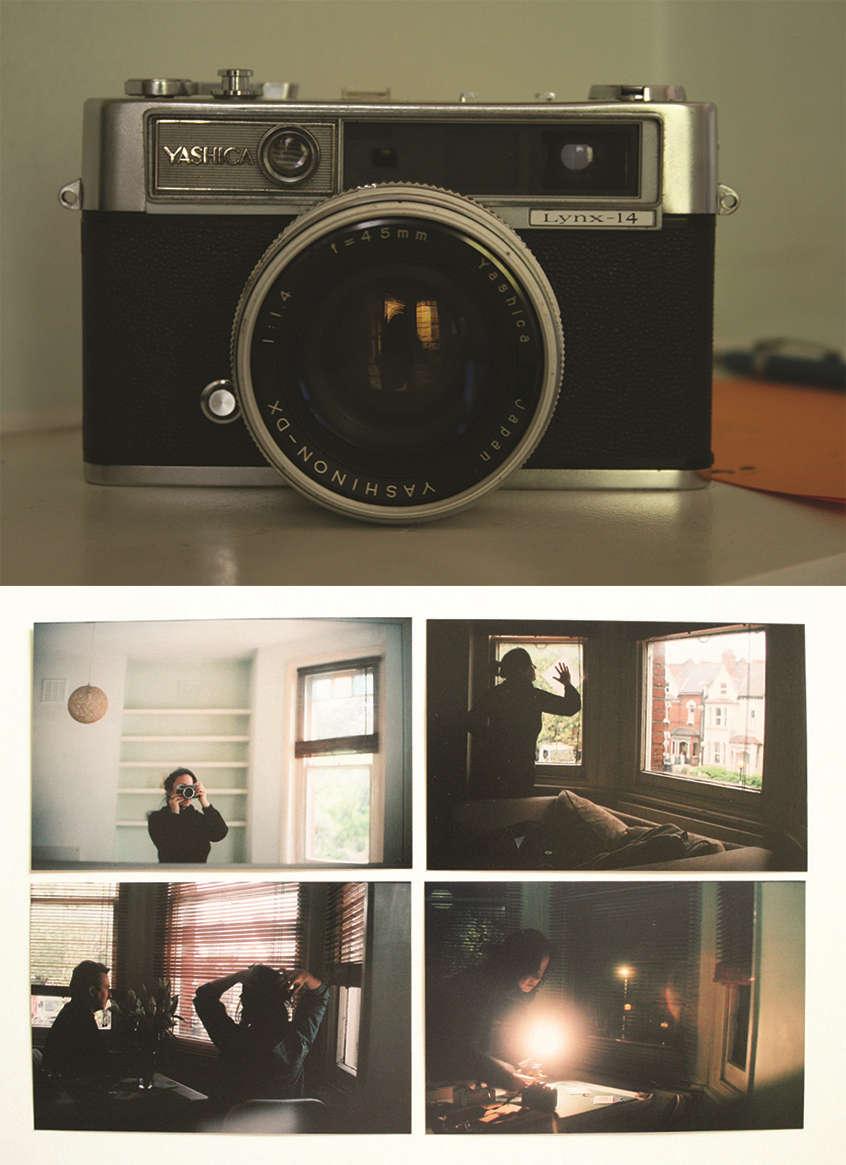
Art practice | 214
Figure 107 Homeplace photo-diary, 2015
I also spent time measuring and drawing the space, in order to know it better, to own it and start to feel home there (Figure 108).
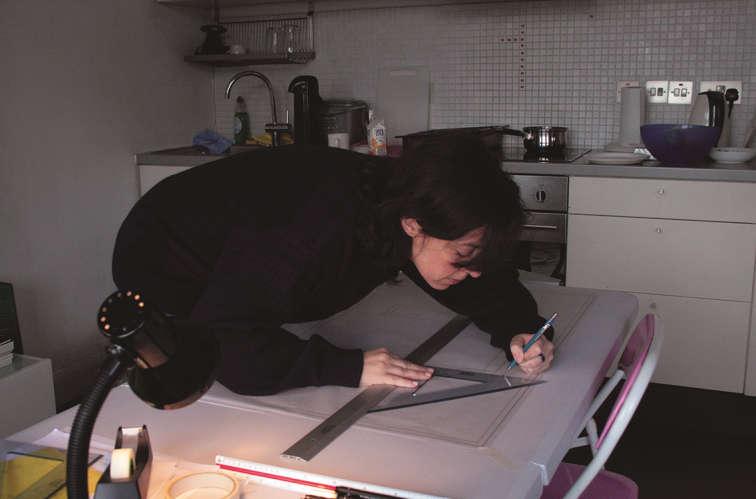
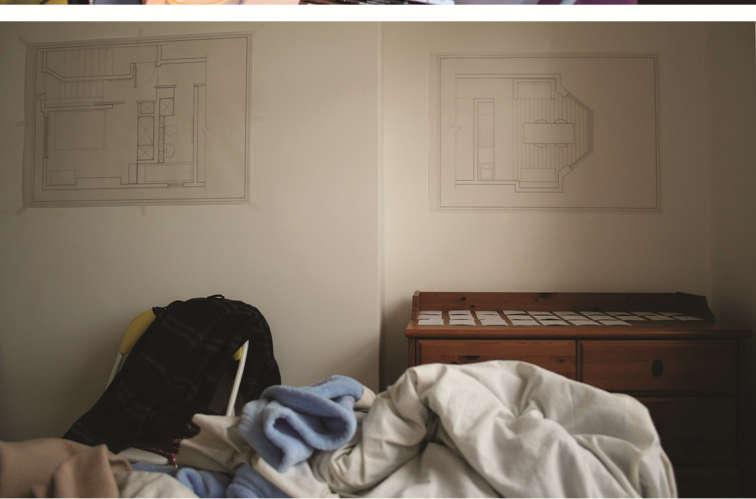
These processes have stimulated new developments that have overflown the frames previously defined for my practice in this thesis. However, I brought them to the end of this chapter to highlight the open-ended characteristic of the space of my art practice, which I further detail and map in the following part of this document.
Art practice | 215
Figure 108 Measuring, drawing, inhabiting, 2015
4 – Mapping traces for tracing a map
My interest in maps comes from an event in my childhood, when I was about ten. I was doing my homework, which consisted of drawing a map I do not remember which map it was, but remember well that I was copying it from an encyclopedia using a carbon copy sheet. I did not like geography because it was like studying English, i.e. there was no connection between the classes and my daily life. However, I was enjoying the homework because I always loved drawing and painting. Suddenly, my father stopped beside me, looked at what I was doing, pointed out some areas of the map and said: I have been here, here, and here. And how about you? You are drawing this map but know nothing about these places. This comment touched me profoundly because I understood the difference between drawing a map and living the map. I believe that my passion for geography started with my father’s comment, which challenged me and made me understand the importance of connecting practice and life. From this day, I committed myself to knowing the places represented on maps instead of just memorising the information available on them. More than that, I decided that I should live the places in order to produce my own maps and narratives and, then, propose other geographies. Lippard affirms that ‘a map is a composite of places’ (1997, p. 82) and ‘for the map-lover, maps are about visualizing the places you’ve never been and recalling the ones you have been to’ (1997, p. 77).
In this research, I use a mapping practice to identify the traces left by my own art practice (Figure 109). This is the way I found to visualize the movements I took from one place to another not only in physical space, but also in the spaces of theory and practice Moreover, I take narrative as place, i.e. narrative as a singular and temporary collection of stories articulated through art practice. Narrative becomes, then, a temporary articulation created within displacement for exploring points of origination, routes of dispersion, and for raising an immigrant consciousness. Thus, the map proposed here is not only
Ma pping practice | 216
a visual articulation of places-narratives, but becomes a place-narrative itself, which highlights the trajectories built along this practice-based research towards the decolonial self.
If geography offers conceptual elements to draw models of location, unfold a theory of cognition, a system of classification, and a site of collective histories (Rogoff, 2006), I argue that the visual articulation of my art practice through mapping offers not only a view on a methodological approach and research structure, but also brings to light the decolonial auto- bio- geographical narratives engendered by a practice that was activated by experiences of geographical displacement and dislocation in language.
As geography plays a role in the determination of identity and belonging (Rogoff, 2006), and constitutes a path for self-discovery (Tuan, 1999), the map might reveal the traces of change in subjectivity and of re-articulations of identity that are relevant to understand a series of becoming decolonial processes. As Minh-ha (1994) posits it, identity becomes then a politics rather than an inherited marking, just like the map of my practice.
4.1 Routes of dispersion
In this section, I present the map of the trajectories built during this research, its unfoldings and results. This map is part of the results of this thesis as a methodological approach built along my entire research process, compiling the previous results and showing the rationale behind the practice-based research model proposed in the thesis. It is important to stress that this map is an open articulation, since the space of my practice is a product of ‘loose ends and ongoing stories,’ i.e. it is a ‘dynamic simultaneity, constantly disconnected by new arrivals, constantly waiting to be determined (and therefore always undetermined) by the construction of new relations’ (Massey, 2005, p. 107). In this way, my practice and its map are in process because ‘there are always connections yet to be made, juxtapositions yet to
Ma pping practice | 217
flower into interaction, or not, potential links which may never be established’ (Massey, 2014, p. 107, italics in original).
The point of departure for reading the map of my practice (Figure 109) is represented by ED (experience of dislocation), which refers to my arrival in London and the place of muteness created by the clash between Portuguese and English languages. Then, I responded to muteness and to the new life in London through my practice (AP – art practice), which consists of writing life narratives through practices in visual arts inspired by life writing genres of diary, language memoir and postcards. These practices originated a series of artworks (AW – artworks) that embed stories about experiences of geographical displacement and dislocation in language. Therefore, making these artworks led me to be aware of and confront coloniality of power (CCP – confrontation of coloniality of power).
Thus, located in the individual zone of my practice (IZ – individual zone), I developed methods (M – methods) for investigating the impact of English language in the life of other Brazilian women living in London (G – group). Through these methods, I created other practices (WP – writing practices) for stimulating the participants writing about language and place in relation to their personal experiences in London. However, first I should be able to build a favourable environment to bring these practices into the group in a dialogical, stimulating, and horizontal way. Together, semi-structured interviews (I – interviews) and diary (D – diary) functioned as a bridge (BZ –bridge zone) between the individual (IZ) and collective zones (CZ – collective zone) of my practice, contributing to strengthening my relationship with the participants. This process culminated in a convivial place (H – homeplace) where I used the methods and writing processes created previously to explore stories on language and place in our lives.
Ma pping practice | 218

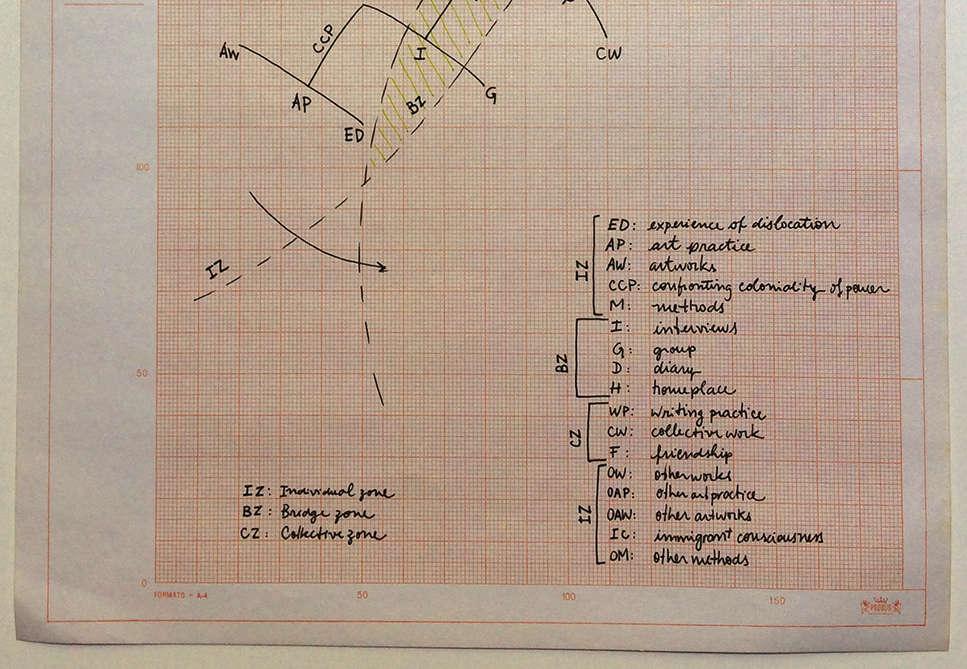
Ma pping practice | 219
Figure 109 Map of an art practice unfolded within displacement, 2016, Sketch, 31,5 x 22,5 cm.
These practices led to the creation of a collective language memoir (CW –collective work) and unfolded into a myriad of other personal practices (OW –other works). Additionally, sharing personal stories in a convivial place through creative and artistic practices moved us towards relations of friendship (F - friendship). During and after the collective experience lived in the convivial place, I also engaged in other artistic process (OAP – other art practices), developed new artworks (OAW – other artworks) and methods (OM – other methods) This is how I operated to raise an immigrant consciousness (IC – immigrant consciousness) through my art practice in this practice-based research
Ma pping practice | 220
Moving on
This interdisciplinary practice-based research provides an understanding about an art practice activated by experiences of displacement from Goiânia/Brazil to London/UK By critically responding to feelings and thoughts generated by personal experiences of geographical displacement and dislocation in language, I gradually moved from an intimate to a more conceptual apprehension of my reality in the new place and language.
The art practice became central to this research methodology because it offered spaces to investigate how it could become a place of enunciation for decolonial selves. In order to answer this research question, I built an interdisciplinary trajectory that resulted in a specific network of concepts that not only influenced my practice but also left traces of those ‘turning-points’ in practice, theory, and self that point out knowledges that I would like to keep and others from which I would like to delink.
While I sought to build a place of enunciation through a practice in visual arts based on life writing processes, I moved from humanist geography to feminist geography, life writing and its postcolonial segment, and then to decoloniality. When I arrived in the decolonial option I understood that my practice could engender places of enunciation only if it could offer strategies to confront coloniality of power, unveil coloniality of being and gradually delink from coloniality of knowledge. Moreover, as a practice grounded in autobiographical acts, thinking in terms of autobiographical ‘points of origination’ and ‘routes of dispersion’ worked as strategy for exploring a politics of location in the context of decoloniality.
During the four years in which I conducted this research, I moved from one place to another in many senses: geographically, theoretically, and practically.
Besides, I observed the turnings in the perception of my own identity and sense of self while I sought to answer first ‘who am I?’, then ‘who am I
Conclusion | 221 5 –
becoming here?’ and in the final stage of this research, ‘who do I want to become here?’ It is relevant to observe that I reshaped the question every time I moved from one discipline to another. ‘Who am I’ is a question located in the humanist geography phase of my practice and research; ‘who am I becoming here’ demonstrates an influence of the politics of location implied by feminist geography and postcolonial life writing; the third question reflects my last move towards the decolonial option, which stresses the importance of border thinking/sensing/knowing to confront coloniality of power and create loci of enunciation rather than representation. These transitions contributed to understanding the relevance of auto- bio- geographical location to build a path towards the decolonial self. My last question, ‘who do I want to become here,’ implies action and indicates that the place of muteness was ‘turned’ into a place of enunciation in this research.
Yi-Fu Tuan’s phenomenological, existential and autobiographical approaches to space and place informed the first artworks I created right after my arrival in London. Tuan’s notion of space as movement and place as a pause resulting from a meaningful experience lived in space worked as conceptual tools for framing this research on ‘language and place,’ since English language became the main mediator of my life experiences in London Moreover, Tuan’s schematic understanding of time as linear (comprised of goal, home and camps) and cyclical (which form a network of places through repetition of paths traced in everyday life) influenced the way I inhabited my first workplace in London (the shed) as well as the first thoughts about being no.where and now.here. Tuan’s notion of experience as ‘the ability to learn from what one has undergone’ through ‘acting on the given and creating out of the given’ (Tuan, 1977, p. 9), made me understand that if I would like to know the place of muteness in which I was, I should focus on ‘knowing’ my ‘not-knowing’ condition. Therefore, I created artistic strategies for knowing my not-knowing condition and, in this way, traced paths for escaping the place of muteness through my art practice
Conclusion | 222
Autobiographical writing became the modus operandi of my practice in visual arts, and I looked at life writing genres of diary, language memoir, and correspondence to shape artworks. I created artistic approaches to life writing by using mainly photography and artist’s books, in which photography worked as a tool for building a vocabulary comprised of words collected in the city. Moreover, photography played a crucial role as a disclosure (rather than only picturing) device. The complex relationship established between appearance and disappearance, ‘turning’ and ‘accent,’ assemblage and erasure of images and words, generated life narratives written individually and collectively from a place of ‘not-knowing’ that created processes of disclosure and consciousness.
Doreen Massey’s notion of place as a multiplicity of stories added an important dimension to my work: narrative. In this research, I propose an idea of narrative as place, but considering that place is a temporary and singular arrangement of a multiplicity of stories embodied into artworks created in response to experiences of displacement and dislocation.
As the politics of place lies on being-in-the-world together (Massey, 2005), I decided to explore ways to connect the individual and collective spheres of my work, creating a model for generating life narratives in-between individual and collective processes, relationally Semi-structured interviews and diaries connected these spheres of my practice. Oral and written histories conducted as an opening of space to a horizontal – and investigatory – dialogue, culminated in a convivial place – homeplace – where initial conversations unfolded into a series of visual and written accounts on life experiences with English language.
Doreen Massey asks, ‘if everything is moving where is here?’ (Massey, 2005, p. 138). Here, she suggests, ‘is where spatial narratives meet up or form configurations’ (Massey, 2005, p. 139). These configurations form places, and ‘to travel between places is to move between collections of trajectories and to reinsert yourself in the ones to which you relate’ (Massey, 2005, p. 130).
Conclusion | 223
Therefore, to answer the question ‘who do I want to become here,’ I had to focus on being out of place, i.e. on leaving the narratives taken for granted. By doing this, I started to identify coloniality of power within the spatial narratives I met in London.
The research outcomes are practice-based and comprise a set of publications on language and place written individually and collectively by Brazilian women who live in London through processes engendered by practices in visual arts. This research offers a contribution to knowledge by providing an original view on the impacts of English language on the lives of Brazilian women in London, as well as an insight about a practice in visual arts as an autobiographical space for creating forms to narrate life and, through this process, open places of enunciation for decolonial selves
The secondary findings of this research, which are the extra artworks produced inside the convivial place where we gathered to write together, demonstrated that there are more ways to expand the writing-making processes initiated in this research. As further research and practice, I would like to continue exploring some ideas that came up during our collective activities: the relationship between measuring and drawing architectural plans as ways to narrate life stories of both people and their homes; cooking as an activator of life narratives; the relationship between oral and textual ‘voice’, and the production of instrumental music for narrating a life trajectory. These future art projects might become the starting point for the creation of a research group at my university, in Brazil, focused on artistic approaches to decolonial life narratives as a basis for unfolding a field of research grounded in visual arts, autobiography, and art research. I hope to continue stimulating and building a path made by stories that not only tell but enunciate the lives and the being of decolonial selves.
Conclusion | 224
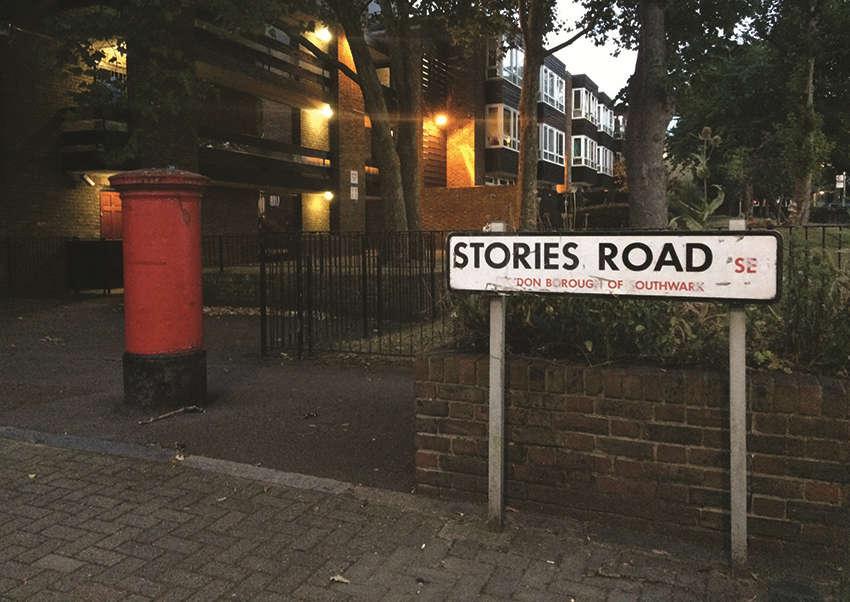
Conclusion | 225
Figure 110 Stories Road, 2016
References
Adams, L. (2002) ‘Rise of “nobody” memoir’, in Washington Monthly. Available at:
http://www.alternet.org/story/12914/rise_of_the_%22nobody%22_memoir [Accessed 5 July 2016].
Adams, T. (2000) Light writing and life writing: photography in autobiography. United States of America: The University of North Carolina Press.
Afonso, M. (2009) Brasília gravada. Goiânia: Editora UFG.
Afonso, M. (2011) ‘Da coletividade ao convívio: fazer, estar e ser juntos’ in Revista Z Cultural, VI(3). Available at: http://revistazcultural.pacc.ufrj.br/dacoletividade-ao-convivio-fazer-estar-e-ser-juntos-de-manoela-dos-anjosafonso [Accessed 1 July 2016]
Ahrens, J.; Kelly, M. and Liempt, I. (2016) ‘Free movement? The onward migration of EU citizens born in Somalia, Iran, and Nigeria’, in Popul. Space Place, 22(1), pp. 84-98.
Allen, G. (2011) Artists' magazines: an alternative space for art Massachusetts: MIT Press.
Amaral, A. (2006a) Textos do Trópico de Capricórnio: artigos e ensaios (19802005). vol 2, Circuitos de arte na América Latina e no Brasil. São Paulo: Ed. 34.
Amaral, A. (2006b) Textos do Trópico de Capricórnio: artigos e ensaios (19802005). vol 3, Bienais e artistas contemporâneos no Brasil. São Paulo: Ed. 34.
Andrews, M.; Squire, C. and Tamboukou, M. (eds) (2013). Doing narrative research. 2nd ed. London: Sage.
Anzaldúa, G. (2012) Borderlands, La Frontera: the new mestiza. 4th ed. San Francisco: Aunt Lute Books.
Anzaldúa, G. and Keating, A. (2002) This bridge we call home: radical visions for transformation. New York: Routledge, pp. 540-579.
Anzaldúa, G. and Moraga, C. (1983) This bridge called my back: writings by radical women of color. New York: Kitchen Table Women of Color Press.
Bayley, S. (2016) The private life of the diary: from Pepys to tweets, a history of the diary as an art form. London: Unbound.
References | 226
Bergland, B. (2001) ‘Immigration writings, American’, in Jolly, M. (ed.) Encyclopedia of life writing: autobiographical and biographical forms. London: Routledge. Available at: http://arts.idm.oclc.org/login?qurl=http%3A%2F%2Fsearch.credoreference.c om%2Fcontent%2Fentry%2Froutlifewrite%2Fimmigration_writings_american %2F0 [Accessed 1 April 2016]
Bhabha, H. (1994) The location of culture. London: Routledge.
Bhabha, H. (1999) ‘Arrivals and departures’, in Naficy, H. (ed.) Home, exile, homeland: film, media, and the politics of place. London: Routledge, pp. viixii.
Bhabha, H. (2006) ‘Cultural diversity and cultural differences’, in Ashcroft, B.; Griffiths, G. and Tiffin, H. (eds) The Post-Colonial Studies Reader New York: Routledge, pp. 155–157.
Bishop, C. (2012) Artificial hells: participatory art and the politics of spectatorship. London: Verso.
Black, J. (2001) The British and the Grand Tour. London: Routledge.
Bloom, L. Z. and Holder, O. (1980). ‘Anaïs Nin’s diary in context’, in Jelinek, E. (ed.) Women’s autobiography: essays and criticism. London: Indiana University Press, pp. 206-220.
Bruscky, P. and Navas, A. (2012) Poiesis Bruscky: Paulo Bruscky. São Paulo: Cosac Naify e Associação para o Patronato Contemporâneo APC.
Burgin, V. (1982) Thinking photography. London: Macmillan Press, pp. 1-14.
Buss, H.M. (2001) ‘Memoirs’, in Jolly, M. (ed.) Encyclopedia of life writing: autobiographical and biographical forms. London: Routledge. Available at: http://arts.idm.oclc.org/login?qurl=http%3A%2F%2Fsearch.credoreference.c om%2Fcontent%2Fentry%2Froutlifewrite%2Fmemoirs%2F0 [Accessed 1 April 2016].
Callard, F. (2011) ‘Doreen Massey’, in Hubbard, P. and Kitchin, R. (eds) Key thinkers on space and place, 2nd edn. London: Sage, pp. 299-306.
Calle, S. (2012) The address book. Los Angeles: Siglio.
Camnitzer, L. (2007) Conceptualism in Latin American art: didactics of liberation. Austin: University of Texas Press.
Camnitzer, L. (2009) On art, artists, Latin America, and other utopias. Austin: University of Texas Press.
References | 227
Cantarino, G. (2004) Uma ilha chamada Brasil: o paraíso irlandês no passado brasileiro. Rio de Janeiro: Mauad.
Cantú, N. and Hurtado, A. (2012) ‘Breaking borders/constructing bridges: twenty-five years of Borderlands/La Frontera’, in Anzaldúa, G. Borderlands, La Frontera: the new mestiza 4th ed. San Francisco: Aunt Lute Books, pp. 3-13
Ceschel, B. (2015) Self publish, be happy: a DIY photobook manual and manifesto. New York: Aperture.
Chang, H.; Ngunjiri, F. and Hernandez, K. (2013) Collaborative autoethnography. California: Left Coast Press.
Cocchiarale, F. (1980) ‘O pão nosso de cada dia’, in Beijo, [s.n.], pp. 1-6. Available at:
http://icaadocs.mfah.org/icaadocs/ELARCHIVO/RegistroCompleto/tabid/99/d oc/1110557/language/es-MX/Default.aspx [Accessed 16 May 2016].
Cottam, R. (2001) ‘Diaries and journals: general survey’, in Jolly, M. (ed.)
Encyclopedia of life writing: autobiographical and biographical forms. London: Routledge. Available at:
http://arts.idm.oclc.org/login?qurl=http%3A%2F%2Fsearch.credoreference.c om%2Fcontent%2Fentry%2Froutlifewrite%2Fdiaries_and_journals_general_s urvey%2F0 [Accessed 30 March 2016].
Couser, G.T. (2012) Memoir: an introduction. Oxford: Oxford University Press.
Dean, T. and Millar, J. (2005) Place: art works. London: Thames & Hudson.
Dillemuth, S. (2011) ‘The academy and the corporate public’, in Wesseling, J. (ed.) See it again, say it again: the artist as researcher. Amsterdam: Valiz, pp. 221-241.
Duras, M. (2011) Writing. Minneapolis: University of Minnesota Press.
Edwards, S. M. (2001) ‘Women's diaries and journals’, in Jolly, M. (ed.)
Encyclopedia of life writing: Autobiographical and Biographical forms. London: Routledge. Available at: http://arts.idm.oclc.org/login?qurl=http%3A%2F%2Fsearch.credoreference.c om%2Fcontent%2Fentry%2Froutlifewrite%2Fwomen_s_diaries_and_journals %2F0 [Accessed 30 March 2016].
Esin, C. and Squire, C. (2013) ‘Visual autobiographies in East London: narratives of still images, interpersonal exchanges, and intrapersonal dialogues’, in Forum Qualitative Sozialforschung/Forum: Qualitative Social Research, 14 (2), Available at: http://nbn-resolving.de/urn:nbn:de:0114fqs130214 [Accessed 28 September 2016].
References | 228
Evans, Y.; Wills, J.; Datta, K.; Herbert, J.; Mcllwaine, C.; May, J.; Araújo, J.; França, A.C. and França, A.P. (2007) Brazilians in London: a report for the strangers into citizens campaign. London: Queen Mary, University of London.
Evans, Y.; Tonhati, T.; Dias, G.; Brightwell, M.; Sheringham, O.; Souza, A. and Souza, C. (2011) For a better life: Brazilians in London 2010. London: Queen Mary, University of London.
Evans, Y.; Tonhati, T. and Souza, A. (2013) Imigrantes brasileiras pelo mundo 2013 London: Queen Mary, University of London.
Everett, W. (2001). ‘Film’, in Jolly, M. (ed.) Encyclopedia of life writing: autobiographical and biographical forms. London: Routledge. Available at: http://arts.idm.oclc.org/login?qurl=http%3A%2F%2Fsearch.credoreference.c om%2Fcontent%2Fentry%2Froutlifewrite%2Ffilm%2F0 [Accessed 4 July 2016].
Ferreira, G. and Cotrim, C. (2006) Escritos de artistas: anos 60/70. Rio de Janeiro: Jorge Zahar Editor.
Freire, C. (2006) Paulo Bruscky: arte, arquivo e utopia. São Paulo: Companhia Editora de Pernambuco.
Freire, P. and Shor, I. (1987) ‘What is the dialogical method of teaching?’, in Journal of Education, 169(3), pp. 11-31.
Freire, P. (1996) An incredible conversation. Available at: http://www.literacy.org/media [Accessed 9 February 2014]
Freire, P. (2000) Cultural action for freedom. United States of America: Harvard Educational Review.
Freire, P. (2011a) Educação como prática da liberdade. Rio de Janeiro: Paz e Terra.
Freire, P. (2011b) Pedagogia do oprimido. Rio de Janeiro: Paz e Terra.
Frentag, B. (2013) Hy Brasil: the metamorphosis of an island, from cartographic error to Celtic Elysium. New York: Rodopi.
Gangitano, L. (2010) ‘…the road must eventually lead to the whole world…’, in Green, T. Endless dreams and time-based streams. New York: Yerba Buena Center for the Arts, pp. 68-83.
Gaztambide-Fernández, R. (2014) ‘Decolonial options and artistic/aestheSic entanglements: an interview with Walter Mignolo’, in Decolonization: Indigeneity, Education & Society, 3(1), pp. 196-212.
References | 229
Geiger, A. and Cocchiarale, F. (1978) ‘Anna Bella Geiger’, in FUNARTE. Available at;
http://icaadocs.mfah.org/icaadocs/THEARCHIVE/FullRecord/tabid/88/doc/11 11066/language/en-US/Default.aspx [Accessed 16 May 2016].
Geiger, A. and Navas, A. (2007) Anna Bella Geiger: territórios, passagens, situações. Rio de Janeiro: Casa da Palavra.
González, J. (1995) ‘Autotopographies’, in Brahm, G. and Driscoll, M. (eds) Prosthetic territories: politics and hypertechnologies San Francisco: Westview Press, pp. 133-150.
Green, R. (2000) ‘Scenes from a group show: Project Unité’, in Coles, A. (ed.) Site-specificity: the ethnographic turn, London: Black Dog Publishing, pp. 114135.
Green, R. (2009) ‘Archives, documents?: forms of creation, activation, and use’, in Kläring, J. and Lamper, K. (eds.) Gerschichte/n verwahren, Vienna: IG Bildende Kunst.
Green, R. (2010) Endless dreams and time-based streams. New York: Yerba Buena Center for the Arts.
Helguera, P. (2011) Education for socially engaged art: a materials and techniques handbook. New York: Jorge Pinto Books.
Hertz, B. (2010) ‘Seeing text’, in Green, T. Endless dreams and time-based streams. New York: Yerba Buena Center for the Arts, pp. 84-95.
Hiller, S. (2011) Susan Hiller. London: Tate Publishing.
hooks, b. (1990) Yearning: race, gender, and cultural politics. Boston: South End Press.
hooks, b. (1994) Teaching to transgress: education as the practice of freedom. London: Routledge.
hooks, b. (1995) Art on my mind: visual politics. New York: The New Press.
hooks, b. (2009) Belonging: a culture of place. New York: Routledge.
Hsieh, T. and Heathfield, A. (2009) Out of now: the lifeworks of Tehching Hsieh. Massachusetts and London: The MIT Press and Live Art Development Agency.
Hubbard, P. and Kitchin, R. (eds) (2011) Key thinkers on space and place. 2nd edn. London: Sage, pp. 1-17.
References | 230
Illich, I. (1973) Tools for conviviality. New York: Harper and Row.
Jackson, P. (1992) Maps of meaning. London: Routledge.
Jesus, C. M. (2003) Child of the dark: the diary of Carolina Maria de Jesus. USA: Signet Classics.
Jesus, C. M. (2005) Quarto de despejo: diário de uma favelada. 8ª ed. São Paulo: Editora Ática.
Johnson, D. (1996) Phantom island of the Atlantic: the legends of seven islands that never were. London: Souvenir Press.
Jolly, M. (2001) Encyclopedia of life writing: autobiographical and biographical forms. United Kingdom: Routledge.
Jolly, M. (2005) ‘Speaking personally, academically’, in Feminist Theory, 6(2), pp. 213-220.
Jolly, M. (2011) ‘Life writing as critical creative practice’, in Literature Compass, 8(12), pp. 878–889.
Kaplan, A. (1993) French lessons: a memoir. Chicago: The University of Chicago Press.
Kaplan, A. (1994) ‘On language memoir’, in Bammer, A. (ed.) Displacements: cultural identities in question Indianapolis: Indiana University Press, pp. 5970.
Karpinski, J. (2001) ‘Artifacts and life writing’, in Jolly, M. (ed.) Encyclopedia of life writing: autobiographical and biographical forms. London: Routledge. Available at:
http://arts.idm.oclc.org/login?qurl=http%3A%2F%2Fsearch.credoreference.c om%2Fcontent%2Fentry%2Froutlifewrite%2Fartifacts_and_life_writing%2F0 [Accessed 4 July 2016].
Kawara, O. (2002) On Kawara. New York: Phaidon Press.
Keating, A. (ed.) (2009) The Gloria Anzaldúa reader. Durham: Duke University Press.
Kester, G. (2004) Conversation pieces: community and communication in modern art. California: University of California Press.
Kingston, M. (1981) The woman warrior: memoirs of a girlhood among ghosts. London: Picador.
References | 231
Krauss, R. (1979) ‘Sculpture in the expanded field’, in October, vol. 8, pp. 3044.
Lejeune, P. (2008) O pacto autobiográfico: de Rousseau à Internet, Belo Horizonte: Editora da UFMG.
Lejeune, P. (2009) On diary United States of America: University of Hawai`i Press.
Lejeune, P. and Bogaert, C. (2003) Un journal à soi: histoire d’une pratique, Paris: Les Éditions Textuel.
Lippard, L. (1997) The lure of the local: senses of place in a multicentered society. London: The New Press.
Lippard, L. (1976) ‘Untitled statement’, in Art-Rite n.14, New York: Art-Rite Publishing Company, p. 10.
Maldonado-Torres, N. (2007) ‘On the coloniality of being: contributions to the development of a concept’, in Cultural Studies, 21(2), pp. 240-270
Massey, D. (1994a) Space, place and gender. Cambridge: Polity Press.
Massey, D. (1994b) ‘Double articulation: a place in the world’, in Bammer, A. (ed.) Displacements: cultural identities in question. Indianapolis: Indiana University Press, pp. 110-121.
Massey, D. (1999) ‘Spaces of politics’, in Massey, D.; Allen, J. and Sarre, P. (eds) Human geography today. Cambridge: Polity Press, pp. 279-294.
Massey, D. (2005) For space. London: Sage.
Massey, D. (2006) ‘Entrevista com a professora Doreen Massey’, in Geosul, 21(42), pp. 195-203.
Massey, D. (2009) ‘Concepts of space and power in theory and in political practice’, in Documents d'Anàlisi Geogràfica, 55, pp. 15-26.
Massey, D. (2012) ‘Landscape/space/politics: an essay’, in Tyszczuk, R.; Smith, J.; Clark, N. and Butcher, M. (eds.) Atlas: geography, architecture and change in an interdependent world. London: Black Dog Publishing, pp. 90-95.
Massey, D. and Jess, P. (eds.) (1995) A place in the world?: places, cultures and globalization. Oxford: Oxford University Press and The Open University.
McDowell, L. (1998) Gender, identity and place: understanding feminist geographies. Cambridge: Polity Press.
References | 232
McDowell, L. and Sharp, J. (eds.) (1999) A feminist glossary of human geography. London: Arnold.
McKittrick, K. (2011) ‘bell hooks’, in Hubbard, P. and Kitchin, R. (eds) Key thinkers on space and place, 2nd edn. London: Sage, pp. 242-248.
Mcllwaine, C.; Cock, J. and Linneker, B. (2011) No longer invisible: the Latin American community in London. London: Trust for London.
Mcllwaine, C. and Bunge, D. (2016) Towards visibility: the Latin American community in London. London: Trust for London.
Meskimmon, M. (2001) ‘Visual arts and life writing’, in Jolly, M. (ed.) Encyclopedia of life writing: autobiographical and biographical forms. London: Routledge. Available from: http://arts.idm.oclc.org/login?qurl=http%3A%2F%2Fsearch.credoreference.c om%2Fcontent%2Fentry%2Froutlifewrite%2Fvisual_arts_and_life_writing%2F 0 [Accessed 3 July 2016]
Meyer, J. (2000) ‘Nomads: figures of travel in contemporary art’, in Coles, A. (ed.) Site-specificity: the ethnographic turn. London: Black Dog Publishing, pp. 10-26.
Mignolo, W. (1993) ‘Colonial and postcolonial discourse: cultural critique or academic colonialism?’, in Latin American Research Review 28(3), pp.120-134
Mignolo, W. (2000) Local histories/Global designs: coloniality, subaltern knowledges, and border thinking. Princeton: Princeton University Press.
Mignolo, W. (2002) ‘The geopolitics of knowledge and the colonial difference’, in South Atlantic Quarterly, 101(1), pp. 57-96.
Mignolo, W. (2007a) ‘Delinking’, in Cultural Studies, (21)2, pp. 449-514.
Mignolo, W. (2007b) ‘The de-colonial option and the meaning of identity in politics’, in Anales Nueva Época, n. 9-10, pp. 43-72.
Mignolo, W. (2011a) ‘Epistemic disobedience and the decolonial option: a manifesto’, in Transmodernity, 1(2), pp. 44-66.
Mignolo, W. (2011b) The darker side of Western modernity. Durham: Duke University Press.
Mignolo, W. (2013) ‘Geopolitics of sensing and knowing: on (de)coloniality, border thinking, and epistemic disobedience’, in Confero, 1(1), pp. 129-150.
References | 233
Mignolo, W. (2014) ‘Further thoughts on (De)Coloniality’, in Broeck, S. and Junker, C. (eds.) Postcoloniality-Decoloniality-Black Critique: joints and fissures, New York: Campus Verlag, pp. 21-51.
Mignolo, W. and Schiwy, F. (2007) ‘Transculturation and the colonial difference: double translation’, in Información y Comunicación, n. 4, pp. 8-30.
Minh-ha, T. (1982) Reassemblage, film, 40 mins.
Minh-ha, T. (1989) Surname Viet Given Name Nam, film, 108 mins.
Minh-ha, T. (1991) Shoot for the Contents, film, 102 mins.
Minh-ha, T. (1994) ‘Other than myself/my other self’, in Robertson, G.; Mash, M.; Tickner, L.; Bird, J.; Curtis, B. and Putnam, T. (eds) Travellers’ tales: narratives of home and displacement. London: Routledge, pp. 9-26.
Minh-ha, T. (2011) Elsewhere, within here: immigration, refugeeism and the boundary event. London: Routledge.
Mitchell, A. (2006) ‘Roger Casement's Hy-Brassil: Irish origins of Brazil’, in Murray, E. and Healy, C. (eds) Irish Migration Studies in Latin America, 4(3), pp. 157-165. Available at: http://www.irlandeses.org/0607.pdf [Accessed 25 July 2016].
Moore-Gilbert, B. (2009) Postcolonial life-writing: culture, politics, and selfrepresentation. London: Routledge.
Morin, K. M. (2011) ‘Edward W. Said’, in Hubbard, P. and Kitchin, R. (eds.) Key thinkers on space and place, 2nd edn London: Sage, pp. 336-344.
Mota, K. (2012) Imigrantes, bilinguismo e identidades: narrativas autobiográficas. Salvador: Eduneb.
Murray, E. (2006) ‘Brazil and Ireland’, in Murray, E. and Healy, C. (eds) Irish Migration Studies in Latin America, 4(3), pp. 99-101. Available at: http://www.irlandeses.org/0607.pdf [Accessed 25 July 2016].
Naficy, H. (2001) An accented cinema: exilic and diasporic filmmaking. Princeton: Princeton University Press.
Nin, A. (1976) The diary of Anaïs Nin: 1955 – 1966, vol. 6, London: Harcourt Brace Jovanovich.
Nin, A. (1974) The diary of Anaïs Nin: 1947–1955, vol. 5, London: Harcourt Brace Jovanovich.
References | 234
Pádua, L. (2013) A geografia de Yi-Fu Tuan: essências e persistências. PhD Thesis, Universidade de São Paulo, Brasil
Papoulias, C. (2011) ‘Homi K. Bhabha’, in Hubbard, P. and Kitchin, R. (eds.) Key thinkers on space and place, 2nd edn. London: Sage, pp. 69-75.
Parr, M. and Badger, G. (2004) The photobook: a history, v. 1, London: Phaidon Press.
Pavlenko, A. (1998) ‘Second language learning by adults: testimonies of bilingual writers’, in Applied Linguistics, 9(1), pp. 3-19.
Pavlenko, A. (2001) ‘Language learning memoirs as a gendered genre’, in Applied Linguistics, 22(2), pp. 213-240.
Pavlenko, A. (2006) ‘Bilingual selves’, in Pavlenko, A. (ed.) Bilingual minds: emotional experience, expression, and representation. Clevedon, UK: Multilingual Matters, pp. 1-33.
Pavlenko, A. (2007) ‘Autobiographic narratives as data in applied linguistics’, in Applied Linguistics, 28(2), pp. 163-188.
Pavlenko, A. and Norton, B. (2007) ‘Imagined communities, identity, and English language learning’, in Cummins, J. and Davison, C. (eds) International handbook of English language teaching. Dordrecht, Netherlands: Springer, pp. 669-680.
Pavlenko, A. and Piller, I. (2004) ‘Bilingualism and gender’, in Bhatia, T. and Ritchie, W. (eds) The handbook of bilingualism, Australia: Blackwell Publishing, pp. 489-511.
Pavlenko, A. and Piller, I. (2007) ‘Globalization, gender, and multilingualism’, in Volkmann, L. and Decke-Cornill, H. (eds) Gender studies and foreign language teaching Tübingen: Narr, pp. 15-30.
Perpétua, E. (2002) Produção e recepção de Quarto de despejo, de Carolina
Maria de Jesus: relações publicitárias, contextuais e editoriais’, in Belo Horizonte, v. 5, pp. 33-42.
Perpétua, E. (2003) ‘Aquém do Quarto de despejo: a palavra de Carolina
Maria de Jesus nos manuscritos de seu diário’, in Estudos de Literatura Brasileira Contemporânea, n. 22, pp. 63-83.
Perpétua, E. (2014) ‘A proposta estética em Quarto de despejo, de Carolina de Jesus’, in SCRIPTA, 18(35), pp. 255-266.
References | 235
Pitts, A. (2016) ‘Gloria E. Anzaldúa’s autohistoria-teoría as an epistemology of self-knowledge/ignorance’, in Hypatia, 31(2), pp. 352-369.
Pollock, G. ed. (1996) Generations and geographies in the visual arts: feminist readings. London: Routledge.
Progoff, I. (1987) At a journal workshop: the basic text and guide for using the Intensive Journal process. New York: Dialogue House Library.
Quijano, A. (2000) ‘Coloniality of power, Eurocentrism, and Latin America’, in Nepantla: Views from the South, 1(3), pp. 533-580.
Regard, F. (2002) ‘Autobiography and geography: a self-arranging question’, in Reconstruction, 2(3), Available at: http://reconstruction.eserver.org/Issues/023/intro.htm [Accessed on July 5 2016].
Rendell, J. (2010) Site-writing: the architecture of art criticism. London: I. B. Tauris, pp. 1-20.
Ribeiro, D. (2006) O povo brasileiro: a formação e o sentido do Brasil. São Paulo: Companhia das Letras.
Ribeiro, D. (2010) O Brasil como problema. Brasília, Editora UnB.
Rodaway, P. (2011) ‘Yi-Fu Tuan’, in Hubbard, P. and Kitchin, R. (eds) Key thinkers on space and place, 2nd edn. London: Sage, pp. 426-431.
Rogoff, I. (2006) Terra infirma: geography’s visual culture. London: Routledge.
Rogoff, I. (2012a) The open academy. Available at: http://artmuseum.pl/en/doc/video-akademia-otwarta12 [Accessed 03 February 2016].
Rogoff, I. (2012b) The open academy. Available at: http://artmuseum.pl/en/doc/video-akademia-otwarta11 [Accessed 03 February 2016].
Rose, G. (1993) Feminism and geography: the limits to geographical knowledge. Cambridge: Polity Press.
Rose, G. (1999) ‘Performing space’, in Massey, D.; Allen, J. and Sarre, P. (eds) Human geography today. Cambridge: Polity Press, pp. 247-259.
Rose, G. (2001). Visual methodologies: an introduction to the interpretation of visual materials. Thousand Oaks, Canada: Sage.
References | 236
Said, E. (1978) Orientalism: Western concepts of the orient. London: Routledge and Kegan Paul.
Said, E. (1999) Out of place: a memoir. London: Granta.
Said, E. (2000) ‘Invention, memory, and place’, in Critical Inquiry, 26 (2), pp. 175-192. Available at:
http://www.jstor.org/stable/1344120?seq=1#page_scan_tab_contents [Accessed 15 July 2016].
Said, E. (2001) Reflections on exile: and other literary and cultural essays. London: Granta, pp. 173-186.
Sandino, L. and Partington, M. (eds) (2013) Oral history in the visual arts, London: Bloomsbury.
Santos, B. (2014) Epistemologies of the South: justice against epistemicide. London: Paradigm Publishers.
Santos, B.; Nunes, J. and Meneses, M. (2008) ‘Opening up the canon of knowledge and recognition of difference’, in Santos, B. (ed.) Another knowledge is possible: beyond Northern epistemologies. London: Verso, pp. xix-lxii.
Smith, S. and Watson, J. (2010) Reading autobiography: a guide for interpreting life narratives, 2nd edn Minneapolis: University of Minnesota Press.
Sontag, S. (1979) On photography. England: Penguin Books.
Souza, A. (2010) ‘O papel da família e de organizações civis no ensino de português para crianças brasileiras’, in Travessia, XXIII(66), pp. 55-64.
Spivak, G. (2009) Outside in the teaching machine. London: Routledge Classics.
Spivak, G. (2012) An aesthetic education in the era of globalization. London: Harvard University Press.
Squire, C. (2013) ‘From experience-centred to socioculturally-oriented approaches to narrative’, in Andrews, M.; Squire, C. and Tamboukou, M. (eds.) Doing narrative research, 2nd edn. London: Sage, pp. 47-71.
Squire, C.; Esin, C. and Burman, C. (2013) '“You Are Here”: visual autobiographies, cultural-spatial positioning and resources for urban living’, in Sociological Research Online, 18 (3)1 Available at:
References | 237
http://www.socresonline.org.uk/18/3/1.html [Accessed: 28 September, 2016].
Squire, C.; Davis, M.; Esin, C.; Andrews, M.; Harrison, B.; Hydén, L. and Hydén, M. (2014) What is narrative research? London: Bloomsbury.
Stanley, L. (1992) The auto/biographical I: theory and practice of feminist auto/biography, Manchester: Manchester University Press.
Sullivan, G. (2010) Art practice as research: inquiry in visual arts. 2nd edn London: Sage.
Tamboukou, M. (2010a) In the fold between power and desire: women artists' narratives. Newcastle: Cambridge Scholars Publishing.
Tamboukou, M. (2010b) ‘Charting cartographies of resistance: lines of flight in women artists’narratives’, in Gender and Education, 22(6), pp: 679-696.
Tamboukou, M. (2011a) ‘Leaving the self: nomadic passages in the memoir of a woman artist’, in Australian Feminist Studies, 24(61), pp. 307-324.
Tamboukou, M. (2011b) ‘Archive pleasures or whose time is it?’, in Forum: Qualitative Social Research, 12(3). Available at: http://www.qualitativeresearch.net/index.php/fqs/article/view/1733 [Accessed 15 July 2016].
Tamboukou, M. (2013a) ‘From the question of ‘what’ to the question of ‘how’ or how to write about the lives of others?’ Unpublished, pp. 1-6. Available at: http://eprints.ncrm.ac.uk/3063/ [Accessed 28 July 2016].
Tamboukou, M. (2013b) ‘Becoming an artist: life histories and visual images’, in Sandino, L. and Partington, M. (eds) Oral history in the visual arts, London: Bloomsbury, pp. 171-179.
Tamboukou, M. (2013c) ‘A Foucauldian approach to narratives’, in Andrews, M.; Squire, C. and Tamboukou, M. (eds.) Doing narrative research. 2nd edn London: Sage, pp. 88-107.
Tamboukou, M. (2014) ‘Narrative personae and visual signs: reading Leonard's intimate photo memoir’, in a/b: Auto/Biography Studies, 29(1), pp. 27-49.
Tamboukou, M. (2015) ‘Narrative as force’, in Tamboukou, M. and Livholts, M. Discourse and narrative methods, London: Sage, pp. 93-103.
Traquino, M. (2010) A construção do lugar pela arte contemporânea Portugal: Húmus.
References | 238
Tuan, Y. (1971) ‘Geography, phenomenology, and the study of human nature’, in The Canadian Geographer, 15(3), pp. 181–192.
Tuan, Y. (1976) ‘Humanistic geography’, in Annals of the Association of American Geographers, 66 (2), pp: 266-276.
Tuan, Y. (1977). Space and place: the perspective of experience. Minneapolis: University of Minnesota Press.
Tuan, Y. (1984). Dominance and affection: the making of pets. New Haven: Yale University Pres.
Tuan, Y. (1986a). Dear Colleague: 15 November 1986. Available at: http://www.yifutuan.org/archive/1986/19861115.pdf [Accessed 7 April 2016].
Tuan, Y. (1986b). Dear Colleague: 1 September 1986. Available at: http://www.yifutuan.org/archive/1986/19860901.pdf [Accessed 7 April 2016].
Tuan, Y. (1989). Dear Colleague: 15 February 1989. Available at: http://www.yifutuan.org/archive/1989/19890215.pdf [Accessed 7 April 2016].
Tuan, Y. (1990) Topophilia: a study of environmental perception, attitudes, and values. Morningside edition, New York: Columbia University Press.
Tuan, Y. (1991). ‘Language and the making of place: a narrative-descriptive approach’, in Annals of the Association of American Geographers, 81(4), pp. 684-696.
Tuan, Y. (1998) A life of learning. Charles Homer Haskins Lecture for 1998, Available at https://www.acls.org/uploadedFiles/Publications/OP/Haskins/1998_YiFuTuan.pdf [Accessed 8 April 2016].
Tuan, Y. (1999) Who am I?: an autobiography of emotion, mind, and spirit, USA: University of Wisconsin Press.
Tuan, Y. (2001) ‘Life as a field trip’, in Geographical Review, 91(1-2), pp. 41-45.
Tuan, Y. (2004) Place, art, and self. New Mexico: Center for American Places.
Tuan, Y. (2005) Dear Colleague: 15 March 2005. Available at: http://www.yifutuan.org/archive/2005/20050315.htm [Accessed 7 April 2016].
Tuan, Y. (2007) Coming home to China. Minneapolis: University of Minnesota Press.
References | 239
Tuan, Y. (2012) Humanist Geography: an individual's search for meaning. Virginia: George F. Thompson Publishing.
Willats, S. (1986) Stephen Willats: three essays. London: Institute of Contemporary Art.
Willats, S. (2000) Art as social function. London: Ellipsis.
Willats, S. (2012a) Artwork as social model: a manual of questions and propositions. Sheffield: Research Group for Artists Publications.
Willats, S. (2012b) Surfing with the attractor. London: South London Gallery.
Winslow, J. (1995) Life-writing: a glossary of terms in biography autobiography and related forms, 2nd edn. USA: University of Hawai’i Press.
Women and Geography Study Group of the IBG (1984) Geography and Gender: an introduction to feminist geography. London: Hutchinson.
Wolf-Meyer, M. and Heckman, D. (2002) ‘Navigating the starless night: reading the auto/bio/geography, meaning-making’, in Reconstruction, 2(3), Available at < http://reconstruction.eserver.org/Issues/023/intro.htm> [Accessed on July 5 2016].
Woolf, V. (2004) A room of one’s own. London: Penguin Books.
Woolf, V. (2012) A writer’s diary USA: Marino Publishing.
References | 240
Appendices
I – Carta convite
Às mulheres brasileiras vivendo em Londres
CARTA CONVITE PARA PARTICIPAÇÃO EM PESQUISA E POSTERIOR PUBLICAÇÃO DE LIVRO
Olá! Meu nome é Manoela Afonso, desenvolvo uma pesquisa de doutorado no Chelsea College of Arts, na University of the Arts London. Tenho 38 anos e nasci em Curitiba, mas passei os últimos dez anos de minha vida entre Brasília e Goiânia. Mudei-me para Londres no dia 20 de Maio de 2012, e aqui chegando percebi que as dificuldades que eu senti em relação à língua inglesa influenciaram não só a minha forma de ver o mundo, mas também a forma como passei a me ver no mundo. Essa experiência pessoal me fez querer saber como outras mulheres brasileiras que vivem nesta cidade lidam ou lidaram com esta e outras questões que envolvem a vida numa outra língua, já que a vida particular, auto-estima, atividades profissionais e o convívio social podem ser afetados pela falta de intimidade com a língua local.
Foi então que passei a me perguntar: como a língua inglesa vem afetando a vida diária de mulheres brasileiras que vivem nesta cidade? De que forma a língua influencia a percepção que temos do lugar em que vivemos? Como nos vemos numa nova língua? Que estórias podemos contar sobre a presença da língua inglesa em nossas vidas? Como ela nos afeta e/ou afeta nossa integração na comunidade local?
Sendo assim, venho gentilmente convidá-la para participar do projeto de pesquisa “Língua e lugar na vida de mulheres brasileiras que vivem em Londres”. Esta é uma pesquisa interdisciplinar situada entre os campos da educação, das artes, e das escritas de vida. Ela tem como objetivo a construção coletiva e criativa de um lugar de visibilidade e circulação de estórias sobre a língua inglesa na vida cotidiana da mulher brasileira que vive
Appendices | 241
em Londres. Como resultado final publicaremos um livro contendo as nossas histórias, o qual será lançado e distribuído gratuitamente entre o final de 2015 e o começo de 2016.
A participação neste projeto se dará basicamente em três etapas:
1. Uma entrevista individual (a ser realizada entre Novembro e Dezembro de 2014);
2. Dois encontros coletivos e criativos (previstos para abril de 2015);
3. Ocupação criativa de um espaço residencial (prevista para acontecer entre os meses abril/maio de 2015 – sendo esta uma etapa facultativa).
Todas as atividades do projeto serão desenvolvidas em Português. Todas as atividades serão gratuitas. Um lanche será servido durante os encontros. Se você é uma mulher brasileira que vive em Londres e deseja partilhar estórias sobre a língua inglesa em sua vida, venha fazer parte deste projeto! Sua história pode fazer a diferença ao lançarmos luz sobre a importância da língua na promoção do bem-estar, da justiça social, da integração local de mulheres em trânsito pelo mundo.
Mais detalhes serão esclarecidos durante o nosso primeiro encontro, momentos antes de iniciarmos a entrevista. Estou à disposição para mais informações pelo email lingua.e.lugar@gmail.com, ou pelo telefone 07442 545190.
Muito obrigada! Atenciosamente, Manoela dos Anjos Afonso
CCW/UAL/UFG/CAPES
Sobre mim: Sou professora da Faculdade de Artes Visuais da Universidade Federal de Goiás. Atualmente desenvolvo uma pesquisa de doutorado baseada na prática artística e com foco nas relações entre Língua-LugarIdentidade. Sou formada em Licenciatura em Artes e posteriormente cursei o Mestrado em Cultura Visual. Minha prática artística tem suas bases no campo da gravura, mas atualmente meu interesse está voltado para projetos interdisciplinares com foco em práticas artísticas dialógicas, colaborativas e socialmente engajadas.
Appendices | 242
Hello,
My name is Manoela Afonso and I am developing a PhD research at Chelsea College of Arts, University of the Arts London. I am 38 years old and was born in Curitiba, but I spent ten years of my life living in Brasília and Goiânia. I moved to London in 20th May 2012, and as soon as I arrived here I noticed that my difficulties with English language started to frame not only my way of perceiving the world, but also the way I notice myself in the world. This personal experience intrigued me and made me ask questions about the English language in the lives of other Brazilian women living in this city, mainly considering that daily life, self-esteem, professional activities and social conviviality can be deeply affected by the level of fluency in the host language.
I asked myself: How has English language been affecting the daily lives of Brazilian women living in this city? How do we perceive the place where we live now from the perspective of English language? How do we perceive ourselves from the perspective of the new language? Which stories can we tell about the new language in our lives? How does language affect us and/or affect our integration to the local community?
Having said that, I would like to invite you to take part in this investigation as a participant and collaborator with the project “Language and Place in the life of Brazilian women living in London: an artistic approach to life writing”. This is an interdisciplinary research located among the fields of art, education, and life writing, and its aim is to build a place for visibility and circulation of stories on English language in the daily life of Brazilian women living in London. One of the forms of this place is a collective publication, which will comprise those stories and perhaps images on language and place that we will create and share during future meetings. This publication will be launched and distributed for free, probably between the second semester of 2015 and the first semester of 2016.
Appendices | 243 II – Invitation letter
The Participation in this project will happen basically in three stages:
1. One individual interview (carried out between November and December 2014);
2. At least two collective meetings (planned to be carried out between March and April 2015);
3. A creative occupation of a residential space (planned to happen between March and April 2015).
All activities will be carried out in Portuguese. All activities are free. If you are a Brazilian woman living in London and wish to share your experience and stories about the English language in your life, please come and take part in this project! Your story can make a difference and highlight the relevance of language to the well-being, social justice, empowerment, and local integration of not only Brazilian women living in London, but also women migrants moving around the world.
I will be happy to clarify details about the participation and collaboration processes during our first meeting for the interview. Moreover, I am at your disposal to give you more information on this project by email (lingua.e.lugar@gmail.com) or by phone (07442 545190).
Thank you very much for your attention.
Manoela dos Anjos Afonso
CCW/UAL/UFG/CAPES
About me: I work at the Visual Arts College at the Federal University of Goiás. Currently I am developing a practice-based PhD research at Chelsea College of Arts, in London, which is focused on the relationship among language, place, and identity. My undergraduate degree is in Arts (Teaching), and I took a Masters in Visual Culture afterwards. I began my art practice as a printmaker, but currently my interests are focused on dialogical, collaborative, and socially engaged art practices.
Appendices | 244
III – Termo de Consentimento Livre e Esclarecido
Prezada participante:
Sou pesquisadora de pós-graduação, nível doutorado, no Chelsea College of Art, na University of the Arts London. Estou realizando uma pesquisa provisoriamente intitulada como “Language and Place in the life of Brazilian women living in London: an artistic approach to life writing” (Língua e lugar na vida de mulheres brasileiras que vivem em Londres: uma abordagem artística das escritas de vida), sob a supervisão dos professores e artistas David Cross e Dr. Hayley Newman.
Esta é uma pesquisa interdisciplinar situada entre os campos da arte, da educação e das escritas de vida. Ela tem como objetivo a construção coletiva de um lugar de visibilidade e circulação de histórias sobre a influência da língua inglesa na vida cotidiana da mulher brasileira que vive em Londres. Como resultado final, publicaremos um livro contendo imagens e estórias produzidas por nós, o qual será lançado e distribuído gratuitamente entre o final de 2015 e o começo de 2016.
Sua participação inicialmente envolve uma entrevista, que será gravada em áudio se assim você permitir, e que tem a duração aproximada de 2 horas, além do preenchimento de um diário privado com o tema língua e lugar. Posteriormente, em data a ser confirmada, você será convidada a participar de pelo menos dois encontros sobre escrita criativa (momento em que também desenvolveremos o conteúdo a ser publicado no livro).
A participação nesse estudo é voluntária, não-obrigatória, e se você quiser desistir de continuar em qualquer momento, tem absoluta liberdade para fazê-lo.
Na publicação dos resultados desta pesquisa, sua identidade será mantida no mais rigoroso sigilo, a não ser que você deseje e permita que sua identidade seja divulgada.
Appendices | 245
Ao participar desta pesquisa você estará contribuindo para a compreensão do fenômeno estudado, para a produção de conhecimento científico e artístico, e para a construção de um espaço de visibilidade para as histórias sobre língua e lugar contadas por mulheres brasileiras que vivem em Londres.
Quaisquer dúvidas relativas à pesquisa poderão ser esclarecidas pela pesquisadora pelo telefone 07442545190 e pelo email lingua.e.lugar@gmail.com
Atenciosamente
Manoela dos Anjos Afonso
Chelsea College of Art
University of the Arts London
Local e data
Consinto em participar deste estudo e declaro ter recebido uma cópia deste termo de consentimento.
( ) Permito que minha identidade seja revelada neste estudo
( ) Permito que a entrevista seja gravada em áudio
( ) NÃO permito que minha identidade seja revelada neste estudo
( ) NÃO permito que a entrevista seja gravada em áudio
Nome e assinatura da participante
Local e data
Appendices | 246
IV – Consent form
Dear participant:
I am a PhD researcher at Chelsea College of Art, University of the Arts
London. I am developing a research Project entitled “Language and Place in the life of Brazilian women living in London: an artistic approach to life writing”, which is being carried out under the supervision of the artists and researchers David Cross and Dr Hayley Newman.
This is an interdisciplinary research located among the fields of art, education, and life writing. Its aim is to build collectively a place for visibility and circulation of stories about the influence of English language in the daily life of Brazilian women living in London. As a final result, we will produce a book together, comprising images and stories produced by us, and that will be launched and distributed for free between the second semester of 2015 and the first semester of 2016.
Initially, your participation involves taking part in an interview, which will be approximately 2 hours long, and will be audio recorded only if you consent to this. Following the interview, I will offer you a diary to be filled out with your stories on Language and Place. Afterwards, on a date to be confirmed, you will be invited to take part in two collaborative meetings on creative writing (and at this time we will develop the main ideas about the content and format of our collective book).
Participation in this investigation is voluntary, non-mandatory, and you can discontinue your participation at any time. Your identity will be kept confidential, unless you want and allow its disclosure.
When taking part in this research, you will be contributing to the comprehension of the phenomenon studied, to the production of artistic and scientific knowledge, and to the building of a collective place of visibility for the stories on language and place told by Brazilian women living in London.
Appendices | 247
If you have any queries please do not hesitate to contact me either by phone 07442545190 or by email lingua.e.lugar@gmail.com.
Kind Regards
Manoela dos Anjos Afonso
Chelsea College of Art University of the Arts London
Place and date
I agree to participate in this study and declare I have received one copy of this consent form.
( ) I consent to reveal my identity in this study
( ) I consent to have my interview audio recorded
( ) I DO NOT consent to reveal my identity in this study
( ) I DO NOT consent to have my interview audio recorded
Name and signature of the participant
Place and date
Appendices | 248
Início da gravação: Nome completo, idade, há quanto tempo vive em Londres
1. Por que Londres?
2. Qual era o seu conhecimento prévio da língua inglesa antes de mudar para cá?
3. Como foi a sua relação com a cidade quando você chegou, levando em consideração o seu conhecimento da língua inglesa naquele momento?
4. Quais foram as pressões diárias que você sentiu por causa da língua?
5. O que você fez para melhorar o seu inglês?
6. Em que momento você passou a se sentir mais confiante para se expressar em inglês?
7. Em que aspectos a sua vida mudou depois que você se sentiu mais confiante com a língua inglesa?
8. Você sentiu/sente que houve alguma mudança na sua identidade por causa da vida numa nova língua? O que mudou?
9. Como você avalia o seu domínio da língua inglesa hoje?
10. Você ainda sente pressões diárias por causa da língua inglesa? Quais?
11. Você poderia contar histórias sobre injustiça, dificuldades, ou mesmo situações engraçadas que você vivenciou por causa de alguma dificuldade específica com a língua inglesa?
12. Você costuma ir ao Brasil? Como é a sua relação com ambas, a língua portuguesa e inglesa quando você está lá?
13. Você pretende voltar a morar no Brasil? Por quê?
14. Você deseja aprender outras línguas? Por quê?
15. Você acredita que a sua percepção do mundo mudou depois que você aprendeu outras línguas? Por quê?
Appendices | 249
–
V
Questionário utilizado para conduzir as entrevistas
VI – Questionnaire for conducting the interviews
1. Why London?
2. What was your prior knowledge of English language before moving here?
3. What was your relationship with the city when you arrived, taking into account your knowledge of the English language at that time?
4. What were the daily pressures you felt because of the language?
5. What have you done to improve your English?
6. When did you start to feel more confident in expressing yourself in English?
7. In what ways has your life changed since you felt more confident with the English language?
8. Do/did you feel that your identity changed because of your life in a new language? What has changed?
9. How do you assess your proficiency in English today?
10. Do you still feel daily pressures because of the English language? Which?
11. Have you any stories about injustice, difficulties or even funny situations that you have experienced because of any difficulty in dealing with English?
12. Do you often go to Brazil? What is your relationship with both the Portuguese and English when you're there?
13. Do you intend to return to Brazil? Why?
14. Do you want to learn other languages? Why?
15. Do you believe that your perception of the world changed after you learned another language? Why?
Appendices | 250
EXPLORE MORE THESES AT BENURI.ORG

































































































































